He died at Garden Sullivan Hospital in San Francisco.
Luna is memorialized in the project Dancers We Lost: Honoring Performers Lost to HIV/AIDS.
* * * * * * * *
Photo of quilt panel from the AIDS Memorial Quilt
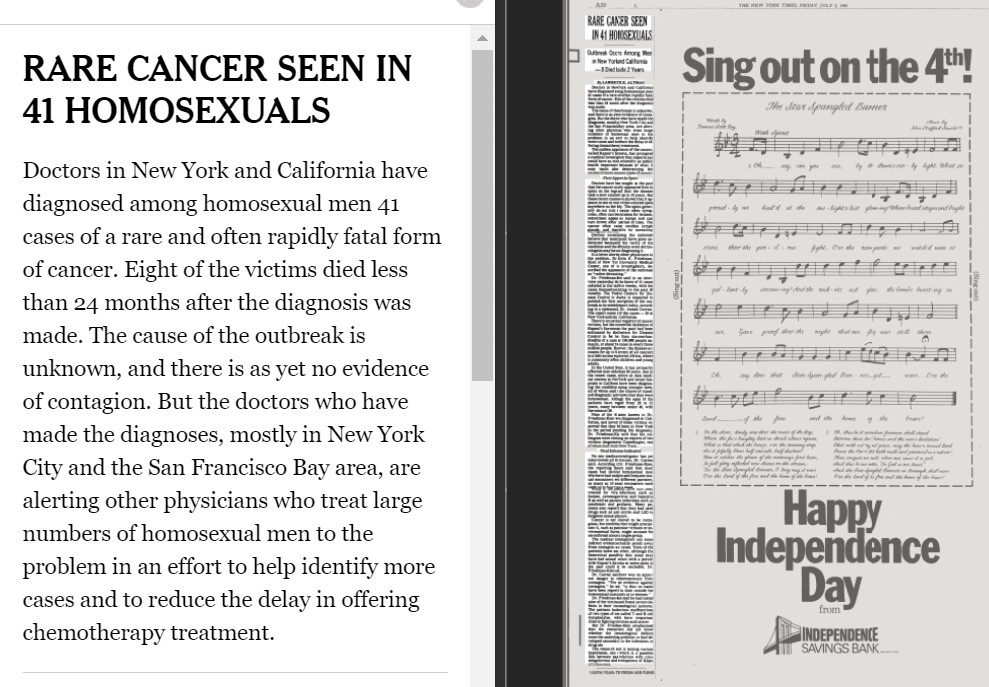
Coinciding with the CDC’s release of another MMWR detailing opportunistic infections among gay men, The New York Times publishes the article “Rare Cancer Seen in 41 Homosexuals.” At this point, the term “gay cancer ” enters the public lexicon.
Learn More.The CDC report, titled “Kaposi’s Sarcoma and Pneumocystis Pneumonia Among Homosexual Men — New York City and California,” described cases of KS and PCP among 26 gay men (25 white and one black, and ranging in age from 26 to 51).
In an 18-paragraph story on Page 20 of The New York Times, reporter Lawrence K. Altman cited 41 reported cases of “a rare and often rapidly fatal form of cancer.” Altman reported that eight of the 41 men diagnosed with the condition were already dead, and that the time between diagnosis and death from the disease was less than 24 months.
In the last paragraphs of the article, Altman wrote:
“The reporting doctors said that most cases had involved homosexual men who have had multiple and frequent sexual encounters with different partners, as many as 10 sexual encounters each night up to four times a week.
“Many of the patients have also been treated for viral infections such as herpes, cytomegalovirus and hepatitis B as well as parasitic infections such as amebiasis and giardiasis. Many patients also reported that they had used drugs such as amyl nitrite and LSD to heighten sexual pleasure.
“Cancer is not believed to be contagious, but conditions that might precipitate it, such as particular viruses or environmental factors, might account for an outbreak among a single group.”
According to Dr. Joseph Sonnabend, a New York City clinician who was among the first in the U.S. to recognize the emerging AIDS epidemic, this article was significant because of the Times‘ large, international readership. But doctors treating New Yorkers from the gay community had been noticing strange symptoms and unusual illnesses in their patients for at least two years.
“I had been observing some clinical and laboratory abnormalities among my patients as early as 1979. These included enlarged lymph glands, an enlarged spleen, low blood platelets and a low white blood cell count,” Dr. Sonnabend told POZ magazine in 2020.
“Then, in April or May of 1981, I was stunned to learn that Kaposi’s sarcoma was being diagnosed in young gay men in New York, Los Angeles and San Francisco. Joyce Wallace, a physician whose office was close to mine on West 12th Street in New York passed this information on to me,” he recalled.
When Dr. Sonnabend heard about the KS cases in young men, he reached out to a colleague, Dr. Alvin Friedman-Kien, a dermatologist at NYU medical center. Dr. Friedman-Kien was caring for several gay men with Kaposi’s sarcoma, and soon Dr. Sonnabend joined him at NYU’s virology lab.
Through their research, the doctors found high levels of interferon in their patients. Early research and discoveries like this formed the foundation of HIV/AIDS research for many years to come.
* * * * *
Sources:
Morbidity and Mortality Weekly Report (MMWR), “Kaposi’s Sarcoma and Pneumocystis Pneumonia Among Homosexual Men — New York City and California,” July 3, 1981
The New York Times, “Rare Cancer Seen in 41 Homosexuals” by Lawrence K. Altman, July 3, 1981
POZ magazine, “A Look Back at the Year a Rare Cancer Was First Seen in Gay Men” by Joseph Sonnabend, M.D., July 13, 2020
POZ magazine, “Interferon and AIDS: Too Much of a Good Thing” by Joseph Sonnabend, M.D., May 7, 2011
A pregnant Elizabeth Glaser, wife of television star Paul Michael Glaser, is rushed to Cedars-Sinai Medical Center in Los Angeles to give birth to her first child. She hemorrhages heavily during labor and requires a transfusion of seven pints of blood.
Learn More.A former teacher who worked as exhibit director of the LA Children’s Museum, Glaser asked her doctor about the mysterious disease reported recently in the press, and her doctor dismissed her concerns, assuring her, “Your nightmare is over.”
In 1985, daughter Ariel experienced persistent stomach pains and doctors were unable to determine the source. The four-year-old was tested for HIV “as just a precaution,” and the results came back positive for the virus.
Each member of the Glaser family was then tested, and would result in the additional HIV diagnosis of mother Elizabeth and 18-month-old son Jake.
Doctors determined that Elizabeth contracted HIV during her 1981 blood transfusion, and Elizabeth had unknowingly passed the virus on to Ariel through breastfeeding. Jake, who was born in October 1984, had contracted the virus in utero.
When Elizabeth sought counseling for Ariel, she discovered that no child psychiatrist would take the case. Aware of the stigma of AIDS, the Glasers pulled Ariel out of nursery school and erected a wall of secrecy to protect their children.
In August 1989 (one year after Ariel died of AIDS-related illness), the National Enquirer and other tabloids threatened the Glaser family with exposure.
Elizabeth Glaser would side-step the media ambush by sharing her harrowing story in her 1991 autobiography, In the Absence of Angels. She and two frinds then started the Pediatric AIDS Foundation, and she became one of the most aggressive and effective pediatric AIDS activists in the country.
* * * * *
Sources:
Washington Post, “AIDS: The Glaser Family’s Battle” by Janet Huck, August 28, 1989
Elizabeth Glaser Pediatric AIDS Foundation, “Elizabeth’s Story”
The New York Times, “The Youngest Victims of AIDS” by Bettyann Kevles, March 3, 1991
Forbes, “Before Charlie Sheen, They Went Public With HIV” by Barron Lerner, November 17, 2015
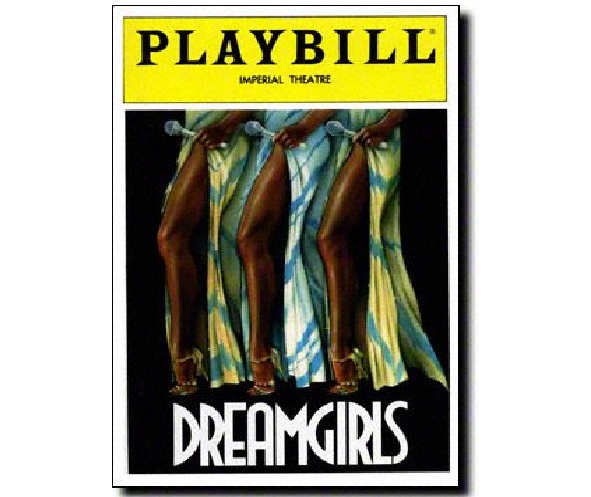
Dreamgirls makes a splashy debut on Broadway with stars Jennifer Holliday and Sheryl Lee Ralph, who both begin raising money for AIDS research and other programs after experiencing the loss of some of their cast mates to the disease.
Learn More.The successful debut of Dreamgirls marked career breakthroughs for Holliday and Ralph, but it also marked the start of a time of great loss.
In addition to cast members, Dreamgirls Director Michael Bennett would die of AIDS-related illness on July 2, 1987 at the age of 44. He would be diagnosed with AIDS in 1986 and choose to keep his illness a secret from all but a few close friends.
“Friends and cast members just got sick and died,” Ralph would later write in the Huffington Post. “They were sick today and dead tomorrow…. Then the deadly silence would set in because nobody wanted to talk about it, much less do anything about that disease, that shhhhh, gay disease. The silence was deafening.”
Ralph would go on to found the DIVA Foundation, which raises awareness about HIV/AIDS. DIVA stands for Divinely Inspired Victoriously Aware.
“It got to the point I couldn’t cross one more name out of my phone book, back when folks had such a thing called a phone book, when you would actually write a name in a book. That many people [died],” Ralph said in a 2008 Star Tribune interview.
Also, Holliday would dedicate much of her life to HIV/AIDS advocacy and activism. In 2017, Holliday would release a song to benefit Broadway Cares/Equity Fights AIDS.
“I’ve been an advocate for AIDS assistance, because it took the lives of male chorus members and the creative team of Dreamgirls,” Holliday told the Broadway Blog.
“The gay community has really been a vital part of my whole existence. It’s been a vital program under the AIDS Healthcare Foundation and the Black Leadership AIDS Crisis Coalition. They let people know that housing is available and want to serve people who need a place to stay.”
* * * * *
Sources:
The New York Times, “Stage: ‘Dreamgirls,’ Michael Bennett’s New Musical, Opens” by Frank Rich, December 21, 1981
www.RonFassler.org, “The Death and Life of Michael Bennett” by Ron Fassler, July 2, 2018
HuffPost, “Thirty Years of ‘Dreamgirls’ and AIDS in America” by Sheryl Lee Ralph, June 14, 2011
CBS News Richmond, “Sheryl Lee Ralph Raises AIDS Awareness with DIVAs,” December 4, 2019
StarTribune, “Original ‘Dreamgirl’ Sings a Song of AIDS Awareness” by C.J., February 6, 2008
Playbill, “Jennifer Holliday Releases Single to Benefit Broadway Cares/Equity Fights AIDS” by Andrew Gans, January 26, 2017
The Broadway Blog, “Jennifer Holliday on ‘Dreamgirls,’ Being an LGBTQ Icon, and Turning 60” by Ryan Leeds
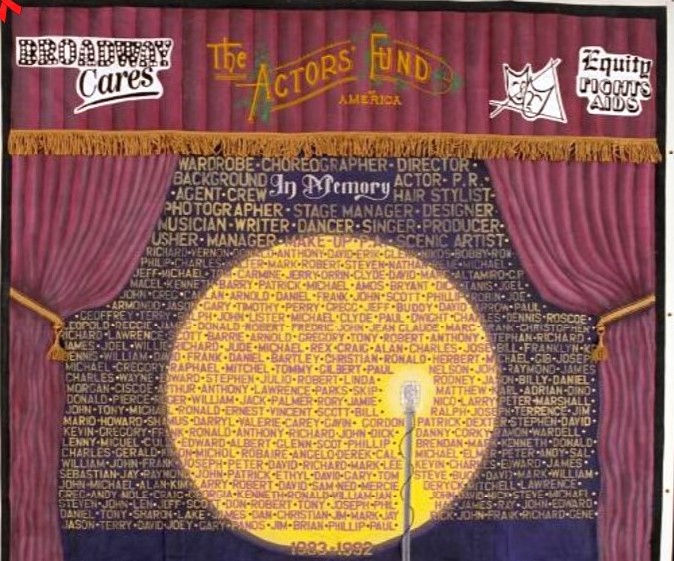
Lenny Baker, who won the 1977 Tony Award for Best Actor in a featured role (musical), dies of AIDS-related illness in a hospital in Hallandale Beach, Florida at the age of 37.
Learn More.Born Leonard Joel Baker in 1945 in Boston, he began his acting career in regional theater and spent several summers at the O’Neill Center’s National Playwrights Conference in Waterford, Connecticut. He told an interviewer in 1977 that the center was instrumental in his career, partly because he saw performances of the National Theater for the Deaf there.
”It’s perhaps because of watching them work,” Baker said, ”that I can be so brazen with comic uses of my body.”
After moving to New York City in 1969, Baker acted in Off-Broadway stage productions until making his Broadway stage debut in 1974 in The Freedom of the City. Baker won a Tony award and the Drama Desk Award as Outstanding Actor in 1977 for his performance in the musical I Love My Wife.
Baker also acted in films and television shows, including Paul Mazursky’s Next Stop, Greenwich Village (1976), for which he was nominated for a Golden Globe award. His other film credits included The Hospital (1971) and The Paper Chase (1973).
Following Baker’s death, a memorial service was held at The Public Theater, located at 425 Lafayette Street in New York City.
* * * * * *
Sources:
Photo of quilt panel from the AIDS Memorial Quilt
The New York Times, “Lenny Baker, 37, Stage Actor” by Eleanor Blau, April 13, 1982
IMDb, “Lenny Baker biography”

To the shock and dismay of many fans in San Francisco and New York City, The Advocate announces: “Founder of Cockettes, Hibiscus, Dead of GRID.”
Learn More.Hibiscus was famous on both coasts for founding and performing with the flamboyant theatrical groups The Cockettes and Angels of Light. He died of AIDS-related illness (then called “Gay-Related Immune Deficiency”) at St. Vincent’s Hospital in New York at the age of 32, becoming one of the earliest casualties of the epidemic.
Born George Edgerly Harris III in Bronxville, N.Y., he was the child of theater performers who relocated the family to a home on El Dorado Avenue in Clearwater Beach, Fla. Before long, George Jr. had founded his first theatrical group, the El Dorado Players, which performed in the family’s garage.
“He was fascinating even as a small child,” his mother Ann Harris told The New York Times Magazine in 2003. “All the other kids followed him and acted out his fantasies. He did Camelot one time and had the kids on bicycles with the handlebars as the horses’ heads. Another time he directed Cleopatra, and used the garden hose as the serpent and our cats as Cleopatra’s gifts to Caesar. He was very much the little producer.”
When his family returned to New York in 1964, George Jr. reprised the El Dorado Players, augmenting the troupe with children he met in Greenwich Village. He took acting and singing classes at Quintano’s School for Young Professionals, and soon he was cast as an extra in a milk commercial, a deaf-mute in a television series and an antiwar protester in an Off Broadway play called Peace Creeps, co-starring Al Pacino and James Earl Jones.
The latter role would be strangely prescient. On October 21, 1967, an 18-year-old George Jr. would be photographed placing a flower in a gun barrel pointed at him while taking part in an anti-war demonstration at the Pentagon. The photo, widely circulated in the media, became iconic of the anti-war movement and generational divide in the country.
Washington, D.C. was just a stop-over, through, of a trip he was taking to San Francisco with friend Irving Rosenthal, the author of the homoerotic novel Sheeper and the onetime lover of William Burroughs. Inspired by an image in a Cocteau novel, he changed his name to Hibiscus, and started wearing the glittery makeup, diaphanous robes and floral headpieces that would become his signature.
He joined Rosenthal’s commune, KaliFlower, which was dedicated to distributing free food and creating free art and theater. This was the fertile environment in which Hibiscus founded The Cockettes.
Hibiscus and other KaliFlower members first performed at the 1970 New Year’s Eve Show at the Palace Theater, an old Chinese movie house in North Beach. They called themselves The Cockettes, a bawdy allusion to the Rockettes, and danced a cancan to the Rolling Stones’ song Honky Tonk Women.
Under the leadership of Hibiscus, the group’s act quickly evolved into bigger, wilder, and more lavish productions, and The Cockettes’ shows fast became not-to-be-missed events. New shows were created every few weeks, with Paste on Paste, Gone with the Showboat to Oklahoma, and Tropical Heatwave/Hot Voodoo being some of the early productions.
Pearls Over Shanghai became the Cockettes first show featuring an original script, music and lyrics, and was an instant hit with fans. Some members of the Cockettes, like Sylvester and Devine, began to garner their own fan followings. During this time, Hibiscus found he could express his sexual identity with fearless abandon.
”He came out of the closet wearing the entire closet,” says Nicky Nichols, a fellow Cockette.
When some members of The Cockettes began insisting that they begin charging for their shows, Hibiscus refused and found himself expelled from the group he founded. Unperturbed, Hibiscus formed a new theatrical group called the Angels of Light Free Theater. Their shows included Flamingo Stampede and The Moroccan Operette, which Hibiscus described as being ”like Kabuki in Balinese drag.”
Among the people he convinced to perform with the Angels of Light was poet Allen Ginsberg, who appeared in drag for the first time. Hibiscus found another collaborator in his new boyfriend, Jack Coe, also known as Angel Jack, who eventually moved to New York with Hibiscus in 1972, around the same time that the Cockettes disbanded.
Upon his return to NYC, he recruitd his mother and three sisters (Jayne Anne, Eloise and Mary Lou) into an east coast version of the Angels of Light.
“I wrote almost all the music for the Angels of Light,” said his mother, Ann. “George would say, ‘Oh, I need a sheik scene, with a sheik in it,’ and then I would come up with a song.”
The group performed at the Theatre for the New City, where John Lennon was known to jump on the stage and sprinkle glitter on Hibiscus.
In the early 1980s, he and his sisters and brother formed the glitter rock group “Hibiscus and the Screaming Violets,” supported by musicians Ray Ploutz on bass, Bill Davis on guitar and Michael Pedulla on drums. But he had to stop performing in 1981 due to his escalating illness.
It’s testament to the power of his personality and creativity that the spirit of Hibiscus dominates the 2002 Cockettes documentary, even though the film’s focus is on the group. Decked out in gender-bending drag and tons of glitter, the flamboyant ensembles of both The Cockettes and Angels of Light are considered to be the inspiration for later theater productions like The Rocky Horror Picture Show and acts like The New York Dolls.
* * * * * *
Sources:
Photo of quilt panel from the AIDS Memorial Quilt
The New York Times Magazine, “Karma Chameleon” by Horacio Silva, August 17, 2003
The Washington Post, “Flowers, Guns and an Iconic Shapshot” by David Montgomery, March 18, 2007
The Cockettes, A Film by David Weissman and Bill Weber, 2002 (trailer)
Hibiscus and the Angels of Light, video (YouTube)
The New York Times publishes the first media mention of the term “GRID” (Gay-Related Immune Deficiency), deepening public perceptions that HIV/AIDS is solely related to homosexuality.
Learn More.Under the headline “New Homosexual Disorder Worries Health Officials,” the Times introduced its readers to “a serious disorder of the immune system” that had proved fatal in 136 people to date.
“It was colloquially referred to as GRID – ‘Gay Related Immune Deficiency’ or ‘Gay Related Immune Disease,’ as if there was something intrinsic about being gay that made people susceptible to it,” wrote Carla Tsampiras in The Conversation.
While the Times article identified 13 cases of the disease in heterosexual women, it went on to state, “Most cases have occurred among homosexual men, in particular those who have had numerous sexual partners, often anonymous partners whose identity remains unknown.”
Even once the disease was renamed HIV/AIDS, the stigmatization continued. Early research elicited categories of people, referred to as “high-risk groups,” who were apparently at increased risk of having AIDS. They were informally known as “the Four-H Club” — homosexuals, Haitians, hemophiliacs and heroin users. Later, “hookers” were added to the list.
“As a result, AIDS avatars — such as The Homosexual, The Prostitute, and The Drug Abuser — were created, drawing on long histories of social and medical prejudice and othering of certain groups of people,” said Carla Tsampiras, Senior Lecturer in Medical Humanities at the University of Cape Town. “The avatars drew on existing stereotypes and reinforced them, reflecting existing prejudices or social attitudes relating to sexuality, sexual orientation, race, class and gender.”
* * * * * *
Sources:
The New York Times, “New Homosexual Disorder Worries Health Officials” by Lawrence K. Altman, May 11, 1982
The Conversation, “AIDS: What Drove Three Decades of Acronyms and Avatars?” by Carla Tsampiras, June 4, 2015
The Los Angeles Times publishes the story “Mysterious Fever Now an Epidemic” on its front page, marking the first time the disease receives top coverage in the mainstream media.
Learn More.* * * * * *
Source:
Los Angeles Times, “Anti-Gay Bias? : Coverage of AIDS Story: A Slow Start” by David Shaw, December 20, 1987
In one of the earliest broadcast news stories about AIDS, reporter Barry Peterson interviews gay men diagnosed with Kaposi’s Sarcoma.
Learn More.The news segment opens with AIDS activist Bobbi Campbell talking about his shock at the age of 29, when he was told he had a deadly form of cancer. Then, the segment shows Campbell being examined by his doctor, Marcus Conant, M.D.
Next, New York-based AIDS activist Larry Kramer talks about how the disease is killing more people than toxic shock syndrome and Legionnaire’s disease — two bacterial infections receiving a lot of media attention at the time. When the reporter asks Campbell why no one is addressing the AIDS epidemic, Kramer replies, “Well, I think it’s because it’s a gay cancer.”
James Curran, M.D., speaks on behalf of the Centers for Disease Control and Prevention, telling CBS News that now is the time to conduct AIDS research to determine how the disease was being transmitted. The reporter notes that “there is almost no money being spent so far” for AIDS research.
The reporter closes the segment with this statement: “For Bobbi Campbell, it is a race against time. How long before he and others who have this disease finally have answers, finally have the hope of a cure?”
Campbell would die of AIDS-related illness on August 15, 1984, about 26 months after the report aired on CBS News.
It would be almost 12 years later (1996) before highly active antiretroviral therapy (HAART) would become widely available to people living with HIV/AIDS, finally offering the hope of survival. Deaths from AIDS-related illness fell almost immediately in the industrialized world, and the way we think about HIV and AIDS changed forever.

The Sisters of Perpetual Indulgence creates Play Fair! — the first “safer sex” pamphlet to address the growing AIDS epidemic.
Learn More.The Sisters distributed 16,000 copies of Play Fair! during the San Francisco Gay & Lesbian parade in June 1982.
Written by Sister Florence Nightmare and Sister Roz Erection, who outside the Order were known as registered nurses Bobbi Campbell and Baruch Golden, Play Fair! was among the first guides promoting safe sex and raising awareness around sexually transmitted diseases.
The Sisters originated in 1979 with three gay men who wanted to combine radical politics, street theater, and high camp, according to Will Kohler. Having obtained nuns’ habits from a community theater production of The Sound of Music, these men (a.k.a., Sister Vicious Power Hungry Bitch, Sister Missionary Position, and Sister Roz Erection ) turned heads as they strolled Castro Street on Easter Sunday.
By 1982, the Sisterhood had many members and promoted a lively campaign around sex-positivity through a combination of fundraising, community outreach and events. With growing anxiety and concern around the spread of Kaposi’s sarcoma and other immune disorders among gay men, it was inevitable that the Sisters would incorporate AIDS awareness into its mission.
For over 40 years, the order of queer and trans nuns has been spreading its ministry across San Francisco, the U.S., and the world. Each professed nun takes a religious name (usually irreverent and hilarious). For example, cities, events and venues have been ministered to by Sisters Psychedelia, Hellen Wheels, Innocenta, Rhoda Kill, Lotti Da, and Hysterectoria.
Although originally founded as an “Order of Gay Male Nuns,” the group now includes gay, lesbian, bisexual, heterosexual, and transgendered men and women. Many of their rituals are influenced by Eastern religious practices and beliefs, as well as by Roman Catholicism. Their doctrine stresses universal joy and the expiation of guilt.
Members of the Sisters of Perpetual Indulgence who have died are referred by the Sisters as “Nuns of the Above.”
* * * * * *
Sources:
The Sisters Of Perpetual Indulgence, “Sistory”
The Abbey of St Joan, “Play Fair”
Back2Stonewall, “Gay History – April 15, 1979: San Francisco’s Sisters of Perpetual Indulgence Founded,” April 16, 2022
The Culture Trip, “Meet the Sisters of Perpetual Indulgence, San Francisco’s Order of Queer Nuns” by Deanna Morgado, July 3, 2019
GLBTQ Archive, “Sisters of Perpetual Indulgence” by Robert Kellerman, 2002
Louis “Lou” Maletta launches the Gay Cable Network on Manhattan cable channel 35, starting with the program Men in Films and then expanding its programming to include news about the AIDS crisis.
Learn More.The Gay Cable Network broke new ground by providing television programming from a gay perspective, and often featured news about AIDS that was broadcast nowhere else in the country. While the network existed on Manhattan cable in New York City, Maletta also made his programs available to other cities like San Francisco, Cincinnati and Atlanta, which broadcast his taped programs.
Maletta’s first program, Men & Film, featured strategically edited gay pornographic material that “just barely passed even early cable access censorship standards,” according to Back2Stonewall, Maletta would announce at the start of each show that his goal with the program was to “put the male body back on the map.”
Within months, Maletta expanded his programming to include news, sports and entertainment, and the network became a forum for a range of issues facing the gay community.
In a 2009 interview with Gay City News, Maletta said he realized he needed to provide gay-centric programming about the AIDS crisis after he witnessed a 30-year-old friend become “someone who looked 90 six months after being diagnosed.”
Maletta arranged for officials from New York City’s health department and Gay Men’s Health Crisis to provide updates on HIV/AIDS healthcare and research developments.
Maletta’s Gay Week in Review was sponsored by the Human Rights Campaign, and Naming Names was produced weekly by the Gay and Lesbian Alliance Against Defamation, according to Gay City News. Maletta himself covered arts and entertainment in a show called Be My Guest, which featured celebrities including Harvey Fierstein, Derek Jarman, Vito Russo, Patrick Stewart, Tony Kushner, Quentin Crisp, and Divine.
The network’s news program, Pride and Progress, eventually became Gay USA, a show co-hosted by Ann Northrop and Andy Humm that outlived the network and today is distributed nationally by Free Speech TV.
Gay USA covered the Democratic and Republican national conventions from 1984 to 2000 with reporters interviewing political leaders from Dick Cheney and George W. Bush to Jesse Jackson and Ann Richards. The news program also covered AIDS demonstrations outside the conventions, as well as numerous rallies in Washington and New York City.
“It was critical to the LGBT rights movement,” Kenneth Sherrill, a political science professor at Hunter College, told The New York Times. “Mainstream television wasn’t rushing to cover the movement, and public access cable provided entrée for social and political groups that were traditionally excluded. Lou Maletta’s programming allowed voices of the gay community to speak for themselves.”
Maletta videotaped his programs at first out of his apartment on West 15th Street, which he shared with Luke Valenti, his domestic partner of 37 years, according to Gay City News. Later, Maletta operated out of Manhattan buildings that doubled as sex clubs late at night.
“There was nothing quite like bringing a candidate for public office in for an interview with an erotic mural looking down at them from off-stage and lubricant residue still on the chairs,” Humm of Gay USA wrote. “But no one walked out and many sought the chance to be on the shows, including Ed Koch and David Dinkins when they ran against each other for mayor in 1989.”
In 2001, Maletta would shut down the network. He died in upstate New York about 10 years later of liver cancer at the age 74.
“He had a tremendous vision and unlike most people, he acted on it and made it happen. Because he was such a rebel and way before his time, he didn’t reap the benefits, which could make him cranky and difficult. But he is a really important figure in our community,” said Northrup of Gay USA.
“Lou had this grand vision of a 24-hour gay cable network,” Humm of Gay USA told The New York Times. “That didn’t happen for him.”
Still, Maletta’s legacy continues with the endurance of Gay USA and the introduction in 2005 of Logo, a gay-oriented 24-hour cable channel, wrote NYT reporter Dennis Hevesi.
In 2009, the entire archives of the Gay Cable Network were acquired by New York University’s Fales Library for restoration, and preservation.
“It’s more than 6,000 hours of film about civil rights and human rights,” said Allen Zwickler, who brokered the deal with NYU. Zwickler’s brother Phil was a documentarian and GCN correspondent before he died of AIDS-related illness in 1991 at the age of 36. “It is so incredible that it had to be preserved.”
Larry Hinneman, a dancer with the Margaret Jenkins Dance Company in San Francisco, dies of AIDS-related illness.
Learn More.The exact date of Hinneman’s death is not known, nor is his age at the time of his death.
* * * * * *
Source:
San Francisco Chronicle, “AIDS at 25” by Steven Winn, June 8, 2006
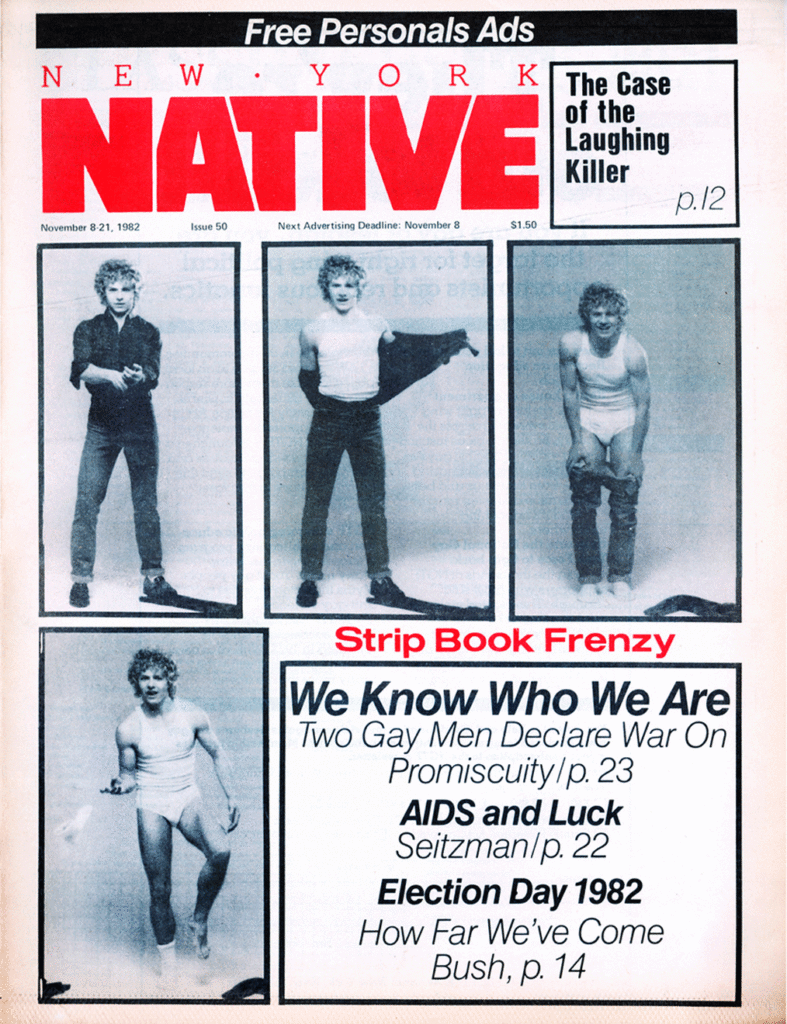
In their New York Native article “We Know Who We Are,” Michael Callen and Richard Berkowitz suggests “excessive promiscuity” as a risk factor for contracting AIDS.
Learn More.Callen and Berkowitz, who wrote the article with the assistance of Callen’s partner Richard Dworkin, were New Yorkers living with AIDS.
After seeing the disease quickly progress and kill people they knew, they wanted to do something that could save lives. In their article, they warned readers against “the cumulative effects of re-exposure to CMV [cytomegalovirus] and other infections.”
“Deep down, we know who we are and why we are sick,” they wrote for the November 8, 1982 edition of the gay weekly.
The reason why men were sick, they theorized, was because they lived a life of “excessive promiscuity on the urban gay circuit of bathhouses, backrooms, balconies, sex clubs, meat racks and tearooms.”
Callen and Berkowitz argued that AIDS was caused by a combination of factors associated with a “promiscuous lifestyle” – drug use, multiple sexual partners and repeated exposure to other sexually-transmissible infections.
After publication, the article drew a torrent of angry criticism from readers of the Native, as well as from gay periodicals across North America, including the Toronto newspaper Body Politic, which accused Callen and Berkowitz of creating unnecessary panic in the community and working against the tide of gay liberation.
“It was widely criticized – not least because it had no scientific basis, and also because it assumed that all gay men with AIDS had lived so-called ‘promiscuous’ lifestyles,” said Colin Clews, author of Gay in the ’80s.
Even so, the article served as a clarion call for many and offered a considerable amount of information that could be useful to its readers:
The article also included these remarkably prescient suggestions:
Still, the criticism from the community stung. In the months that followed, Callen turned his attention to his personal life, tending to his own health and that of friends. But Berkowitz was not deterred; he began a new project which would eventually become the 46-page groundbreaking pamphlet How to Have Sex in an Epidemic.
Callen would eventually work with Berkowitz on the new project, and they would both take what they learned from the reponse to their Native article to develop an entirely new approach to fostering AIDS awareness. Published in the summer of 1983, How to Have Sex in an Epidemic would be embraced by the community and eventually have a widespread impact on the sexual practices of gay men.
* * * * *
Sources:
Richard Berkowitz Files, “We Know Who We Are: Two Gay Men Declare War on Promiscuity” by Michael Callen and Richard Berkowitz with Richard Dworkin
Gay in the ’80s by Colin Clews (self-published)
The U.S. Health & Human Services Department launched the National AIDS Hotline (NAH). and by the end of the first month, it’s receiving 8,000-10,000 calls a day.
Learn More.Operated by the U.S. Public Health Service, the AIDS Hotline responds to public inquiries about the disease, and by July 28, the hotline has to be expanded from three phonelines to eight to accommodate the high volume of calls.
In 1985, HHS transferred the hotline to the Center for Disease Control and eventually services were expanded in October 1987 to become the National AIDS Clearinghouse, with electronic linkage to computerized referral databases.
Spanish-languages services on the hotline were not included until August 1988. A month later, the hotline adopted TTY services for the hearing-impaired.
By February 1991, the total of calls to the hotline in eight years of service was 5 million.
* * * * * *
Source:
National AIDS Hotline: HIV and AIDS Information Service through a Toll-Free Telephone System by Robert R. Waller and Lynn W. Lisella (CDC’s HIV Public Information and Education Programs, November-December 1991)

The New York Times Magazine releases “AIDS: A New Disease’s Deadly Odyssey,” the first indepth article on AIDS in the mainstream press.
Learn More.The article describes how the virus — “the century’s most virulent epidemic” — is spreading in “big-city homosexual communities” and has become the second-leading cause of death in hemophiliacs.
Dr. James W. Curran, head of the AIDS task force at the Centers for Disease Control, told the NYT Magazine reporter that AIDS was moving into mainstream America, and scientists still have not identified the disease’s cause or a way to stop its spread.
“The incidence of AIDS has nearly tripled in the past year, from about seven new cases a week to 20 or more,” Dr. Curran says, citing recently released data that shows that the CDC received reports of 92 cases of AIDS in December 1982, about one-third more than had been received in any other previous month.
The article describes how the CDC is struggling to identify the cause of AIDS. The work is being done by 20 full-time physicians and other professionals, with help from 80 professionals working part-time, focusing on four locations of the outbreak – New York, San Francisco, Los Angeles and Miami.
The medical investigators have bee able to broadly trace the spread of the disease, the article states.
Beginning in spring 1981, clinicians in New York City began to see a surprising number of young male patients with Kaposi’s sarcoma, an extremely rare cancer usually seen in elderly Mediterranean men
At about the same time, infectious-disease specialists throughout the city noted a surge in another rare disease, Pneumocystis pneumonia. At the weekly citywide infectious-disease meetings sponsored by the city’s Department of Health, where physicians present their most perplexing cases, medical professionals started sharing information about these cases.
In mid-1981, the CDC formed a special task force to investigate these unusual cases, and then published its first findings in June and July in Morbidity and Mortality Weekly Report. Of the 116 patients identified at the time, about 30% had Kaposi’s sarcoma, about 50% had Pneumocystis pneumonia, and about 10% had both. The remaining 10% had unusual infections that also usually occur in immunosuppressed patients.
Half of the case subjects lived in New York City, and the next-largest group lived in California. An indepth study of 13 patients in Los Angeles conducted by Dr. William W. Darrow and Dr. David Auerbach, both CDC researchers, was able to compare a list of all the sex partners that the patients (or their survivors) could name for the previous five years with a roster of all the AIDS cases in the country.
The result of the comparison revealed that nine of the 13 case subjects had common sexual contacts. This was the so-called “LA cluster” of AIDS patients. Later, a missing link was found between LA and NYC: a patient from New York was identified as having been a sexual partner of four men in the LA cluster, as well as of four NYC men who also developed AIDS.
The widely-read article also quoted activist Larry Kramer: “You don’t know what it’s like to be gay and living in New York. It’s like being in wartime. We don’t know when the bomb is going to fall.”
Kramer described losing 18 friends in the previous 18 months to AIDS, and said another 12 are seriously ill.
“Doctors and psychiatrists are pleading with the community to learn a new way of socializing. They’re begging us, in the name of all who died, to learn how to date,” said Kramer.
The article also addresses the issue of whether the nation’s blood supply is safe. At the time, the CDC had received a total of eight confirmed reports of hemophiliacs with AIDS, six of whom have died.
”I’m concerned and worried,” says Dr. Joseph Bove, chairman of the American Association of Blood Banks committee on transfusion-transmitted diseases and a professor of laboratory medicine at the Yale University School of Medicine. ”But as a scientist, I have to look at the evidence. And the evidence is that ordinary blood transfusions are not transmitting AIDS.”
Dr. Bove cited the number of people who had received transfusions in the two years since AIDS was first identified — 20 million — and claimed that there was no “epidemic of AIDS spread by blood.”
Dr. Bruce L. Evatt, director of the CDC’s Division of AIDS,” said Dr. Evatt, adding that while the risk appears to be low, it may increase significantly.
At the time the article was published, the CDC had received reports of 958 individuals with the AIDS virus, and 365 were already being treated for the deadly symptoms of AIDS.
* * * * * *
Source:
New York Times Magazine, “AIDS: A New Disease’s Deadly Odyssey” by Robin Marantz Henig,

Readers of the New York Native take notice of “1,112 and Counting,” AIDS activist Larry Kramer’s urgent plea for the NY Gay Community to get angry at the lack of government support and scientific advances in the fight against AIDS.
Learn More.Published in the New York Native, Kramer provides a blistering assessment of the impact of AIDS on the gay community, the quickly rising numbers of sick and dying gay men and the slow pace of scientific progress in finding a cause for AIDS.
Kramer’s historic essay opens with:
“If this article doesn’t scare the shit out of you, we’re in real trouble. If this article doesn’t rouse you to anger, fury, rage, and action, gay men may have no future on this earth. Our continued existence depends on just how angry you can get.”
This essay was just the beginning for Kramer, in what would become a lifetime of activism and advocacy. He would go on to write The Normal Heart, the first serious artistic examination of the AIDS crisis, and he would found ACT UP, a protest organization widely credited with having changed public health policy and the public’s awareness of HIV and AIDS.
“There is no question in my mind that Larry helped change medicine in this country. And he helped change it for the better. In American medicine there are two eras. Before Larry and after Larry,” said Dr. Anthony Fauci.
* * * * * *
Sources:
New Yorker Magazine, “Larry Kramer, Public Nuisance,” by Michael Specter, May 5, 2002
The Bilerico Project on LGBTQ Nation, “Larry Kramer’s Historic Essay: AIDS At 30,” June 14, 2011
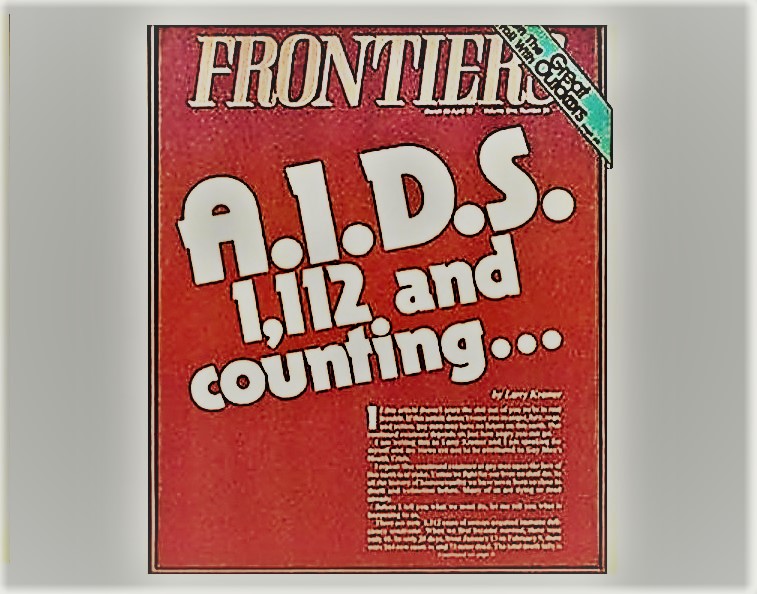
Los Angeles publisher Bob Craig publishes activist Larry Kramer’s essay “1,112 and Counting” in Frontiers magazine. Many of the gay bars where the free community magazine is distributed throw it out.
Learn More.First pubished in the March 14-27, 1983 edition of New York Native, Kramer’s long, comprehensive essay expresses frustration, anger and despair. A newcomer to the gay press, the bi-weekly news-magazine Frontiers gave the essay prominent placement on its cover.
After listing the names of 20 friends who had died of the disease (“and one more, who will be dead by the time these words appear in print”), Kramer closed with a plea: “Volunteers Needed for Civil Disobedience.”
By the end of 1983, 2,807 cases of (and 2,118 deaths from) HIV/AIDS had been reported in the U.S.
* * * * * *
Sources:
Los Angeles Blade, “March 27, 1983: 1,112 and Counting” by Larry Kramer, May 27, 2020
LGBT History Archives, “AIDS: 1,112 and Counting …” by Larry Kramer
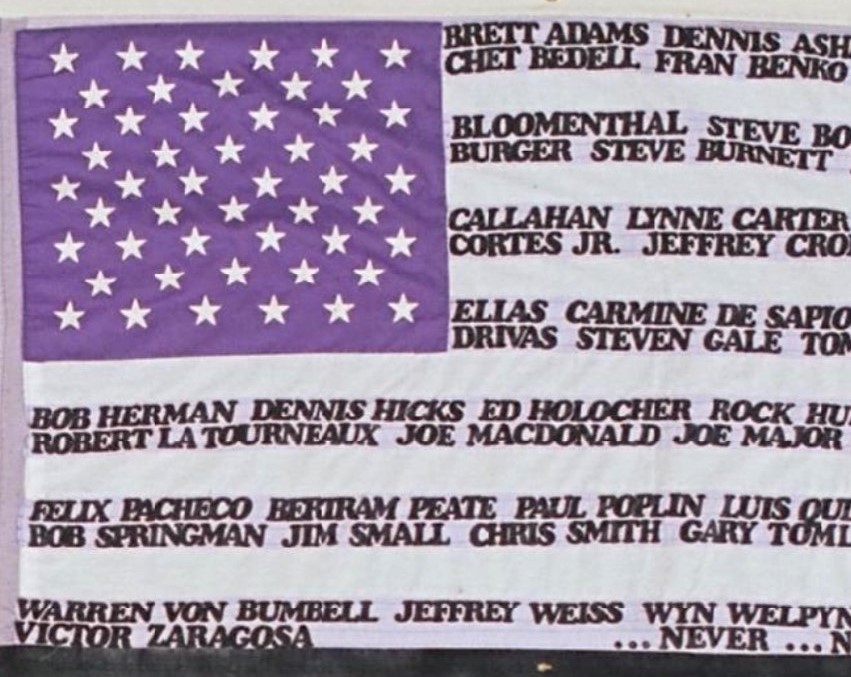
Joe MacDonald — the most popular male model of his time and a favorite photography subject of Andy Warhol and Bruce Weber — dies of AIDS-related illness in New York at the age of 37.
Learn More.Square-jawed and classicly handsome, he was frequently featured in GQ magazine during its Haber-Coulianos-Sterzin era, described by Meredith Etherington-Smith, who was GQ’s editor in the 1970s, as “so Zeitgeisty, in a tiny window of time when homosexuality was chic but not yet widely accepted.” Considered to be the first male supermodel, MacDonald counted David Hockney among his many friends and he enjoyed collecting art.
Friends were shocked to see how much MacDonald’s appearance had changed when his photo was featured in an early 1983 advertisement appearing in The New York Times fashion supplement, the results of MacDonald’s final modeling assignment.
“He looked very old,” Susi Gilder, a model who knew MacDonald personally, would tell New York magazine for an article published in June 1983. “The eyes were just very sad.”
In Vogue magazine’s 2020 retrospective on the AIDS crisis, fashion designer Michael Kors recalled MacDonald as the “first famous person who passed away” from AIDS.
“When we first started reading about [HIV/AIDS] and hearing about it, people did not want to acknowledge that this disease didn’t discriminate,” Kors told Vogue. “People thought, oh, if you’re young and you’re healthy and you, quote, live a clean life, you’re not going to get it. And then they started seeing people like Joe MacDonald and realized this was not selective. The reality became very harsh at that point.”
As the first AIDS casualty in the fashion industry, the news of MacDonald’s death sent shockwaves through New York.
“I remember walking in NYC on Columbus and 83rd – on the corner – one summer night,” model Rosie Vela told The AIDS Memorial on Instagram. “I passed Joe sitting at a crowded outdoors cafe. It was a year before he died.”
“He stood up when he saw me, and invited me to sit with him,” Vela recalled. “He was gorgeous, elegant and kind. I’ll never forget how welcome he made me feel. A true gentleman.”
* * * * * *
Sources:
Photo of quilt panel from the AIDS Memorial Quilt
GQ magazine, “It All Started Here: The Gay Legacy of GQ” by David Kamp, June 23, 2017
New York magazine, “AIDS Anxiety” by Michael Daly, May 20, 1983
Vogue magazine, “Chapter One: How Fashion Was Forever Changed by ‘The Gay Plague’” by Phillip Picardi, December 16, 2020
The AIDS Memorial on Instagram, tribute post about Joe MacDonald
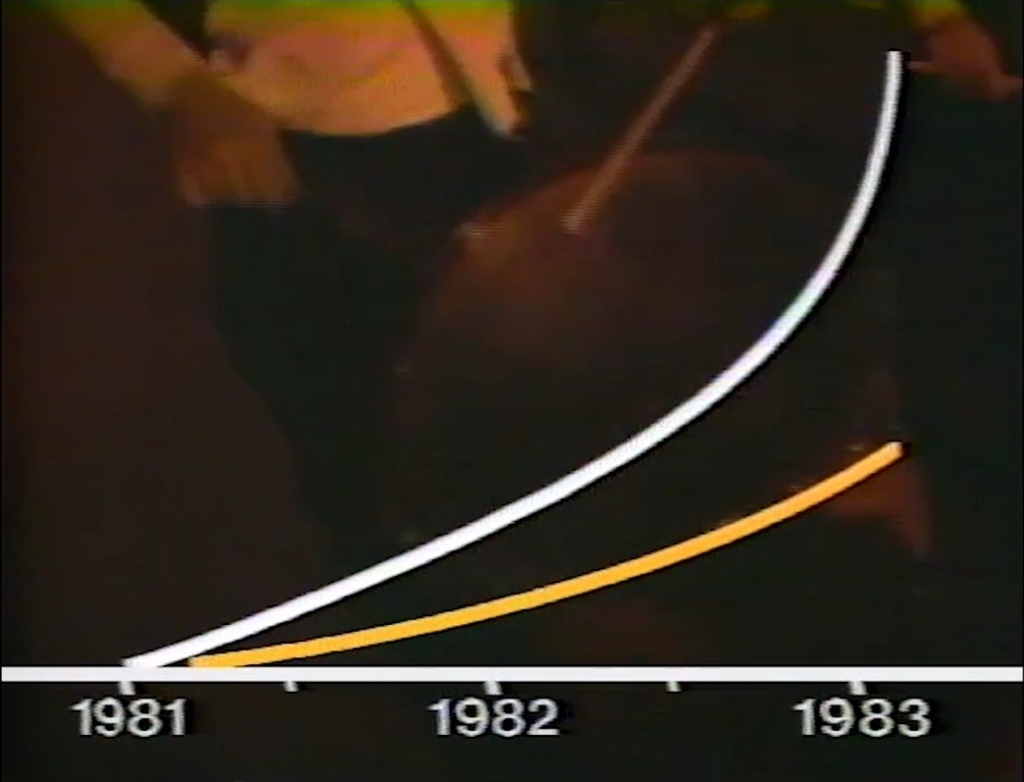
The news show 20/20 broadcasts the first investigative report on AIDS for network TV with reporter Geraldo Rivera.
Learn More.The 17-minute story features footage of hundreds of activists in AIDS memorial marches in San Francisco, New York City and Houston, as well as interviews with persons living with AIDS Ken Ramsaur, Bob Cecchi, Ron Resio, and Bill Burke
Reporter Geraldo Rivera charts the history of AIDS, starting with the first AIDS cases appearing in New York City and San Francisco in 1979 and the early occurances with members of the gay population, intravenous drug users, and Haitian immigrants.
For the story, Rivera interviewed several people from the front lines of the AIDS crisis, including Marcus Conant, M.D., of the University of California San Francisco Medical Center, who warns that the “entire American public” should be concerned about the disease. Dr. Conant tells Rivera that AIDS will become a major health crisis in the U.S. if research funds are not quickly allocated to develop effective ways to prevent and treat the disease.
“And so the evil genie is out of the bottle,” says Rivera, adding that AIDS has been diagnosed in 16 states already.
Rivera also interviews Larry Kramer, co-founder of the Gay Men’s Health Crisis in New York. In his characteristic animated fashion, Kramer criticizes The New York Times for failing to report on the AIDS crisis and expresses his frustration with the Centers for Disease Control for failing to add AIDS to its list of communicable diseases that public officials are required to report.
Rivera also includes footage of Rep. Henry Waxman in Congressional hearings, voicing criticism of the Reagan Administration for its lack of resources and action.
* * * * *
Source:
Vimeo | Lovett Productions, “20/20 AIDS Broadcast,” May 19, 1983
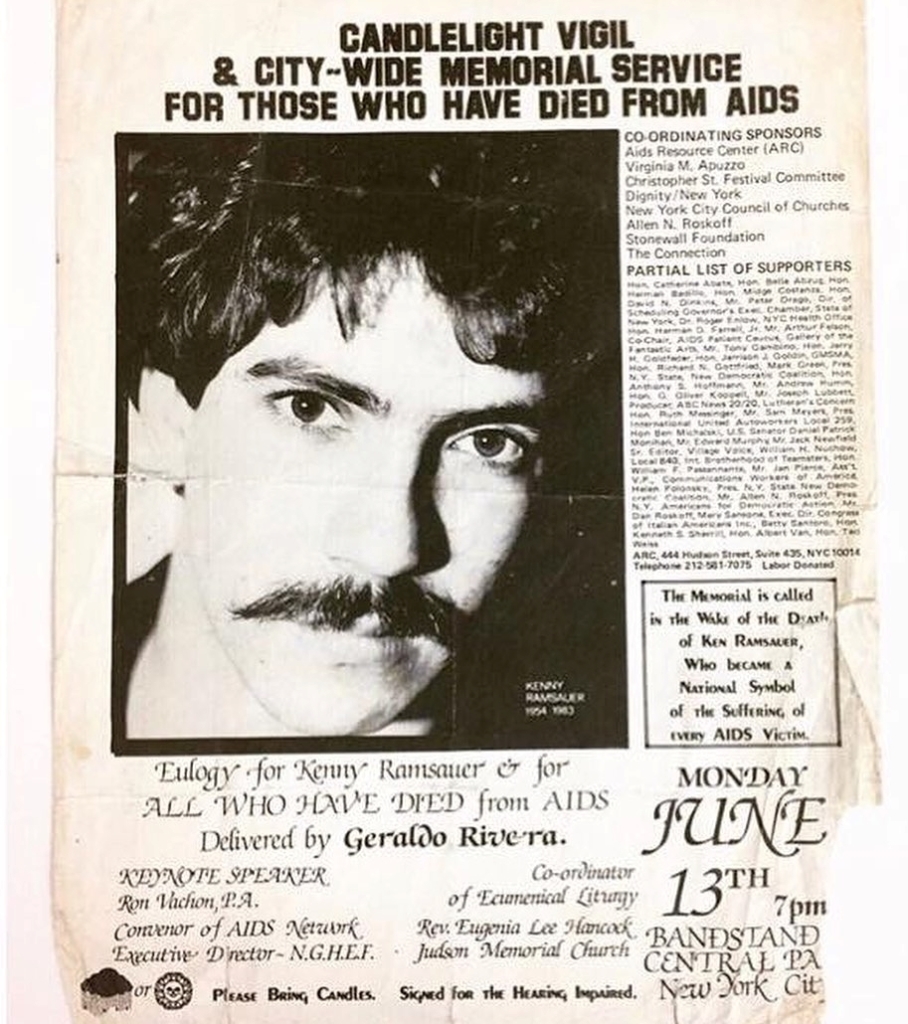
Ken Ramsauer, a businessman who was featured in reporter Geraldo Rivera’s investigative report for ABC’s 20/20, dies of AIDS-related illness in New York City. He was 29 years old.
Learn More.Ramsauer was a freelance lighting designer and hardware store manager who became the first person with AIDS to be the subject of a national television program when he was interviewed by Geraldo Rivera on 20/20.
His final televised wish was that people might gather in Central Park to remember those who had died of AIDS. The following month on June 13, more than 1,500 would gather in Central Park for a candlelight vigil to commemorate Ramsauer and others who died of AIDS. The event featured a eulogy by Rivera, a speech by New York Mayor Ed Koch, and a reading of the names of the 600 people known to have died from AIDS by that time.
”Kenny Ramsauer wanted the people of New York and of this country to learn about the disease,” Rivera told the people gathered at the park’s Naumberg Bandshell on that early summer evening. ”He wanted society to know the discrimination and negative publicity that has allowed this disease a mortal head start.”
The vigil was considered the first large gathering acknowledging the existence of the epidemic.
David France, author of How to Survive a Plague, attended the vigil with a friend and later wrote:
“The plaza was crowded with 1,500 mourners cupping candles against the darkening sky. As our eyes landed on one young man after another, it became obvious that many of them were seriously ill. A dozen men were in wheelchairs, so wasted they looked like caricatures of starvation. I watched one young man twist in pain that wsa caused, apparently, by the barest gusts of wind around us.”
Frances goes on to write that 722 cases of AIDS were reported in New York at the time, but judging from the scene around him, the numbers were likely considerably higher.
“We had found the plague,” he wrote.
* * * * * * *
Sources:
The New York Times, “1,500 Attend Central Park Memorial Service for AIDS Victim” by Lindsey Gruson, June 14, 1983
How to Survive a Plague by David France (MacMillan, 2017)
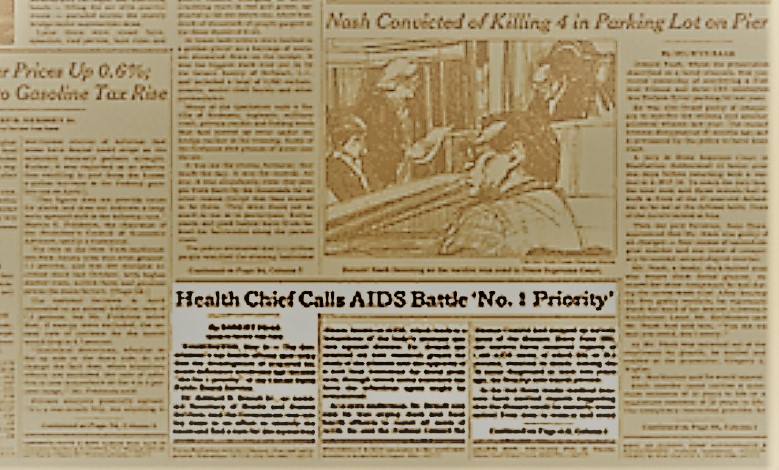
The New York Times publishes its first front-page story on AIDS, “Health Chief Calls AIDS Battle ‘No. 1 Priority’.” The article reports on the federal response to the growing AIDS epidemic.
Learn More.By the time the article reaches newstands, 1,450 cases of AIDS have been reported and 558 of those individuals have died.
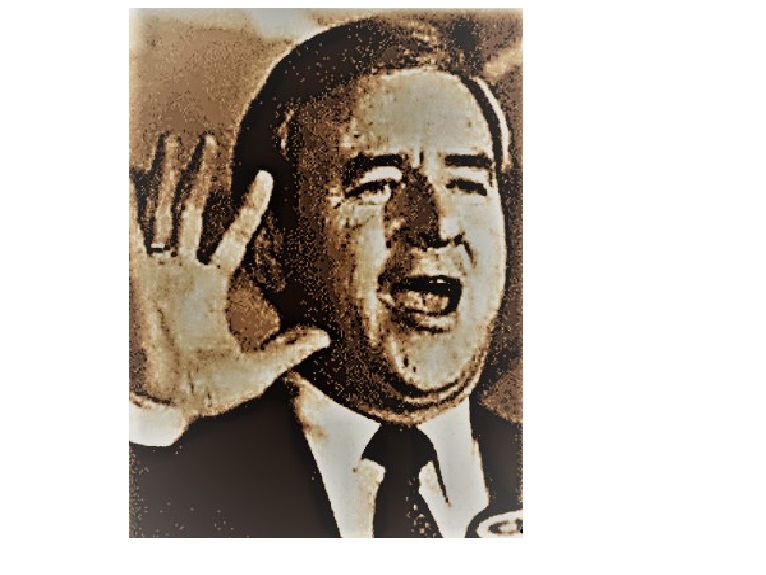
Conservative televangelist Jerry Falwell, founder of the Moral Majority, tells his followers that “AIDS is not just God’s punishment for homosexuals, it is God’s punishment for the society that tolerates homosexuals.”
Learn More.A notious homophobe and segregationalist popular with religious conservatives, Falwell continues the campaign of stigmatization against the LGBTQ community that he began in the 1970s with Anita Bryant’s “Save Our Children” campaign.
The following month, Falwell’s organization, Moral Majority, would publish a report on AIDS titled “Homosexual Diseases Threaten American Families.” It featured a white couple with two young children, all wearing surgical masks, suggesting AIDS is a gay disease that can be spread casually. It also poses gay men as adverse to “families,” as if the two were mutually exclusive.
Many suspect that Falwell’s close ties to President Ronald Reagan directly contributed to the Administration’s refusal to address AIDS.
* * * * * *
Sources:
The Milford Daily News, “Press: The Sad Legacy of Jerry Falwell” by Bill Press, May 18, 2007
PBS, “Anti-gay Organizing on the Right” by Neil Miller (Out of the Past: Gay and Lesbian History from 1869 to the Present, Vintage Books, 1995).
American Historical Association, “Fearing a Fear of Germs” by Heather Murray, October 2, 2020
Smithsonian National Museum of Natural History, “Moral Majority Report,” July 1983
Produced for a gay audience, I Will Survive is broadcast on Los Angeles public radio station KPFK 90.7 FM as part of a day of programming celebrating gay pride month.
Learn More.In the one-hour radio show, producer David Hunt examined “the conflicting currents of fear, greed, despair and denial that confronted the gay community in the early years of the AIDS epidemic.”
“For its time, the documentary is a fairly clear-eyed look at the emerging AIDS epidemic,” writes Hunt on his website Tell Me David. “It correctly emphasizes the medical consensus that a virus is the cause of the disease, and urges education, personal responsibility and collective action as the tools for fighting it.”
Hunt credits early activists with saving the lives of many people in the community in the early 1980s.
“Without the leadership of people like Larry Kramer, Randy Shilts, Harry Britt, Bobbi Campbell, Matt Redman and others, the suffering would have been far worse, the toll far greater,” he said. “I remember wondering in the early days, in 1981 and 1982, whether any of us would survive. Titling the documentary I Will Survive was an act of false bravado as much as it was a hat tip to Bobbi Campbell, who wore a button emblazoned with that message.”
* * * * * *
Source:
Tell Me David, “I Will Survive” by David Hunt, May 1, 2015

Metropolitan Community Church founder Rev. Troy Perry debates Moral Majority leader Jerry Falwell on the subject of “the AIDS controversy” on national TV.
Learn More.In the debate, Falwell calls for the mandatory closing of bathhouses, saying that AIDS is caused by homosexual promiscuity. Then he walks back his previous statement regarding AIDS as a punishment against homosexuality. He cites incorrect numbers regarding deaths and illness from AIDS.
The Rev. Perry responds, saying that diseases are the result of many variables, and that Falwell is dimishing the dangers of AIDS when he compares it with herpes. He goes on to tell the TV audience that the majority of members in the LGBT community are in loving relationships, and that is the norm.
The Rev. Perry founded the LGBTQ-inclusive Metropolitan Community Church in 1968 after recovering from an attempt to end his own life. He is well-known in the community for filing suit against the Los Angeles Police Department to clear the way for the city’s first Pride parade in 1970.
* * * * * *
Source:
Gay bars in West Hollywood and Los Angeles report a 20% drop in business, according to the Los Angeles Times. Six area bathhouses also report a 50% plunge in revenue.
Learn More.Some community members, like Circus Disco owner Gene La Pietra, think the drop may be related to an earlier news article that erroneously reported AIDS can be spread through casual contact.
* * * * * *
Source:
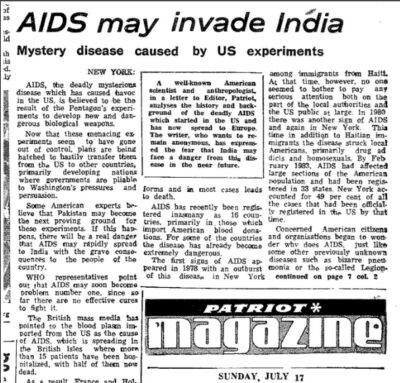
The Indian newspaper Patriot publishes an anonymous report claiming that the AIDS virus was created by the Pentagon as a potential biological weapon. The account, which was an entire fabrication, was part of a Soviet disinformation campaign.
Learn More.In a letter to the editor published on the front page of the Patriot under the title “AIDS May Invade India: Mystery Disease Caused by U.S. Experiments,” the writer cited the involvement of U.S. special services and the Pentagon in the appearance and rapid spread of AIDS.
The writer claimed to be a “well-known American scientist and anthropologist,” but in fact, the source of the account was a disinformation campaign led by the KGB, the foreign intelligence agency of the Soviet Union which was engaged in the “Cold War” against the U.S.
The Patriot was “a known front for KGB disinformation,” according to the Wilson Center, a U.S. organization dedicated to non-partisan counsel on global affairs.
The letter claimed that the AIDS virus was developed at Fort Detrick, an Army-run biological warfare laboratory located in Frederick, Maryland. Because the U.S. military was allegedly conducting experiments in neighboring Pakistan, the letter’s claims inferred that AIDS could soon spread to India.
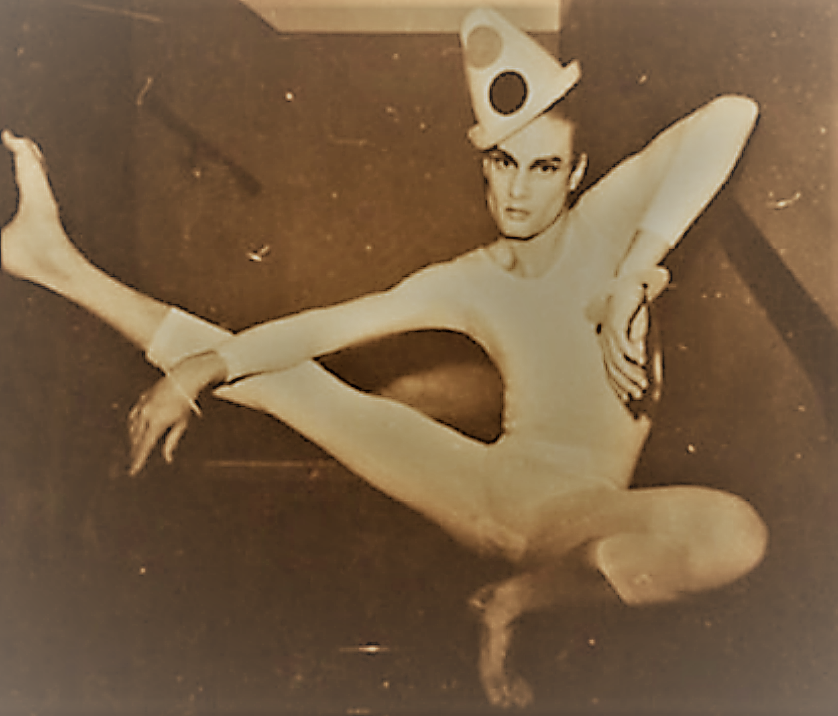
Rock star Jobriath dies of AIDS-related illness at the age of 36. He was the first openly gay pop singerto be signed to a major record label, and one of the first internationally famous musicians to die of AIDS.
Learn More.Born Bruce Wayne Campbell and raised in King of Prussia, Pennsylvania, Jobriath started his music career in the West Coast production of the musical Hair, receiving positive reviews in the lead role of Woof, a character implied to be gay. After leaving the production in 1969, he joined the folk-rock band Pidgeon as their lead singer and guitarist, followed by a two-album solo deal with Elektra Records in 1972.
His debut album Jobriath, released in June 1973, would feature an album sleeve design by photographer Shig Ikeda depicting a nude Jobriath as an ancient Greek statue. This photograph was used in an extensive publicity campaign for the album release.
Critical praise for the album followed the hype, and he was often compared with David Bowie, some critics contending that Jobriath had more talent than Bowie. But American music fans of the 1970s weren’t ready for a talent like Jobriath.
“At a concert at the Nassau Coliseum, chants of ‘faggot’ started from the minute he took the stage, along with rubbish thrown at him, and Jobriath was forced a flee the stage,” writes music historian Kevin Burke.
Elektra then rush-released Jobriath’s second album and ended its contract with him. Jobriath would spend the rest of the ’70s in a new identity, “Cole Berlin” (an amalgamation of Cole Porter and Irving Berlin), whose professions were nightclub signer and sex worker.
Jobriath had begun to feel ill in late 1981 but still managed to contribute to the Chelsea Hotel’s 100th birthday celebration in November 1982.
“A decade after his billboards hung in Times Square, Jobriath Boone died alone and abandoned in his rooftop apartment at the Chelsea Hotel,” Burke writes. “Sadly overlooking the New York skyline he once adorned, here his body lay decomposing for four days before it was found.”
* * * * * *
Source:
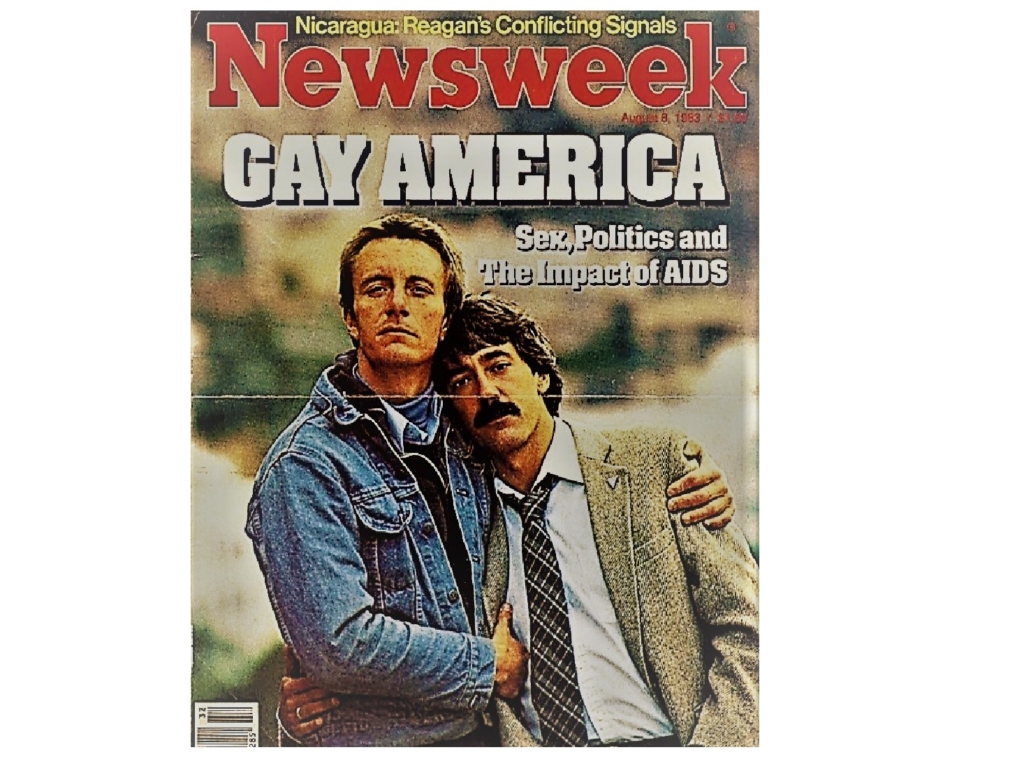
AIDS Activist Bobbi Campbell and his partner Robert “Bobby” Hilliard appear on the cover of Newsweek magazine for the story “Gay America: Sex, Politics and the Impact of AIDS.”
Learn More.Campbell and Hilliard’s appearance on Newsweek’s cover is the first time two gay men are pictured embracing one another on the cover of a U.S. mainstream national magazine.
But by this time, Campbell was accustomed to being covered by the media. He was the first person living with AIDS to come out publicly after he became the 16th person to be diagnosed with an AIDS-related illness in San Francisco, according to Back2Stonewall.
After he launched a column in January 1982 for the San Francisco Sentinel disclosing his Kaposi sarcoma diagnosis and describing his experiences as a person living with AIDS, he was often invited to speak at conferences and other events. When someone quipped that he was the “AIDS poster boy,” he embraced the characterization by putting it on a t-shirt in bold letters.
A registered nurse, Campbell joined the Sisters of Perpetual Indulgence, an activist performance group that uses drag and religious imagery to call attention to sexual intolerance, and took on the “sister” persona of Sister Florence Nightmare. He also co-authored the first San Francisco safer-sex manual, Play Fair!, which offered practical advice written in plain, sex-positive and often humous language.
Ever the prolific fighter for the cause, Campbell co-founded with another HIV-positive activist, Dan Turner, the People With AIDS Self-Empowerment Movement (or PWA Movement) in 1983. The movement promoted the right for those living with HIV/AIDS to “take charge of their own life, illness, and care, and to minimize dependence on others,” according to Back2Stonewall.
“The group had what then seemed like revolutionary ideas,” wrote Bill Lipsky, author of Gay and Lesbian San Francisco (2006). “It rejected the then-commonly used term ‘KS victim’ …
Almost a year after appearing on the cover of Newsweek, Campbell gave one of his last speeches at the National March for Lesbian and Gay Rights at the 1984 Democratic National Convention in San Francisco. Campbell told the crowd that he had hugged his boyfriend on the cover of Newsweek “to show Middle America that gay love is beautiful.”
Campbell died of AIDS on August 15, 1984. Hilliard died of AIDS a few months later.
In 2014, a Castro Street History Walk plaque was installed to commemorate Campbell and his work.
* * * * * *
Sources:
University of California Berkeley Library
University of California San Francisco Archives and Special Collections
Back2Stonewall
San Francisco Bay Times
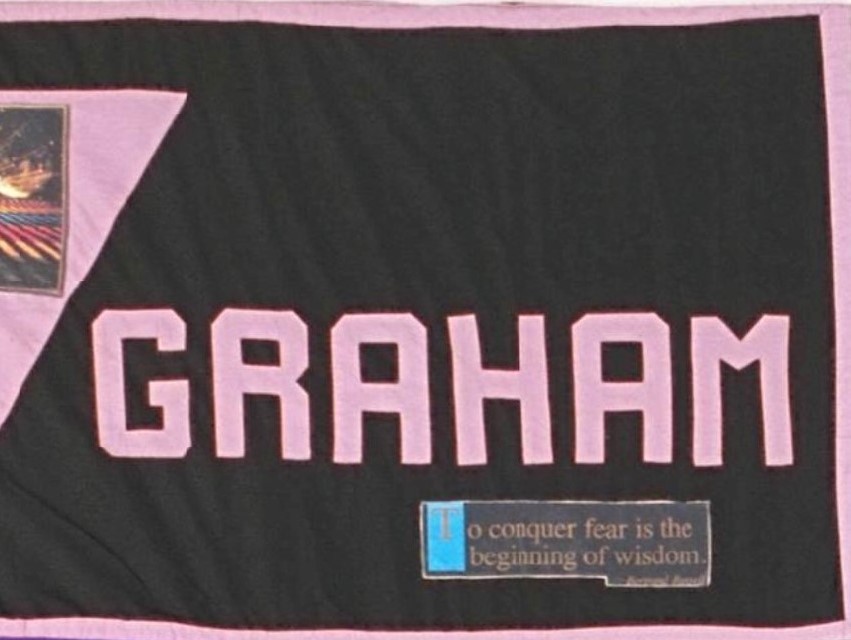
Modern dancer Graham Conley, who performed with the Margaret Jenkins Dance Company, dies of AIDS-related illness at the age of 32.
Learn More.* * * * * *
Sources:
Photo of quilt panel from the AIDS Memorial Quilt
Bay Area Reporter, June 8, 2006
Comedian Eddie Murphy performs his comedy special “Delirious” on HBO with material that further stigmatizes gay men and HIV/AIDS. In the show, he makes jokes about AIDS, uses a gay slur multiple times, and tells the audience he is “afraid of gay people.”
Learn More.After its release to the public, the show would become watched by millions and go on to win a Grammy Award.
Murphy would apologize in 1996 for the homophobic remarks in his performances after gay rights activists in San Francisco mount a protest during one of his film shoots. In a public statement, Murphy said that he deeply regretted “any and all pain” that he caused, adding, “Just like the rest of the world, I am more educated about AIDS in 1996 than I was in 1981.”
David Smith, a spokesman for the Human Rights Campaign Fund in Washington, D.C., would respond: “This statement certainly does sound as though Murphy recognizes the impact his past statements have had on the gay community. It’s important for people in the public eye like Eddie Murphy to recognize they set a tone for the general public.
* * * * * *
Source:
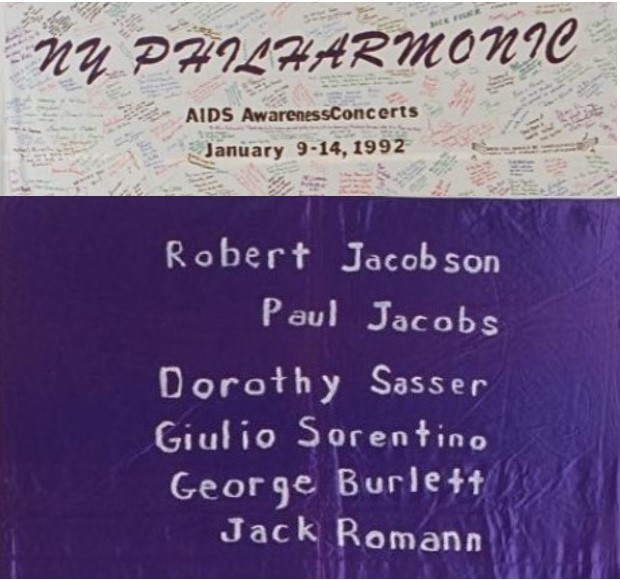
Paul Jacobs, the New York Philharmonic’s pianist and harpsichordist, dies of AIDS-related illness at his Manhattan home. He was 53.
Learn More.Paul Jacobs was the New York Philharmonic Orchestra’s official pianist and harpsichordist, holding the post during the tenure of three music directors, according to The New York Times.
He was best known for taking on “the more forbidding works of the 20th Century,” according to Lon Tuck of the Washington Post. He was also widely recognized for his expertise with early keyboards, often performing on harpsichord with Baroque ensembles.
Born in New York City, Jacobs studied at the Julliard School and then moved to France in 1951 to work with composer and conductor Pierre Boulez at Domaine Musical in Paris.
He returned to New York in 1960 to teach at the Manhattan Music School and the Mannes College of Music. Two years later, the New York Philharmonic named Jacobs its official pianist and, in 1974, harpsichordist.
He gave solo recitals and played frequently for Lincoln Center’s Chamber Music Society throughout the 1960s and 1970s. Jacobs recorded for several labels, including fifteen records for Nonesuch and a few for European labels.
For the last fifteen years of his life, he was Associate Professor of Music at Brooklyn College of the City University of New York.
In 1982, he was diagnosed with AIDS and informed he had only a few years to live. Faced with the decision of how best to use the months that remained to him, Jacobs decided to make one last record, which included the last compositions of Beethoven and Busoni and one of the last by Mozart.
Despite the deterioration of his eyesight, he managed to record the pieces, finishing the work in June 1983, about three months before he died. He completed the recording “on sheer determination,” Jacob’s doctor told Lon Tuck of the Washington Post.
About five months after Jacob died, on February 24, 1984, a memorial concert at New York’s Symphony Space drew the attendance of some of America’s most accomplished composers and musicians and many of his fans. The memorial program was tailored to reflect Jacobs’ musical tastes, according to Tuck. Composer Elliott Carter, the leader of America’s traditional musical avant-garde, delivered the eulogy.
* * * * * * * *
Photo of quilt panel from the AIDS Memorial Quilt
After New York City physician Joseph Sonnabend is threatened with eviction from his office building for treating patients with AIDS, the state’s Attorney General and Lambda Legal join together to file the first AIDS discrimination lawsuit.
Learn More.Dr. Sonnabend and five of his patients sued and won what became one of the first AIDS-related civil rights cases.
With others including AIDS activist Michael Callen, Dr. Sonnabend founded the AIDS Medical Foundation, the first AIDS research group and now known as the Foundation for AIDS Research.
* * * * * *
Source:
Russell Hartley, curator of the Archives of the Performing Arts, dies of AIDS-related illness in a San Francisco Hospital at the age of 61.
Learn More.In 1947, Hartley created the San Francisco Dance Archives, which is now known as the Museum of Performance + Design and includes 3.5 million items documenting the performing arts in the Bay Area.
By 1979, Hartley’s collection included 2,000 books, 8,000 periodicals, 4,000 slides, 5,000 negatives, 10,000 pieces of sheet music, 2,000 posters, 250 phonograph records, 25,000 historical photographs, 10,000 stills from the San Francisco Ballet, 10,000 movie stills, 12,000 theatrical prints, 500 artifacts, and 250 costumes, according to art critic Renée Renouf in Dance Chronicle.
“His unique confluence of personal artistry, a fund of personal anecdote and experience, and his single-minded devotion for the perpetuation of a collection commenced 40 years ago passes into its own special historical niche with Russell’s death,” Renouf wrote in 1983.
Born in 1924, Hartley attended Tamalpais High School in Mill Valley, California, which is located in the San Francisco Bay Area. Russell designed window displays for his father’s hardware store, according to the Museum of Performance and Design‘s Performing Arts Library. His artful window displays caught the eye of Ruby Asquith, a dance instructor who invited Hartley to visit the San Francisco Ballet studios and sketch dancers as they rehearsed.
Subsequently, he signed up for ballet classes and a year later, was given a part in Willam Christensen’s acclaimed production of Romeo and Juliet.
Early in his dance career, Hartley enjoyed success with the San Francisco Ballet in eccentric character roles between 1942 and 1949. In 1944, Christensen enlisted Hartley’s help in revising costume designs for Now the Brides, and this led to more significant work, including designing 143 costumes for the first production of the Nutcracker Suite in 1944, Pyramus and Thisbe, Coppelia, Swan Lake, Les Maitresses de Lord Byron, Jinx, Beauty and the Shepherd, and the Standard Hour television show.
Hartley’s art portfolio, Henry VIII and his Wives (1948), served as an inspiration for Rosella Hightower’s ballet by this name, which premiered in New York at the Metropolitan Opera House.
In the 1940s, Hartley became interested in collecting historical materials on local performers and dance and theatrical companies. He began combing antique stores for old dance and theatrical programs, photos, and ephemera, and these materials would become the start of his San Francisco Dance Archives.
In February 1946, Hartley, then almost 22 years old, and his friend Leo Stillwell, a 20-year-old artist, opened the Antinuous Art Gallery at 701 McAllister Street in San Francisco. Hartley began creating series of dance paintings and show windows in New York, leading to exhibitions of his paintings at the Feragil Galleries in New York, the Labaudt Gallery in San Francisco, and the Miami Beach Art Center, an exhibition on ballet at the De Young Museum, and features of his paintings in various one-man shows at galleries in San Francisco. Meanwhile, Stillwell worked furiously, creating 500 works of art before succumbing to an early death at the age of 22 following a case of measles.
Hartley carried on, executing costume designs for Balanchine’s Serenade, William Dollar’s Mendelssohn’s Concerto, Lew Christensen’s Balletino, and the San Francisco Opera Company’s productions of Aida and Rosenkavalier. He began studying the conservation of fine paintings with Gregory Padilla and carried out restoration projects for the Maxwell Galleries, the Oakland Museum, and Gumps. In 1960, he became a member of the International Institute for the Conservation of Historic and Artistic Works.
Dance Magazine hired Hartley to write a monthly column, which ran through the 1960s. He also contributed feature articles to After Dark Magazine, Opera and Concert, and The Trumpeteer.
He organized exhibitions on the history of the performing arts at the War Memorial Opera House and the main branch of the San Francisco Public Library with materials from his personal collection. In 1975, Hartley sought a permanent location for the Performing Arts Archive and was able to obtain a space in the basement of the Presidio Branch of the San Francisco Public Library.
His own archival collections, which had expanded to include materials on the history of the San Francisco Opera, San Francisco theaters, and the San Francisco Symphony, was supplemented by a dance library and other materials donated by local collectors. However, in 1981, budgetary cutbacks led to the closure of the archives and Hartley was forced to move the entire collection to his Mill Valley home.
At this time, Hartley’s health began to decline. In 1983, the archives were moved from Hartley’s home to the San Francisco Opera Chorus Room in the War Memorial Opera House and a Board of Directors was formed to ensure that Hartley’s legacy would carry on. Former San Francisco Ballet dancer Nancy Carter became the archives’ first executive director.
The archives are now known as the Museum of Performance + Design, which also serves as keeper of The Russell Hartley Collection, materials from Hartley’s early days as a costume designer for the San Francisco Ballet to his tenure as director of the Archives for the Performing Arts.
In 2016, the San Francisco Chronicle reported on the story of Alan Perry, a retired truck driver who found in a dumpster 200 letters written to Russell Hartley by his friend Leo Stillwell, the promising artist who died at the age of 22. Perry and his wife, who subsequently learned about Hartley and Stillwell and appreciated the cultural value of the find, donated the letters to San Francisco State University, where the prolific young artist’s 500 works of art are housed.

Keith Barrow, a singer and songwriter best known for the soulful “You Know You Wanna Be Loved” and the disco-beat-fueled “Turn Me Up,” dies of AIDS-related illness at Michael Reese Hospital in Chicago. He was 29 years old.
Learn More.The only son of Chicago civil rights leader Rev. Willie Barrow (1923-2015), Keith Errol Barrow started singing as a teenager with the gospel group “Soul Shakers.” His mother told Windy City Times in 2004, “Keith had music in his bones and in his soul. He started writing music when he was eight.”
After Barrow came out to his activist mother, she publicly embraced gay rights, according to The New York Times.
In 1973, Barrow released a self-titled gospel album at the age of 19 with Jewel Records, and his solo career began to gain traction with the popularity of one of the album’s singles, “Mr. Magic Man.” The major label Columbia signed him in 1976, and he left Chicago for New York and then Los Angeles. After a song he wrote for the Philadelphia R&B group Blue Magic rose in Billboard‘s Top 100 R&B hits, Barrow was invited to Philly’s famed Sigma Sound Recording Studios to work under legendary producer Bobby Eli for his first Columbia album.
The release of Barrow’s record was announced in a full-page ad in Billboard magazine for the week ending May 7, 1977. “Keith Barrow is why you should pay attention to this debut album,” the ad proclaimed.
“Though he’s not talked about much today, Keith was a true talent of his era, a singer’s singer whose velvety falsetto was on par with the finesse of Eddie Kendricks and the fancy of Sylvester,” wrote music critic S.E. Fleming Jr. in 2008. “When it was all said and done, Keith Barrow didn’t prove a huge hit, but it was a high quality effort that laid the groundwork for what would become his finest hour on record.”
Fleming says the best track on the album is Barrow’s performance of his own composition, “Teach Me (It’s Something About Love),” calling it “one of the most beautiful slow jams the singer ever recorded.”
“It was a perfect fit for a young man at a stage in his life where most people are finding their own voice, a lovely portrait of innocence and melancholy,” Fleming writes.
In 1978, Barrow switched to CBS Records, which produced his second album, Physical Attraction. Most of the material was co-written by producer Michael Stokes and songwriter Ronn Matlock, and they updated Barrow’s sound to include three disco songs.
Immediately, the seven-minute single “Turn Me Up” became a hit at dance clubs and broadened his fan base. Meanwhile, another song on the album, a smooth soul ballad titled “You Know You Want to Be Loved,” rose to #26 in Billboard‘s Top 100 R&B hits.
Barrow recorded a final album, moving to Capitol Records. Produced by Ralph Affoumado, Just As I Am (1980) was an ambitious work, but the dance sound that initially drew in fans was declining in popularity. Still, the album has a few gems, such as the seductive and funky “In the Light (Do It Better)” and “Tell Me This Ain’t Heaven,” which is reminiscent of some of his earlier work with Columbia.
Barrow tried to extend his career by performing live. While touring in Europe in 1983, he fell ill and called his mother, saying he was too sick to perform:
“He called me from Paris and said, ‘Momma, I don’t think I’ll be able to go on stage tonight. I really feel sick.’ I said, ‘Oh, you’ll be alright.’ I prayed for him and then he called again a couple of hours later and he said, ‘Momma, I can’t perform. I have to go; they have to take me to the hospital.'”
After returning to the U.S., Barrow moved back to Chicago and his mother tended to him as his health declined. After being admitted to Michael Reese Hospital, he was diagnosed with AIDS.
“I remember the first of the weekly reports that Keith was ill and the requests for prayers,” wrote Barrow’s childhood friend in 1007. “Keith’s mother is a fiery orator and fierce civil rights activist nicknamed ‘The Little Warrior,’ so it was hard to see her sadness and distress as his health declined.”
When Barrow died later that year, more than 1,000 people attended his memorial services. Barrow was one of the first people in the entertainment industry to die of AIDS, and the cause of his death was not reported in his obituary. But his mother openly talked about it in the years that followed, and she contributed a panel in memory of her son to the AIDS Memorial Quilt.
Stephen Lamb, a man living with AIDS who was profiled in a widely-read New York Times article, dies of AIDS-related illness at New York University Medical Center. He was 40.
Learn More.In a NYT article published in the December 5 issue on Page 1 of Section B, celebrated reporter Maureen Dowd chronicled Lamb’s final months.
Lamb, his body overwhelmed with cryptococcal meningitis, tuberculosis of the bone marrow, and an intestinal infection, had until recently lived on the upper east side of Manhattan and worked as a travel consultant.
One of the few visitors at Lamb’s hospital bed was William Carroll, a volunteer from the Gay Men’s Health Crisis who two months before had been assigned to be Lamb’s “buddy.” According to the NYT article, Lamb and Carroll found that they shared a love of literature, and in Lamb’s final weeks, Carroll often read to him from books of poetry by John Keats and Andrew Marvell.
“Bill and I have grown to like each other,” Lamb told the reporter four days before he died. “I just needed some companionship.”
Lamb’s death was the 514th AIDS-related fatality recorded by the City of New York. At the time, the Gay Men’s Health Crisis had provided services to 420 people with AIDS, and was facing a surge in their caseload, according to Dowd’s article.
The organization had been receiving about 50 new cases every month, but in November, they noticed a dramatic increase in the number of people with AIDS (PWAs) who needed help. Some were gay men, but there were also intravenous drug users who were heterosexual as well as people who had received tainted blood transfusions.
The GMHC was running 20 therapy groups, organizing its volunteer-run “buddy” program, and operating a 24-hour hotline which received an average of 1,200 calls every week, according to the article.
The organization’s volunteers, which then numbered about 200, did whatever was needed, from taking orange juice to homebound PWAs to serving as intermediaries with the city’s social-service agencies.
“They clean apartments, do laundry, make dinner, pick up prescriptions, mail rent checks, walk dogs, take their patients to doctor’s appointments, and simply keep them company,” Dowd reported.
Many of the volunteers, she wrote, had horror stories about the terrible treatment of PWAs.
“They tell of government clerks who neglect AIDS cases, because they are afraid to be in the same room to fill out forms. They tell of nurses and orderlies in hospitals who are so loath to enter the rooms of AIDS patients that they let the food trays pile up outside the door, leave trash baskets overflowing, or neglect patients lying in their own urine or excrement,” wrote Dowd.
One volunteer, Diego Lopez, told the reporter that he went to visit a dying patient in the hospital, and discovered him with blood seeping from his nose and mouth. When he asked a doctor to help the patient, the doctor handed him some gauze and told him to take care of it himself.
“I was shocked, but I did it,” Lopez said. “Afterward, I looked at my hands and there was blood all over them. I realized I had to start being more careful. But when you see a person dying, you don’t think about finding some gloves to wear.”
Dowd closed her article with a conversation she had with Larry Kramer, co-founder of Gay Men’s Health Crisis. Kramer told Dowd of how the AIDS crisis had deeply affected him. Already, 37 of his friends in New York were dead from the disease.
“I heard about Vinny on Saturday,” Kramer said. “Ron is a Black actor I know. Paul, a pianist. Gayle went to Yale with me. Ron Doud, the designer of Studio 54. Mark, I was involved with a long time ago. Peter, an architect.”
“Can’t something be done?” he asked, clenching a small green notebook he used to record the names of his dead friends. “The rest of the city, my straight friends, go on with life as usual — and I’m in the middle of an epidemic.”
NBC’s St. Elsewhere airs the episode “AIDS and Comfort,” with a story about a former councilman diagnosed with AIDS.
Learn More.In the episode, the presence of a person with AIDS at St. Elygius Hospital triggers the fears and prejudices of various hospital staff.
The episode attempts to call for compassion in its viewers while dispelling misinformation about the virus, using medical professionals as gateways to inform and educate a mainstream audience.
However, by depicting the patient with AIDS as a white, heterosexual, well-off character who is the victim of an ill-timed affair and the subsequent confusion about whether the patient is straight or gay once he is diagnosed, the viewers are presented with the message that “gay = AIDS,” reinforcing the stereotype stigmatizing the gay community.
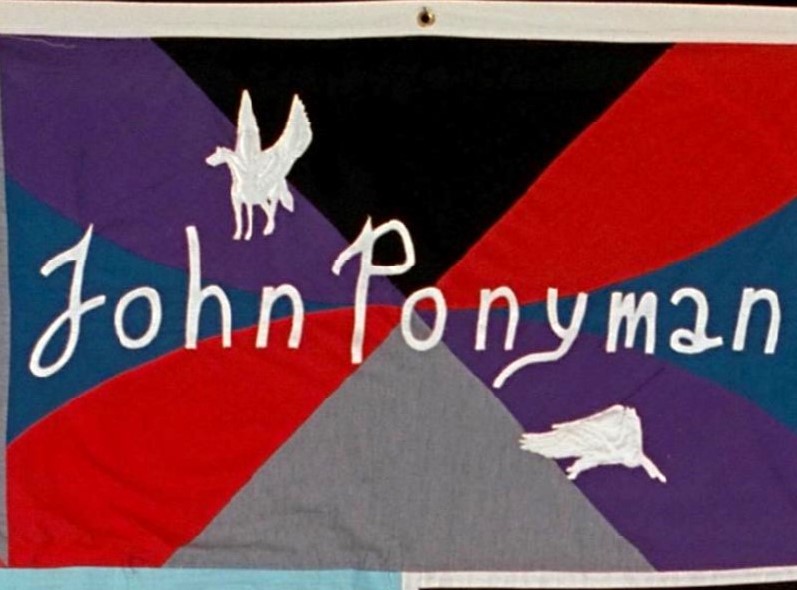
John Ponyman, an off-Broadway actor who migrated to San Francisco, dies of AIDS- related illness at the age of 41.
Learn More.Ponyman regularly appeared in shows at Theatre Rhinoceros. His final project was a solo show titled “Sawdust,” featuring several of his own songs.
* * * * * * * *
Photo of quilt panel from the AIDS Memorial Quilt
Philip Mandelker, who produced the television show The Dukes of Hazzard and 17 made-for-TV movies between 1974-1984, dies of AIDS-related illness in Los Angeles. He was 45.
Learn More.When Mandelker was diagnosed with AIDS in 1983, the first person he called was his friend Rob Eichberg, a Los Angeles clinical psychologist active in the LGBTQ+ community.
“His family was very dedicated to him and they insisted on people knowing Philip died of AIDS,” Eichberg told the Los Angeles Times.
“The day Philip died, I cried,” said Mandelker’s sister, Jane Makowka. “But I had cried my tears for months before. I knew a long time before anybody ever said it was AIDS that it was.”
Makowka said that her brother had a passion for living life to its fullest, which allowed him to bring a special quality to his television shows.
“Most important was his love of people and love of nature. He tried to bring that, something of quality to television, something people would remember,” she said. “He was very fortunate to have been as successful as he was in that short of a lifetime. You wonder what he might have done if it hadn’t been cut short.”

Performer Bill Kendall, who received rave reviews for his portrayal of “Mr. Peanut” in the long-running San Francisco production of Beach Blanket Babylon, dies of AIDS-related illness at the age of 35.
Learn More.
Beach Blanket Babylon was the world’s longest-running musical revue at the time. The show began its run in 1974 at the Savoy Tivoli and later moved to the larger Club Fugazi in the North Beach district of San Francisco.
Kendall was in the production’s original 1974 cast and continued to be a featured performer through 1982, playing the roles of Superman, John Travolta Sat Night Fever, and The Original Mr. Peanut.
Beach Blanket Babylon was created by Steve Silver, who died of AIDS-related illness in 1995. The San Francisco Chronicle described the show’s roots as a combination of “Vegas lounge acts, the Follies Bergere, God Rush-era extravaganzas, English music halls, a child’s birthday party gone mad and dopey beach party movies.”
* * * * * * * *
Photo of quilt panel from the AIDS Memorial Quilt

Dennis Yount, a Marine who served in the Presidential Honor Guard at President Kennedy’s bier in the Capitol Rotunda, dies of AIDS-related illness at the age of 43.
Learn More.Yount was born in North Carolina and attended North Carolina University at Columbia before joining the Marines. In 1970, he moved to New York City and became a favorite bartender at the Village bar Trilogy. He moved to San Francisco in 1980 and began tending bar at the Eagle.
Once relocated to the Bay Area, Yount pursued his long-held interest in acting and performed in local stage productions of Delivery and Sunsets.
* * * * * * * *
Photo of quilt panel from the AIDS Memorial Quilt

Allan Estes, the founding artistic director of Theatre Rhinoceros in San Francisco, dies of AIDS-related illness at the age of 29. His final project, “The AIDS Show,” would become the first work by a theater company to deal with the AIDS epidemic.
Learn More.Theatre Rhinoceros is the nation’s oldest and longest-running LGBTQIA+ theater, founded in 1977 by Estes.
Estes came to San Francisco from Boston in 1977 with one goal: to establish a theater where the gay community could go to make and see theater which reflected the realities and joys of homosexual life.
From 1977 until 1984, Estes and Theatre Rhinoceros produced works by gay New York writers that included Doric Wilson, Robert Patrick, Lanford Wilson, Terrence McNally, and Harvey Fierstein, as well as several San Francisco playwrights including C.D. Arnold, Robert Chesley, Cal Youmans, Philip Real, and Dan Curzon.
In the early 1980s, Allan began transforming the Rhino from a gay men’s theater into a lesbian and gay theater, and invited lesbian screenwriters to stage their plays.
In 1984, he conceived the production Artists Involved with Death and Survival (“The AIDS Show”), which was brought to fruition by director Leland Moss (who would die from AIDS at age 41) and included the works of 20 Bay Area playwrights. “The AIDS Show” became the first work by a theater company to deal with the AIDS epidemic.
In 1987, “The AIDS Show” and its touring company became the subject of a PBS documentary by Rob Epstein and Peter Adair and brought the Rhino national attention.
When Estes died, his friends and collaborators vowed to continue Theatre Rhinoceros as a monument to their fallen leader.
* * * * * * * *
Photo of quilt panel from the AIDS Memorial Quilt
Bay Area dancer Charles “Charlie” Butts, who performed with Carlos Carvajal’s Dance Spectrum from 1876 to 1980, dies of AIDS-related illness at the age of 31.
Learn More.Butts also danced with Xoregos Dance Company in San Francisco, Ballet Trocadero de Monte Carlo in New York, and Valerie Huston Dance Company in Santa Barbara
Born in Mississippi, Butts grew up in Los Angeles and studied dance at the University of California Irvine. He performed both locally (in San Francisco and Santa Barbara) as well as in company tours to South America and Japan.
* * * * * * * *
Source: San Francisco Examiner, December 7, 1986
Singer-songwriter António Variações, Portugal’s first gay superstar, dies of AIDS-related illiness in Lisbon, Portugal at the age of 39.
Learn More.Variações made his TV debut in 1981 during the Sunday variety show on Portugal’s sole broadcaster, recounts Pedro João Santos in his Guardian profile.
“He sang a punk metaphor about pills while a dancer dressed as a giant aspirin threw Smarties at the dumbfounded audience,” writes Santos. “Nothing so transgressive had ever graced Portugal’s airwaves.”
His 1983 bestselling debut album, Anjo da Guarda (Guardian Angel), features Variações’ Portuguese folk-style singing set to new-wave music. His follow-up album, Dar & Receber, fused disco-rock with synthpop.
In May 1984, Variações was admitted to hospital due to illness, according to The AIDS Memorial. Except for his family and close friends, he received few visitors during his hospital stay. A month later, the media reported that his health had deteriorated and rumours began to circulate that he had AIDS.
The initial cause of Variações’ death would be reported as bilateral bronchial pneumonia. At his funeral on June 15, 1984, the coffin would be sealed shut by order of the Portugese government.
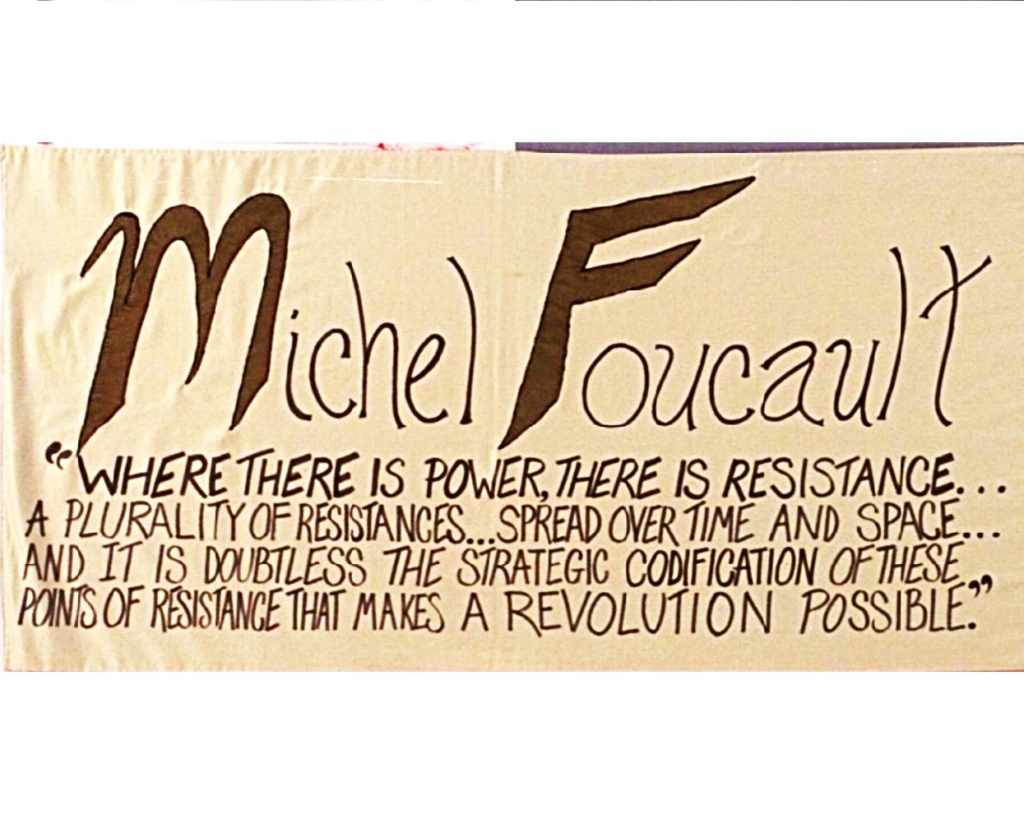
Michel Foucault, one of the most influential and controversial scholars of the post-World War II period, dies of AIDS-related illness at the age of 57.
Learn More.
A day later, French newspaper Libération would include in the obituary the rumor that the cause of Foucault’s death was AIDS. In response, Le Monde would issue a medical bulletin cleared by his family that makes no reference to HIV/AIDS.
On June 29, Foucault’s la levée du corps ceremony would be held, during which his coffin was carried from the hospital morgue to the cemetery at Vendeuvre-du-Poitou. Hundreds attend, including activists and academic friends, and French philosopher Gilles Deleuze gave a speech that included excerpts from Foucault’s ground-breaking work The History of Sexuality.
The son and grandson of physicians, Foucault was born to a bourgeois family. He enrolled at the age of 20 to the École Normale Supérieure in Paris in 1946, and established a reputation as a sedulous, brilliant, and eccentric student.
After graduating in 1952, Foucault travelled Europe, issued monographs of his work and, in 1969, published L’Archéologie du savoir (The Archaeology of Knowledge), which won him attention as one of the most original and controversial thinkers of his day.
A year later, he was awarded a chair position at the Collège de France, the country’s most prestigious postsecondary institution, and began conducting intensive research.
Between 1971 and 1984 Foucault wrote several works, including Surveiller et punir: naissance de la prison (1975; Discipline and Punish: The Birth of the Prison); three volumes of a history of Western sexuality; and numerous essays.
Foucault continued to travel widely, and as his reputation grew he spent extended periods in Brazil, Japan, Italy, Canada, and the U.S. He became particularly attached to San Francisco, where he was a visiting lecturer at the University of California at Berkeley for several years.
Although Foucault reportedly despised the label “homosexual,” he was openly gay and occasionally praised the pleasures of sadomasochism and the bathhouse. Foucault died while he was working on the fourth volume of his history of sexuality.
Foucault’s partner Daniel Defert would go on to found the first HIV/AIDS organization in France, AIDES; a play on the French language word for “help” (aide) and the English language acronym for the disease. In 1986, two years after Foucault’s death, Defert would publicly announce that Foucault’s death was AIDS-related.
* * * * * * * *
Photo of quilt panel from the AIDS Memorial Quilt
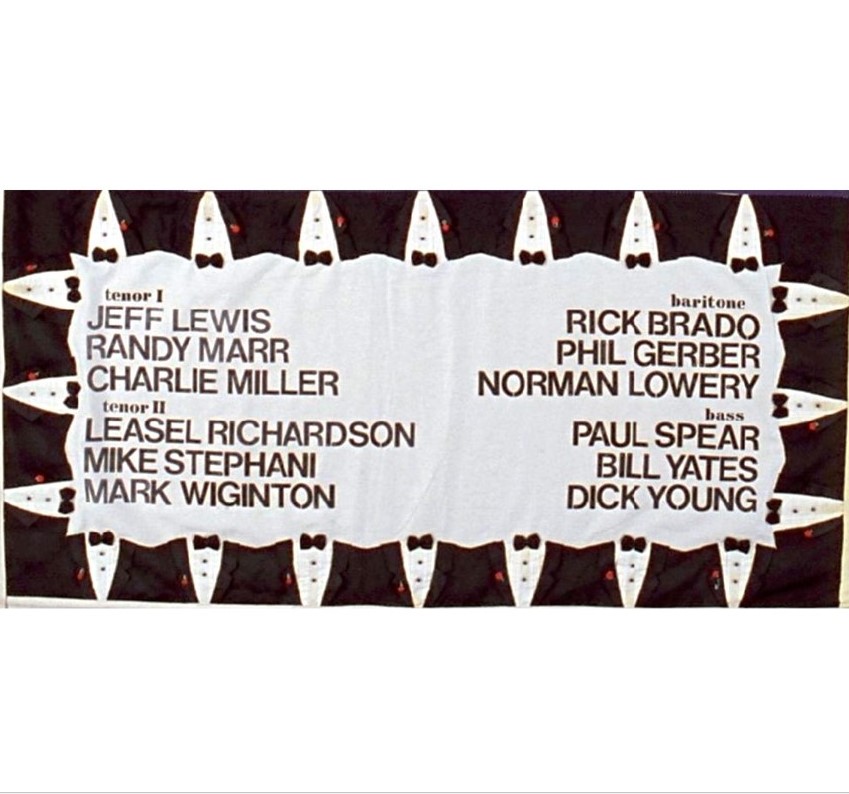
Charley Miller, a tenor with the Turtle Creek Chorale in Dallas, becomes the first of many in the group to die of AIDS-related illness. He was 30 years old.
Learn More.Charley Miller first performed with the Turtle Creek Chorale in July 1981 and he continued to sing with the group through June 1984. During that time, he was featured in the following productions:
Showtime ’81 (July 1981) – “Tomorrow Belongs To Me” from Cabaret as part of a Quartet
The Music of America (July 1982) – Texas Medley in a Septet and “I’ve Got Rhythm” as a member of the Showstoppers
Wintersong (December 1982) – “Cantata 142 – Un ist ein Kind geboren – Air” as a solo
Sing Gloria! (November 1983) – “Satin Doll,” “Java Jive,” “Dream,” “Georgia On My Mind,” and “Save the Bones for Henry Jones” as a member of the Turtle Creek Jazz
Sing We Nowell (December 1983) – “The Three Kings” as a part of a sextet
Of Three We Sing (June 1984) – “Credo” as a Duet, “Agnus Dei” as a solo
Miller was the first AIDS-related death for the Turtle Creek Chorale or, possibly, the first acknowledged AIDS death, according to the Chorale’s memorial website.
The Turtle Creek Chorale was founded in early 1980 by Don Essmiller, Phil Gerber, and Rodger Wilson over drinks at The Crews Inn, a gay bar in Dallas, according to Michael Sullivan in The Dallas Way. They named the group after the small stream that passed through the queer-friendly Dallas neighborhood of Oak Lawn.
“In some cities, the newly-formed choruses boldly chose to use the word ‘gay’ in their name, but in the buckle of the Bible Belt, the founders of just such a chorus in Dallas decided against it for what seemed obvious reasons,” Sullivan wrote in 2017.
Chief among those reasons was the fact that many of the singers were public school teachers, and the local superintendent was a notoriously homophobic man who threatened to fire openly gay teachers.
The group first rehearsed in February 1980 with 39 singers. On June 24, 1980, 70 members of the Chorale gave its first formal concert at the campus of Southern Methodist University in Dallas. By the end of its first season, the group had grown to 83 members.
By 1985, the Chorale was heavily impacted by the HIV/AIDS epidemic. As members began to get sick and die, the group transformed to become a space for its members to grieve and heal through performance and community, according to the University of North Texas’ 2017 exhibit Threads of Remembrance.
In its 1987 holiday performance, the Turtle Creek Chorale placed a poinsettia on the piano to honor the memory of those who had died of HIV/AIDS. When the number of fatalities reached 20, the tradition evolved into having a poinsettia placed at the front of the stage for each individual.
In April 1994, PBS would televise the documentary After Goodbye: An AIDS Story, which looked at the impact of AIDS on the Turtle Creek Chorale. The film followed the group through rehearsals and performances of When We No Longer Touch: A Cycle of Songs for Survival, a choral rendition of the stages of grief that was composed by composer-in-residence Kristopher Anthony.
At the time it was filmed in 1993, the Chorale had already lost more than 90 members to AIDS. Among them was Anthony, who died on June 26, 1992 at the age of 38.
By 2013, the AIDS death toll at the Chorale would reach 197. Still to this day, during its holiday performances, the group places on the stage a field of poinsettia plants, one for each Chorale member who has passed.
* * * * * * * *
Photo of quilt panel from the AIDS Memorial Quilt
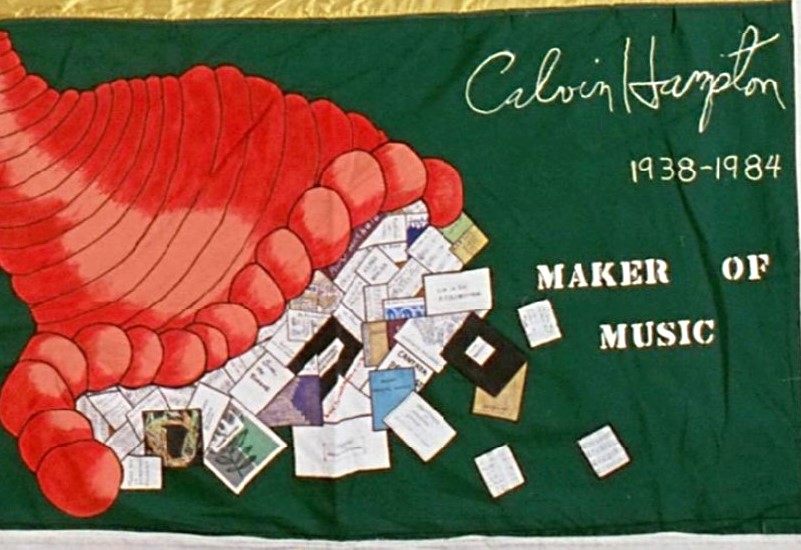
Calvin Hampton, the organist and choirmaster at Calvary Episcopal Church in Manhattan’s Gramercy Park neighborhood from 1963 to 1983, dies of AIDS-related illness near his parents’ Florida home. He was 45.
Learn More.Known nationwide as a leading organist and sacred music composer, Hampton presided over the popular “Fridays at Midnight” organ recital series, which ran from 1974 to 1983. He also composed music for the church and the concert stage.
In 1974, he composed music for Walter Leyden Brown’s production of Herman Melville’s Pierre, or the Ambiguities, which was produced at La MaMa Experimental Theatre Club in New York City.
Erik Routley, an authority on church music, called Hampton “the greatest living composer of hymn tunes.”
“An iconoclastic performer with distinctive ideas, he often incorporated organ transcriptions of 19th-century orchestral music into his programs,” wrote Tim Page of the New York Times. “Mr. Hampton was a prolific and eclectic composer, utilizing such diverse elements as rock, gospel hymns, synthesizers and quarter tones in his works.”
Hampton stopped working at the church in 1983 to concentrate on composition and organ consulting for several important classical organs in the U.S. He contracted AIDS but remained active until the final few weeks of his life, composing the massive Alexander Variations for two pipe organs while largely bedridden.
* * * * * * * *
Photo of quilt panel from the AIDS Memorial Quilt

AIDS activist Bobbi Campbell dies of AIDS-related illness in San Francisco at the age of 32.
Learn More.Just one month earlier, Campbell spoke at the National March for Lesbian and Gay Rights at the 1984 Democratic National Convention in San Francisco.
Campbell told the crowd that he had hugged his boyfriend on the cover of Newsweek, “to show Middle America that gay love is beautiful.” He held 15 seconds of silence for the 2,000 who had died of AIDS at that point “and [for] those who will die before this is over.”
He then laid-out a series of concerns for politicians to address — including increased funding for both research and support services and a warning of the potential for discrimination with the advent of a test for HTLV-3 (now known as HIV) — and appealing to all candidates in the upcoming elections to meet with people with AIDS.
Two weeks after his DNC speech, Campbell appeared on CBS Evening News with Dan Rather. While the rumors and fear of AIDS had reached a mainstream audience, the facts had not, so Campbell was placed in a glass booth, with technicians refusing to come near him to wire up microphones for the interview.
At noon on August 15, 1984, exactly a month after his DNC speech and after 2 days on life support in intensive care, Bobbi Campbell died at San Francisco General Hospital. His parents and his partner Bobby Hilliard were by his side. Bobbi Campbell was 32 years old and had lived for over 3½ years with what was by then called AIDS.
His partner Bobby Hilliard would succumb to the deadly disease not long afterwards.
* * * * * * * *
Photo of quilt panel from the AIDS Memorial Quilt
In an article written by Evan Thomas and titled “The New Untouchables,” Time magazine reports on how public anxiety about AIDS is resulting in school boycotts and the ostracization of anyone suspected of being infected with HIV.
Learn More.The magazine reported that parents of students in Queens were keeping their children at home, because it was disclosed that an unidentified second-grader enrolled at one of the city’s 622 elementary schools had the AIDS virus.
“That evening, hundreds of anxious parents gathered in the school’s airless auditorium,” Evans wrote. “They chanted, ‘Two, four, six, eight, no AIDS in any grades!’ and waved placards proclaiming OUR CHILDREN WANT GOOD GRADES, NOT AIDS!”
At the meeting, local politicians only added to the misinformation being spread about the disease.
State Assemblyman Frederick Schmidt said, “There is no medical authority who can say with authority that AIDS cannot be transmitted in school. What about somebody sneezing in the classroom? What about the water fountain? What about kids who get in a fight with a bloody nose? They don’t know!”
The article also reported on the following incidents:
When an AIDS task force in New Orleans began to be contacted by local citizens afraid of HIV-spreading mosquitoes, Dr. Louise McFarland, the agency’s chair, expressed her exasperation to the Time reporter.
“If that were true, the whole city of New Orleans would have AIDS,” Dr. McFarland said.
The New York Times reports that new scientific evidence has raised the possibility that AIDS may be transmissible through saliva . It will be another two years before proof emerges that this is false.
Learn More.Epidemiologic studies to date point to sexual contact as well as transfusions of blood or blood products as the major risk factors leading to AIDS.
”Right now epidemiological studies do not point to saliva as the key mode of spread of AIDS and data show that close contact is much more important,” Dr. Robert C. Gallo, a leading AIDS researcher, told The New York Times.
Even so, this article spread fear among the public and further stigmatized those living with AIDS.
The City of San Francisco orders 14 bathhouses closed due to reports of high-risk sexual activity occurring in these venues.
Learn More.“It has been established that the bathhouses contribute to the spread of AIDS and they ought to be closed,” Mayor Dianne Feinstein said. Frustrated with gay rights groups that were blocking her two-year campaign to close the bathhouses, Feinstein decided on a different approach: closing them one by one.
Under Mayor Feinstein’s direction, the City hired private investigators to go undercover into baths and other venues that were known to serve the gay community and report on anything considered by them to be an unsafe sex act.
The city’s Director of Public Health, Dr. Mervyn Silverman, did not approve of these tactics, but when the investigators submitted an 85-page report that listed the types of sexual activity taking place at these venues, he felt compelled to respond, according to Randy Shilts’ book And the Band Played On.
At a news conference, Dr. Silverman ordered the closure of baths and several other establishments identified in the report as places where gay men partook in unsafe sex, citing them by name, stating, “These 14 establishments are not fostering gay liberation. They are fostering disease and death.”
Within six hours of the order, two would re-open. An additional 10 re-opened within 24 hours.
The controversy over gay bathhouses and sex clubs and the roles they play in the spread of AIDS was not limited to San Francisco. Every major city with a significant gay population was struggling with this issue. Even within the gay community, members debated each other over which was more important — public health or gay civil liberties.
But it was in San Francisco where political debates first broke out. New York, Los Angeles, Miami, Chicago, Seattle and Portland followed, with local policy approaches varying from a citywide closure of all bathhouses to collaborations between health agencies and community members to introduce education and precautions for patrons.
Why were bathhouses the focus of so much intense debate? Because, to the gay community in the 1970s and 1980s, they were places that took decades of social evolution to establish.
“Early American bathhouses evolved out of traditional 1920s and ‘30s Turkish and Russian baths, which offered communal hot tubs and showers to all men,” according to Stephan Ferris in Out of the Tubs, and Into the Streets! Tracing the history of bathhouse regulations in San Francisco, CA “Gay bathhouses, in contrast, distinguished themselves from these venues by permitting sex among
members and by offering food, entertainment, and private rooms.”
Bathhouses catered to a mixed male clientele, serving those seeking social networking as well as providing a space for anonymous sexual encounters. Membership was driven by a common desire to engage with other members.
“They are not for taking baths,” the Washington Post stated in its reporting of “The Bathhouse War.” “Some of the houses have steam rooms, or saunas, or more lavish facilities that include jacuzzis and swimming pools, but that is not why men pay their $5 or $10 for a locker or a tiny private room in a dimly lit San Francisco bathhouse. Men use them to meet other men, to engage sometimes in what the clinical language calls ‘multiple, anonymous sexual contacts.'”
But for many gay men, the bathhouses of the 1980s represented much more; they were a refuge.
“We were paying money to get in there, and sometimes it was too much, but we weren’t paying for sex. We were paying for the territory — to get in there,” San Francisco historian Allan Be’rube’ told The Post. “They have a tremendous symbolism.”
In 1984, Be’rube’ submitted a historical brief to the California Superior Court that provided evidence on the social and cultural importance of bathhouses. He also described the potential role the venues could play to educate the community about AIDS prevention. A year later, when the City of New York was immersed in a similarly stormy debate, Be’rube’ updated his legal brief and submitted it to the NY Supreme Court.
Be’rube’s defense of the bathhouses stressed the right of gay men “to use them for associational purposes that were sexual as well as social and political.” A version of this historical brief was later published in 1996 in Policing Public Sex, edited by the scholar-activist group Dangerous Bedfellows.
Hundreds gather in a drafty auditorium to attend the first City Council Meeting for the newly chartered City of West Hollywood.
Learn More.A county sheriff’s deputy led the new mayor, Valerie Terrigno, through the crowd to the stage.
According to the Los Angeles Times, Terrigno’s family members sat in the front row. Attendees in the packed auditorium (a space which fire marshalls restricted, leaving scores of additional people outside in West Hollywood Park) included a composite of the city’s residents: elderly Russian-Jewish renters, members of the LGBTQ community, and plenty of activists.
The meeting started with the council officially appointing Terrigno to the office of mayor.
“I’ve worked to become a leader of our dreams and our future, and I know with power comes great responsibility,” she told the crowd. “It’s a responsibility I eagerly accept … Our dreams are a sound investment. Don’t let them waver.”
The Council then moved to adopt a ban on sex-orientation bias, and moratoriums on new construction, rent increases and evictions. Councilmembers voted to roll back rents to August 1984 levels.
The new city was created out of the unrest and fear of rising rents and housing insecurities in the early 1980s, set to the backdrop of a new disease that was spreading among members of the gay community. An area populated primarily with renters, West Hollywood established itself as a safe place for gays and lesbians. As a result, many of its residents were living with AIDS and involved in AIDS activism.
In the months that follow, Mayor Terrigno would receive letters from fans and admirers.
On crumpled yellow legal stationery, a woman from Missoula, Montona, wrote to her: “I’ve always been a dreamer, always wanting to find a utopia and always without much luck. I envy you finding yours, Ms. Valerie.”
From Tahiti, a vacationing Frenchwoman named Vera sent a postcard saying she would stop in West Hollywood before returning to Paris. The card read: “Felicitation for your victory. You are an escample for a French people homosescule.”
And from Turkey, a teacher afraid to give his name sent a rambling two-page letter. “Homosexuelity is completely forbidden,” he wrote. “Please, please, help me, take me near you — dear my friend, my sister.”
Each week, dozens of such letters arrived at Terrigno’s office in West Hollywood’s temporary City Hall. They continued to come for months, missives from gay men and women who read about the new city and saw Terrigno as a symbol of the pride they still struggled to achieve.
Before the West Hollywood election, there had been only 13 openly gay elected officials in the country. Now there were three more. In the summer of 1985, Terrigno would go on a hectic three-month cross-country speaking tour, appearing before somber audiences of upwardly mobile gay business leaders and parading before cheering masses at gay-pride events.
But within a year, Terrigno would be charged and convicted of embezzling $7,000 in federal funds during a previous job with a job-referral agency. Her trial in March 1986 would last three days, and the jury would convict her after just four hours of deliberation. She was sentenced to 60 days in prison or in a halfway house, five years’ probation, restitution and 1,000 hours of community service.
Terrigno would tell the LA Times: “A situation like this shakes your sense of what life is about. I feel sad about everything. I have no idea where to pick up from this point. I just hope this won’t change peoples’ attitudes about the city or the gay movement.”
Lawrence ‘La-La’ Beach, one of the founders and principal owners of the San Francisco bar The Balcony, dies of AIDS-related illness at the San Francisco Hospice at the age of 42.
Learn More.In 1977, Beach opened The Balcony on the north side of Market Street with co-owners Lee Harington and Terry Scott. Commonly referred to as “The Baloney” after the “c” in the signage was dislodged, the venue earned a reputation as one of the most outrageous gay bars on the west coast, according to the Bay Area Reporter.
Born in Oneida, New York, Beach was born in 1942. He received a Bachelor’s degree from Bowdoin College and a law degree from Duke University. He joined the Navy and was stationed at Treasure Island, where he served as a legal adjutant.
After being discharged from the Navy, Beach held a series of corporate jobs, and then changed the course of his career when he took a job as floor manager of The Ambush Bar on Folsom Street. It was at The Ambush where Beach met his future co-owners, Harington and Scott.
The Balcony would close in March 1982. Beach would become an early casualty of the AIDS epidemic.
Dennis Parker, a New York actor who performed on the daytime television show The Edge of Night after starring in several adult films in the late 1970s, dies of AIDS-related illness. He was 39.
Learn More.Parker joined the cast of The Edge of Night in 1979 as Police Chief Derek Mallory, and he appeared in more than 500 episodes before he became too sick to continue with the show.
Born Dennis Posa in 1946, Parker grew up in Freeport, Long Island and attended the Philadelphia Museum College of Art, where he had his first taste of acting. He left college and returned to New York to pursue a career as a stage actor.
Becoming frustrated with the difficulty of landing good roles, he took on work as a carpenter and also as an illustrator for Jiffy Simplicity, a company that sold sewing patterns. He also started posing nude for art classes.
In the mid-1970s, he met the love of his life in another aspiring actor, Joey Alan Phipps. Eleven years Parker’s junior, Phipps soon moved into Parker’s rent-controlled apartment on Manhattan’s East 38th Street and introduced him to a new career path as a model for gay porn magazines, according to “The Story of Wade Nichols and Dennis Parker” in the Rialto Report..
In 1975, Parker appeared in his first adult film, Boy ‘Napped, under the name Wade Nichols, created from his middle name and his father’s first name. This was followed by 26 additional adult films, all released between 1976 and 1979.
Around this time, Parker met Jacques Morali, a French music producer who was about to become famous for launching The Village People.
“Jacques was instantly attracted by this sexy and handsome guy,” said Henri Belolo, Morali’s creative partner. “He was always attracted to a good-looking mustache.”
Parker moved into Morali’s luxury apartment in the East 50s, but continued to see Phipps “when he could,” said Parker’s friend Tip Sanderson. Morali initially offered Parker a role in his new music group — The Village People — but then decided to change direction and wait until he could arrange for Parker a career as a solo act, Sanderson said.
In 1978, Morali made good on his promise by securing a record deal for Parker with Casablanca Records. He assembled a selection of songs, singling out the two strongest, “Like an Eagle” and “New York By Night.” Morali’s partner Belolo became the executive producer of the singles.
“Before the recording sessions, Jacques made Dennis prepare intensively, taking singing lessons and practicing a lot,” Belolo said. “He really made Dennis work hard.”
Parker went to Sigma Sound to record the album, which was titled Like an Eagle after the song they thought was the most likely to become a hit. According to Belolo, he and Morali tapped their top creative resources for the project.
“We had the best musicians and arrangers,” he said. “In fact, we used the same rhythm section that was featured on the Village People records.”
“Jacques Morali contacted me, and told me to come down to play on his boyfriend’s record,” said bass player Alfonso Carey, who remembered Parker as easy-going and friendly. “I’m the bass player that played on all the Village People hits, from ‘YMCA,’ ‘Macho Man,’ and the rest. I also wrote the song ‘Why Don’t You Boogie’ for Dennis.”
Like an Eagle was released in 1979 under the artist name “Dennis Parker” to sever ties with his adult film career and his other identity, Wade Nichols.
Parker’s brother, Richard Posa, said that he remembered asking Parker if the new album release meant that he would stop making adult films.
“Dennis said yes, but he was pleased with the work he’d done nevertheless,” Posa said. “He also mentioned that Screw magazine had voted him ‘Man of the Year’ in 1978 – and he got a kick out of that.”
Parker went to Europe to promote the album. Afterward, Parker and Morali’s’ relationship started to cool, according to “The Story of Wade Nichols and Dennis Parker” in the Rialto Report. Ultimately, Parker returned to his apartment on East 38th Street and invited Joey Alan Phipps to come back.
Parker also returned to another old love – acting. He leveraged his disco fame to land him auditions for mainstream parts. On a casting call for a role as an extra on the crime-themed soap opera The Edge of Night, Parker caught the eye of the producer and was offered a recurring role as the local police chief.
He would play the role of Chief Derek Mallory in more than 500 episodes between 1979 and 1984. He settled easily into his new life as a television actor and embraced all that it entailed, performing at fundraisers for local non-profits and scoring points for The Edge of Night softball team.
“There were a lot of very athletic guys on the crew and in the cast,” said castmate Sharon Gabet. “Dennis would show up in these tight shorts … and an ascot. He would be there swinging a bat – with his ascot. It was hilarious.”
In the spring of 1984, Parker told his brother that he was experiencing night sweats and prolonged bouts of fatigue. He took some time off The Edge of Night, and when he returned, it was apparent to the cast and crew that he had lost a lot of weight and could not move well.
“They were careful to shoot around his frailty,” Parker’s brother said. “They had him sitting at desks. They did their best to cover up his physical deterioration.”
Meanwhile, Phipps tended to Parker throughout his illness and took him to appointments at Cabrini Medical Center in mid-town Manhattan.
“Now when I look back, it’s pretty evident to me that the man was dying,” said castmate Sharon Gabet. “He would just have enough energy to give his lines, and then you would find him asleep in the chair or laying on one of the couches. He just couldn’t do it anymore. They kept cutting his part back.”
His last episode aired on October 18, 1984, just 12 days shy of his fifth anniversary on the show.
After Parker’s death in late January 1985, Phipps moved to Palm Springs, California. In the early 1990s, he contracted AIDS and tried to manage his illness with new treatments that had become available. Unfortunately, Phipps had an additional health issue that caused his body to reject the new drugs, and he died of AIDS-related illness on December 6, 1996.
Talking to reporters covering the Conservative Political Action Conference (CPAC) in Washington DC, anti-gay propagandist Paul Cameron says: “Unless we get medically lucky, in three or four years, one of the options discussed will be the extermination of homosexuals.”
Learn More.Founder of anti-gay hate groups such as the Committee to Oppose Special Rights for Homosexuals, the Institute for the Scientific Investigation of Sexuality, and the Family Research Institute, Cameron attended the conference of conservative extremists hoping to frighten its members with his ideas about gay men and AIDS.
In the CPAC convention halls, Cameron told anyone who would listen that “it looks as if mosquitoes may be able to transmit AIDS,” according to the Associated Press
Cameron presented himself to politicians and media representatives as a man of science, but his biased research and unethical claims had caused the American Psychological Association to expel him as a member in 1984, according to The Pink Community: The Facts by Christina Engela. Still, he managed to insert his homophobic rhetoric into the minds of influential policymakers and judges.
According to the Southern Poverty Law Center, Cameron was conducting “psychological studies” that drew false conclusions about homosexuality, such as that it was a “curable condition” and that it was linked to pedophilia. And this was before the AIDS crisis hit.
Once gay men began dying of AIDS-related illnesses, Cameron doubled down on his anti-gay messaging and fabricated research, claiming that the only way to stop the spread of HIV was to quarantine gay men and criminalize gay sex acts, according to the Associated Press. He also pushed for the closure of all gay bars and baths, and a ban on international travel for all gay men.
For many years, Cameron would find a place for himself amongst the far-Right, pushing outrageously false claims about why gays and lesbians were “unfit parents” and “more likely to molest children” — falsehoods that some people still believe today.
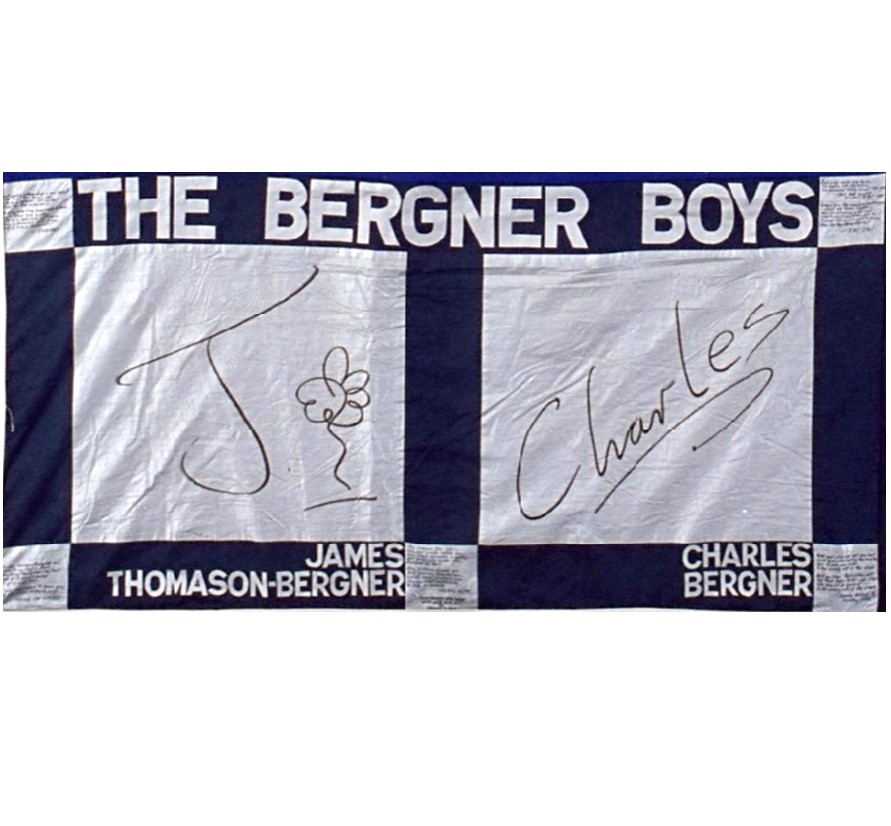
James Thomason-Bergner, musical director and conductor for the San Francisco production of Beach Blanket Babylon, dies of AIDS-related illness on his 40th birthday.
Learn More.Thomason-Bergner was also a vocal coach and headed the musical theater program at Lone Mountain College. He had been musical director for the Theatre of Music in Santa Fe, as well as for the Santa Fe Community Theater.
Originally from Austin, Texas, Thomason-Bergner graduated from the University of Texas and then moved to San Francisco to attend Lone Mountain College.
His younger brother, Charles “Charlie” Bergner, had died in late 1983 of AIDS-related illness at the age of 34. Both James and Charles were valued members of their local churches, James attending the Santa Fe Unitarian Church and Charles attending Washington Square United Methodist Church in New York City.
“I knew that Charles was interested in healing and prayer and meditation,” wrote fellow congregant Nancy A. Carter in 1985. “I asked if he would like me to do healing work with him. He said, ‘Yes.’ I explained therapeutic touch, a type of laying on of hands that I would use with him.”
Carter recalled that when she worked on Bergner, he experienced “vivid, colorful imagery … in the form of a windmill.”
“He said that the windmill was standing on parched land, but the wind was blowing and the windmill was drawing up water from beneath the earth and was nourishing the dry land,” Carter wrote. “The image of the windmill became very important to us. Most every time I worked with Charles, the windmill appeared to him.”
As she provided care for her friend, she said she realized that if his death was inevitable, at least she could assist with his spiritual healing.
“Charles suffered with AIDS, but he did not suffer the way that some do. He had love and he had courage which sustained him. God was with him. Charles reached out to friends and friends reached out to him,” she said.
On Sunday, December 25, 1983, the congregation telephoned Bergner to sing Christmas carols to him as he lay in a hospital bed, battling pneumocystis carinii pneumonia. He died the next day, with his partner David and his sister at his side.
Carter recalled how in 1983, Washington Square Church began providing pastoral services to all persons living with AIDS. The church also made available space for support groups affiliated with the Gay Men’s Health Crisis to use for meetings.
“We were one of the first churches to go into HIV/AIDS ministry,” Carter said.
* * * * * * * *
Photo of quilt panel from the AIDS Memorial Quilt

James Patterson Miller, a Chicago actor known professionally as J. Pat Miller, dies of AIDS-related illness in Chicago at the age of 39.
Learn More.Miller was nominated for Jefferson Awards for playing the title role in Peter Handke’s Kaspar and for his performance as Antonin Artaud in the Victory Gardens Theater production of Artaud.
Miller made his theatrical debut in Whores of Babylon, the debut production of the Godzilla Rainbow Troupe, cofounded by Gary Tucker and Tommy Biscotto.
“Most vividly, I remember the actor whose performance [a theater critic] praised without naming the artist who delivered it. He was J. Pat Miller, making his Chicago stage debut,” wrote Albert Williams in the Chicago Reader.
Miller went on to become one of Chicago’s most popular and respected actors with performances at the Goodman, Organic, Victory Gardens, and Wisdom Bridge, as well as a celebrated European tour of Waiting for Godot.
In May 1985, Season of Concern would launch the Biscotto-Miller Fund, named in memory of Miller and another luminary of the Chicago theater world, Tommy Biscotto. The fund was created in tandem with the benefit performance event, Arts Against AIDS at Second City to raise money for medical care, food, housing, and other basic needs to Chicago theater artists with HIV/AIDS.
Over the next few years, this volunteer effort expanded into Season of Concern — a full-time, professional operation that raises money for local direct-care organizations serving community members fighting AIDS and other catastrophic illnesses. The Biscotto-Miller Fund continues as an emergency fund, offering direct cash grants to individuals in need.
* * * * * * * *
Photo of quilt panel from the AIDS Memorial Quilt
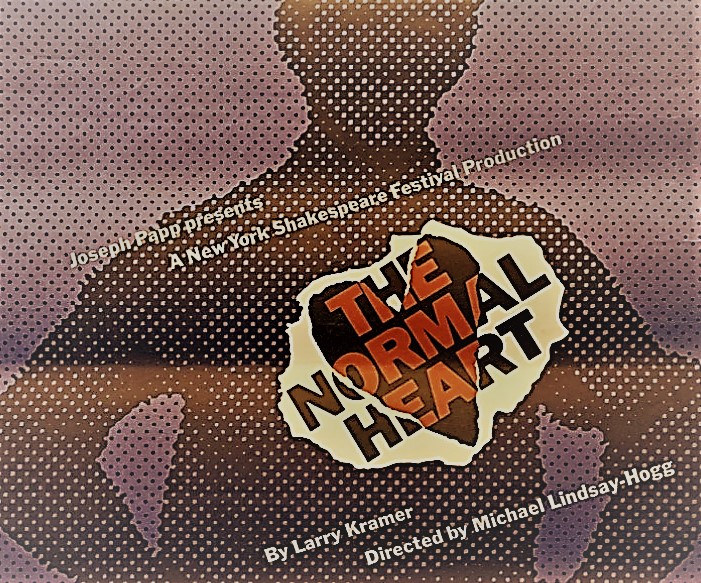
AIDS activist Larry Kramer’s autobiographical play, The Normal Heart, opens Off-Broadway at the Public Theater.
Learn More.The play covers the impact of the growing AIDS epidemic on the NYC gay community, highlighting growing rifts between those — like the play’s protagonist, Ned Weeks (Kramer’s alter ego) — who are desperately banging on the doors of government and science in an attempt to stave off the annihilation of gay men, and those who focus instead on building new institutions that will care for the sick and the dying.
“The blood that’s coursing through ‘The Normal Heart,’ the new play by Larry Kramer at the Public Theater, is boiling hot,” said New York Times theater critic Frank Rich.
“In this fiercely polemical drama about the private and public fallout of the AIDS epidemic, the playwright starts off angry, soon gets furious and then skyrockets into sheer rage.”

William M. Hoffman’s play As Is opens on Broadway.
Learn More.The plot focuses on a gay couple who have broken up — but when one of them develops AIDS, his ex-partner comes back to take care of him — “as is.”
The play gets excellent reviews and runs for 285 performances.
“Strange as it may sound, Mr. Hoffman has turned a tale of the dead and the dying into the liveliest new work to be seen at the Circle Repertory Company in several seasons,” said New York Times theater critic Frank Rich.
David Goodstein, former publisher of The Advocate who missed the chance to turn his national publication into a much-needed resource during the early years of the AIDS crisis, dies at Sharp Memorial Hospital in San Diego of colon cancer. He was 53.
Learn More.Goodstein published The Advocate from 1975 to 1978 and again from 1982 until 1985. He was the owner of Liberation Publications, the parent company of The Advocate that also distributed other magazines.
Because Goodstein was slow to understand the seriousness of the threat posed by AIDS, he missed an opportunity to use his popular national magazine as a clearinghouse of information for a population starved for information about HIV and AIDS, according to the LGBT Archives.
In a letter to his readers in 1983, Goodstein wrote: “So far, no one knows with certainty what causes the fatal ‘new’ diseases. Heterosexuals, one person in a monogamous relationship and not the other, even infants have succumbed. Yet many cases are centered in the gay men’s community, especially in New York City. Most of us who know a lot of gay men also know one or more who have died. Living with this situation feels a bit like it must have felt to be alive when the plague was decimating the population of Europe.”
Born in 1932 into a wealthy Denver family, Goodstein was afflicted with scoliosis and was subjected to a lonely childhood. He received his undergraduate education at Cornell University and then earned a law degree from Columbia University. He practiced law as a criminal defense attorney for several years in New York City.
In 1970, he moved to California, and in 1975 he bought The Advocate, which was then a small publication that served the Los Angeles gay and lesbian community. He moved the magazine to San Mateo, near San Francisco, and under his ownership, transformed The Advocate into the most widely-read LGBT news magazine in the country.
Goodstein’s tenure as publisher began with the firing of the entire editorial staff, according to Lionel Biron in the literary magazine Gay Sunshine (1976). Among those who Goodstein fired was columnist Arthur Evans, one of the founders of the Gay Activists Alliance (GAA) in New York. The GAA would become a frequent critic of The Advocate over the years, accusing Goodstein of making the magazine “a show place of white, middle-class gay America.
Goodstein forbid the mention of certain LGBT activists and organizations that he believed had undermined him in some way. When in 1978, Los Angeles-based activist Morris Kight challenged Goodstein’s control of the Committee for Sexual Law Reform, Goodstein assigned Randy Shilts to do an exposé on him, according to the LGBT Archives. Realizing that there was nothing to warrant a negative story on Kight, Shilts decided to resign from The Advocate, and famously went on to become the first openly gay reporter for the San Francisco Chronical.
Goodstein also leveraged his power in positive, constructive ways. In 1977, he was among the founders of Concerned Voters of California, an organization formed to oppose the Briggs Initiative. Named after California State Senator John V. Briggs, the Briggs Initiative sought to bar gay men and lesbians from teaching in public schools. In a major victory for the gay rights movement, the Briggs Initiative was defeated in November 1978, thanks largely to the campaign coordination by the Concerned Voters of California.
Also, shortly after Anita Bryant’s successful 1977 campaign to repeal the gay rights law in Florida’s Dade County, Goodstein met Werner Erhard, founder of Erhard Seminars Training (better known as “est”).
“The meeting convinced Goodstein that the real problem facing the gay movement was not political but emotional,” wrote John Gallagher in The Advocate in 2001. “Goodstein complained that there was ‘an awful lot of a syndrome I have defined as toilet mentality — that is, a willingness to accept second-rate status as human beings, expecting to lose rather than win, and a constant involvement in petty right-wrong games.'”
In March 1978, Goodstein launched “The Advocate Experience” with about 100 people at the Jack Tar Hotel in San Francisco. With psychologist and author Rob Eichberg, Goodstein articulated a vision that by the year 2000, homosexuality would be accepted by everyone in society, and this would happen by raising the self-esteem of gays and lesbians. . Over the next 23 years, about 50,000 people participated in Experience workshops; the program was discontinued in February 2001.
The Advocate remains a leading national source of LGBTQ+ news. Goodstein’s legacy also includes the 1988 founding of Cornell University’s Human Sexuality Collection, which was funded by a generous gift from Goodstein. The collection includes Goodstein’s personal papers and memorabilia.
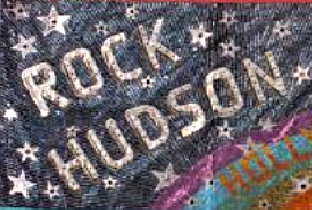
When movie star Rock Hudson dies in Beverly Hills of AIDS-related illness at age 59, the media attention causes public perceptions about the epidemic to shift.
Learn More.As the first major U.S. public figure to publicly acknowledge AIDS diagnosis, Hudson brought attention to an epidemic sweeping the U.S. Hudson’s public disclosure also helped to dismantle the stigma associated with the disease.
Hudson would inspire Elizabeth Taylor, who became friends with Hudson on the set of the film Giant, to become an AIDS activist like none other, rallying the Hollywood community to raise millions for research. Upon his death, Hudson left $250,000 to help set up the American Foundation for AIDS Research (amfAR), which was chaired by Taylor in the organization’s early years.
Tall, dark and handsome, Hudson was one of Hollywood’s most popular leading men during the 1950s and 1960s. Making more than 60 films during his career, Hudson presented the image of a “lady-killer” before the camera, but he had a sexual preference for men. According to People magazine, his friends and often his colleagues on film and TV knew that Hudson was gay.
“We all knew Rock was gay, but it never made any difference to us,” actress Mamie Van Doren told People in 1985.
She said that she often accompanied Hudson on studio-arranged dates. “Universal invested a lot of money in Rock.”
Fearing exposure in Hollywood, Hudson would often visit San Francisco to frequent gay discos unrecognized, according to People. While in Los Angeles, he maintained a low public profile, preferring instead to entertain friends at his Beverly Hills home.
In the 1970s, Hudson moved from film to television to star in McMillan and Wife. From 1984 to 1985, he had a recurring role on Dynasty. Hudson was diagnosed with AIDS on June 5, 1984.
In July 1985, Hudson agreed to appear as the first guest on the new talk show of Doris Day, his friend and frequent co-star in 1960s romantic comedies. Day said afterward that she was shocked by how steeply Hudson’s health had declined since she had last seen him a few years before, according to the Los Angeles Times. Despite needing rest, Hudson insisted on taping the show, Doris Day’s Best Friends.
Later that month, Hudson traveled to France to seek AIDS treatment that wasn’t available in the U.S. and was hospitalized there. In response to rabid media speculation, Hudson issued a press release on July 25 stating he had AIDS.
With that announcement, Hudson became the first major celebrity to go public with an AIDS diagnosis, according to A&E’s History.
Doris Day’s Best Friends would premiere in October 1985, just days after Hudson’s death was announced in the media. The episode opened with an introduction by Day, her voice emotional as she relayed something that Hudson told her: “The best time I’ve ever had was making comedies with you.” Day told her audience that she felt the same way.
* * * * * * * *
Photo of quilt panel from the AIDS Memorial Quilt

New-wave rock musician and founding member of the B-52s, Ricky Wilson dies of AIDS-related illness at the age of 32.
Learn More.The B-52s become popular for their dance tunes — “relentless, rhythmic songs built around Ricky Wilson’s scratchy, one- and two-chord guitar riffs, Kate Pierson’s throbbing keyboard bass lines, and Keith Strickland’s propulsive drumming,” writes James Henke in a 1980 feature in Rolling Stone.
Wilson’s musical inspirations were children’s music, The Mamas & The Papas, and Esquerita, writes Stephen Rutledge in The WOW Report.
“At first, The B-52s did not have a bass player, so Wilson invented his own tunings on a guitar, grouping the strings into a bass course,” Rutledge says. “It was quite an original sound. It was a sound that I still continue to really dig. I had some major fun on the dance floor in the late 1970s-early and 1980s, courtesy of the B-52s.”
In the beginning, the Athens, Georgia-based band would scrape together the resources to take trips to New York City to perform at Max’s Kansas City, CBGB’s and Club 57.
“My parents lent us their station wagon,” Ricky tells The Rolling Stone in a 1980 interview, “and we borrowed Keith’s parents’ charge card.”
By the winter of 1978, The B-52s would become the hottest club band in New York, and everyone would be trying to get a copy of their independently produced single, “Rock Lobster.”
“At a time when an overwhelmingly straight, male punk scene ruled, The B-52s’ knowingly kooky aesthetic, along with their hilariously surreal lyrics in songs like ‘Quiche Lorraine,’ read as queer to those with the eyes to see it,” writes Billboard reporter Kera Bolonik.
Much of queer aesthetic came from Wilson’s songwriting.
“I remember seeing him write some music and laughing to himself,” says band member Cindy Wilson, who was Ricky’s sister. “I said, ‘What are you laughing at?’ He said, ‘I just wrote the stupidest riff.’”
It would be for their first single, “Rock Lobster,” which became an instant hit with East Village audiences but wouldn’t reach mainstream listeners until the mid-1980s. Wilson would go on to become the principle songwriter for the band’s first four albums.
“We were writing [fourth album] Bouncing Off the Satellites, and Ricky just got thinner and thinner,” band member Kate Pierson recalled in an interview years later. “And we suspected, but we didn’t know. One day he wasn’t there at rehearsal. The next day, Keith [Strickland] called me and said, ‘Ricky’s dying of AIDS.’”
Wilson had confided in band member Strickland about his illness, but wanted to keep it a secret — even from his sister Cindy — so no one would worry about him or fuss about it. Just a few days later, Wilson would die, Kate says.
“We were all mourning Ricky, and I was in a deep depression,” recalls Cindy Wilson in Classic Pop magazine.
The band would wait almost a year to release their fourth album. In 1988, still mourning the loss of his close friend, Stickland isolated himself in the upstate New York countryside and began working on new songs.
“Eventually, he called Kate and me to see if we were interested in working on new music,” Cindy Wilson would tell Classic Pop. “When we started jamming, it felt like Ricky was in the room with us. I was having a really hard time with the grieving and sorrow, but creating this music was such a wonderful thing. Ricky’s spirit was there and it was amazing.”
For Cosmic Thing, the first album without Ricky Wilson, band members reject the idea from industry professionals that they find a new guitarist. Instead, Strickland would learn how to play guitar in Wilson’s unique style.
Inspired by Wilson, the band’s song “Roam” is “a beautiful song about death,” Cindy says. “It’s about when your spirit leaves your body and you can just roam.”
* * * * * * * *
Photo of quilt panel from the AIDS Memorial Quilt
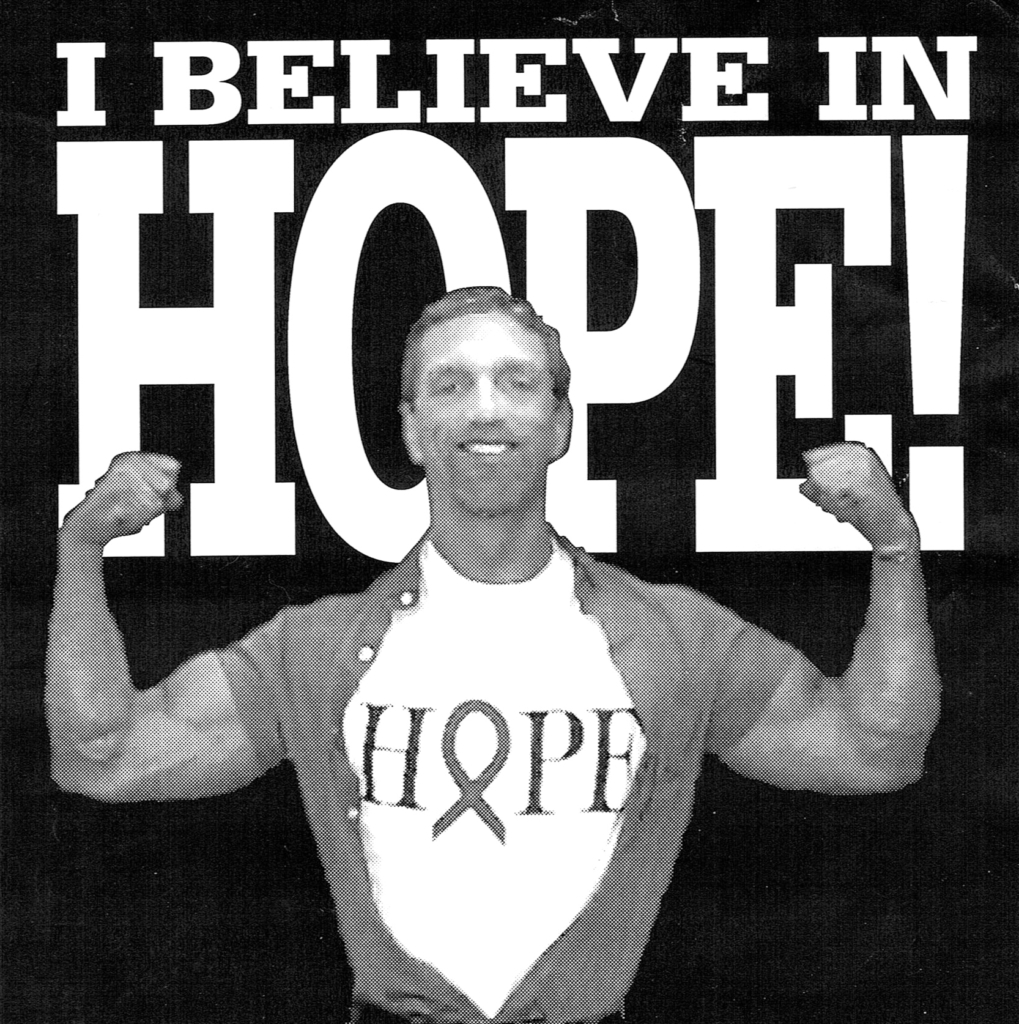
Tammy Faye Bakker, a televangelist with a nationwide following, interviews AIDS activist and ordained pastor Steve Pieters on her show Tammy’s House Party, becoming one of the very first nationally broadcast, longform interviews with an HIV-positive gay man.
Learn More.Rev. Pieters, who agreed to the interview with Bakker on the condition that it be broadcast live so that it could not be edited or taken out of context, presented Christian TV fans with a novel viewpoint, one that never had been heard from outside the LGBTQ community.
At the time, homophobic rhetoric dominated televangelist TV shows, according to Religion & Politics, an online news journal from the John C. Danforth Center on Religion & Politics at Washington University in St. Louis.
“As a pastor, [Rev. Pieters] stood in sharp contrast to the often-vitriolic rhetoric about AIDS from conservative Christian spokespeople,” wrote Emily Johnson, author of This Is Our Message: Women’s Leadership in the New Christian Right and a professor specializing in the U.S. histories of gender and sexuality. “While others quoted the Bible to condemn people with AIDS, Pieters drew on his faith and his theological training to make sense of his diagnosis and to preach about hope and community.”
Although weakened by his illness, Dr. Pieters was a highly capable interview subject. He had been pastor of the Metropolitan Community Church, which was founded in Hartford, Connecticut by activist Troy Perry as a place for people from the LGBTQ commuity to worship God.
“There were some virulently anti-gay groups,” Dr. Pieters wrote in a 2022 article for The National Geographic. “I would find myself on TV arguing with homophobic priests or ministers that I would later see in the gay bars in Hartford around the same time. So I learned early on how to handle myself in the media around issues of being gay.”
In his interview with Bakker, Rev. Pieters talked about his life as a gay man and his own battle with AIDS. During the broadcast, Bakker sat in a studio with a monitor streaming Rev. Pieters from San Francisco. At that point, Rev. Pieters had been living with AIDS for three years and had survived a near-death experience two weeks earlier.
“She’d say on air that I was having chemotherapy, and that I was being interviewed from Los Angeles because the journey would be ‘too hard on me.’ I think she thought this was true, maybe,” Dr. Pieters wrote in The National Geographic. “What I heard later was that they were afraid that I might not be treated well, that the camera crew wouldn’t work if I was in the studio.”
After two years battling various illnesses and infections, Rev. Pieters was diagnosed with stage-four lymphoma and Karposi’s sarcoma in April 1984, and given eight months to live.
“I wasn’t actually diagnosed with AIDS; I was diagnosed with GRID — gay-related immunodeficiency — which is what they were calling AIDS back then,” he told Religion & Politics in a 2022 interview. “In 1982 and 1983, I was sick with hepatitis, thrush, pneumonia, mono, herpes, shingles, and a variety of awful fungal infections.”
However, one of his doctors believed that if he could stay alive, there still was hope that doctors could find a way for him to manage his condition.
“So I set out to do everything I could to take care of myself and create the conditions for healing in my body,” he said.
During his interview with Bakker, Rev. Pieters also talked about how his faith in God helped him survive.
“When I was finally diagnosed with AIDS, after this long period of feeling abandoned by God and my friends … I fell apart. I absolutely lost my sense,” he told Bakker. “My chaplain, my pastor, Nancy Radcliffe, was with me, and she held me, as did several other friends, as I sobbed and cried my despair, cried out for God.’
“Do you know something? In that deepest, darkest moment, that’s when I found God. When God touched me, and I realized that my life was not yet over, that I still had time, that God was with me against this disease — not having given me this disease — but was with me against this disease.”
When word of the interview spread, many in the gay and lesbian community became Bakker’s fans. She, in turn, continued to openly support the LGBTQ community, preaching compassion and risking her standing within the world of conservative Christian televangelism.
Her obituary in The New York Times noted that she attended LGBTQ pride events. In 1996, Tammy Faye partnered with openly gay actor Jim J. Bullock (Too Close for Comfort, ALF) on the talk show The Jim J. & Tammy Faye Show, but left the show after just a few months when she was diagnosed with colon cancer. Bakker (who later changed her surname to Messner) died in Kansas City in 2007 at the age of 65.
The Bakker-Pieters interview was recreated in the 2021 biographical drama The Eyes of Tammy Faye. Jessica Chastain, who portrays Tammy Faye Bakker in the film, won an Oscar for “Best Performance by an Actress in a Leading Role” and a BAFTA Award for “Outstanding Performance by a Female Actor in a Leading Role.”
Listen to Jessica Chastain tell the story of Rev. Pieters for STORIES: The AIDS Monument.
Watch the entire interview with Rev. Pieters and Tammy Faye Bakker here.
Joel Crothers, who was twice nominated for a Daytime Emmy for Outstanding Lead Actor for his role on ABC’s The Edge of Night, died of AIDS-related illness at Cedars-Sinai Medical Center in Los Angeles. He was 44.
Learn More.Joel Crothers performed on stage and TV, with several roles on daytime soap operas. He became a fan favorite for portrayal of Dr. Miles Cavanaugh on The Edge of Night, which he played for eight years until the show went off the air in 1984. He had just begun a new role in the NBC show Santa Barbara when his health began to deteriorate.
“I was privileged to be one of the people he called to say goodbye during his final days,” said Sharon Gabet, Crothers’ co-star from Edge of Night. “He was hilarious, sweet, direct and loving during that phone call – the same as always. One can only imagine what Crothers was going through. Rhodes scholar, stunningly handsome, a zest for life. A gentleman in the finest sense of the word. I adored him.”
Crothers began his TV career at 9 years old, performing in the CBS show Lamp Unto My Feet, which led to other roles for the young actor. He also performed on Broadway at the age of 12 in The Remarkable Mr. Pennypacker at the Coronet Theatre, which starred Burgess Meredith.
He put his professional acting career on hold to attend Harvard University, and he graduated Phi Beta Kappa in 1962. He returned to acting in 1966 to join the touring production of the Broadway hit Barefoot in the Park. Simultaneously, he joined the cast of ABC’s gothic soap opera Dark Shadows, filming during the day.
In 1969, Crothers took the role of scoundrel Ken Stevens on the long-running soap opera The Secret Storm, and in 1974, he moved on to Somerset, a spinoff series from Another World, where he played newspaper editor Julian Cannell.
From 1977-1984, he grew his fan base on The Edge of Night with his portrayal of Dr. Miles Cavanaugh, for which he was nominated as Outstanding Lead Actor in a Drama Series at the Daytime Emmy Awards in 1979 and 1984.
A few years into his tenure at the soap opera, Crothers was cast in the 1981 production of Torch Song Trilogy, Harvey Fierstein’s three-act play set in the 1970s. This came about through a mutual friend, author Felice Picano, who knew Fierstein was looking for an established actor to take on the role of Ed, the central character’s bisexual lover and friend (“thirty-five and very handsome”).
Picano described in his book Art and Sex in Greenwich Village how he was able to convince Crothers to audition for the role. The next day, Fierstein called Picano and gushed, “Where did you ever find this creature? He’s gorgeous! He’s Olympian! He’s Apollo!”
In October 1981, Torch Song Trilogy opened at the Richard Allen Center on West 62nd Street. Soap fan came in droves to see Crothers perform in the show (which, incidentally, also included Fierstein, Matthew Broderick and Estelle Getty), and soon they needed a bigger venue. On January 15, 1982, the production moved to the 170-seat Actors’ Playhouse in Greenwich Village, where it ran for 117 performances.
Meanwhile, The Edge of Night had its final show on December 28, 1984. By then, Crothers had been diagnosed with HIV and his health had begun to decline. Still, he sought new acting roles, and soon found a new home in the NBC show Santa Barbara, which had premiered the previous summer. The veteran actor was cast in a dual role: playboy attorney Jack Stanfield Lee and his villainous cousin Jerry Cooper. However, Crothers had to be written out of the show when illness prevented him from working.
When he died about a year later, newspapers initially reported the cause of his death to be “cancer complicated by pneumonia,” a reflection of the stigma commonly associated with HIV and AIDS at the time.

Quoting a “prominent physician” in the U.S., the New York Amsterdam News reports that the spread of AIDS in Africa could be traced to experiments conducted there by the U.S. Central Intelligence Agency.
Learn More.Dr. Nathaniel S. Lehrman, an Assistant Clinical Professor of Psychiatry at Albert Einstein College of Medicine in the Bronx, accused the CIA of spreading the AIDS virus in Africa by conducting biochemical experiments. He also claimed in the Amsterdam article that similar experiments were being conducted in the U.S. on gay men, drug users, and Black people.
The doctor’s alarming but unsubstantiated accusations came at a time when the Soviet Union’s KGB and East Germany’s Stasi were conducting a widespread disinformation campaign around the origins of the AIDS virus.
“It is not known whether Lehrman developed his conspiracy theories on his own, or whether he was influenced, knowingly or unknowingly, by the KGB as part of the operation,” wrote global health scholar Anders Jeppsson, PhD. in the Journal of the International Association of Providers of AIDS Care.
In his article titled “How East Germany Fabricated the Myth of HIV Being Man-Made,” Dr. Jeppson notes that East Germany’s intelligence agency circulated documents from Dr. Lehrman in East Berlin scientific circles.
Dr. Lehman’s accusations of a CIA-AIDS connection were repeated and cited throughout the U.S. as well, including among LGBTQ writers.
Charles Shively (1937-2017), a gay liberation icon and poet who founded Fag Rag magazine, shared Dr. Lehman’s theories and other rumors with his publication’s largely gay readership. In a 1987 article for Gay Community News, Shively quoted heavily from a 1986 report about the origin of AIDS crafted by Jakob and Lilli Segal, German scientists who had been recruited by the KGB to spread disinformation about the disease.
The 1980s was a time of widespread confusion and rumors about AIDS.
“Rumors about HIV/AIDS proliferated throughout US society: only gay people can get AIDS; you can catch it from a doorknob, a toilet seat, or a swimming pool; flying insects can transmit it; women are tricking men into having sex with them so they can give them AIDS; AIDS was developed by the Central Intelligence Agency to kill off African Americans and gays; it’s not caused by a virus at all,” wrote sociologist Jacob Heller, PhD. in 2015 for the American Journal of Public Health.
In 1987, the New York Times would publish a letter from Dr. Lehrman that criticized AIDS awareness campaigns for “helping legitimize homosexuality and its culture” and undermining “stable families and societies which are based on … the sacred love of husband and wife.”
Three years later, Dr. Lehrman would be charged, along with the partner of his psychiatric practice, with $1.3 million in Medicaid fraud and sentenced to seven years in prison. He died at his home in Port Washington, New York in 2020.
An Los Angeles Times poll contends that a majority of Americans favor quarantining people who have AIDS.
Learn More.The LA Times poll found that more than half of its respondents support quarantining AIDS patients, nearly half would approve of ID cards for those who test positive for AIDS antibodies, more than a third would be willing to pay a one-cent national sales tax to finance greater research, and one in seven would favor such radical action as tattooing those with the disease.
The poll results came from interviews with about 2,300 across the U.S. — a very small pool of respondents — yet the announcement of the poll results garnered considerable attention nationwide with little regard to the small number of Americans involved in taking the survey.
In its article about the poll results, the LA Times also stated that most responents were adverse to electing homosexuals to office and were disinclined to support candidates who espoused homosexual causes.
“Even a whisper of suspicion about homosexuality was enough to turn almost 60% of the voters against a candidate for the office of President,” stated the LA Times article written by political reporter John Balzar.
“Respondents in the poll were given characteristics of make-believe candidates,” Balzar wrote. “When a rumor of homosexuality was included in the descriptions, support for a make-believe candidate dropped from 70% to 11%.”
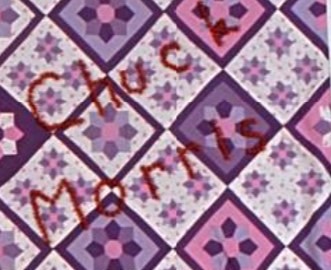
Charles “Chuck” Lee Morris, former owner and publisher of the San Francisco Sentinel, dies of AIDS-related illness in Denver at the age of 42. Morris is also the co-founder of two AIDS hospice programs in California.
Learn More.Believed to be one of the longest-living victims of AIDS, Morris reportedly had been seriously ill since April 1978, but he wasn’t diagnosed with AIDS until 1982
Morris was a confidant of Dianne Feinstein, often advising the then-Mayor of San Francisco on issues affecting the city’s gay community. Elected officials such as Senator Edward M. Kennedy, President Jimmy Carter, and Vice President Walter F. Mondale sought out Morris’ political endorsements.
In the early 1980s, Morris helped found two hospice programs in California for those dying of AIDS.
Morris and his partner moved to Denver in the spring of 1984. Dr. Charles Kirkpatrick, Morris’ physician and an AIDS researcher at National Jewish Hospital, said Morris survived four to five times longer than most AIDS patients. He said at the time that the average survival time of someone with full-blown AIDS was 12-18 months.
* * * * * * * *
Photo of quilt panel from the AIDS Memorial Quilt
“That’s What Friends Are For” — recorded by Dionne Warwick, Stevie Wonder, Elton John and Gladys Knight — becomes #1 on the Billboard charts, eventually raising about $3 million for the American Foundation for AIDS Research.
Learn More.How Warwick was able to get three superstars to join her in the recording studio was the result of having a collection of creative geniuses for friends, the audacity to just ask, and serendipity.
When Warwick first heard “That’s What Friends Are For,” she envisioned singing it as a duet with Stevie Wonder, according to Song Facts. The song’s composers, Burt Bacharach and his then-wife, Carole Bayer Sager, agreed to produce the recording, happy to see their song have another chance to reach an audience. They originally wrote the song for the 1982 movie Night Shift, where it was recorded by Rod Stewart and played over the closing credits.
Warwick put down her tracks, and then invited Wonder to do his part. On the day Wonder was scheduled to record, Elizabeth Taylor and Neil Simon came to the studio to hear him sing. Knowing of Taylor’s commitment to AIDS research, Bayer Sager suggested to Warwick that they arrange for the song royalties to benefit HIV/AIDS research. Everyone agreed it was a great idea, Warwick told People magazine in 2019.
They decided there was room for another singer, so Gladys Knight was invited. But then Warwick ran into Elton John in the grocery store.
“I said, ‘I’m recording tomorrow and I need you.’ That’s how simple it was,” Warwick told People.
The group became a quartet, aka “Dionne Warwick and Friends.”
The next day, Warwick, Knight and John arrived at the recording studio, and were joined by Bacharach and Bayer Sager — and Elizabeth Taylor, who was determined to see the project through.
Knight and John each recorded their parts, and Bacharach and Bayer Sager then went to work to assemble the four vocal tracks into a final recording, according to Song Facts. Later, the singers would perform together for a music video of “That’s What Friends Are For.”
“It was a very emotional evening in which a lot of tears were shed,” Bayer Sager told The New York Times.
In January 1986, “That’s What Friends Are For” rose to number one on the Billboard charts and remained there for four weeks. The song would win a Grammy Award for “Best Pop Performance by A Duo Or Group With Vocal” and another for “Song Of The Year.” It was Warwick’s fifth Grammy Award, and Elton John’s first, according to Song Facts.
In February 2011, Warwick, Wonder, Knight and John would reunite at amfAR’s kickoff event for New York Fashion Week and give a live performance of “That’s What Friends Are For.”

Howard Greenfield, the 20-year songwriting partner of Neil Sedaka, dies of AIDS-related illness in Los Angeles at the age of 49.
Learn More.The first Greenfield-Sedaka hit would be ‘‘Stupid Cupid,” recorded by Connie Francis in 1958. Later collaborations with Sedaka included ”Calendar Girl,” ”Oh! Carol” and ”Next Door to an Angel.”
Greenfield would write the lyrics for ”Breaking Up Is Hard to Do,’‘ ”Happy Birthday, Sweet Sixteen,” ”Love Will Keep Us Together” and more than 450 other songs throughout his career.
Born in 1936, Greenfield grew up in the same Brighton Beach apartment building as Sedaka, who was three years older than Greenfield.
“After Howie’s mother Ella had seen me, he came ringing my doorbell,” Sedaka would tell Goldmine magazine years later. “I was playing Chopin, and he said, ‘My mother heard you play and thought we could write a song together.'”
Greenfield was openly gay at a time when it was particularly courageous to do so. His companion from the early 1960s until his death was cabaret singer Tory Damon.
The two lived together in an apartment on East 63rd Street in Manhattan before moving to Los Angeles in 1966. Damon would die of AIDS-related illness just 26 days after Greenfield’s death.
Greenfield’s and Damon’s bodies are interred side-by-side at Forest Lawn Memorial Park in Los Angeles. Damon’s epitaph reads: Love Will Keep Us Together…, and Greenfield’s epitaph continues: … Forever.
William F. Buckley, seen by many as the founder of the modern conservative movement, writes in a New York Times op-ed that people diagnosed with HIV should be tattooed with a warning on their arm and buttocks.
Learn More.Under the heading “Critical Steps in Combating the AIDS Epidemic,” Buckley writes:
“Everyone detected with AIDS should be tattooed in the upper forearm, to protect common-needle users, and on the buttocks, to prevent the victimization of other homosexuals.”
Buckley, founder of National Review magazine, also proposes that everyone seeking a marriage license must “present himself not only with a Wassermann test but also an AIDS test.”
He goes on to write that the couple could marry only after “the intended spouse is advised that her intended husband has AIDS, and agrees to sterilization.”
Looking back at this time, Michael Spector would write in The New Yorker in 2021, “Several years into a harrowing epidemic, gay Americans were told that an act of consensual sex could not only infect them with a fatal disease; it could also, at the will of a state, send them to prison. The fears of internment were not easily dismissed as hysteria.”
Buckley would later withdraw the proposal, because “it proved socially intolerable.”
At the time of his death in early 2008, Buckley would no longer be considered a journalist of any repute, although conservative circles would continue to champion his ideas. When he died, he was working on a book about President Ronald Reagan.
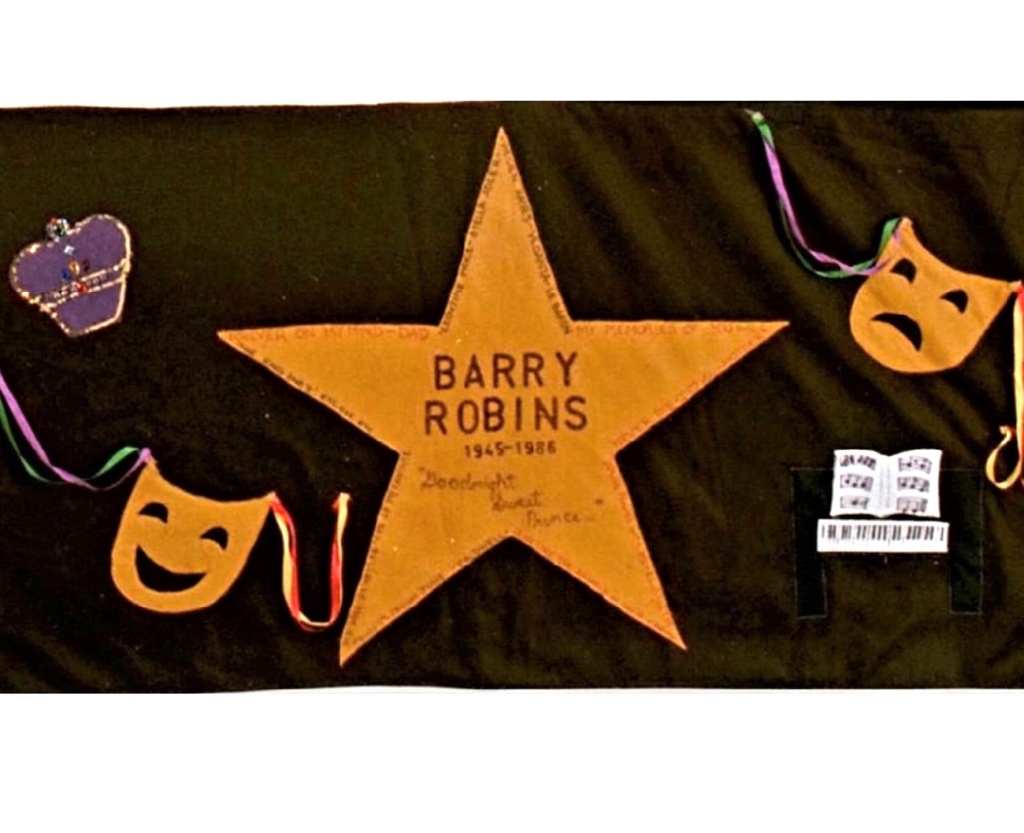
Barry Robins, best known for his portrayal of troubled teenager “Cotton” in the 1971 film Bless the Beasts & Children, dies of AIDS-related illness in Los Angeles at the age of 41.
Learn More.In New York Times article, “The Gay Film That Changed My Life,” actor John Cameron Mitchell credits Robin’s portrayal of “Cotton” as having a profound impact on him as a boy.
In particular, Mitchell is moved by the scene in which Robin’s character saves another character, a “delicate, blond shiksa” named Gerold, from a gang of bullies.
“The mean boys part for Cotton as he reaches a hand out to the boy,” Mitchell recalls. “Branded on my 10-year-old brain was Gerold’s heartbreaking expression when he realizes that for the first time there is someone he can trust and, just maybe, love.”
Mitchell adds, “It was sad to hear that Robins succumbed to AIDS in 1986. If we’d met, I would’ve thanked him for helping me out of the pond.”
In 2013, actor and comedian Jason Stuart would tell A&U: Art & Understanding magazine:
“When Barry got really sick, he stopped seeing people, including me. I was devastated. I remember going by his apartment, knocking on his door, and he would not answer it. He would tell me, ‘Go away. It’s better that way.’ I respected his wishes. To this day I regret that.”
* * * * * * * *
Photo of quilt panel from the AIDS Memorial Quilt

Stephen Stucker, the scene-stealing comic performer in the Airplane! movies, dies from AIDS-related illness at the age of 38.
Learn More.Stucker was known for zany portrayals in comedies, notably the manic air traffic controller Johnny in the 1980s Airplane! movies.
Created by the directing-writing team of Jim Abrahams and brothers David and Jerry Zucker, the Airplane! movies featured Stucker in a non-essential role that wasn’t crucial to the plot. But in a movie with established stars, larger-than-life performances and endless jokes, Stucker managed to steal every scene he’s in with his comic performance.
Some may see the character as an offensive stereotype that hasn’t aged well, but Stucker’s performance can also be viewed as progressive for its time, a character that is unapologetically gay in an era where that was still taboo. Johnny is never harassed or bullied by the over-the-top manly-men characters (played by Robert Stack, Lloyd Bridges, Peter Graves, and Leslie Nielsen) that dominate Airplane! Instead, Johnny turns the joke around on them and provides the perfect foil to their authority, gruffness, and self-importance. The screenwriters developed the character specifically for Stucker, who wrote his own lines for the part and ad-libbed many of them.
Born in Des Moines, Iowa, Stucker moved with his family to Alameda, California, where he attended Lincoln School. During his school days Stephen was known as both an accomplished pianist and a class clown with a dry wit. Stucker made his film debut in 1975 as a crazed asylum escapee in Delinquent School Girls (also released as Carnal Madness).
He went on to perform in the 1977 earthquake-disaster comedy Cracking Up, alongside Fred Willard, Michael McKean, and Harry Shearer. Stucker had been a scene-stealing member of the cast of the Madison, Wisconsin Kentucky Fried Theater sketch comedy troupe founded by Abrahams and the Zucker brothers and, in 1977, he appeared in the film based on the troupe’s comedy sketches. The Airplaine! movies soon followed.
Stucker also appeared on Marie Osmond’s TV show, Marie (1981), and on one of the last epidodes of Mork and Mindy (1982), playing a wildly enthusiastic TV producer intent on capitalizing on Mork’s fame.
Stucker was diagnosed with AIDS in July 1984, and was one of the first celebrities to go public with his diagnosis. He appeared on talk shows like Donahue, where his unrestrained and acerbic personality sometimes bumped hard against an audience ignorant and fearful of AIDS.
* * * * * * * *
Photo of quilt panel from the AIDS Memorial Quilt
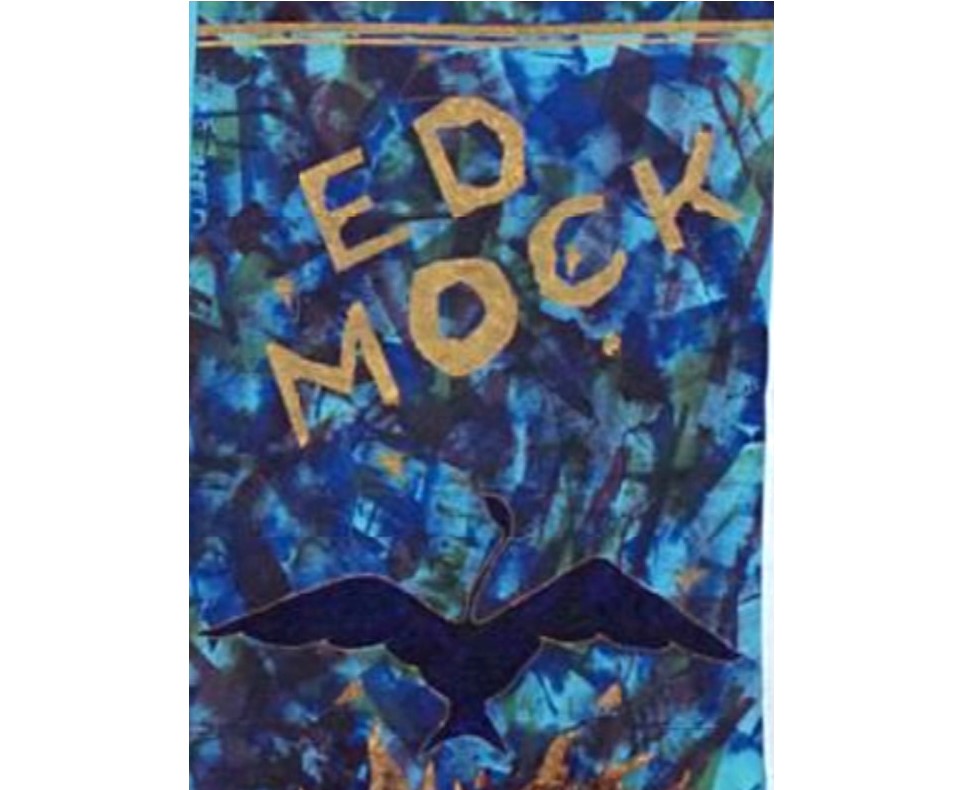
Dancer and choreographer Ed Mock — who fused modern dance and jazz dance, acting, improvisation and mime in his work — dies of AIDS-related illness in San Francisco at the age of 48.
Learn More.As the founder of the West Coast Dance Company (1974-1979), Ed Mock Dancers (1980-1985), and the Ed Mock Dance Studio, Mock’s dance style and teaching influenced future generations of dancers and artists.
Brontez Purnell, Director of the documentary Unstoppable Feat: The Dances of Ed Mock, states, “I believe Ed Mock is the missing choreographic link between Alvin Ailey, Anna Halprin, and Bill T. Jones. He is my direct predecessor, creatively. We – artists, black queers, Bay Area dancers, gay men – have to extract our collective past and create the historical record.”
Born in Chicago, Mock performed as a boy in his family’s pool hall, tapping out steps for customers. Athletic in high school, he chose to pursue dance because, as he would tell the San Francisco Examiner in 1980, “I just love body movement, it was all just movement for me, and sports was just a function of that. I just was always aware of my body in a sort of a dance sense. I never try to tell anybody it’s an easy life, but not a day has ever gone past that dancing didn’t make me feel good emotionally and spiritually.”
Mock would teach and perform taught and performed up until weeks before his death. In 1988, he would posthumously be elected to the Bay Area Dance Coalition Hall of Fame.
* * * * * * * *
Photo of quilt panel from the AIDS Memorial Quilt
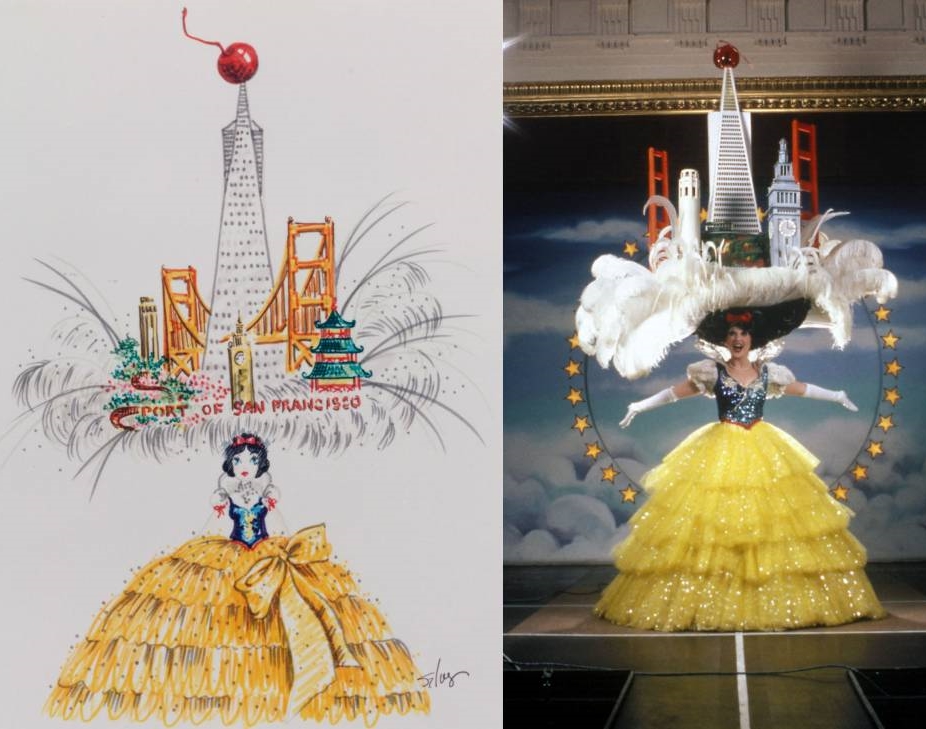
Herman George, the first in-house costume designer for the long-running stage show Beach Blanket Babylon, dies of AIDS-related illness at the age of 46.
Learn More.George also designed costumes for the San Francisco Opera and Charles Pierce. For Pierce’s New York production of “The Crazy Ladies,” George created the costumes for Pierce’s various numbers in which he impersonated prominent female celebrities, according to the New York Public Library.
But it was for Beach Blanket Babylon, a stage show in North Beach known for its camp aesthetic and over-the-top costumes, that George found the opportunity to create outrageous, one-of-a-kind ensembles for the stage, often based on sketches from Babylon producer Steve Silver.
Beach Blanket Babylon closed in 2019 after an epic 45-year run, and many of the costumes remain today in a 6,000-foot San Francisco warehouse. But some of the pieces are being sent to various museums for historical preservation, including The Smithsonian in Washington, D.C. and the M.H. de Young Memorial Museum in Golden Gate Park, according to Jo Schuman Silver, who took over the show when her husband died in 1995 of AIDS-related illness.
During its historic run, the show toured to Las Vegas and London, and opened the Academy Awards. ; Queen Elizabeth II, Prince Charles, David Bowie, Liza Minnelli and Robin Williams were among its fans.

Top fashion designer Perry Ellis dies of AIDS-related illness at New York Hospital-Cornell Medical Center. He was 46.
Learn More.Both women and men adored Ellis’ fashion sense for its clean-cut, all-American look. What the designer did best was take elements of classic American style — like stadium coats, tweed jackets, and homey sweaters — and adapt them to suit the consumer passion for gender-neutral, high-quality separates, according to Love to Know.
Ellis presented his first collection under his own name on Seventh Avenue in 1979 and almost immediately achieved star status.
His design aesthetics earned him accolades — including the Coty Award for his first show in 1979, which he would go on to win eight more times, and the Council of Fashion Designers of America’s Designer of the Year Award in 1982. And in 1984, he became the head of the CFDA, extending his influence on designers worldwide.
In November 1984, a daughter was born to Ellis and Hollywood TV writer and executive Barbara Gallagher. Tyler Ellis was only 18 months old when her father died.
At the time, the cause of Ellis’ death was listed as viral encephalitis, but rumors of Ellis’s HIV-positive status made news after it came to light that his lover and business partner, Laughlin Barker, died earlier in the year of Kaposi’s sarcoma.
In a controversial move, some media organizations mentioned the rumor that Ellis was HIV-positive in his obituary. While the vast majority of newspapers omitted mention of the rumor, the Washington Post, USA Today, Newsday and the San Francisco Examiner decided to publish it. Among the news magazines, Newsweek mentioned the AIDS rumor, and Time did not.
This started a conversation among media professionals worldwide about whether media outlets should mention AIDS as a cause of death if AIDS can be proved or is openly acknowledged — as was ultimately the case with actor Rock Hudson. Or, they posited, should they mention AIDS if it is only widely believed but neither acknowledged nor proved?
Disclosure of HIV-positive status was a very sensitive subject, involving matters of privacy — medical and sexual — since many media consumers automatically assumed someone was gay if he had AIDS.
But many close to Ellis, including top industry professionals, already knew the fashion designer was ill.
“What really, truly, abruptly woke up the entire fashion industry was Perry walking out at the end of his last fashion show,” fashion designer Michael Kors recalled. “He barely could walk, and here was someone young, talented, great-looking, full of charm and life, and suddenly this was a shell of a human being.”
The show took place on May 8, and afterward Ellis checked himself into New York Hospital-Cornell Medical Center, where he died 22 days later.
Ellis’ daughter, Tyler, decided to carry on her father’s fashion legacy. After graduating from Boston University, she moved to New York and interned with Michael Kors. In 2011, she decided to launch her own handbag line, which caters to stars of the entertainment world and fans of luxury accessories.
* * * * * * * *
Photo of quilt panel from the AIDS Memorial Quilt
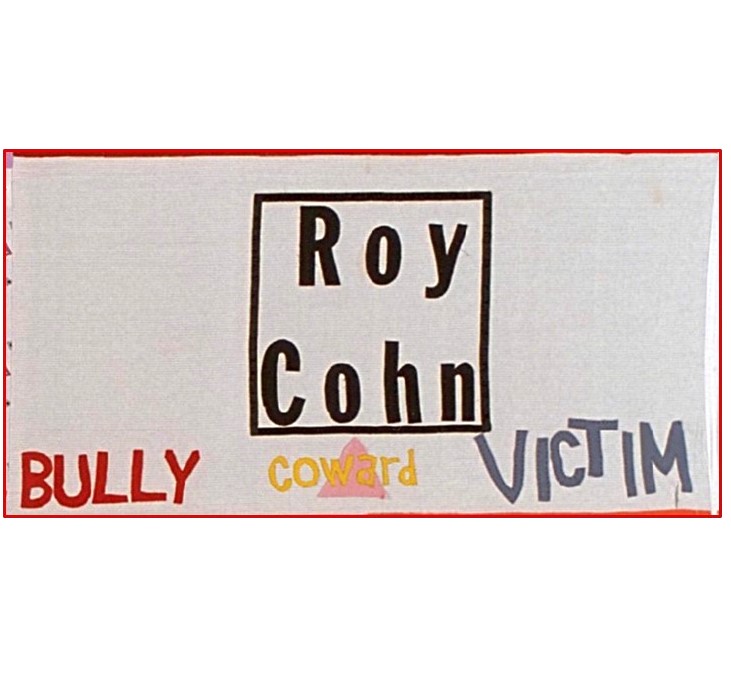
Roy Cohn, best known for his role as chief counsel to Sen. Joseph McCarthy in the 1950s investigation of alleged Communist sympathizers, dies of AIDS-related illness at the age of 59.
Learn More.A graduate of Columbia Law School at the age of 20, Cohn quickly made a name for himself in his first job with the U.S. attorney’s office in Manhattan, prosecuting cases of people with alleged ties to the Communist Party.
Impressed with Cohn’s performance at the trial of Julius and Ethel Rosenberg for spying, FBI director J. Edgar Hoover would recommend that Cohn be hired as chief counsel to the Senate Permanent Subcommittee on Investigations. McCarthy, who chaired the panel, hired the 24-year-old Cohn in January 1953.
“People born in the 1940s or earlier remember Cohn and his master performing on television,” writes Mary Ellen Clark in her 1988 book The Snarling Death of Roy M. Cohn. “They remember coming home to be hushed by a mother or aunt who was watching the hearings; they remember a father’s opinion, expressed at the family table when families still ate together.”
“For younger people, however, Roy Cohn was simply another name for a très smart lawyer, for Disco Dan, for the international, I-go-by-private-plane man,” writes Clark.
Throughout his later life, Cohn was well known for his lavish Washington parties, with wealthy and famous friends among his guests.
“He was a figure very tough and in on things, a champion of the underdog, though definitely running with the overdog pack,” Clark writes. “He nested on the nighttime radio call-in shows; he spread his wings over Koppel on Nightline. He appeared to be able to avoid all taxes and all penalties, maybe because he was connected, or on the A list, or known to the headwaiters and hostesses of New York.”
Cohn would be indicted four times from the mid-’60s to the early ’70s — for stock-swindling, obstructing justice, perjury, bribery, conspiracy, extortion, blackmail, and filing false reports. He is acquitted in three of the cases, and in the fourth, he would escape with a mistrial. This experience would give him “a kind of sneering, sinister sheen of invulnerability,” writes Michael Kruse in Politico.
Cohn would be diagnosed with HIV in 1984 after having a doctor examine a small cut from shaving that wouldn’t stop bleeding. During the visit, the doctor would remove two suspicious growths and the tests would reveal Cohn is HIV positive.
Cohn’s lover Peter Fraser, a New Zealander roughly half Cohn’s age, reported that, “When he found out, he didn’t cry but a couple of tears.”
Cohn would publicly deny that he was HIV positive and would keep his sexuality closeted for the rest of his life. According to Robert E. Bauman, who says he first meets Cohn on the day McCarthy dies in 1957, Cohn paradoxically had a reputation for “fag bashing” and loudly opposed laws that protected gays from discrimination.
In his last months of life, Cohn would be disbarred from law practice in New York for old fraud charges and he would lash out at the bar ethics committee, calling members “a bunch of yoyos.”
Cohn once said he wanted the first line of his obituary to read: “Roy M. Cohn, who served as chief counsel to Sen. Joseph R. McCarthy.”
“Cohn didn’t quite get his wish,” writes Bauman.
When Cohn dies, the headlines would trumpet the fact that he died from complications of AIDS. The mention about McCarthy would come second.
* * * * * * * *
Photo of quilt panel from the AIDS Memorial Quilt

Way Bandy, one of the fashion world’s best-known makeup artists and a best-selling author, dies of AIDS-related illness at New York Hospital-Cornell Medical Center at the age of 45.
Learn More.Considered the “greatest makeup artist in the world” by Vogue fashion editor Polly Allen Mellen, Bandy was in high demand throughout the 1970s and early 1980s. He worked with hundreds of celebrities, including Elizabeth Taylor, Raquel Welch, Catherine Deneuve, Lauren Hutton, Farrah Fawcett, Barbra Streisand, Gloria Vanderbilt, and Cher.
He worked closely with top photographers, such as Scavullo, Richard Avedon, Irving Penn, Helmut Newton, Horst, Hiro and Victor Skrebneski. In 1977, he authored a bestselling makeup manual entitled Designing Your Face, and followed this in 1981 with another manual, Styling Your Face.
Prior to his death, Bandy requested that media outlets report his death as AIDS-related, which was then uncommon.
Born in 1941 in Birmingham, Alabama, Bandy pursued childhood interests that included sewing, music, painting and movie magazines. His family moved to Tennessee, where he graduated from high school. He returned to Birmingham to attend college for two years and then dropped out to model for department stores. He later earned a degree in education at Tennessee Polytechnic Institute, and became an English teacher in Alabama. He married, but separated from his wife shortly after visiting New York City for the first time in 1965.
Bandy moved to New York, changed his name (from Ronald Duane Wright) and enrolled at Christine Valmy’s makeup school. Within a few months, he was heading the salon there.
Bandy was one of the first to use color and texture innovatively. For example, he recommended blending moisturizer with a little water and “red-colored fluid” and “spreading all over the face for a rosy glow.” This was decades before the use of red liquid cheek stains became popular.
A pioneer of contouring, Bandy instructed his subjects to “reveal to our mirror only our best angles and most flattering illusions of reality, as seen through blurred vision and whatever other tricks we have at our disposal.”
Bandy’s techniques sought to create what he referred to as a “Personal Sculpture Portrait” through contouring with “light and dark.”
The opening paragraph of Designing Your Face contains this piece of advice: “I was bored for most of my youth because I tried to do not only what was expected of me, but also many other things I did not enjoy. One day I realized that when you do something with your whole being simply because you love to do it, you experience life as it should be lived. It was then I decided to be free and to do something I loved doing – creating beauty.”
Bandy’s makeup techniques continue to inspire generations of beauty pros and consumers.

Charles “Chaz” Watson, a musician who also acted in Bay Area stage productions, dies at the age of 37.
Learn More.Watson played the french horn and also was a drum major for the San Francisco Gay Freedom Day Marching Band.
“The roster of Bay Area artists who have died from AIDS over the past 25 years carries a poignant double message. It reminds us of all the light these men and women brought — and how much more they had to give when the shadow fell,” wrote San Francisco Chronicle arts and culture critic Steven Winn in 2006. “Death came, in most cases, when these artists were just reaching their prime.”
* * * * * * * *
Photo of quilt panel from the AIDS Memorial Quilt

A Russian-born German scientist and his wife distribute AIDS – Its Nature & Origin to attendees of the Conference of Nonaligned Nations in Zimbabwe. The 47-page pamphlet falsely claims that HIV was created in the U.S. as a biological weapon.
Learn More.Jakob and Lilli Segal, along with 20 KGB officers from the Soviet Union, distributed the report at the conference attended by representatives of more than 100 developing nations.
“Segal’s explicit repudiation of the thesis that AIDS originated in Africa was tailor-made for an African audience, and his claims subsequently appeared in the press of 25 African countries.” wrote scholar Thomas Boghardt in his 2009 article, “Soviet Bloc Intelligence and Its AIDS Disinformation Campaign,” for Studies in Intelligence.
Jakob Segal, a Russian-born German biologist and KGB recruit, crafted the report from information that the Stasi (East Germany’s counterpart to the Soviet KGB) had given him. With the assistance of his scientist wife Lilli, Segal wrote about a series of occurrences — some founded in fact and others totally fabricated — that concluded that the U.S. government created the AIDS virus and first tested it on gay prison inmates.
The creation and distribution of the report was a notable achievement in the disinformation campaign launched by Soviet and East German officials to “strengthen anti-American sentiments in the world and to spark domestic political controversies in the USA.”
The Stasi’s version of the AIDS disinformation campaign was called “Operation Denver” (not “Operation Infektion,” as widely reported at the time). The campaign’s goal was to “strengthen anti-American sentiments in the world and to spark domestic political controversies in the USA,” according to the Stasi’s plan.
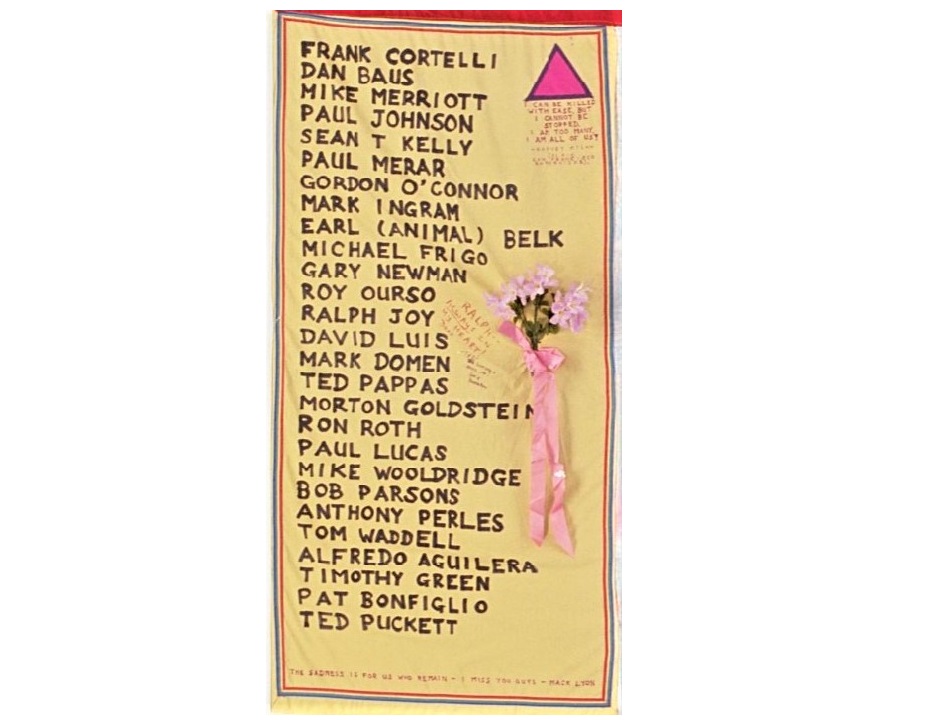
Transportation historian and author Anthony Perles dies of AIDS-related illness at the age of 50.
Learn More.In 1981, Perles’ book The People’s Railway was published, providing a detailed history of the San Francisco Municipal Railway from its earliest days through to the era of light rail. Perles described every aspect of the railway system, including the struggle against United Railroads and the development of light rail vehicles (LRVs) in the 1970s.
Perles’ final work, Tours of Discovery, was published in 1984 and provided a pictorial journey through the decades of development and change on the Municipal Railway of San Francisco.
* * * * * * * *
Photo of quilt panel from the AIDS Memorial Quilt
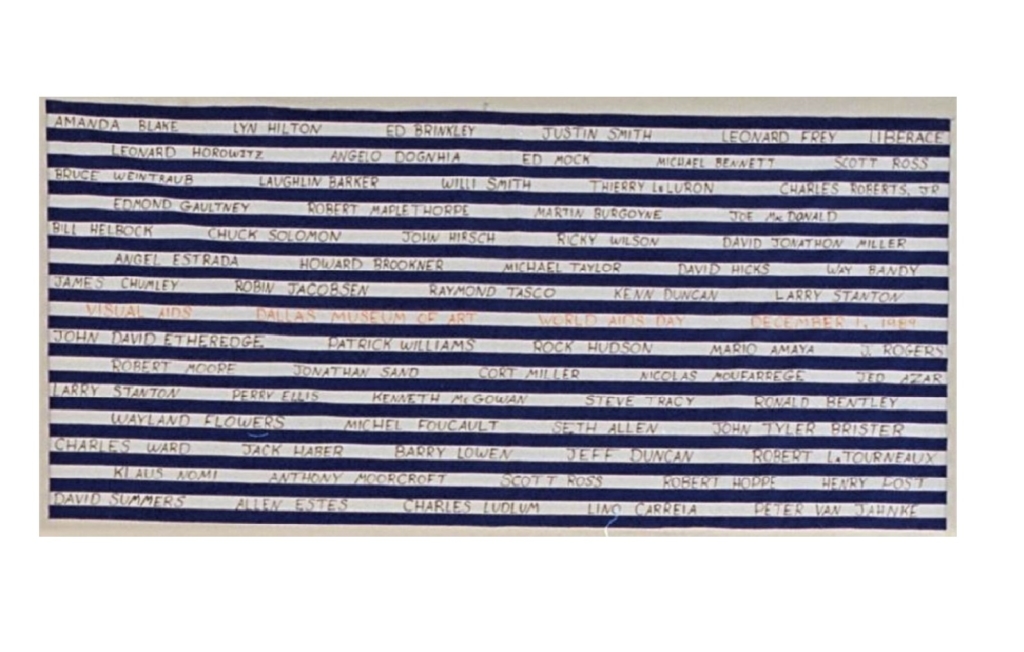
Raymond Tasco, an actor and director with Oakland Ensemble Theatre and Black Repertory Group, dies of AID-related illness at the age of 40.
Learn More.Tasco directed several works at Theatre Rhinoceros and Lorraine Hansberry Theatre. He also co-founded the Bay Area Black Artists’ Connection support group.
* * * * * * * *
Photo of quilt panel from the AIDS Memorial Quilt
Fred Alizie, a singer with the San Francisco Lesbian/Gay Community Chorus and the choral ensemble Vocal Minority, dies of AIDS-related illness at the age of 36.
Learn More.“Fred came from a musical family,” Alizio’s partner Jack Grasso told The San Francisco Examiner. “He loved playing piano and singing with people.”
After Alizio became too sick to perform, he continued to attend performances by the Community Chorus and Vocal Minority, and shortly before he died, he donated funds for Vocal Minority to buy new uniform jackets.
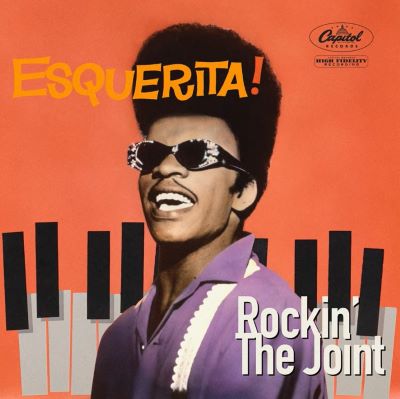
Esquerita — an innovative, self-taught pianist and performer whose influence on rock ‘n’ roll started with the birth of the genre in the early 1950s — dies of AIDS-related illness at a hospital in Harlem, New York. He was 50 years old.
Learn More.“Without Esquerita, there might have been no Little Richard, hence no Prince and no Elton John — and no rock ‘n’ roll as we know it,” music reporter Alan Richard wrote in Country Queer. “Little Richard himself credited Esquerita with showing him how to pound the piano with intensity and soul.”
Born in 1935 in Greenville, South Carolina, he was known locally as Eskew Reeder (or “SQ,” for Stephen Quincy) and was just a teenager when he joined the New York-based gospel group Heavenly Echoes.
Early on, he adopted an unconventional style, sporting a six-inch pompadour and makeup — which was quite shocking during the predominantly conservative culture of the 1950s, music reporter Iaian Ellis wrote in Rebels Wit Attitude: Subversive Rock Humorists.
When the Heavenly Echoes disbanded in the early ’50s, he returned to Greenville and created an act under the name “Professor Eskew Reeder.” The Owl Club on Washington Street booked him as the house performer, according to Ellis.
Esquerita also began performing on the “Chitlin’ Circuit” in the Deep South, where audiences embraced his unconventional appearance and performance style. Encouraged by the responses he received from Black audiences across the South, Esquerita became even more manic as he performed and often added a wig or two atop his already towering pompadour. His stage costumes typically incorporated sequins, rhinestones, and capes.
It was around this time when Little Richard (also known as Richard Penniman) saw him perform and expressed admiration for Esquerita’s technique on the piano, Ellis writes. Esquerita responded by teaching Little Richard some of his technique.
While Esquerita was performing live to Black audiences and honing his act to exquisite imperfection, Little Richard was already recording songs as a solo vocalist and piano player. But after seeing Esquerita perform, he decided to move away from the soothing jump-blues style of Roy Brown and tap instead into the fast rock ‘n’ roll rhythm that he experienced in Esquerita’s performances.
After “Tutti Frutti” became a big rock ‘n’ roll hit in 1955, Little Richard released a series of records in the same style and quickly became a nationwide sensation. The popularity of his music crossed the racial divide, and he was soon performing on television shows and in some of the earliest rock movies, such as Don’t Knock the Rock and The Girl Can’t Help It.
“I think Little Richard copied off [Esquerita] a lot, but Little Richard got to the studio first,” Lightin’ Lee, a New Orleans guitar player who knew both men, told Baynard Woods for his article “Esquerita and the Voola.”
But in 1957, Little Richard surprised everyone by announcing he was retiring from rock ‘n’ roll to get closer to God, and he enrolled in a theological college in Alabama. According to Baynard, Little Richard made this decision public at the last concert of his tour, saying, “If you want to live with the Lord, you can’t rock ‘n’ roll, too. God doesn’t like it.”
This opened the door for Esquerita to record his own songs.
While performing at the Owl Club in 1958, Esquerita caught the attention of rockabilly pioneer Paul Peek, who had just performed with Gene Vincent and the Bluecaps in the musical-comedy film The Girl Can’t Help It. Peek helped Esquerita get studio time at a Greenville radio station, and sent the resulting demos to bandleader Vincent. Seen as “the next Little Richard,” Esquerita was signed to a record deal with Capitol Records, thanks to help from Vincent.
The same year, Capitol started releasing a series of singles featuring Esquerita, first with the rockin’ “Oh Baby” and, on the B side, the slower-moving, bluesy “Please Come Home.” This was followed quickly by the release of the single “Rockin’ The Joint“/”Esquerita And The Voola.”
“With its thundering piano and obligato holler, ‘Esquerita and the Voola’ could be read as a response to Little Richard’s conversion,” writes Woods in his tribute to Esquerita. “Just as Richard gave himself to the Lord, Esquerita had dedicated his life to the Voola.”
Woods calls “Esquerita and the Voola” the artist’s “most dissonant song,” and it is fair to say that even the cutting-edge rock ‘n’ rollers of 1958 weren’t prepared for something like this.
“[The song] begins with a rolling rhumba drumbeat and then takes off into a piano rumble that swerves between the almost-off-the-rails high-note plinking of Thelonious Monk and the raucous bass thudding of Fats Domino,” Woods writes. “The piano is enough to make ‘Esquerita and the Voola’ one of the most experimental of the early rock singles, but then the wordless vocals come in and things really get weird, as Esquerita executes the kind of operatic howls that others call rock shouting and he called obligato.”
Fans of rock ‘n’ roll would find similarities between Esquerita and Little Richard — like the driving energy, the high-pitched “who-o-o-o-o-o’s!”, and the rollicking style of the piano playing — but there were obvious differences as well. Esquerita’s singing voice was deeper and rougher than Little Richard’s, and his handing of the piano was wilder.
“One could perhaps say that Little Richard’s voice had more of a gospel sheen to it, whereas Esquerita’s is far more dirty blues,” states George Starostin on his music review website . “As for the piano-playing, here, too, Esquerita shows far less discipline and far more aggression, not really minding getting off tempo every now and then, as long as the spirit stays strong inside him.”
Capitol would release Esquerita’s eponymous album in 1959, but it would not include “Esquerita and the Voola” on the LP. Unfortunately, the record did not do well, and Capitol dropped Esquerita from its roster.
From that point on, Esquerita drifted around the fringes of the musical world, performing under various names, such as the Magnificent Malochi, Estrelita, Eskew Reeder, and The Voola, writes Woods in his tribute to Esquerita.
In Dallas, he assembled a band and recorded a series of demos. Then he moved to New Orleans and became a house musician at the Dew Drop Inn, performing with many of the city’s best musicians.
In the 1960s, legendary record producer Berry Gordy brought Esquerita to Detroit as part of an ensemble exploring new Motown sounds.
“That’s when the Gordy sound changed,” Esquerita said later. “We just started jammin’, payin’ no mind, carryin’ on, and Berry taped us right there in Hitsville, USA.”
Even though Motown updated its sound to a harder-charging R&B beat after hearing the crew from New Orleans, it didn’t result in a recording deal for Esquerita. By the late ’60s, he had moved to New York, where he worked with the great drummer Idris Muhammad for a while.
In 1970, Little Richard launched a comeback and invited Esquerita to the studio to play piano on “Dew Drop Inn,” a song Esquerita wrote about the New Orleans club. For the LP (The Rill Thing), Little Richard recorded a second Esquerita number called “Freedom Blues.”
But after that, work dried up for Esquerita, and he reportedly turned to criminal activity to make ends meet, resulting in prison time in Puerto Rico and New York City.
In 1981, he was booked to perform on Monday nights at a tiny club on West 17th Street called Tramps. Music writer James Marshall said he saw the small Village Voice ad for “Every Monday: Esquerita!” and couldn’t believe the rock ‘n’ roll legend was still performing.
“We headed for Tramps, and there he was: the legend, the man — Esquerita himself!” Marshall wrote on his website, The Hound Blog. “His hair was short, and he looked like he’d ridden some hard miles, but it was he, the guy who made those insane records way back when.”
Marshall and his friends Billy Miller and Miriam Linna, publishers of Kicks magazine, began to attend Esquerita’s shows regularly. They put Esquerita on the cover of an issue of Kicks, and soon others were coming to Tramps on Monday nights.
Being friends with Esquerita was a mixed bag, Marshall recalled. Sometimes, he would show up at a party and treat everyone to a private recital, “rocking through versions of ‘Slow Down’ and ‘Dizzy Miss Lizzie.'” But at other times, write Marshall, Esquerita would appear in the middle of the night, pounding on windows and asking for money.
In the early 1980s, crack was cheap and plentiful in New York City, and Marshall watched his friend succumb to the effects of this dangerous drug. According to Pierre Monnery, who wrote “The Magnificent Malochi: The Esquerita Story,” Esquerita was diagnosed as HIV positive in 1985.
“He died of complications arising from AIDS in a Harlem Hospital on 23rd October, 1986, aged just fifty,” Monnery wrote. “Shamefully, he was buried in an unmarked grave in New York’s ‘Potters Field’ on Hart Island in northeast Bronx, where he rests today with other New Yorkers who could not afford a proper burial.”
In 1986, Little Richard was inducted into the Rock and Roll Hall of Fame. Esquerita was buried in an unmarked grave the same year.
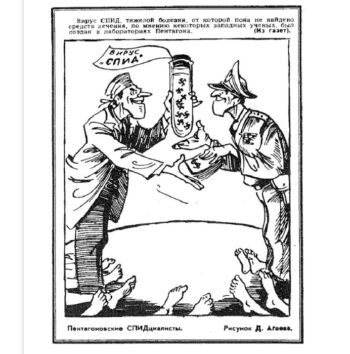
Soviet newspaper Pravda publishes a cartoon depicting the false idea that AIDS was the work of American biological warfare researchers.
Learn More.The cartoon is part of a massive disinformation campaign as part of the Soviet Union’s Cold War strategy against the United States.
“Of all the many disinformation campaigns inaugurated during the Cold War, most but not all by the USSR, arguably the most infamous was the effort by the KGB and its allies to convince the world that AIDS was created in an alleged secret US biowarfare lab at Ft. Detrick, MD,” wrote David Durant, librarian for East Carolina University’s Cold War & Internal Security Collection.
A collaboration of the KGB, their counterparts in the East German Stasi, and other Warsaw Pact secret services, the campaign began in 1983, intensified in 1985, and then wound down in late 1987.
“Despite being refuted by all credible medical experts, the AIDS as bioweapon theory has lingered on, serving as a sort of gateway drug to other conspiracy theories, and paving the way for later falsehoods regarding diseases such as Ebola virus and COVID-19,” Durant wrote in 2023.
Marcelino Sánchez, best known for his starring role as Rembrandt in the 1979 cult classic The Warriors, dies of AIDS-related illness in his Hollywood home at the age of 28.
Learn More.Born in Puerto Rico, Sánchez began acting in the late 1970s, according to the Los Angeles Blade. He played Ricardo on The Bloodhound Gang mystery vignettes featured on the 1980s children’s educational television show 3-2-1 Contact. He also appeared in TV shows CHiPs, Hill Street Blues and the film 48 Hrs.
In an interview with Noblemania.com, Bloodhound Gang co-star Nan-Lynn Nelson recalled:
“Marcelino had actually contacted me months prior to his passing to let me know that he was sick. We met and spent an entire day together while he was here in NYC, basically to say good-bye. I still think of Marcelino often.”
In 1986, Sánchez’s health would decline quickly. His sister and brother would come to Los Angeles to take care of him until his death just two weeks shy of his 28th birthday, according to the tribute to him on Gran Varones, a website dedicated to pop culture, queer history & storytelling through a Afro-Latinx Queer lens.
LGBT leaders sound the alarm against the increase in violence targeted toward members of the community.
Learn More.In a New York Times article reporting on the three-year increase in anti-gay violence, LGBT organization leaders cite studies and provide anecdotes that reflect the disturbing trend, linking it to the spread of HIV/AIDS.
The article largely re-caps the House Judiciary Subcommittee on Criminal Justice hearing on anti-gay violence held more than a month before.
Also included in the article, written by William R. Greer, is the account of a Brooklyn man who was attacked outside his home on a Saturday morning. The man, who is identified as an employee in the Office of Mayor Ed Koch, said three assailants struck him repeatedly while yelling homophobic slurs at him and accusing him of spreading AIDS.
”What I find frightening is these groups don’t seem to have any fear of verbally or physically assaulting people in the middle of the day, in a shopping center, in front of businesses, with hundreds of people around,” he told the NYT reporter. ”Somehow they’ve gotten the message that their action will be condoned or at least ignored.”
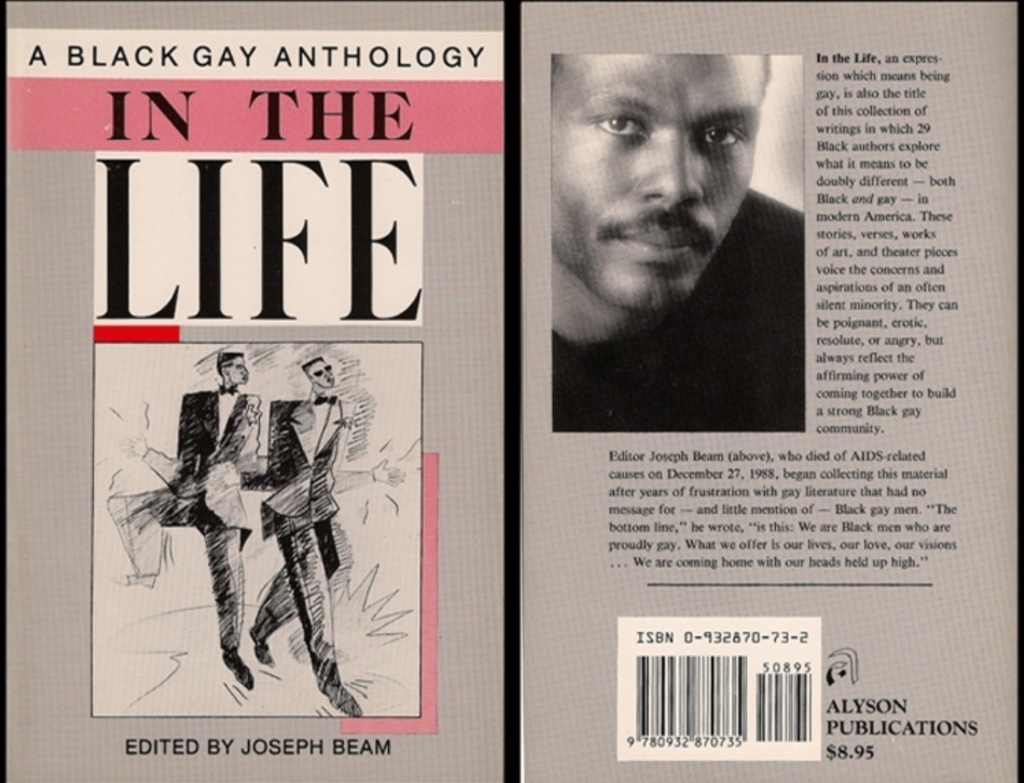
In the Life: A Black Gay Anthology, curated by Joseph Beam to explore the experiences of gay Black men, hits bookshelves.
Learn More.Although sales for the book were initially small, word of mouth would cause In the Life to be widely read and celebrated as the first collection of writings about being gay in the age of AIDS. Written by 29 Black, gay authors and edited by Beam, In the Life included stories, verses, works of art, and theater pieces, all voicing the point of view of “an often silent minority.”
Beam began collecting this material in 1984 after years of frustration with gay literature that overlooked the experience of Black gay men.
“The bottom line is this,” Beam wrote, “We are Black men who are proudly gay. What we offer is our lives, our love, our visions… We are coming home with our heads held up high.”
A showcase for new literary talent, a source of inspiration for its readers, and a literary and cultural milestone for the gay community, In the Life advanced the visibility of gay Black men in a lasting way.
“For the first time,” wrote James Charles Roberts, a contributor, “Black gay men got to tell about their lives and experiences in their own words.”
Charles Stephens, co-editor of Black Gay Genius: Answering Joseph Beam’s Call, recalled coming across In the Life at a pivotal moment.
“I lacked the language to describe what I was longing for, and perhaps in a sense Beam, and his stunning vision of community, provided that language for me,” said Stephens in an interview for Lambda Literary. “I absorbed his words, and found a home in them. In the Life became a compass for me, to first locate myself, and then others that shared my commitments.”
Beam would die of AIDS-related illness in December 1988, three days before his 34th birthday. His unfinished manuscript for a second anthology would be completed by his friend Essex Hemphill and published in 1991 as Brother to Brother: New Writing by Black Gay Men.
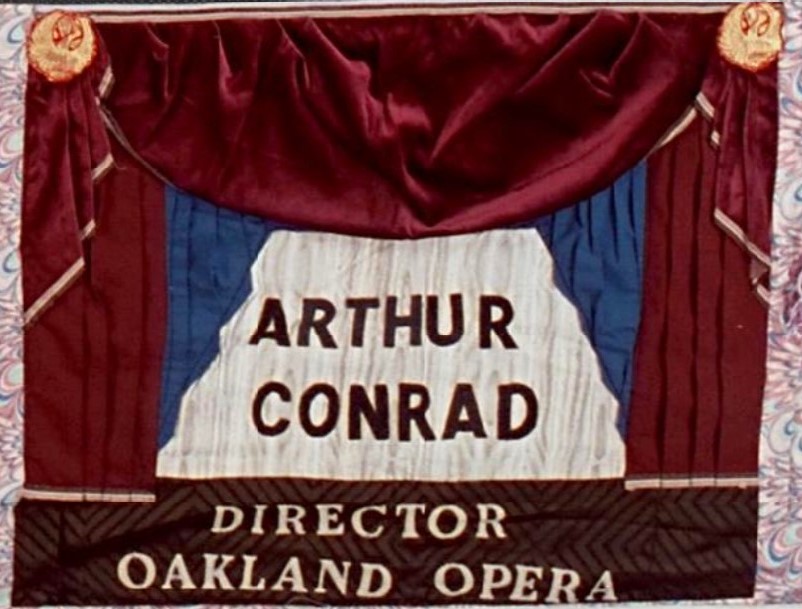
Arthur Conrad — director of more than 200 productions for the Marin Opera, West Bay Opera, Oakland Opera, Sacramento Opera and the Lamplighters — dies of AIDS-related illness in San Francisco at the age of 51.
Learn More.Conrad began his career as a dancer, performing in the role of “Mother Marshmallow” in the Oakland Ballet’s Nutcracker for several years. He began to choreograph Bay Area productions, and ultimately began directing.
HIV/AIDS services advocate Bev Sykes wrote in her blog Funny The World about how in the summer of 1986 she was Conrad’s assistant as he directed a production of The Mikado for the Oakland ballet.
“He had a ‘cold’ during the rehearsal period and complained that he couldn’t shake it,” she recalled.
The show ran throughout the month of August and, at its conclusion, Conrad promised Sykes that he would take her to lunch to thank her for all her help. She never heard from him again.
In November, she found out that Conrad was hospitalized with pneumocystis pneumonia. He died shortly afterward.
“Until that time, AIDS had been something that happened to someone else,” she wrote.
* * * * * * * *
Photo of quilt panel from the AIDS Memorial Quilt

Martin Burgoyne, a designer whose close friendship with Madonna would later inspire the lyrics of one of her songs, dies of AIDS-related illness in New York City. He was 23.
Learn More.“Sitting on a park bench thinking about a friend of mine,” Madonna sings on the track for “In This Life” on her 1992 album Erotica. “He was only 23, gone before he had his time.”
Martin Burgoyne was born in England in 1963 and moved with his family to Florida as a young child. After graduating from high school, he moved to New York City as a teenager to study art at the Pratt Institute. To pay the rent, he worked at Studio 54 as a bartender and soon became an insider on the Manhattan nightclub scene.
When Madonna arrived in New York in the late 1970s, she met Burgoyne and they became fast friends. Soon they moved in together in an apartment on NYC’s Lower East Side. They became regulars in the downtown clubs and performance spaces, and with his nightlife connections, Burgoyne was able to usher Madonna into the spotlight that she craved.
“He knew everyone in New York and showed her around all the clubs, introduced her to Andy Warhol, whisked her through the side doors,” wrote music industry executive Seymour Stein (1942-2023) in his memoir Siren Song: My Life in Music. In 1982, Stein signed Madonna to Sire Records, and became acquainted with Burgoyne as a member of Madonna’s inner circle.
Stein credited Burgoyne with putting Madonna in the right places at the right time. Burgoyne was also her sounding board for new songs and style choices.
“She worked out all her early songs, outfits, and moves with Martin giving her his honest feedback,” Stein wrote.
Burgoyne designed a cover for Madonna’s first album, but Sire Records went with a different design. His second attempt at designing for Madonna was more successful; he created silkscreens that were used for the cover of her single “Burning Up.”
Burgoyne was one of Madonna’s dancers for live performances, but following the massive response to Sire’s release of the single “Everybody,” Burgoyne and other amateur dancers in Madonna’s show were replaced by professionals, according to Andrew Morton in his 2001 biography, Madonna.
One of those dancers, Jordan Levin, recalled Burgoyne inviting her to dance in Madonna’s first video in 1982.
“I was on the street one night when I heard someone yelling ‘Jordan!’ and turned to see Martin running up behind me,” Levin wrote in an article for the Miami Herald.
Burgoyne told her that Madonna was going to make a video for “Everybody,” and she wanted Levin to dance in it. Of course, she accepted the invitation.
Meanwhile, Burgoyne became the road manager for Madonna’s performances at Danceteria, CBGB and Mudd Club in 1982 and 1983, shows which allowed Madonna to hone her act in time for her national debut on the 1984 MTV Video Music Awards.
Soon, Sire Records took over every aspect of her record and tour production, and Burgoyne no longer had an official role in the commercial industry that had sprung up around Madonna. However, the two remained close friends, according to David Blaine in his 2014 interview with Madonna for Interview magazine.
In the summer of 1986, Burgoyne was diagnosed with AIDS-related complex (ARC), an early medical term to describe the multi-symptom condition of AIDS. Burgoyne’s friends organized a fundraising party at the Pyramid Club, which was held in early September 1986, and raised $6,000 for Burgoyne’s living expenses, according to The New York Times. Andy Warhol and Keith Haring designed the invitation, and more than 500 people showed up, including Wendy Wild, Lady Bunny, John Sex, Kenny Scharf, Anita Sarko, Steve Rubell and, of course, Madonna.
According to Christopher Ciccone, Madonna’s brother, the rising star paid for Burgoyne’s medical expenses at St. Vincent’s Hospital, and she also leased an apartment for him close to the hospital in the West Village.
Former dancer Jordan Levin said she visited Burgoyne at his apartment, recalling that he was “frantic” because The New York Post ran a story under the headline “Madonna’s Former Roommate has AIDS — Sean is Furious!”
Burgoyne told her that he saw Madonna and Sean Penn in the last week, and Penn had hugged him.
“Sean isn’t angry at me … How can they do this?” she recalled Burgoyne saying.
Still, he found the energy and motivation to paint a denim jacket that would be auctioned off at an AIDS benefit fashion show for St. Vincent’s. Madonna modeled the jacket at the event, which was held on November 10, 1986.
Twenty days later, Burgoyne died with Madonna at his side.
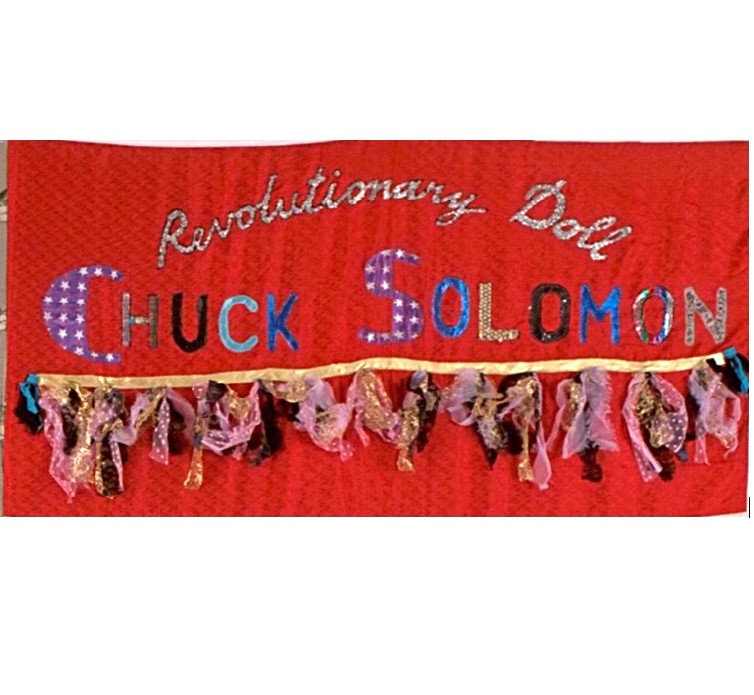
Founder of the Gay Men’s Theater Collective and co-creator of its pioneering production Crimes Against Nature, Chuck Solomon dies of AID-related illness at the age of 40.
Learn More.As an actor and director, Solomon worked with several local companies, including the San Francisco Mime Troupe and Theatre Rhinoceros.
He is immortalized in Marc Huestis’ 1987 documentary “Chuck Solomon: Coming of Age,” which received the Silver Hugo Award at the Chicago International Film Festival. In the film, Solomon is celebrated by members of his family and about 350 friends on his 40th birthday.
* * * * * * * *
Photo of quilt panel from the AIDS Memorial Quilt

Emmy-Award winning pianist and mainstay of the Las Vegas entertainment scene Liberace dies at his Palm Springs, California home at the age of 67.
Learn More.Liberace’s doctor claims that the man called “Mr. Showmanship” died of a heart attack caused by an underlying brain infection. But an autopsy by the county coroner reveals that Liberace died of AIDS-related illness.
Just weeks before his death, Liberace was treated at Eisenhower Medical Center for what his staff called “the effects of a watermelon diet.” Hundreds of friends and tourists kept vigil outside of his Palm Springs home as rumors of his real illness became rampant.
When death seemed imminent, his attorney would tell reporters that Liberace chose his Palm Springs home to die because, “I think he wanted to rest in the place he loves. He’s always thinking about his fans. He wants to be remembered as he was — an entertainer. I think it’s nice that fans are here and supporting him.”
The news of Liberace’s death demonstrated the powerful stigma of AIDS and led to a national discussion about the rights of people living with AIDS to privacy, both before and after death.
* * * * * * * *
Photo of quilt panel from the AIDS Memorial Quilt

Neal Lo Monaco, the principal cellist of the Sacramento Symphony, dies of AIDS-related illness at the age of 41.
Learn More.Lo Monaco was also a member of the Sacramento String Quartet.
* * * * * * * *
Photo of quilt panel from the AIDS Memorial Quilt
Jay Phillips, a promising artist whose abstract sculptures won him a select but distinctive following in Los Angeles and New York, died of AIDS-related illness in New York City. He was 32.
Learn More.Seduced by southern California’s saturated colors and New York City’s vibrant architecture, Phillips incorporated the world around him in his work. Melding painting and sculpture, his works typically featured brightly colored enamel on metal that was cut, folded and otherwise manipulated. His use of color-drenched patterns referenced his early exposure to commercial fabric patterning.
Suzanne Muchnic, art critic for the Los Angeles Times, credited Phillips with a “swift, sure sense of arrangement that allows him to join bold checkerboards, bright stripes, lattices and circle patterns with painterly gestures evocative of landscape.”
A recipient of the Los Angeles County Museum’s 1981 Young Talent Award, Phillips exhibited his work at LACMA in November 1985 – February 1986.
“There is in his work a greater insistence on structure and manipulation of the composition,” wrote Stephanie Barron, LACMA’s curator of 20th Century art. “Yet, ever the romantic, Phillips continues to search for ways to interpret his surroundings.”
Phillips often worked with aluminum, cutting wavy edges along the side of his pieces and folding them back. This technique “had the effect of playing off a sense of depth against perceptual pulls of shape and color,” according to Burt A. Folkart of the LA Times.
He also briefly worked with paper, creating a series of silk-screened prints named for the Los Angeles locations of Hancock Park, Melrose, Hollywood and Bel-Air Gate.
“Although the material involved was atypical of Phillips’ work, the colors and wide stripes and thick brush strokes were not,” Folkart wrote.
Phillips earned his bachelor of fine arts degree from the University of New Mexico and his master’s degree from Claremont Graduate School in 1979. In Los Angeles, his work was also shown at the Newspace and Roy Boyd galleries.

Antonio Lopez, whose drawings appeared in Vogue, Harper’s Bazaar, Elle, and Interview, dies of AIDS-related illness at the UCLA Medical Center at the age of 44.
Learn More.Based in New York, Lopez had come to Los Angeles for a showing of his drawings at the Robert Berman Gallery in Santa Monica when he became ill and was hospitalized, according to fashion model Susan Baraz.
Lopez is credited with launching the careers of Jessica Lange, Jerry Hall, Tina Chow and Grace Jones, and he also was the first artist to use black models in his work, which was seen in the top fashion magazines in the mid-1960s.
He also was credited with being the first artist to draw not only the inanimate creations of the haute couture but to idealize the models behind them.
His family migrated to New York City when Lopez was seven and he attended P.S. 77 on East 104th Street. To keep her son preoccupied and away from street violence, Lopez’s mother, a seamstress, would ask him to draw flowers for her embroideries, according to the tribute to Lopez on the Visual AIDS website.
While a student at the Fashion Institute of Technology, he received a work-study assignment at Women’s Wear Daily, where his talent was immediately recognized. WWD put him on staff and he left FIT.
At the time of his death, Lopez had been in California for an exhibition of his fashion drawings and personality portraits at the Robert Berman Gallery in Santa Monica. An exhibition of his drawings was also taking place in Munich, West Germany.
Lopez’ creative partner, Juan Eugene Ramos, would die of AIDS-related illness eight years later, on Nov. 3, 1995, at the age of 53.
In 2016, a retrospective of Lopez’ and Ramos’ work was exhibited at El Museo del Barrio in New York. The exhibit, “Antonio Lopez: Future Funk Fashion,” was curated to evoke serious discourse on gender, sexuality, race, and heritage, and simultaneously invited viewers to revel in Lopez’ and Ramos’ legacy.
* * * * * * * *
Photo of quilt panel from the AIDS Memorial Quilt

Fashion star Willi Smith dies in New York at the age of 39.
Smith was apparently unaware that he had contracted the virus and had shown no symptoms.
Learn More.Thinking he was suffering from an attack of shigella, a form of dysentery, acquired on a textile-buying trip to India, Smith admitted himself to the hospital, where tests showed he was HIV positive.
At the time of his death, Smith was regarded as one of the most successful African-American designers in the fashion industry. His company, WilliWear Limited, launched in 1976 and by 1986 was grossing over $25 million in sales.
“Smith was, in the truest sense of the word, a streetwear designer, long before anyone used the term,” writes Jenny Comita in W magazine. “Even as he was collaborating with some of the most avant-garde artists of the day and staging fashion shows that doubled as performances, he was taking his cues as a designer from the women he saw on the sidewalks of midtown.”
Smith was born in Philadelphia, the son of an ironworker and a homemaker. He studied drawing at Mastbaum technical school and, later, fashion illustration at the Philadelphia Museum College of Art.
His big break came through his grandmother Gladys, who worked as a housekeeper. One of her clients had a connection to the famed couturier Arnold Scaasi and secured an internship for Willi.
Smith’s first major role, in 1969, was as head designer of the sportswear label Digits, where he quickly made a name for himself with bright, bold prints; flowy high-waisted pants; and an ahead-of-its-time marketing campaign featuring women on the gritty streets of New York. Two years later, he became the youngest designer to be nominated for a Coty Award, then the fashion equivalent of an Oscar.
In 1976, he and his former assistant Laurie Mallet founded WilliWear; she handled the business side and he the design. WilliWear’s affordable, wearable clothes were picked up by Macy’s, Bloomingdale’s and eventually hundreds of stores.
Smith designed the costumes for “Secret Pastures,” a 1984 work by dance pioneers Bill T. Jones/Arnie Zane; Keith Haring created the sets. Smith also contributed to Spike Lee’s 1988 musical comedy-drama School Daze, making the gowns for the homecoming court.
Many of his friends wonder what would have happened if Smith had lived.
“We’ve been told that he wanted to move to India permanently, a place he visited constantly. He might have gone to Hollywood to produce films full-time after making a short film called Expedition.”
Smith’s legacy is the streetwear that lives on in menswear season after season.
* * * * * * * *
Photo of quilt panel from the AIDS Memorial Quilt

Princess Diana makes international headlines when she is photographed shaking the hand of an HIV-positive patient in a London hospital. She goes on to become a passionate advocate for people living with HIV/AIDS.
Learn More.The 26-year-old Princess of Wales reportedly was living with the specter of AIDS every day. In the loneliness of her failing marriage to Prince Charles, gay men arere the bedrock of her private world: fashion designers, ballet dancers, art dealers and numerous members of the palace staff. They sympathize with her, escort her, lighten her load. It pains her to watch them sicken and die.
When London’s Middlesex Hospital invited Princess Diana to open the Broderip Ward, the U.K.’s first dedicated ward for AIDS and HIV-related diseases, she agrees to do it. She is intensely nervous, but she knows it is the chance to dispel the stigma surrounding the disease.
“With her instinctive understanding of the power of gesture, she resolved not only to open the new ward but to shake the hands of 12 male patients without gloves,” writes Tina Brown, author of The Diana Chronicles.
In a time when fear and misinformation runs rampant surrounding the transmission of a disease widely associated with gay men, the simple act of shaking an ill patient’s hand was a headline-making moment that helped educate the public.
Throughout the 1980s and 1990s, Princess Diana would go on to use her platform to bust myths about how HIV/AIDS could be contracted, and spends time with people affected by the virus around the world.
She would become an official patron for the National AIDs Trust, and spoke of the impact on mothers and children, further dispelling the myth that it was purely a problem for the gay community.
Even after her death, her legacy continues with her sons, who would continue to help fight the stigma surrounding HIV/AIDs. Prince Harry would take an HIV test on live TV to show how easy it is, and Prince William would appear on the cover of Attitude Magazine to discuss the mental health issues faced by victims of homophobia and transphobia.

Jack Romann, director of the concert and artist department of the Baldwin Piano Company, dies of AIDS-related illness at Cabrini Medical Center in New York City. He was 59
Learn More.Romann’s stature among the top pianists in the U.S. warranted him coverage in The New York Times when he died, and years later would inspire composer John Corigliano to write symphonic pieces.
”Almost every talented pianist in America now has had an important slice of his life removed,” Charles Wadsworth, a pianist and the artistic director of the Chamber Music Society of Lincoln Center, told the NY Times. “When I played at the White House for President Kennedy, Jack came along to give me support and he turned pages for me. Then, on his own, he wrote a press release and sent it to the paper of my Georgia hometown. All of a sudden, I was somebody important there.’
Although Romann was a Juilliard-trained pianist, he never gave public performances and instead supported pianists who were performing for wide audiences.
”I cannot begin to tell you how important he was to me and almost any pianist I know,” pianist Santiago Rodriguez told the NY Times. ”He gave me tons of advice … I never met a man so ready to give.”
Another person who Romann left with a lasting impact was composer John Corigliano, who on March 15, 1990 would premiere his masterwork Symphony No. 1, the first major musical memorial to those who had died of AIDS.
Alex Ross, music critic of The New Yorker, wrote that Symphony No. 1 “was and it remains the most formidable classical work written in response to the epidemic.”
For the symphony’s second movement, which Ross called “the dark heart of the symphony,” Corigliano drew on his memory of Romann and his AIDS dementia.
According to music critic Steve Smith, Corigliano “recasts” the original intention of the tarantella (a cure for spider-bite delirium) as “an analogue for AIDS dementia,” having a contrabassoon take a gloomy melody and then repeating it with the contrabass clarinet, tuba and ultimately trombone.
* * * * * * * *
Photo of quilt panel from the AIDS Memorial Quilt

Robert M. Jacobson, editor of Opera News magazine, dies of AIDS-related illness at St. Vincent’s Hospital in New York. He was 46.
Learn More.Jacobson, who began as a critic for Musical America in 1963, was a prominent advocate of opera and the arts. His partner, Rocci Genova, told The New York Times that Jacobson also wrote for numerous publications, edited the program booklets for Lincoln Center in New York City, and annotated programs for CBS Records.
In 1974 he became editor of Opera News, and also edited its sister publication, Ballet News, from 1979 until it was discontinued in 1986.
In “AIDS and the Arts: Behind the Scenes of a Tragedy,” a December 1990 article by Sean Mitchell for the Los Angeles Times, Jacobson’s name would appear alongside seventeen other prominent people in the arts who died of AIDS.
“A disproportionate number of AIDS victims, it turned out, were poor and anonymous, but there were also a lot who acted, painted, sang, danced and in one way or another contributed to the public creative life of the nation,” wrote Mitchell.
* * * * * * * *
Photo of quilt panel from the AIDS Memorial Quilt
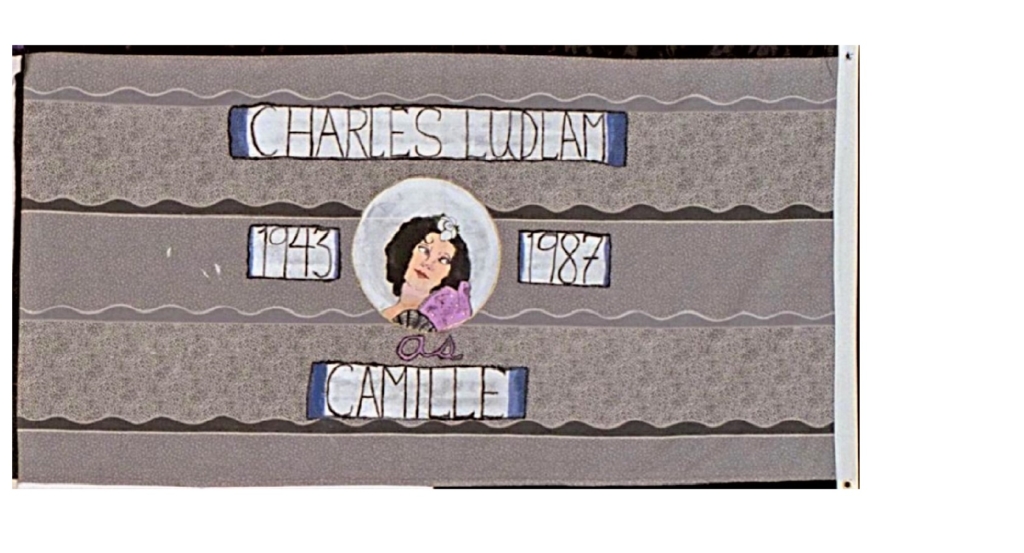
Charles Ludlam, whose Ridiculous Theatrical Company had become one of New York City’s more popular attractions, dies in St. Vincent’s Hospital of AIDS-related illness at the age of 44.
Learn More.An actor, writer and director, Ludlam was one of the more prolific artists on the off-Broadway scene. His productions in a small basement theater Greenwich Village included such parodies as Bluebeard, Galas (a spoof on operatic diva Maria Callas) and Reverse Psychology.
Jeremy Gerard of The New York Times memorialized Ludlam, calling him was one of the most prolific and flamboyant artists in the theater avant-garde.
“He was a master of travesty, creating in a tiny grotto theater on Sheridan Square critically and popularly acclaimed parodies of such familiar genres as the dime novel (The Mystery of Irma Vep), film noir (The Artificial Jungle) and opera (Camille, Der Ring Gott Farblonjet),” Gerard wrote.
Ludlam’s productions received a Drama Desk award and six Obie awards. The Ridiculous Theatrical Company has toured extensively in the United States and Europe.
Recently, he was retained by producer Joseph Papp to direct the production of Shakespeare’s Titus Andronicus for the New York Shakespeare Festival in Central Park. However, the play was postponed when Ludlam was admitted to the hospital on April 30.
”We lost an extraordinary artist who was just on his way to a tremendous breakthrough in theater and opera,” Mr. Papp said of Ludlam’s untimely death.
At a July 13 memorial event for Ludlam, about 1,000 people crowded the Second Avenue Theater to pay tribute to the king — and sometimes queen — of downtown theater and celebrate his work.
The most moving remembrance was offered by Everett Quinton, Ludlam’s longtime partner and his successor as artistic director of the company.
”I’ve never felt so alone in my life, but it’s going to be all right,” Quinton said. ”We’re going to continue to do wild theater and wonderful theater.”
* * * * * * * *
Photo of quilt panel from the AIDS Memorial Quilt
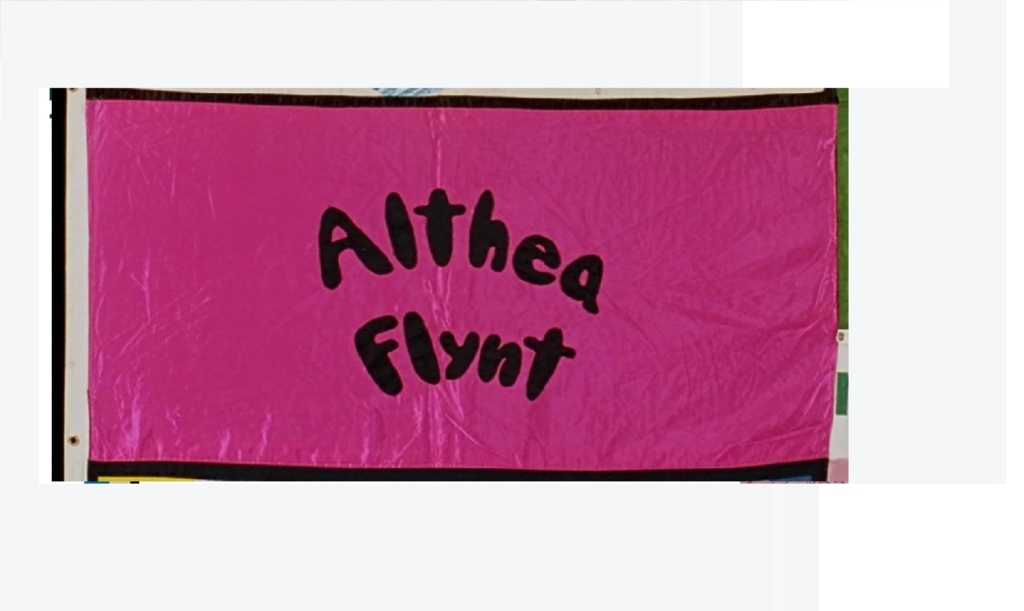
Wife of Larry Flynt and publisher of Hustler magazine, Althea Flynt drowns in a bathtub in her Bel-Air mansion in Los Angeles at the age of 33. Her husband says she was diagnosed with AIDS four years ago and likely fell asleep while bathing.
Learn More.Althea is Larry Flynt’s fourth wife, and because she married him in 1976, she is the only partner who joins him in his rise to celebrity. She would meet Flynt in Ohio, while working in one of his clubs as a go-go dancer.
Born in poverty in a Kentucky mining town, Althea Flynt was orphaned at eight years old, when her father murdered her mother and her grandfather and her mother’s best friend, and then killed himself. Flynt recounted her childhood ordeal in a 1978 interview with New York magazine:
“They put you in a bare room with dirty floors and a single mattress that was stained and filthy and stank,” she said. “I still remember the smell. They put a pot and a roll of toilet paper in the room. Then they locked you in.”
In the late 1960s, she and Larry Flynt started a relationship that would last until the rest of her life. As partner in her husband’s publishing business, she would be known to come to work in outrageous attire, including in leather dog collars and bangled chains that ran from her ear to her nostril.
As documented on video from Flynt’s library, Althea’s style was complex and highly unusual, particularly once she came into money and moved to Los Angeles. Her attraction to drug culture, Sunset Strip clubs and punk rock led her to patronize Hollywood shops like North Beach Leather and Trashy Lingerie.
In March 1978, her husband would be shot by a religious extremist, leaving him paralyzed and in pain, and she would remain with him, for better and for worse.
In a 1983 magazine article by the Washington writer Rudy Maxa, the Flynts would descibe how Larry tried to manage the pain with methadone, marijuana, cocaine, sleeping pills, morphine, and Dilaudid. Althea would experiment with drugs with her husband, and soon both would become addicted to narcotics.
She would be diagnosed with HIV in 1983, reportedly from a blood transfusion while undergoing a hysterectomy. Larry Flynt explained that Althea “always used clean needles when using drugs.”
The cause of Althea’s death is a perscription drug overdose-induced drowning, according to the coronor’s report. Her husband, however, states that she was in the advanced stages of AIDS and would have died within that year, regardless.
Flynt’s body is buried in Saylersville, Ky., where her husband keeps a family burial plot.
In 1997, Althea would be portrayed by singer-actress Courtney Love in The People vs. Larry Flynt; Love’s performance with garner her a Golden Globe Award nomination.
* * * * * * * *
Photo of quilt panel from the AIDS Memorial Quilt
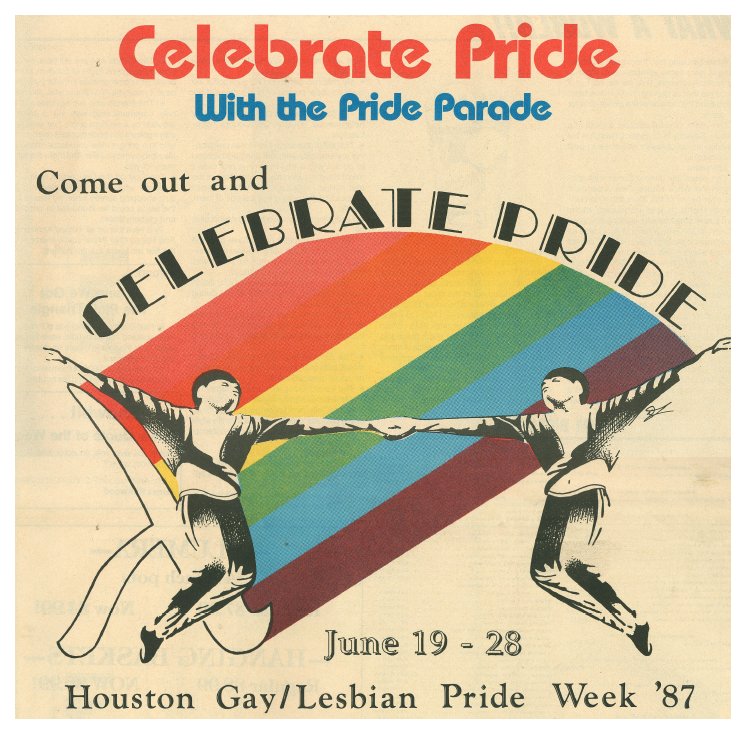
Houston Pride honors persons living with AIDS as the Grand Marshal for the Pride Parade.
Learn More.With the theme “Come Out and Celebrate Pride,” the parade organizers encouraged everyone to take to the streets during the event. Organizers also told community members to donate money to HIV/AIDS organizations rather to the making of parade floats, according to Hannah DeRousselle in Houston History magazine.
By then, the Pride Parade, which was founded in 1979, was drawing smaller crowds, reflecting the devastation of the community by the spread of HIV and the effects of a growing hostility toward gay people in general due to the AIDS Crisis.
Dancer Sean O’Neill, who performed with the Pacific Ballet and also edited the San Francisco Ballet program, dies of AIDS-related illness at the age of 29.

Dr. Tom Waddell, founder of the Gay Games, dies of AIDS-related illness in San Francisco at the age of 49.
Learn More.Waddell was a superior athlete, good enough to take sixth in the world in the decathlon in the 1968 Olympics in Mexico City, writes Mart Dobrow of ESPN. He was a paratrooper in the Army, and a doctor with a sense of adventure — working in Africa on patients with tropical diseases and becoming the physician for the Saudi Arabian Olympic team in 1976.
“To Waddell, the symbolism of the Games spoke to his highest ideals: the five interlocking rings, the parade of nations, the torch being lit,” writes Dobrow. “In some ways, this felt like sports at its most pure. It brought people of the world together.”
After his athletic career, Waddell would worked for years as a medical consultant for Whittaker Corp., enjoying the opulence of the Saudi royal family in Riyadh. When he wasn’t in the Middle East, he settled in San Francisco.
There, in the hub of American gay life, Waddell embraced the bacchanal fully, its drug use and promiscuity, before finding what he hoped was true and lasting love with Charles Deaton, a 50-year-old former CIA operative.
Then Waddell had a grand vision; it started out as the “Gay Olympic Games.” Waddell was aware that for many gay people, sports had meant a door slamming shut. His goal was to open the door of completitive sports wide open to the LGBTQ community.
He modeled the Gay Olympic Games after what he considered to be the true principles of the Olympics: equality, fairness, human dignity. Except that the U.S. Olympic Committee didn’t see it that way.
Just 19 days before the games were to begin, the USOC persuaded a federal court to issue an injunction prohibiting Waddell and his group, San Francisco Arts & Athletics, from using the word “Olympic” because of copyright infringement.
Waddell was incredulous and wounded to the core. He pointed out that in the past there had been no opposition to multiple other uses of the term (e.g., the Special Olympics).
With no legal recourse, Waddell and the SFAA scrambled to remove the offending word from a slew of merchandise and promotional material. The hastily rechristened “Gay Games” played out nevertheless in the summer of 1982 with some 1,300 athletes from 12 countries participating.
By the next summer, as Gay Games 2 came to a now-besieged San Francisco, Waddell knew his days were numbered. He checked himself out of the hospital, marched in the opening ceremonies, and delivered a stirring opening address as part of the Games, which attracted some 3,500 athletes from 17 countries.
In one final feat of athletic strength, Waddell managed to win the gold medal in the javelin. Within a year, he was gone.
Today, the Gay Games live on and are help in locations all around the world, including Amsterdam, Sydney, Paris and Hong Kong. Since 1986, The Federation of Gay Games Scholarship Fund has awarded more than 1,000 scholarships to underfunded LGBTQ+ individuals from 70 countries around the world, where the daily struggle for equality is harsh and often dangerous.
Tom Waddell’s core principles of Participation, Inclusion, and Personal Best continue to bring thousands of athletes together to compete.
Every four years in conjuntion with the Gay Games, the Tom Waddell Award is presented to a person or organization involved in the Gay Games that embodies the standards of commitment, selflessness, and love of humanity, and inspires pride through leadership and excellence in sports, culture, or volunteerism.
* * * * * * * *
Photo of quilt panel from the AIDS Memorial Quilt

Arthur J. Bressan Jr., best known for his devastating 1985 AIDS drama Buddies, dies of AIDS-related illness in New York City at the age of 44.
Learn More.A pioneer of independent gay cinema in the 1970s and ’80s, Bressan is best known for his 1985 drama Buddies, the first feature film about the AIDS pandemic. He also directed the largely influential Gay USA, the first documentary by and about LGBT people, and the feature film Abuse (1983).
“If you want to submit one director as the auteur for the post-Stonewall, pre-New Queer Cinema era of Gay Liberation, Arthur J. Bressan Jr. is that director,” writes film critic Caden Mark Gardner.
Bressan’s first credited film work is that of a documentary short called Coming Out, about the first official San Francisco Pride march in 1972. Shot in 16mm and in color, it offers a snapshot of many people who made the pilgrimage to San Francisco.
Bressan would expand this cinematic approach for his 1978 feature-length documentary, Gay USA, made during the National Gay Freedom marches across the country in 1977, the year Harvey Milk became America’s first openly gay elected official.
“Many of the interviewers and testimonies in Gay USA are not just talking about the pleasantness of seeing themselves and being out at this Pride parade, but are speaking with righteous indignation about homophobic violence and systemic homophobia,” Gardner writes.
Bressan’s 1983 film Abuse, a drama with an intensely provocative portrayal of child abuse, is hailed by film critic Rex Reed as “a film of astonishing power and emotional impact.”
“Artie loved butch men and women, drag queens, black, brown and white,” writes Emmy Award-winning director Greta Schiller. “Artie was exceptional in that he loved women. He had none of the misogyny that was (and still is) rampant in our culture, even in the LGBT community. He knew who and what he was, and he was not threatened by women.”
Schiller, who met Bressan in 1983 through activist Vito Russo at a screening of Abuse, said she went to the event “angry that it was a film about a man in authority sleeping with an abused teen.”
After watching the film, she emerged “with my mind blown by the complexity of what I’d seen.”
Russo convinced Schiller to share her reaction to Abuse with Bressan.
“I told him it was a brilliant film that made me realize not all older men who fall in love with a younger man are predators,” she recalled. “The story and acting made me think of Italian postwar neorealist films.”
Schiller says that when Bressan became sick, he was determined to complete Buddies.
“He cut the film on a flatbed in his tiny apartment. He poured his heart and soul into making one last film,” she writes. “I lived a few blocks away from him [in the Chelsea neighborhood of New York City], and I would come get him for a walk around the block. Soon, he could only make it to the corner of 18th Street and 8th Avenue, a block from his home. He would gaze at the high-school boys and talk about the ones he fancied, and how those who were gay would have a better, freer life.”
About 10 years after Bressan’s death, his sister Roe Bressan and LGBT film historian Jenni Olson would launch The Bressan Project to preserve and promote Bressan’s films.
* * * * * * * *
Photo of quilt panel from the AIDS Memorial Quilt
In a 16-page special section, the Los Angeles Times attempts to present the latest data reflecting the magnitude of the global AIDS epidemic.
Learn More.William F. Thomas, editor of The Times, was reportedly pleased with the section, titled “AIDS: A Global Assessment,” but commented: “Even after you read it, you’ve got your hands full of smoke … Everything is still so inconclusive. It’s hard to decide what to do (with AIDS) in the paper. All you can do is chase the bouncing ball.”
The Times estimated the number of people infected with the AIDS virus worldwide as somewhere between 5 million and 10 million.
The report provided the following estimates for “individuals considered AIDS virus carriers”:
United States 1-2 million
Brazil up to 238,000
France 175,000-200,000
Italy more than 100,000
Haiti 100,000
West Germany up to 100,000
Canada 50,000
England 30,000-50,000
Switzerland 20,000
Mexico 25,000-50,000
Netherlands 10,000-20,000
Denmark 10,000-15,000
Sweden 9,000-11,000
Belgium 5,000-10,000
Japan 2,500-10,000
Greece 5,000-7,000
Israel 1,000-2,000
About two months later, on October 13, 1987, The New York Times would publish editorial writer Phillip Boffey’s examination of the nation’s initial reponse to the AIDS crisis. He would dedicate much of his article to addressing the charges laid out by Randy Shilts, a reporter for the San Francisco Chronicle, in his just-released book And the Band Played On: People, Politics and the AIDS Epidemic.
As if to continue the conversation, Los Angeles Times reporter David Shaw would suggest in December 1987 that the press and other outlets of journalism played an outsized role in the failure of the U.S. to appropriately address the early AIDS crisis.
“Most critics say the biggest shortcoming of the press on the AIDS story, especially in the first few years, was not medical/scientific coverage but political coverage; the press didn’t aggressively pursue the public policy and funding aspects of the story,” Shaw writes.
He goes on to point out that during the early years, the press reported various Reagan Administration statements about AIDS largely without question or investigation. This included the administration’s statement that the nation’s blood supply was “100% safe” at a time when HIV-tainted blood was being circulated to hospitals and clinics in many cities.
The media also reported the administration’s promise to start trials of an AIDS vaccine within two years, but failed to hold it to account when the first clinical tests did not start for another three years. (Decades later, a successful vaccine still has not been developed.)
Shaw cites the San Francisco Chronicle as one of the very few papers to report on federal AIDS policy in the early years, largely due to the dedication of reporter Randy Shilts. Most major media outlets did not dedicate a full-time reporter to cover AIDS until about 1987.
The media “went to sleep on the story,” Shilts told Shaw. “I’m not God’s gift to journalism. I’m a good reporter, but I didn’t get [stories] because I’m a brilliant reporter. I just did … the work that any reporter could have done.”

The home of the Ray family is burned down a week after the Rays win a $1.1 million settlement and the legal right to enroll in the local elementary school their three HIV-positive boys.
Learn More.The Ray brothers — Ricky, Robert, and Randy — were hemophiliacs who contracted HIV from blood transfusions when they were less than 8 years old. Louise and Clifford Ray were told by local school officials that they could not send their boys to school.
When the Rays challenged this decision, unfounded fears about HIV spread throughout their community in Arcadia, Florida, and the family received death threats and was ostracized by members of their church.
After the arson of their home, the Ray family settled in nearby Sarasota, where the brothers attended the local elementary school in spite of opposition from groups like Citizens Against AIDS.
Ricky Ray became an activist in the fight against AIDS. In 1992, he allowed camera crews to document his declining health and stated he wanted America to see what AIDS did to people. President Bill Clinton spoke to him and thanked him for his work raising awareness on AIDS. Ricky Ray died in 1992 at age 15. Prior to his death, he made headlines by planning to marry his 17-year-old girlfriend, but a judge blocked the wedding because of his age.
Robert died of AIDS-related causes in 2000 at the age of 22. Randy Ray married in 2001 and lives in Orlando, Florida. He manages his HIV through medication.

With owner Michael Brody dying of AIDS-related illness, the influential NYC dance club Paradise Garage closes.
Learn More.Paradise Garage was a focal point of the downtown Manhattan gay disco scene in the 1970s and ’80s. It was a cavernous members-only nightclub with a 25,000-square-foot dance floor, powerful sound system, and a DJ who would become world-famous.
Hundreds of live acts also performed at the club, including Madonna, Tim Curry, Whitney Houston, Grace Jones, Diana Ross, Sylvester, Jody Watley, and salsa pioneer Willie Colón.
The club, located at 84 King Street in SoHo, derived its name from its former life as a parking garage, according to Douglas Martin of The New York Times.
A departure from the glitter and glamor of nightclubs like Studio 54, the minimalist Garage drew lines around the block that led up the ramp to the entrance. The main room was simply but effectively designed around the sound system and a cushioned dance floor.
Paradise Garage was the love child of record executive Mel Cheren and impresario Michael Brody. With a capacity of 1,400, the club was the place to go to dance.
“People didn’t come to network or get laid. Booze wasn’t sold, drug use was discrete … From midnight until 10 a.m. every Friday and Saturday you could shake your butt and not get harassed by chemically-altered assholes,” wrote Carl Brown in his tribute to the club. “To the Blacks, Latins, and Gays who went there each weekend, the Garage was more than sanctuary. It was church.”
Synonymous with Paradise Garage was its resident DJ, Larry Levan.
“For 10 years from 1977 to 1987, Levan was the star attraction at New York’s legendary Paradise Garage, writing himself into clubbing lore with swashbuckling DJ sets that took in minimal underground disco, funky rock, dub and synth-pop, which foreshadowed the house music revolution,” Sam Richards wrote in The Guardian in 2016. “At the same time, his uncanny ability to mix and tweak records for maximum emotional impact would regularly send his devoted congregation into raptures.”
Levan revolutionized the art of DJing by mixing tracks to create the dance sounds he wanted to produce for his fans, Richards said. Club members, who couldn’t get enough of Levan’s sets, danced until daybreak.
“Safer than the sex they were often afraid to have, they could move, sweat, laugh, cry, relinquish, replenish and take a trip with the pulsating beat of the club as soundtrack,” wrote Johnnie Ray Kornegay III in his article “Black Gay Men of the AIDS Generation Invented Your Party” in The Reckoning.
Michael Brody, the club’s owner, died of AIDS-related illness in December 1987, just a few months after closing the Garage.
Levan, who was HIV-positive, died five years later, on November 8, 1992, of heart failure caused by endocarditis at the age of 38. He was inducted into the Dance Music Hall of Fame in 2004 for his outstanding achievement as a DJ. In 2014, a petition was started to rename King Street, the site of the former Paradise Garage, “Larry Levan Way.”
In 2018, the building that housed the former club was demolished to make room for luxury condominiums, according to the NYC LGBT Historic Sites Project.
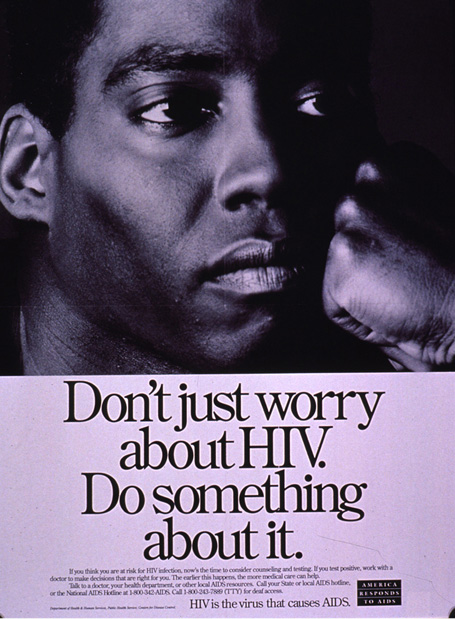
The CDC launches its PSA campaign, America Responds to AIDS, to kick off October as the newly designated AIDS Awareness Month.
Learn More.Reaching millions, the campaign is the first to be produced on the subject of AIDS prevention, and becomes a central prong in the “everyone is at risk” strategy of AIDS prevention. From 1987 to 1996, the America Responds to AIDS campaign reaches a wide range of audiences variously defined by identity or behavior, from heterosexual single mothers, to teenagers of all races, to young adult African Americans, to people who live in rural areas.
The five-phase campaign releases materials to the general public in various mediums, including a national mailer. The themes of the five phases were:
The campaign suggests that the best way to respond to HIV/AIDS is to engage in honest conversations about risk behaviors, including the potential consequences of multiple partners, unprotected sex, intravenous drug use, or any activities that compromise the ability to make a sound, safe judgment.
Not all applaud the effort. Service providers working with groups with a high incidence of HIV/AIDS (most notably young men who have sex with men and intravenous drug users) see the campaign as ignoring the particular needs of these communities in favor of supporting low-risk individuals.
While the CDC claims to be engaging with all Americans, critics argued that the campaign failed to provide adequate outreach and education to those who needed it most.
Journalist Randy Shilts’ book about the early years of the HIV/AIDS epidemic, And the Band Played On: Politics, People and the AIDS Epidemic, is published.
Learn More.When Shilts joined the San Francisco Chronicle in 1981 he was the publication’s first openly gay journalist. He had been hired to cover issues in the gay community, though he also reported other stories. As part of his beat, he wrote about the growing number of immune system-related diseases occurring in gay men in San Francisco.
In the early 1980s, he persuaded The Chronicle to let him report on AIDS full time. “And the Band Played On: Politics, People and the AIDS Epidemic,” a history of the first five years of the epidemic, is largely the result of his newspaper work.
In the book, Shilts charges the Reagan Administration, the medical establishment and even some gay organizations with indifference to the disease.
The book would make Shilts a trusted commentator on AIDS, to the point that he becomes the closing speaker at the Fifth International AIDS Conference in Montreal in 1989.
Shilts also wrote The Mayor of Castro Street: The Life and Times of Harvey Milk (1982) and the bestselling Conduct Unbecoming: Lesbians and Gays in the U.S. Military, Vietnam to the Persian Gulf (1993).
Shilts would die of AIDS-related illness on Feb. 17, 1994 at his ranch in the Sonoma County redwoods, at the age of 42.

Jerry Carlson, conductor of the Gay Men’s Chorus of Los Angeles, dies of AIDS-related illness at his home. He was 31 years old.
Learn More.Originally from Chicago, where he had helped to found the Windy City Chorus and the Chicago Gay Pride Band, Carlson became the principal conductor of the Gay Men’s Chorus of Los Angeles (GMCLA) in 1981. Almost immediately he went to work elevating the Chorus to a more professional sound and look.
Carlson instituted an audition process for the first time, according to the Los Angeles Times. He kept pop music in the chorus’ repertoire, but also challenged his singers to stretch to meet the demands of more serious music like Leonard Bernstein’s “Chichester Psalms.” Setting the Chorus on an ambitious musical direction that would continue for decades after his death, Carlson always pushed his singers to the next level.
In early 1987, the GMCLA was invited to sing the text of Shostakovich’s 13th Symphony for a November concert with the Long Beach Symphony — a golden opportunity. But Carlson’s health was on the decline, and he soon grew too weak to conduct rehearsals. Choral conductor Beverly Patton stepped in to help.
For the last rehearsal, Carlson was brought in on a wheelchair, so he could speak to the singers one last time.
“It was important for him to know we were still with him, and he was with us,” said Jon Bailey, chairman of the music department at Pomona College who took over from Carlson as GMCLA’s conductor.
Two weeks later, Carlson died.
“Jerry had taken a bunch of guys and made them into a musical instrument, and now they sang for him, at his memorial service,” Bailey told the Los Angeles Times. “And they sang very well.”
While Carlson was the latest AIDS casualty among members of the GMCLA, members had been steadily dying of AIDS-related illness since late 1984, according to the LA Times. But because Carlson had such a strong influence on the Chorus as a whole, his death had perhaps the most profound impact to date.
Before the end of the 1980s, more than 40 members had died of AIDS. By 1995, the Chorus had lost over 150 members, sometimes losing another member with each passing week, according to the GMCLA website. Many of the members are memorialized on Russ Bickers’ website.
For many years, the Chorus could not sing a sad song without the specter of AIDS hanging over the performance.
GMCLA was one of the first gay men’s choruses in the U.S., according to the organization’s Executive Director Lou Spitzo. The Chorus had its first rehearsal in West Hollywood’s Plummer Park in July 1979 with 99 men.
In 1991, GMCLA became the first gay men’s chorus to tour central Europe, according to Los Angeles Almanac. The Chorus was also the first to perform before a sitting U.S. president (Clinton in 1999), and the first to tour South America (2006).
* * * * * * * *
Photo of quilt panel from the AIDS Memorial Quilt
Photographer Peter Hujar dies of AIDS-related illness at Cabrini Medical Center in New York, surrounded by his friends and leaving behind a profound body of photographs. He was 53 years old.
Learn More.Born in 1934, Peter Hujar was a leading figure in the group of artists, musicians, writers, and performers at the forefront of the cultural scene in downtown New York in the 1970s and early 80s, operating in the bohemian circle of fellow artist Andy Warhol.
He was best known for his portraits of drag queens, transgender women, and cultural personalities, with theorist Susan Sontag, artist David Wojnarowicz, and Warhol superstar Candy Darling among his subjects. But he also photographed cityscapes, portraying New York City’s decrepit buildings, cobblestoned intersections, parking lots, and empty alleys as deserted and untouched.
“Hujar was a darkroom master,” Laurie Barron wrote in Ocula Magazine in 2021. “Known for consistently using the same square format firm, his intention to take ‘uncomplicated direct photographs of complicated and difficult subjects’ extended from pastoral landscapes to erotic nudes.”
His first book, Portraits in Life and Death, with an introduction by Susan Sontag, was published in 1976. But, according to the Peter Hujar Archive, Hujar’s “difficult personality and refusal to pander to the marketplace ensured that it was one of the last publications during his lifetime.”
In its Guide to Peter Hujar, Whose Photographs Chronicled a Lost World, Christie’s auction house wrote: “Indeed, Hujar had been offered many opportunities to show work in prestigious galleries and museums throughout his life, but was so particular about whom he worked with and how his photographs were displayed that he rejected many of them. At the same time, Hujar was known throughout the 1970s and early 1980s by nearly everyone in New York’s visual and avant-garde performing art circles.”
Hujar was diagnosed with AIDS in January 1987, and he died 10 months later. His funeral was held at Church of St. Joseph in Greenwich Village, and he was buried at Gate of Heaven Cemetery in Valhalla, New York.
The first retrospective of Hujar’s work came in 1994 in the Stedelijk Museum in Amsterdam in 1994. In 2018, the Morgan Library and Museum in New York presented Peter Hujar: Speed of Life, a major retrospective dedicated to Hujar’s work. And in 2024, Hujar’s photographs was exhibited at the Venice Biennale.
Many of Hujar’s photographs, which continue to increase in value and appreciation, can be viewed online at the Peter Hujar Archive.
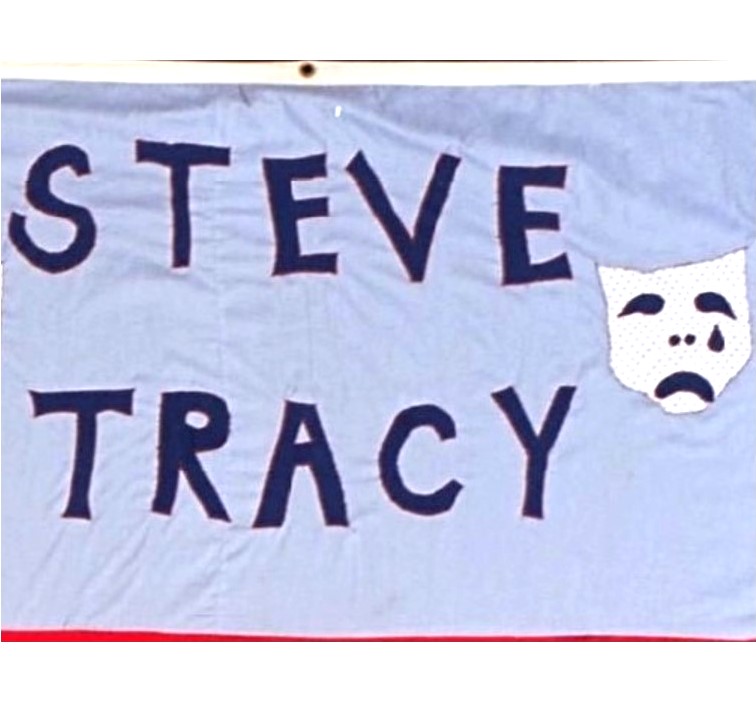
Steve Tracy, a film and TV actor best known for his role as Percival Dalton on Little House on the Prairie, dies of AIDS-related illness in Los Angeles at the age of 34.
Learn More.Six months before his death, he performed in the Los Angeles theater production of AIDS/US: Portraits in Personal Courage. The piece featured true stories of having AIDS or losing family members to AIDS. Tracy was the only professional actor in the production.
“Then one night in November 1986, Steve called,” wrote Arngrim. “He told me what I had been dreading for several months: he had very little time left, and his mother and sister were coming to take him home to Florida. He wanted to die at home … Less than a week later, on Thanksgiving Day, Steve Tracy died.”
Tracy’s ashes were brought to Los Angeles and scattered under the Hollywood sign, under the letter “D,” per his wishes.
Arngrim continued to work with various AIDS organizations all over the country.
* * * * * * * *
Photo of quilt panel from the AIDS Memorial Quilt

Goh Choo San, a Chinese ballet dancer and choreographer with the Washington Ballet, dies of AIDS-related illness at his New York City home. He was 39 years old.
Learn More.As the Washington Ballet’s first resident choreographer, Goh worked with the company from its 1976 founding until his death. Goh’s distinct style emphasized technique and musicality over plot and blended Eastern movement with classical ballet technique, showcasing the dancers’ strengths that company founder Mary Day had cultivated in her studio.
“Those of us in Washington who witnessed his artistic blossoming over the past 11 years … have an enormous legacy to be grateful for,” wrote Pulitzer Prize-winning dance critic Alan M. Kriegsman in his tribute to Goh in The Washington Post. “And his works — 34 ballets created since 1973, 14 of them expressly for the Washington Ballet — will live on and transmit his genius to posterity.”
Raised in Singapore with eight older siblings, Goh followed in the path of an older brother and sister who were training in the art of dance. After graduating from the University of Singapore with a degree in bio-chemistry, Goh travelled to Europe and joined the Dutch National Ballet in Amsterdam, where he was eventually promoted to soloist.
While still a dancer with the company, Goh created his first ballets and began drawing the attention of dance aficionados, including that of Mary Day, who was starting a new ballet company in Washington, DC. Day offered him a position in 1976 with her newly founded Washington Ballet.
“It is no exaggeration to call [Goh’s] choreographic ascent meteoric,” wrote Kriegsman. “Within two years of his arrival, he had choreographed six ballets for the Washington company. He had also attracted the attention of Mikhail Baryshnikov, who met with Goh in Washington, watched him work and laid the groundwork for a major commission for American Ballet Theatre.”
The commissioned work became the 1981 ballet Configurations, which was danced by Baryshnikov and a contingent of ABT dancers at Lisner Auditorium as part of the Washington Ballet’s historic “Golden Gala.” The creation and performance of the work were documented by London Weekend Television and is now available as Baryshnikov: The Dancer and the Dance.
Goh’s choreography for Configurations is considered a concrete example of his command of the classical dance vocabulary and his ingenuity in creating striking imagery. The ballet is set to Samuel Barber’s Pulitzer Prize-winning Piano Concerto, a score that is difficult to play and even more difficult to dance to.
”He is intensely musical, and his ballets are all marked by a first-rate command of structure and fluency,” Anna Kisselgoff, chief dance critic of The New York Times, wrote in 1980. ”He concentrates on speed, intricacies of movement, difficult toe work and streamlined partnering. His base is strongly neo-Classical with a sleek contemporary look, incorporating modern-dance idioms and unexpected gestures, wrist rotations, interpolated academic steps that burst out of the usual flow of movement, acrobatic tumbling within a partnering technique and subtle nuances.”
In 1982, he would choreograph In the Glow of the Night, a ballet set to music by Bohuslav Martinu that would be praised as Goh’s most perfectly realized work. In 1986, Unknown Territory — his last completed ballet — was touted as an important work for both Goh and the Washington Ballet.
“Every two years since his arrival in Washington in 1976, he’s come up with a breakthrough of sorts: the propulsive abstraction Fives in 1978; the distilled romanticism of Lament in 1980; a fusion of these contrary impulses in the 1982 In the Glow of the Night; his first full-length narrative work, Romeo and Juliet, in 1984 (for the Boston Ballet); and now the richly exotic Unknown Territory,” wrote Kriegsman in 1986, not realizing that this work would be Goh’s last.
In 1992, five years after Goh’s death, the Choo San Goh & H. Robert Magee Foundation was formed to provide annual scholarships and grants for new dance works in an effort to further develop choreographic talent. The foundation also oversees the licensing of Goh’s ballets in performances by dance companies throughout the world.
In 1997, the Singapore Dance Theatre commissioned a monograph on Goh entitled Goh Choo San, Master Craftsman in Dance. It contains a detailed overview of Goh’s life in written text and photos of his ballets. The company also added to their repertoire twelve of Goh’s works, bringing his identity as a Singaporean choreographer back to his homeland.
* * * * * * * *
Photo of quilt panel from the AIDS Memorial Quilt

Lyle Loder, member of the congregation of the Hollywood United Methodist Church, dies of AIDS-related illness at the age of 37.
Learn More.Loder was a key leader in development of an LGBT witness among United Methodists in southern California during the early 1980s, recalls his friend Morris Floyd.
Feeling called to the United Methodist ministry, Loder studied philosophy and religion and served as a student pastorate while at Kansas Wesleyan University in the early 1970s, according to Floyd. However, Loder chose to not hide his identity, and by the time of his graduation from KWU, the denomination had incorporated into its Discipline the language describing same-sex relationships as “incompatible with Christian teaching.”
“Lyle’s dream of serving as a United Methodist clergyman was never realized,” writes Floyd in the LGBTQ Religious Archives Network.
Instead, Loder would go on to help build a local congregation that would welcome lesbian and gay United Methodists in the Hollywood area. By 1986, Loder would be an active member of HUMC and he would share with the congregation that he was living with AIDS.
In October 1987, the Health and Welfare Ministries Division of the Board of Global Ministries hosted a consultation conference on AIDS at a hotel near the San Francisco airport. Loder was invited to help plan the conference and participate in a panel discussion about the needs of people living with AIDS.
“Lyle’s participation on a panel, sharing his story, and in the midst of it, despite everything, his love for God and his refusal to give up on the United Methodist Church,” recalls Floyd. “He was frail and only a few weeks from death, though he did not know it at the time. If ever God’s Spirit was present anywhere, it shone in Lyle in those hours.”
On November 29, 1987, the day before his birthday, Loder was admitted to the hospital, where he was visited by his brother. When Loder died a few days later, many friends came to his hospital room, spread rose petals on his bed, and sang hymns
 Memorial services were held at HUMC and again at Loder’s home church in Kansas. Loder was the first of the HUMC family to die of complications of HIV/AIDS, but he wouldn’t be the last.
Memorial services were held at HUMC and again at Loder’s home church in Kansas. Loder was the first of the HUMC family to die of complications of HIV/AIDS, but he wouldn’t be the last.
A memorial plaque inside the church narthex carries the names of Loder and 34 additional members of the congregation who died in the early years of the pandemic. On World AIDS Day in 1993, members of HUMC fashioned two giant red ribbons and attached them to the tower of the church. In 1996, more permanent ribbons replaced them and remain today.
Loder’s life is also memorialized by three panels of the AIDS Memorial Quilt, one of them made by church and community worker Donna Kay Campbell.
* * * * * * * *
Photo of quilt panel from the AIDS Memorial Quilt
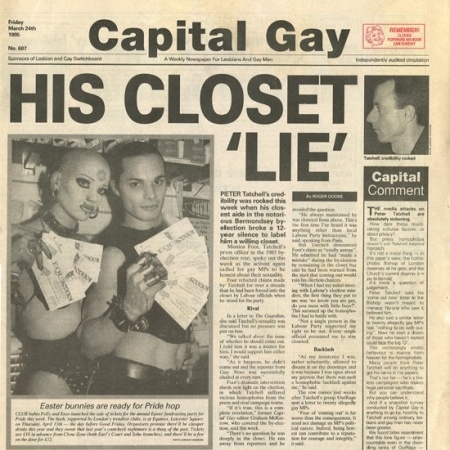
The offices of Capital Gay, a London free weekly newspaper serving the LGBT community, are firebombed. No one is ever charged for the crime.
Learn More.The offices were throught to be targeted, because of the strong stance Capital Gay editors took against Section 28, “the most serious legal attack on our rights since male homosexuality was outlawed more than 100 years ago.”
But aside from their strong editorials opposing Section 28, the editors also sponsored the London Lesbian and Gay Switchboard and involved itself in events in the wider gay community in London.
Capital Gay was among the first publications to feature a regular column on HIV/AIDS, which was started in 1982 by Julian Meldrum. Meldrum was also the archivist for the Gay Monitoring and Archive Project, which collected evidence of discrimination and police arrests.
Editor and founder Michael Mason would later recall that local police did not appear to undertake a serious investigation of the arson. Local officials were also less than sympathetic.
Elaine Kellett-Bowman, a conservative Member of Parliament, publicly supported the firebombing, saying she was “quite prepared to affirm that it is quite right that there should be an intolerance of evil.”
Capital Gay would resurrect itself following the fire and continue publishing until June 1995, becoming Britain’s longest-running gay newspaper.
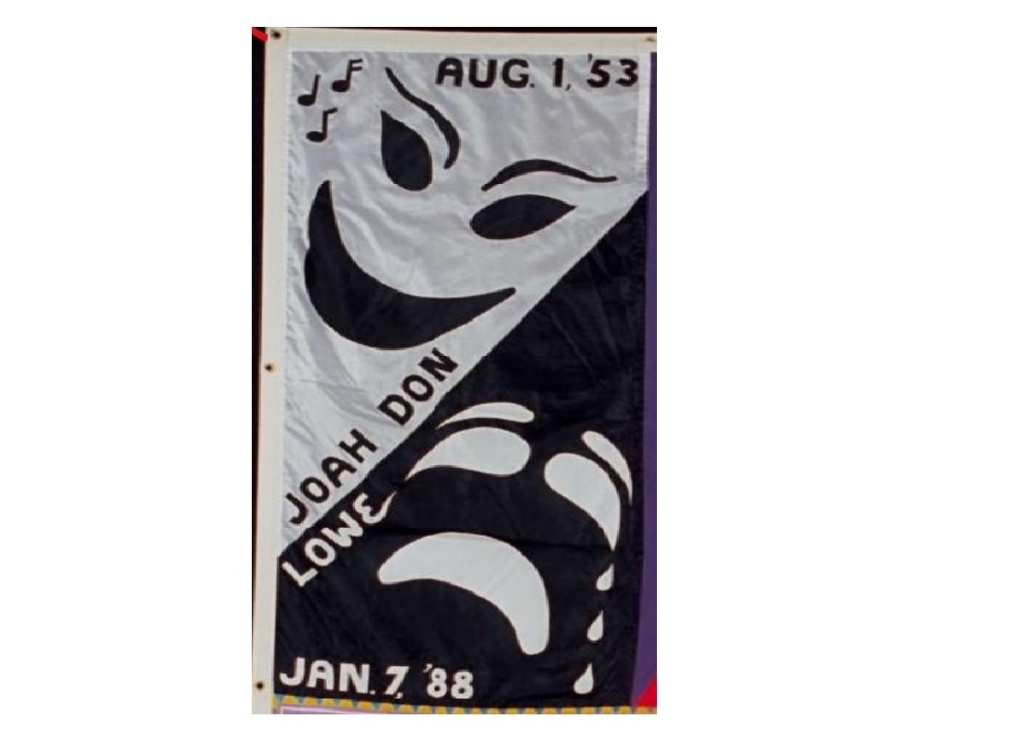
Dancer and dance teacher Joah Lowe dies of AIDS-related illness at the age of 34.
Learn More.Lowe performed in the San Francisco area and taught dance classes, including one titled, “Lessons in the Art of Flying.”
In 2004, dancer Keith Hennessy was asked to write about Lowe, his first dance teacher.
“Joah taught a weekly class, an introduction to contemporary dance that involved technique and improvisation,” Hennessy writes. “Joah, thanks a lot. Thanks for welcoming me, for steering me into the future and away from the past…. You were my first authentically intuitive man.”
The Joah Lowe collection — which includes theater, performance and dance ephemera, performance and dance production notes, and related art and artifacts from Lowe’s work — is stored at the GLBT Historical Society in San Francisco. The collection includes material collected by Charlie Halloran, a dancer who worked with Lowe and who subsequently died in 1993, also from AIDS-related illness.
* * * * * * * *
Photo of quilt panel from the AIDS Memorial Quilt
After a long-time Hollywood resident leases his single-family home to a non-profit AIDS hospice, neighbors begin to mobilize to force its closure.
Learn More.On this day, Hospice Los Angeles/Long Beach announced the opening of its location on the 1300 block of Ogden neighborhood of Los Angeles, bordering West Hollywood.
Called Hughes House after Shawn Hughes, the first City of West Hollywood employee to die of AIDS, the hospice was one of only two in Los Angeles available exclusively for AIDS patients, although additional AIDS hospices were in the works to open later in 1988 and 1989. Shawn Hughes’ mother attended the event to show her support of the hospice, along with media representatives and AIDS activists.
Disgruntled neighbors also attended the event, according to the Los Angeles Times, “milling around the fringes of the press conference.”
Opposed to Hughes House opening in their neighborhood and angry with the facility’s plan to care for a total of six AIDS patients in the three-bedroom home, the neighbors provided the Times reporter with a litany of complaints, ranging from alleged zoning violations to the possibility of lowered property values.
“Our problem has nothing to do with AIDS,” one neighbor said. “It has to do with R-1 (single-family zoning) conformity … It’s the same as if somebody put in a body-and-fender shop in your neighborhood.”
Los Angeles City Councilperson Michael Woo, who attended the hospice opening event, would become the target of of much of the residents’ anger.
Woo, however, defended the hospice location, saying he had obtained an opinion from the city attorney’s office stating that hospices could be operated in residential zones as long as they are no larger than six beds.
“A hospice is not a hospital,” Woo told the LA Times. “It is a place where (AIDS patients) can die with respect and dignity.”
LA Times reporter Bob Baker pointed out, “The conflict is symptomatic of why Los Angeles County has so few AIDS hospices, where patients can die in an environment far more sympathetic and less expensive than a hospital. In addition to a lack of governmental assistance — it was only late last year that the county Board of Supervisors voted to release $1.5 million to support alternative-care AIDS programs — the few existing hospices created with private funds or contributions have been placed in commercial areas or low-income neighborhoods.”
This marked the beginning of a long fight between Hughes House and its neighbors, the latter who would ask the city’s Zoning Board to close down the hospice. In its first year, Hughes House would provide hospice care to numerous people, including famous television performer Wayland Flowers.

Community artist Chuck Arnett dies of AIDS-related illness in San Francisco at the age of 60.
Learn More.Formerly a dancer with the National Ballet in New York, Arnett relocated to San Francisco in the 1960s and established himself as an artist and a central figure in the early leather scene. His murals covering the walls of local leather bars like The Stud and the Tool Box (pictured) inspired observers to compare Arnett to Toulouse-Lautrec.
Arnett’s interior murals at the Tool Box were the establishment’s best-known calling card. According to the LGBT Historical Society in San Francisco, one set of Arnett’s murals were located along the south-facing, Harrison Street walls, and two additional mural panels were painted on the glass storefront windows on the west-facing, 4th Street walls.
The Harrison Street murals became internationally known in June 1964 when photographs of the interior of the Tool Box were featured in Life Magazine in a feature article entitled “Homosexuality in America.” The article described San Francisco as “The Gay Capital of America” and inspired many gay leathermen to move there, according to the Leather History Timeline.
Unfortunately, Arnett’s Tool Box artwork was on display for only a brief time. The Tool Box closed in 1971 and the building (along with the Harrison Street murals) was torn down in 1975. The panel that is pictured here was painted on wood and was able to be removed prior to the destruction of the building. A San Francisco couple purchased the panel at a garage sale in the 1990s, and it was donated to the GLBT Historical Society in 2021.
The San Francisco South of Market Leather History Alley consists of works of art along Ringold Alley honoring leather culture. One of the works of art is a black granite stone etched with a narrative by Gayle Rubin and a reproduction of Arnett’s Tool Box mural. Another of the works of art is bronze bootprints along the curb which honor Arnett and 27 other icons of the leather community.
Florida Governor Bob Martinez voices his support for state legislation that would permit health officials to confine people with AIDS.
Learn More.Florida Gov. Bob Martinez called for the quarantine of AIDS sufferers who risk infecting others.
“AIDS carriers who refuse to inhibit their contacts, who refuse to stop spreading this fatal disease, should no more be allowed to roam free than criminals armed with a deadly weapon,” Gov. Martinez declared during a joint session of the Florida Legislature. ‘The time has come to quarantine those whose character and conduct are a clear threat to society.’
The legislation pending in the state House and Senate was introduced to provide $1.1 million to the Florida Department of Health and Rehabilitative Services, which would use the funds to lock up six juveniles and up to 22 adults who tested positive for the virus and were deemed by state officials to “behave in ways likely to spread the disease,” according to United Press International (UPI) reporting.
If passed, the legislation would permit confinement of any person with AIDS whose behavior was considered dangerous to public health.
“What [Gov. Martinez] is doing is sending up a trial balloon for the nation,” AIDS activist Bob Kunst told UPI. “We’ve got to knock it down real fast.”
Kunst added that state legislators should instead award $1.1 million to AIDS service providers and education campaigns.
State Senator William Myers, chair of the Senate Select Committee on AIDS, endorsed the quarantine proposal. A similar but more modest bill was introduced in the House, but it was expected to be quashed by House leaders who opposed the large detention facilities sought by the Social Services Department.
Representative Lois Frankel, chair of the House Select Committee, told UPI, ‘That’s not how we’re going to stop the spread of AIDS. We know that education of high risk groups, education in the schools — that’s how we’re going to stop the spread of AIDS.”

Russian-born pianist Youri Egorov dies of AIDS-related illness at his home in Amsterdam at the age of 33.
Learn More.Egorov made his mark on the performance of classical music in his own highly individual way. Between the ages of 6 and 17, he studied music at the Kazan Music School and then studied for six years at the Moscow Conservatory. In 1976, at the age of 22, Egorov defected from Russia to Amsterdam. applying for asylum just before a concert in Italy.
The year following his defection, Egorov participated in the Cliburn music competition in Fort Forth, Texas and became an audience favorite. When he was not chosen by judges as a finalist, a group of patrons and Cliburn board members formed an ad-hoc committee to raise money equal to the top prize of $10,000 to further Egorov’s career.
In 1978, Egorov had his New York recital debut in Alice Tully Hall at Lincoln Center at the age of 24, and his career took off. By the end of the year, Egorov would give a performance at Carnegie Hall, which was recorded live. The same year, he performed for the Schumann Carnaval, a recital for German TV.
”Mr. Egorov plays in a free, romantic style, and his approach is quite different from that of so many competition winners,” wrote Harold C. Schonberg in The New York Times after Egorov’s New York debut.
Egorov’s dramatic style can be heard (and seen) in this abbreviated recording of a concert with the Concertgebouw Orchestra in Amsterdam in June 1979.
In the book Great Contemporary Pianists Speak for Themselves compiled by Elyse Mach, Egorov spoke candidly on the topics of rehearsal, pre-concert nervousness, artistic restrictions in Russia, and homosexuality. In Amsterdam, Egorov met Jan Brouwer, who became his long-term partner.
Although he took an apartment in Manhattan in the late 1970s, and he and Brouwer established a residence in Monte Carlo for tax purposes, Egorov counted Amsterdam as his home throughout his 12 years in the West.
When Egorov died in 1988, he had recordings of several performances awaiting release. His partner died about four months after Egorov, and both their remains are interred at Driehuis Velsen Crematorium, Noord-Holland, Netherlands.
* * * * * * * *
Photo of quilt panel from the AIDS Memorial Quilt
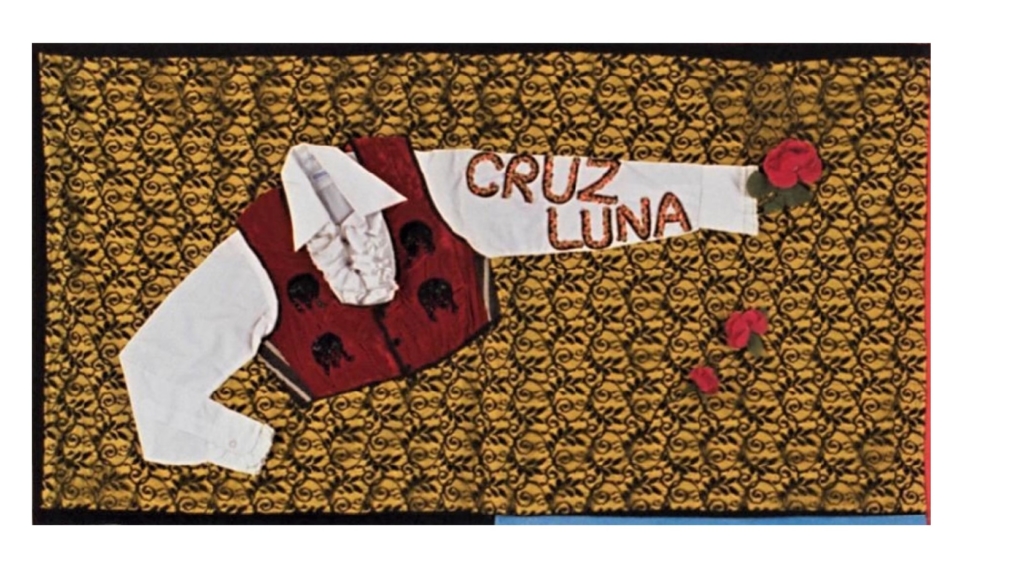
Nationally known flamenco dancer Cruz Luna dies of AIDS-related illness at the age of 50.
Learn More.
A native of Spain, Luna learned flamenco dancing in cafes there and studied later in Mexico and Los Angeles. He launched his career at the age of 17 with appearances on the Ed Sullivan and Dave Garroway television shows.
Luna danced in an international tour with the Ballet Nacional of Spain and in a Broadway show titled Ole! Ole! He moved to San Francisco in 1959 and performed with the Smothers Brothers and Phyllis Diller. From 1960 to 1974, he operated Cafe Madrid in North Beach and presented flamenco dancers from around the world.
He died at Garden Sullivan Hospital in San Francisco.
Luna is memorialized in the project Dancers We Lost: Honoring Performers Lost to HIV/AIDS.
* * * * * * * *
Photo of quilt panel from the AIDS Memorial Quilt
A Los Angeles zoning administrator rules that Hughes House, one of just a few AIDS hospices in the county, is in violation of zoning laws and cannot remain in the neighborhood where it has operated for five months.
Learn More.Likening the hospice to a hospital, Chief Zoning Administrator Franklin P. Eberhard ruled that Hughes House is not allowed to operate in the three-bedroom house on the 1300 block of Ogden, a neighborhood of single-family homes.
Previously, Los Angeles building and safety officials said the hospice could operate in its location, because the six-bed facility observes state and city laws which allow up to six unrelated people to share a single-family home. The city has no zoning code that applies specifically to where hospices can be located.
Hughes House responded by filing an appeal to Eberhard’s decision. Ron Wolff, executive director of Hospice Los Angeles/Long Beach, which runs Hughes House, told the Los Angeles Times that he was confident that they would win their appeal on grounds that Hughes House is not a medical facility.
“We feel that, No. 1, it’s a legal use,” Wolff told the Times. “No. 2, the moral imperative is so overwhelming. There needs to be a place for these people to be cared for in the final stages of life.”
Andrew Meltzer, resident conductor with the San Francisco Opera, dies of AIDS-related illness at the age of 40.
Learn More.Meltzer made his West Coast conducting debut with the Spring Opera Theater’s 1974 production of Cavalli’s L’Ormindo, according to The Washington Post. He made his company debut during the 1982 summer season with The Barber of Seville and followed up with Cosi fan Tutte in the summer of 1983, La Gioconda during the 1983 fall season, and Die Fledermaus in 1984.
His conducting credits with other companies include productions for Michigan Opera Theater, Edmonton Opera, New York City Opera, Houston Grand Opera and Spoleto Festival USA. Opera fans in San Francisco considered Meltzer a rising star.
At age 39, Meltzer entered a blind test for AZT, but he was one of the participants given a placebo. He was switched to AZT at age 40, but it was too late.
“Anyone who heard him conduct last year’s La Traviata cannot help but feel the tragedy,” said Anthony Turney, administrative director of the San Francisco Opera.
Kurt Raab, best remembered for his work with German film director Rainer Werner Fassbinder, dies of AIDS-related illness in Hamburg at the age of 46.
Learn More.Born in 1941 in the Bohemian town of Bergreichenstein (now part of the Czek Republic), Raab started life as the son of a farm hand. While attending high school at Straubing, he would befriend Peer Raben, the future composer for many Fassbinder films, and the two would move to Munich together.
Raab would play his first role in Raben’s staging of Antigone, where they both would meet Fassbinder. In 1969, Raab would play the lead role in Fassbinder’s Why Does Herr R. Run Amok? and then go on to perform in numerous other Fassbinder films and TV productions.
Raab is considered one of the most versatile members of Fassbinder’s stock company, and he would work on more than 30 of the director’s films, on and behind the screen.
Before he died, he worked to raise awareness about HIV/AIDS in Germany. In 1987, he discussed his illness in Herbert Achternbusch’s Wohin?, a film about AIDS hysteria. Shortly before his death in 1988, he made Mitten im Leben, a documentary about AIDS, for Zweites Deutsches Fernsehen.
Raab’s tragic death in 1988 played out publicly and painfully in Germany, where understanding of the illness was poor at best.
The actor was practically quarantined in the Hamburg Tropical Institute, and following his death, his body was frefused burial in Steinbeißen, the Bavarian town where his family had settled in 1945.
His body would be shipped to Hamburg, where he would be buried in the Ohlsdorf Cemetery.
Raab’s last days were recorded for Yearning for Sodom, which he codirected with Hanno Baethe and his former Fassbinder colleague Hirschmüller, and for which Raab would be posthumously awarded the Adolf Grimme Award.
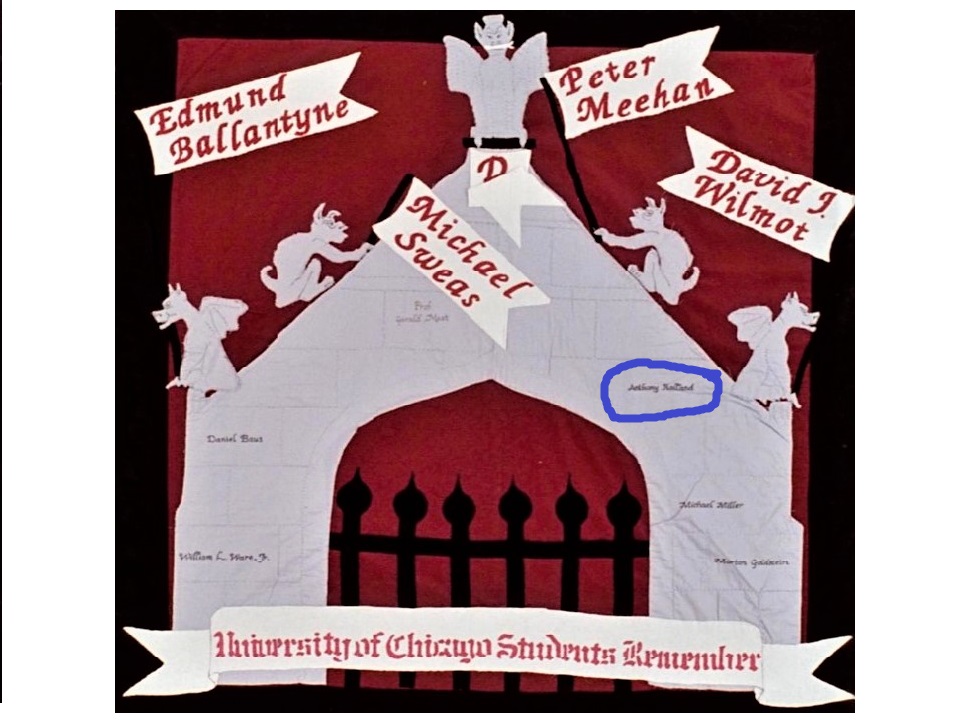
Actor Anthony Holland, whose health was declining due to infection with HIV, commits suicide in his Manhattan apartment; he was 60 years old.
Learn More.A graduate of the University of Chicago, Holland had been a member of the original Second City comedy troupe, where he met Joan Rivers, with whom he remained friends until his death.
He made his Broadway debut in 1963 in Lillian Hellman’s comedy My Mother, My Father and Me. His half-dozen subsequent Broadway roles included Division Street and We Bombed in New Haven. He appeared in many regional-theater productions, as well as Off Broadway productions of Brendan Behan’s ‘Quare Fellow, Eugene Ionesco’s Victims of Duty and Samuel Beckett’s Waiting for Godot.
He gave one of his best performances in The Hunger Artist, Martha Clarke’s 1987 adaptation of several stories by Franz Kafka.
“His soft voice, unpretentiously conversational in tone yet mesmerizingly grave, could be Kafka’s,” Frank Rich wrote in The New York Times.
In 1979, he gives a standout performance in the film All That Jazz as Broadway songwriter Paul Dann, and appears in scores of other films between 1964-1986.
Holland took his own life just as he was entering the final stages of the disease “in what can only be called an act of sheer bravado,” writes friend David Ehrenstein. He had saved enough medication to facilitate a lethal overdoes.
“Tony had elected to make his exit on a day when he was in a good mood,” Ehrenstein recalled. “He was in New York at that time and friends recall seeing him around town at his usual haunts in high spirits.
Holland had left instructions for the paramedics and even rubber gloves in case they were concerned about handling an “AIDS corpse.”
* * * * * * * *
Photo of quilt panel from the AIDS Memorial Quilt
Tommy Pace, a member of the pioneering Gay Men’s Theater Collective, dies of AIDS-related illness in San Francisco at the age of 39.
Learn More.Pace was known locally as a brilliant comic actor with the Angels of Light, a theater troupe that originated as an offshoot of the Cockettes, according to the Bay Area Reporter.
Pace was also cast in numerous San Francisco-made films, including the role of a deranged Catholic
schoolgirl in David Weissman’s 7-minute comedy Beauties Without a Cause (1986).
“Tommy was a macho Guido trapped inside a flaming Queen, and he played both roles to the hilt,” wrote friend Dolores DeLuce in RDF magazine. “I met Tommy at Purple Heart Thrift Store on Mission Street, where I noticed him in the mirror trying on a glitter halter over his clothes and flipping his long, dark hair like a girl in the shampoo commercial.”
Pace and DeLuce grew close as they performed together in theatrical events in the late 1970s. After DeLuce moved from San Francisco to Los Angeles, their friendship continued over long-distance phone calls.
In 1988, she returned to San Francisco to see Pace when she heard from mutual friends that he was dying of AIDS.
“He refused his morphine drip so he could fully take in these last moments,” DeLuce wrote of her reunion with Pace. “We both knew this was the end for him, but we never spoke of it. Instead, we talked about the glorious days of shows, drag and juicy dish.”
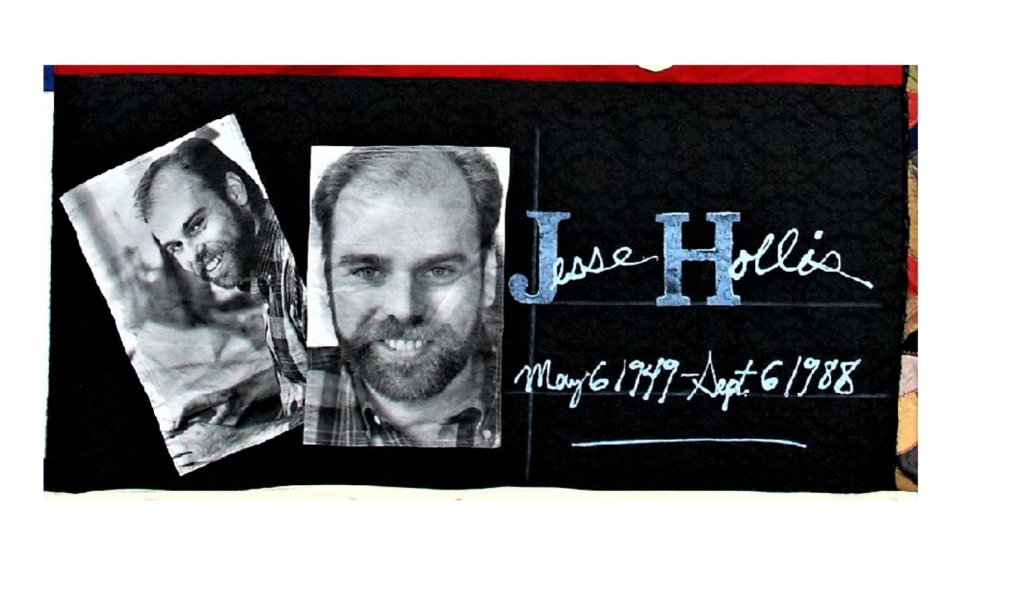
Jesse Hollis, the resident set designer at American Conservatory Theater in San Francisco, dies of AIDS-related illness at the age of 39.
Learn More.Hollis’ designs were seen at theater and opera companies throughout the country, including Berkeley Rep, the Oregon Shakespeare Festival and the Magic Theatre.
* * * * * * * *
Photo of quilt panel from the AIDS Memorial Quilt
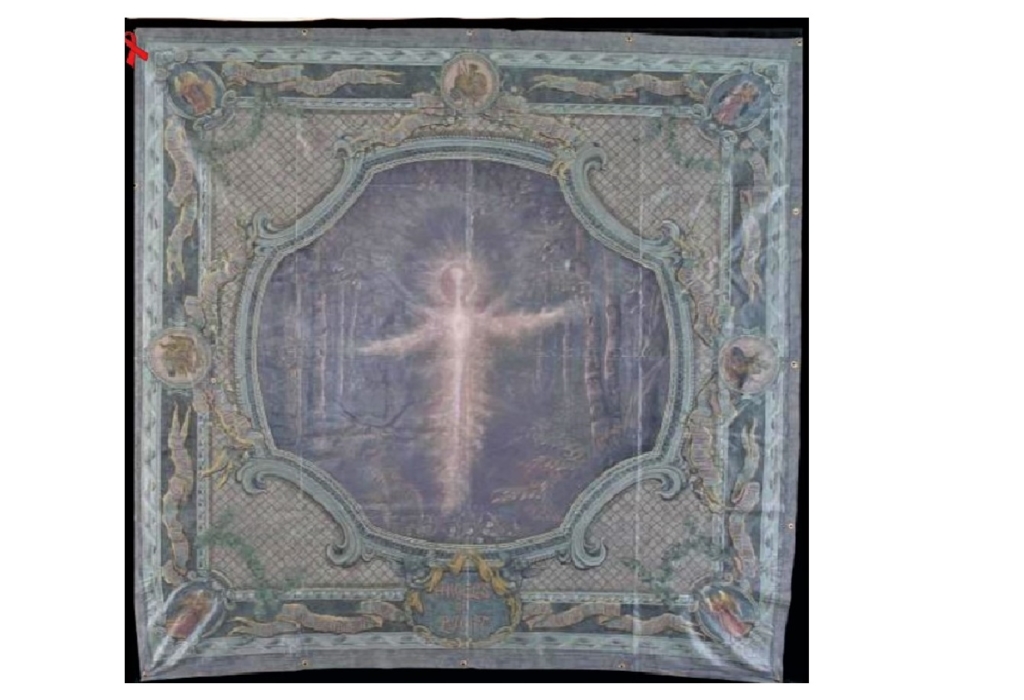
Rodney Price, co-founder of the wildly creative Angels of Light performance troupe in San Francisco, dies of AIDS-related illness at the age of 38.
Learn More.Price may be best remembered for his final performance, singing and tap dancing in his wheelchair in the film short Song From an Angel. Made two weeks prior to his death, Price performs a darkly humorous song about his own death, “I’ve Got Less Time Than You.”
Price is memorialized in the project Dancers We Lost: Honoring Performers Lost to HIV/AIDS.
* * * * * * * *
Photo of quilt panel from the AIDS Memorial Quilt

Reversing a decision by the City of Los Angeles’ zoning administrator, the zoning board voted to allow Hughes House to remain at its location in a Hollywood residential neighborhood.
Learn More.Following the zoning board’s decision, supporters of the hospice declared the ruling a victory for the rights of the terminally ill. Many of them wore pink buttons bearing the words “There’s no place like home.”
Ron Wolff, executive director of Hospice Los Angeles-Long Beach, the nonprofit group that runs Hughes House, said the hospice acts as a surrogate family for dying patients during the last three or four weeks of their lives.
The ruling of the zoning board ended a months-long attempt by residents to remove the hospice from their neighborhood.
Area residents filed complaints with the city, accusing Hughes House of operating a medical facility. In response, city inspectors visited the hospice three times and concluded that the facility was not violating zoning laws.
Then neighbors began to keep detailed logs of activity at Hughes House, according to the Los Angeles Times, and they reported to the city every occasion they observed of medical supply trucks making deliveries and new patients arriving. In June 1988, the chief zoning administrator sided with the neighbors, agreeing with their portrayal of the hospice as a medical facility, and ruled that Hughes House could not continue to operate in its location.
In the end, however, the zoning board found the residents’ complaints to be lacking in substance when compared to the needs of the people staying — and dying — at Hughes House. Ultimately, members of the zoning board were won over by the fact that Hughes House was providing a service — care for those dying of AIDS — that sadly was much in demand and that few other organizations in Los Angeles could provide.
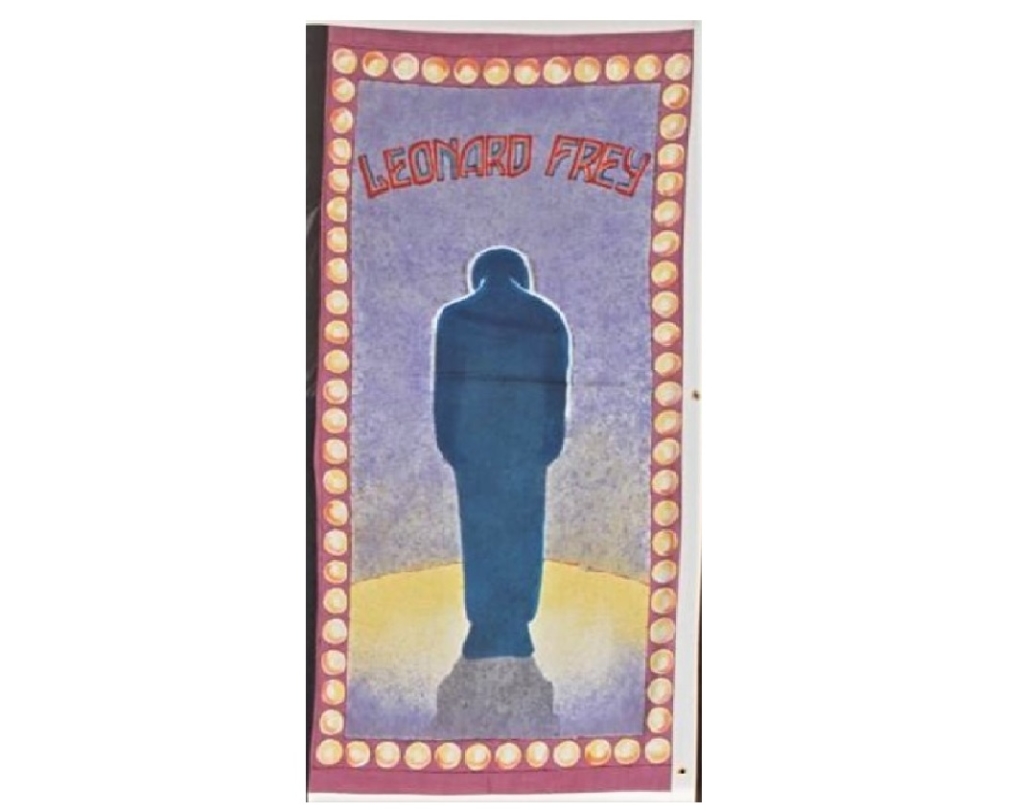
Leonard Frey, an actor admired for his vivid and often flamboyant performances, dies of AIDS-related illness at Beth Israel Hospital in Manhattan at the age of 49.
Learn More.In 1968, Frey received critical acclaim for his performance as Harold, a bitter, bitchy, gay man who dreads his upcoming birthday, in off-Broadway’s The Boys in the Band. He, along with the rest of the original cast, appeared in the 1970 film version, directed by William Friedkin, as well.
Frey was nominated for a 1975 Tony Award as Best Featured Actor in a Play for his performance in The National Health. For his role in the film version of Fiddler on the Roof, Frey earned an Academy Award nomination as Best Supporting Actor for his performance as Motel the tailor.
Frey also had a number of screen credits to his name, including films The Magic Christian, Where the Buffalo Roam and Tattoo and the television series’ Mission Impossible, Quincy, M.E. and Barney Miller.
* * * * * * * *
Photo of quilt panel from the AIDS Memorial Quilt
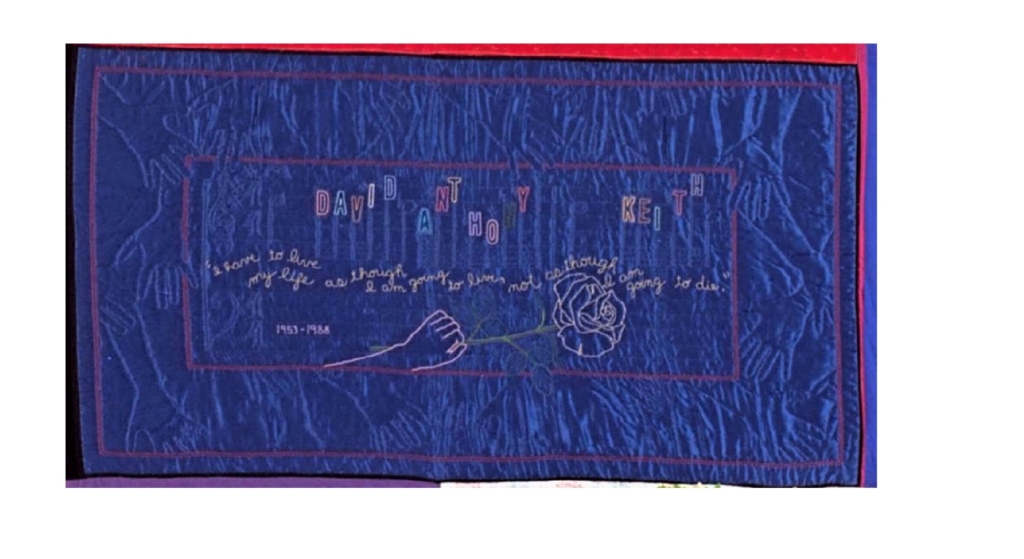
David Anthony Keith, Bay Area concert pianist, dies of AIDS-related illness at the age of 35.
Learn More.* * * * * * * *
Photo of quilt panel from the AIDS Memorial Quilt
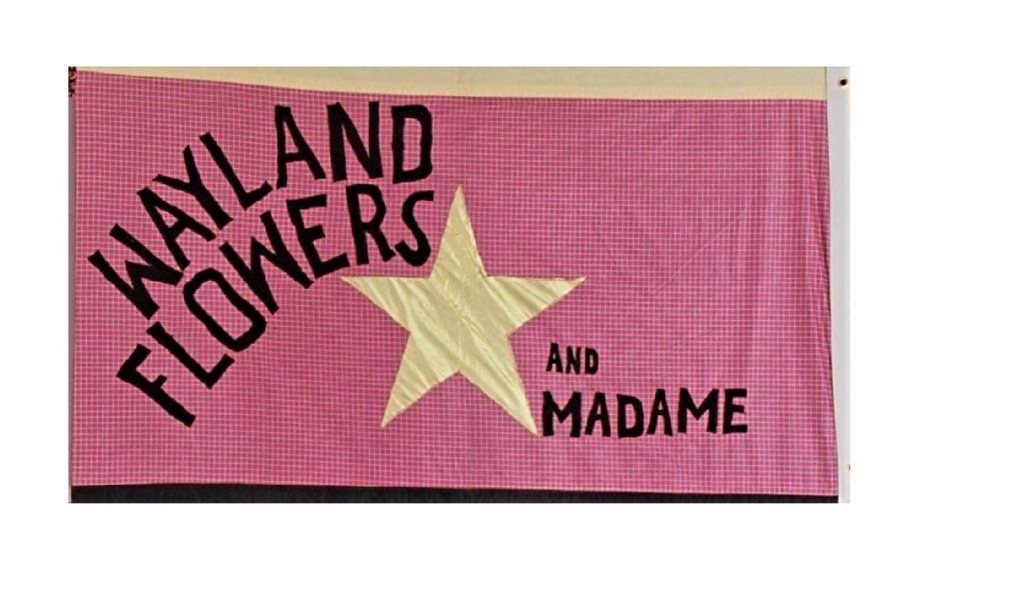
Wayland Flowers, best known for creating and voicing the sassy puppet Madame, dies of AIDS-related illness at the age of 48.
Learn More.Wayland Flowers was one of the first openly gay entertainers to find acceptance in mainstream America.
“In an era when even Paul Lynde was still in the closet, Flowers hid nothing,” says Kevin Phinney in his article “This is How Wayland Flowers and Madame Made the ’80s so Gay” in MetroSource.
After refining his act, Flowers’ made a national splash on The Andy Williams Show. From there, Flowers became a regular presence on network TV — although it was not unusual for Madame to get more closeups.
He is best known for the TV series Madame’s Place (1982) and The Hollywood Squares, and also performed in scores of live shows.
Other puppets populated Flowers’ act, but none earned Madame’s notoriety. Among them were a Harlem harlot known as Jiffy, a cranky vaudeville vet named Macklehoney and Crazy Mary, a Bellevue mental hospital escapee.
Sometime in the mid-1980s, Flowers was diagnosed with HIV. He continued to perform until he collapsed onstage during a show at Harrah’s casino in Las Vegas. Eventually, he developed Kaposi’s sarcoma. He made one last visit to his home town in Georgia and then checked into an AIDS treatment facility, the Hughes House hospice center in Los Angeles, where he remained until his death.
* * * * * * * *
Photo of quilt panel from the AIDS Memorial Quilt
The New York Times publishes the results of a poll that suggests that people are sympathetic toward people with AIDS — but not if they are sexually active gay men or use IV drugs.
Learn More.Of the 1,600 respondents interviewed by NYT/CBS, 75% stated they had ”a lot” or ”some” sympathy for people who have AIDS and 19% said they had ”not much” or ”no” sympathy. (The poll had a margin of sampling error of +/- 3%.)
The level of sympathy declined dramatically, however, when the two groups at highest risk of exposure to the disease were mentioned: 36% with “a lot” or “some” sympathy for “people who get AIDS from homosexual activity,” and 26% for ”people who get AIDS from sharing needles while using illegal drugs.”
NYT reporter Michael R. Kagay wrote: “The most recent poll made it clear that public attitudes toward these high-risk groups are linked to support or opposition to steps that might help to slow the spread of AIDS.”
Kagay then presented the example of the belief of 52% of those interviewed that drug addiction was “more an illness,” compared with 34% who believed that addiction was “more a crime.”
“These views about the nature of drug addiction appeared to influence how respondents reacted to a proposal to give free sterilized needles to intravenous drug users as a public health measure,” Kagay wrote.
The respondents viewing addiction as an illness were more likely to favor free distribution of sterilized needles to drug users, with 52% of these respondents supporting this as a way to slow the spread of AIDS. Only 26% of those who viewed addiction as a crime supported the proposal.
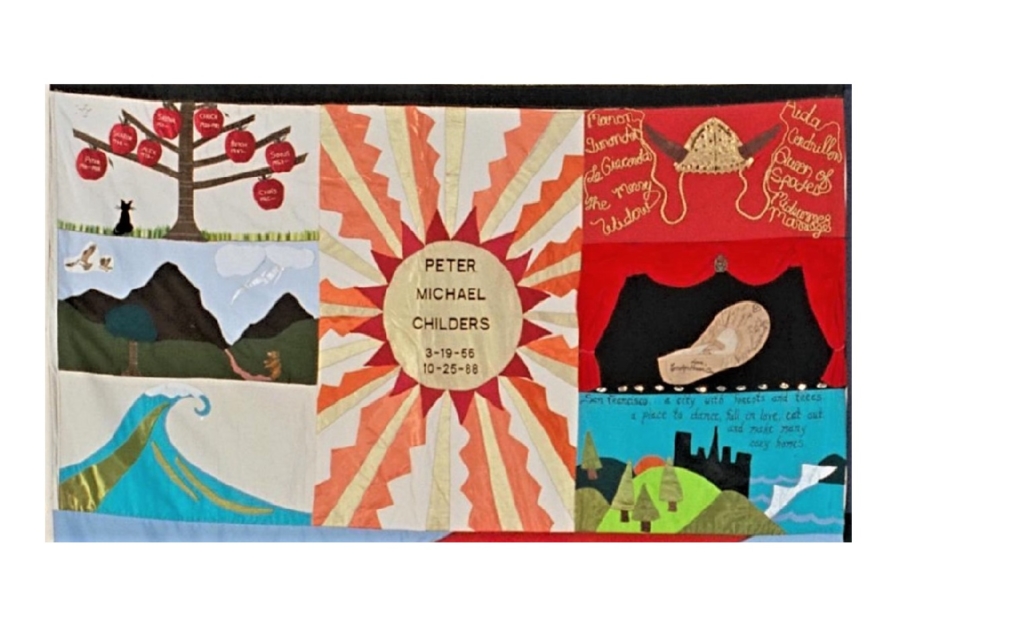
Dancer Peter Childers, who performed with the San Francisco Opera Ballet, dies of AIDS-related illness at the age of 32.
Learn More.* * * * * * * *
Photo of quilt panel from the AIDS Memorial Quilt
John Morris, frontman of the Los Angeles punk band Black Randy and The Metrosquad, dies of AIDS-related illness at the age of 36.
Learn More.After two gay men are murdered in Reverchon Park in the Oak Lawn area of Dallas, a Texas judge rejects the recommended life sentence for one of the killers, instead imposing the more lenient sentence of 30 years in prison.
Learn More.In a demonstration of the bigotry and homophobia faced by gay men in America, Judge Jack Hampton of State District Court told The Dallas Times Herald that he gave an 18-year-old murderer a more lenient sentence than prosecutors had sought because the two victims were gay and, the judge said, they would not have been killed ”if they hadn’t been cruising the streets picking up teenage boys.”
Tommy Lee Trimble, 34, and John Lloyd Griffin, 27, were driving through the Oak Lawn section of Dallas on a night in May 1988 when they were distracted by a group of young men shouting at them from the street corner. Not realizing that the group, which included students from North Mesquite High School, had come to the neighborhood to ”pester the homosexuals,” Trimble and Griffin invited the young men into their car.
Witnesses testifed that 18-year-old Richard Lee Bednarski and a friend entered the car with the intent of assaulting them. After the car reached a secluded area of Reverchon Park, Bednarski ordered Trimble and Griffin to remove their clothes and, when they refused, Bednarski drew a pistol and began firing at them. Trimble died immediately, and Griffin died five days later.
A jury found Bednarski guilty of the double homicide. Since Texas law allowed the defendant to choose whether the judge or the jury set the penalty, Bednarski chose the judge at the advice of his lawyer, who said he thought the judge would be more sympathetic.
Judge Hampton said that in determining the sentence, he considered that the guilty party had no criminal record, was attending college and was “reared in a good home by a father who is a police officer.”
In explaining the Nov. 19 sentence to The Times Herald, Judge Hampton said, ”I don’t care much for queers cruising the streets. I’ve got a teenage boy.”

Timothy Patrick Murphy, best known for this role on the prime-time soap opera Dallas during the 1982-83 season, dies of AIDS-related illness in Sherman Oaks, California at the age of 29.
Learn More.On Dallas, Murphy played the part of “Mickey Trotter.” He started his acting career as an adolescent in several television commercials and from there he went on to act in a mini-series called Centennial.
He soon would land more substantial work, including a part in the 1984 inspirational feature film Sam’s Son, the film biography of the life of actor Michael Landon.
Volunteer caregiver Brian Smith recalls visiting with Murphy in 1988 at the Sherman Oaks Medical Center in California.
Smith and Murphy had met in the summer of 1984, and they would talk about “the old times.”
“Sometimes, we would just sit quietly, holding hands, nothing needed to be said,” Smith recalled. “I was blessed with good timing; Tim rarely had other visitors when I was there. Even as his health deteriorated, he kept his winning smile and personality.”
On December 6, 1988, Smith would arrive at the hospital to visit his friend and be informed by “a teary-eyed nursing staff” that Murphy had died that day.
On September 11, 2001, Murphy’s younger brother, Patrick Sean Murphy, would be killed in the World Trade Center attacks.
* * * * * * * *
Photo of quilt panel from the AIDS Memorial Quilt
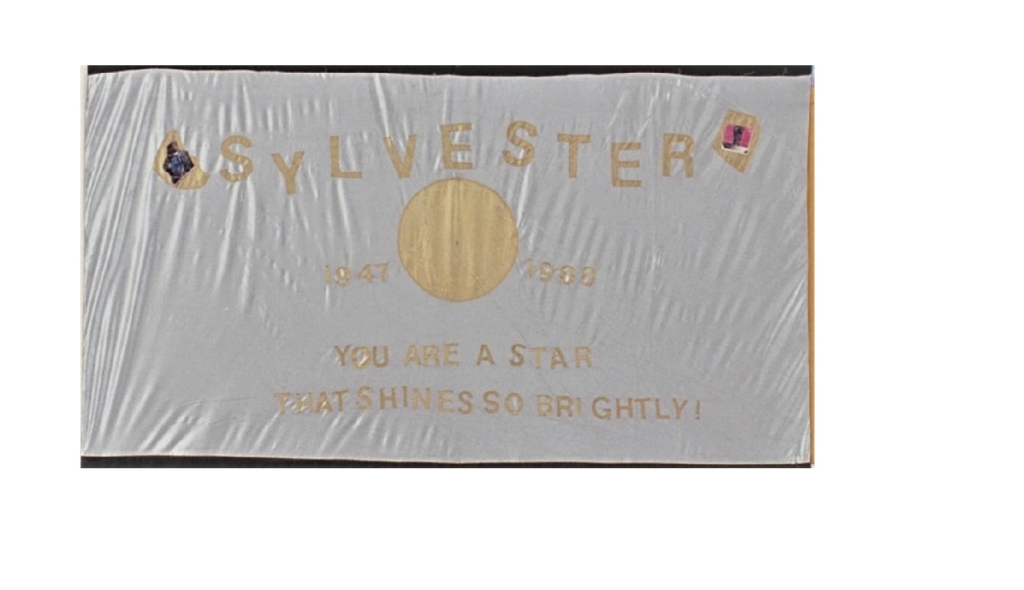
Singer Sylvester dies of AIDS-related illness at age 41. Born Sylvester James, Jr., the black performer is known internationally as “the Queen of Disco.”
Learn More.Famous for his song “You Make Me Feel (Mighty Real),” Sylvester is the lead singer and co-creator of one of the all-time top LGBTQ anthems.
Born in the Los Angeles neighborhood of Watts, Sylvester had been a member of the ’60s group the Disquotays — which was “somewhere between a street gang and a sorority house,” as one former member puts it.
He moved to San Francisco in 1970 at the age of 22 and joined the Cockettes, a “cross-dressing hippy performance art troupe,” and sang blues and jazz standards in his gospel-trained voice in solo segments of the show, writes Alexis Petrides in The Guardian. In the early 70s, he made a bid for mainstream success fronting the Hot Band.
“But the U.S. wasn’t ready for an androgynous black man doing covers of Neil Young songs and A Whiter Shade of Pale,” Petrides writes. “Band members were threatened with violence when they toured in southern states.”
Sylvester’s career was beginning to take hold in 1978, when “Mighty Real” is released on his second solo album and then later as a single. When the song catches fire, he would travel to London to perform to packed clubs and be mobbed by fans. Sylvester would release another 12 albums, many of them featuring top hits and nightclub mainstays. An album containing Sylvester’s final studio recordings, titled Immortal, woud be posthumously released.
Devastated when his partner, Rick Cranmer, died of AIDS-related illness in September 1987, Sylvester suspected then that he was HIV-positive but declined to be tested.
As a persistent cough begins to develop into more serious symptoms, Sylvester is unable to tour but continues performing for fans in the Bay Area. Eventually diagnosed with AIDS, he is hospitalized in May 1988 with pneumocystis pneumonia.
Later in the year, Sylvester attends the Castro’s 1988 Gay Freedom Parade in a wheelchair, joining those marching with the “People With AIDS” banner. Passing crowds along Market Street, Sylvester could hear his name shouted out again and again. He continues to give interviews to the media, seeking to raise awareness about the pandemic’s impact on the black community.
A month later, Sylvester would die in his home at the age of 41. He had planned his own funeral down to the details of how he would be dressed (in a red kimono), how his body would be displayed (in an open coffin), and where the service would be held (in his church, the Love Center, with a sermon by the Reverend Walter Hawkins).
Sylvester’s legacy is such that in 2018, the prestigious University of Sussex in England would host an interdisciplinary academic conference on disco and Sylvester’s contribution to the genre.
* * * * * * * *
Photo of quilt panel from the AIDS Memorial Quilt
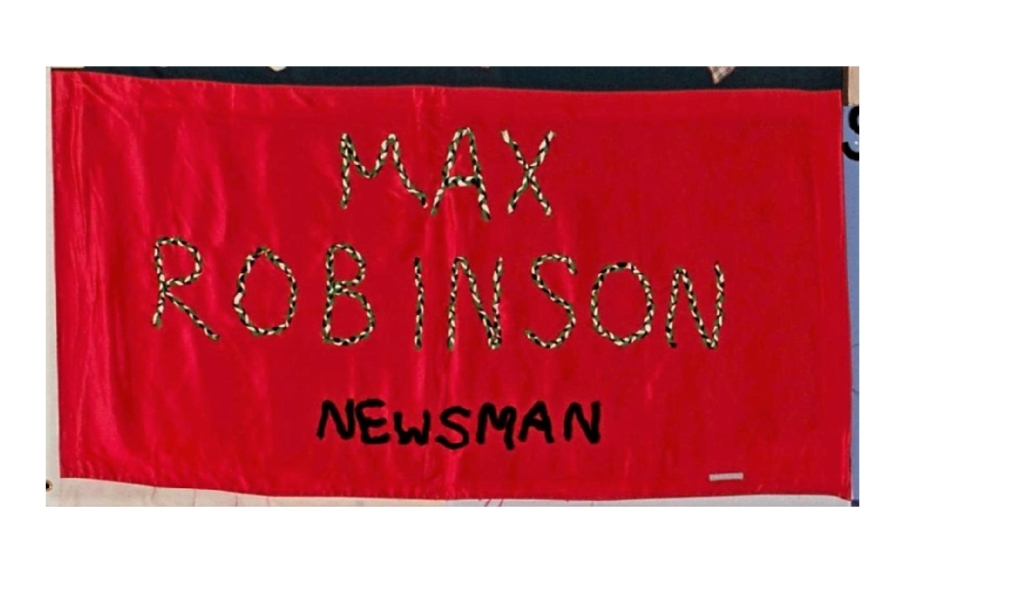
Max Robinson, the first Black network news anchor in the U.S., and a founder of the National Association of Black Journalists, dies of AIDS-related illness at Howard University Hospital in Washington, D.C. He was 49.
Learn More.In July 1978, Robinson rose to national prominence when he became a co-anchor of World News Tonight on the ABC television network. The program had three anchors: Frank Reynolds in Washington, Peter Jennings in London and Robinson in Chicago.
In the early 1970s, Robinson was a co-anchor for the ABC news affililate in Washington, WTOP (now WUSA).
According to The New York Times, Robinson often spoke on issues of concern to him as a Black journalist. Speaking at Smith College in 1981, he told students that the news media were “a crooked mirror” through which “white America views itself,” and that “only by talking about racism, by taking a professional risk, will I take myself out of the mean, racist trap all Black Americans find themselves in.”
Robinson had been ill with AIDS for about a year, his friend Roger Wilkins told the Washington Post.
“During his battle with the disease, Mr. Robinson expressed the desire that his death be the occasion for emphasizing the importance, particularly to the Black community, of education about AIDS and methods for its prevention,” Wilkins said. “More generally, he hoped that people would recognize the urgency of developing effective treatments of the disease and more humane policies towards its victim.”
John Jacob, an acquaintance of Robinson’s and co-chair of the citizens committee on AIDS of New York City and Northern New Jersey, told the Los Angeles Times: “For a long time this disease was seen as a disease of gays. Clearly, there was not the kind of attention given to it that we (Blacks) need to give it. Clearly, drug use is the major factor causing the disease in Black America.”
Jacob said he didn’t know how Robinson was infected with the AIDS virus, and told the LA Times reporter that he should be more focused on raising awareness about the disease.
“I think the one thing we do know is that if you get it, your sentence is death,” Jacob said. “We have to attack this disease whatever the causes are.”
Dr. Beny J. Primm, a member of the President’s AIDS commission and a longtime friend of Robinson’s, also refused to discuss with the LA Times the circumstances under which Robinson got AIDS.
“What’s important,” Dr. Primm said, “is that Max Robinson died of a disease that certainly could have been prevented had certain precautions been taken. I hope he has not died in vain.”
* * * * * * * *
Photo of quilt panel from the AIDS Memorial Quilt
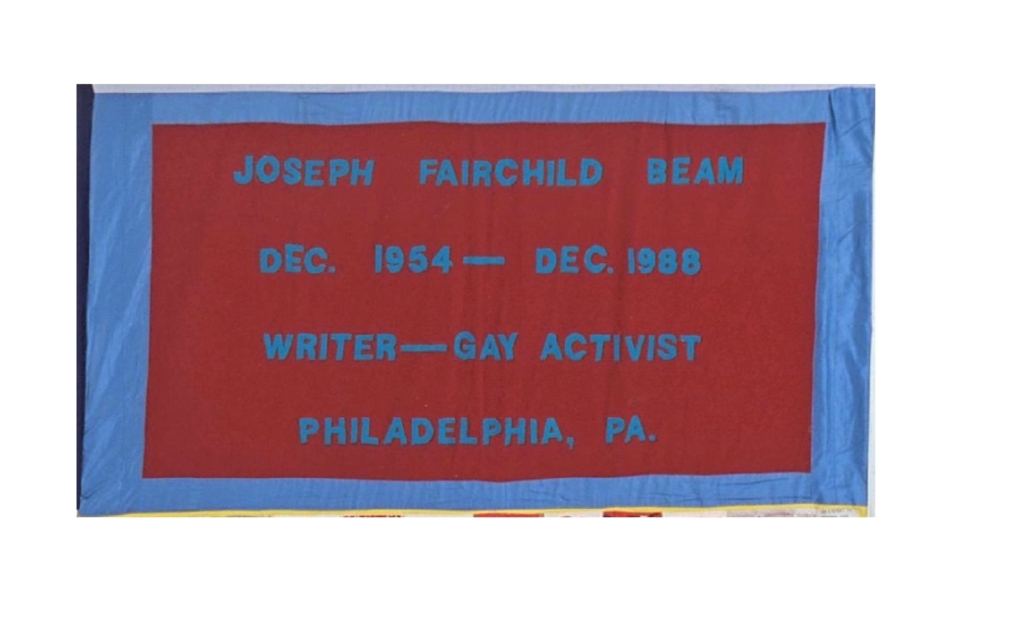
Joseph Beam — best known for editing In the Life, the first collection of writings by gay Black men — dies of AIDS-related illness three days before his 34th birthday.
Learn More.Today, In the Life is widely regarded as a literary and cultural milestone in gay literature.
A native of Philadelphia, Beam attended Franklin College in Indiana, where he studied journalism and was an active member of the black student union and the Black Power movement.
After earning a his master’s degree in communications, Beam returned to Philadelphia in 1979, and explored literature on gay figures and institutions while working at the LGBT bookstore Giovanni’s Room. Discouraged by the lack of community for Black gay men and lesbians, Beam began writing articles and short stories for gay publications.
In 1984, he received an award for outstanding achievement by a minority journalist from The Lesbian and Gay Press Association. In 1985, he became the first editor of Black/Out, a journal produced by the National Coalition of Black Lesbians and Gays.
Beam continued to collect materials about being Black and gay, and find ways to increase their reach. In 1986, he produced the first collection written by Black gay men, called In the Life: A Black Gay Anthology.
When Beam died, he was in the process of compiling the sequel, “Brother to Brother.” His mother, Dorothy Beam, and poet Essex Hemphill would go on to complete the work and publish it in 1991.
* * * * * * * *
Photo of quilt panel from the AIDS Memorial Quilt
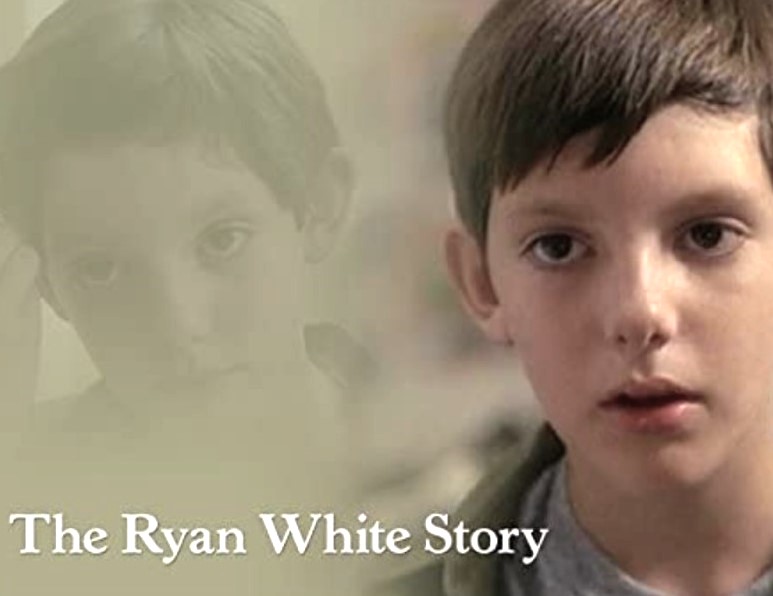
ABC’s The Ryan White Story, based on the true story of a 13-year-old hemophiliac from Indiana who contracts AIDS through a blood transfusion, airs nationwide to an audience of 15 million.
Learn More.The TV drama depicts a young Ryan White (portrayed by Lukas Haas, who was nominated for an Emmy for the role) fighting back after being barred from attending school due to his AIDS diagnosis. Emmy-award-winning actor Judith Light starred as Ryan’s mother, Jeanne White.
Ryan White was featured in a cameo as another hemophiliac with AIDS. White would die of his illness about 15 months later, on April 8, 1990.
With its large viewership during “prime time,” The Ryan White Story was able to make a significant impact on how the public perceived issues around HIV/AIDS.
Claude Duvall, a Bay Area patron of the arts who personally commissioned works with local composers and artists, dies of AIDS-related illness in San Francisco at the age of 47.
Learn More.A resident of San Francisco since 1973, Duvall founded the Noh Oratorio Society in 1981 to present little-heard musical compositions set to literary works, according to the Bay Area Reporter.
“Unique is the way to describe him,” wrote the Reporter. “No one ever spoke in those tones, dressed as he did, thought along his lines, or carved in the world so special a niche.”
The Noh Oratorio Society flourished in San Francisco during the 1980s, largely due to the dedication and creative direction of Duvall. Not only did he personally commission works for the Society, he served as calligrapher, actor, stage director, and litterateur for various productions. The Society’s wide range of artistic interests was grounded in the importance of the human voice and the use of language.
Among the Society’s productions were Michael McClure’s !The Feast! (1982), Chaucer’s Parlement of Fowles (1987), Edith Sitwell and William Walton’s Façade (1987), and Robert Duncan’s Faust Foutu in 1989. The musical-literary productions were presented in various venues in the Bay Area over the course of 15 years.
In 1987, the Society commissioned a concert of Ladies Voices, an opera set to words by Gertrude Stein with music by Charles Shere. Ladies Voices premeired at the Berkeley Art Center with sopranos Judy Ruth Hubbell and Anna Carol Dudley, and mezzo-soprano Marcia Gronewold.
On behalf of the Society, Duvall also published Noh Quarrter, a short-lived and highly admired literary magazine that promoted poetry, essays, short fiction, and experimental prose that was intended to be read aloud.
John Duka, a journalist who wrote with humor and grace about fashion and style, dies of AIDS-related illness in his Manhattan home at the age of 39.
Learn More.According to his wife, Kezia, Duka died of complications stemming from major abdominal surgery in November 1988. She confirmed that he was diagnosed with AIDS the previous year.
Duka began his journalism career in the research department of Esquire magazine. He also worked for Simon and Schuster, Home Furnishings Daily and New York magazine before becoming a columnist at The New York Times.
As a NYT style reporter from 1979 to 1985, he brought a sharp eye and a leveling wit to the world of fashion. His weekly column, “Notes on Fashion,” documented the parallel rise of downtown chic and uptown hauteur, as well as the grand presentations of Paris and Milan. He treated fashion as ”an international sport,” from the punk parade on London’s King’s Road to the retro chic of Republican Washington.
A May 1984 column began: ”One of the requisite skills for sitting at a fashion show is being able to roll your eyes, talk to the person behind you, chew mints and say, ‘Yves Saint Laurent did it better years ago’ all at once.”
But Duka also interviewed celebrities like no one else could. In 1985, he published a very intimate portrait of film star Elizabeth Taylor, who had spent the previous year recovering from drug addiction and alcoholism. In 1984, Duka interviewed Sting, who revealed he was finding his transition from pop star to film actor to be terrifying.
Ruth La Ferla, fashion reporter for The New York Times, recalled: “The son of a Greek waiter, he had, in the course of a two-decade career as a reporter, ad man and public relations guru, fashioned a character, a wry, roguish admixture of Cary Grant and the Duke of Windsor. He was the devil in pinstripes, peppering his columns with the lacerating barbs and dishy mots that made them a must-read for the glitter set.”
Duka left The Times in 1985 to become a founding partner at Keeble Cavaco & Duka, a fashion publicity business that eventually became the most powerful fashion PR agency in the city. He continued to write for magazines like Vanity Fair, Elle and Interview, and he wrote a column, ”Duka’s Diary,” for HG magazine.
It has been speculated that Duka was the model for the character of Felix Turner, the closeted New York Times writer in Larry Kramer’s play The Normal Heart. Duka and Kramer were acquainted, but Kramer never confirmed that Duka was the inspiration for Felix.
“Larry never said to me, ‘This play is about John Duka,’ but some people did,” said Richard Kornberg, the publicist for the original Public Theater production in 1985. “And some of us just thought it.”
La Ferla, Duka’s former colleague at The Times, observed, “He retained a capacity for self-deprecation — much like Felix in the play.”
Just as in The Normal Heart, as Felix lies dying, he quips, “I should be wearing something white … It should be something Perry Ellis ran up for me personally.”

Dancer, singer and choreographer James Tyler — who soloed with the Erick Hawkins Dance Company and the Arnie Zane Company — dies of AIDS-related illness at the age of 48.
Learn More.Tyler also co-founded the men’s dance company Mangrove, and worked with Blake Street Hawkeyes and Ruth Zaporah.
* * * * * * * *
Photo of quilt panel from the AIDS Memorial Quilt

After the supermarket tabloid The Star publishes a story claiming Miles Davis “has AIDS,” the 62-year-old jazz icon releases a statement through his publicist saying the story is untrue.
Learn More.“It’s totally unfounded, totally untrue,” Davis’ manager, Peter Shukat, told the Los Angeles Times.
Due to poor health, Davis had cancelled his winter tour and spent time in a hospital near his Santa Monica home, according to Davis biographer Quincy Troupe.
“I once asked [Davis] point-blank if he had AIDS, and he angrily denied it,” wrote Troupe in Miles: The Autobiography (1989). “I do know that he was always suffering
from bad cases of some mysterious flu-like virus that sometimes confined him to bed, without visitors. Also, a short time after the story in The Star appeared, when I asked him about some pills he was taking, he said they were AZT.”
A few years later, in June 1991, Davis made an appearance at the JVC Jazz Festival in New York, but he was unable to hit the notes his fans grew to expect from him. It would be his final appearance.
“Mr. Davis was incapable of sustaining more than a few notes at a time,” wrote New York Times music critic Peter Watrous. “The spareness seemed less an editorial decision than a decision handed down by physical constraints.”
Shortly before his death at the age of 65 on September 28, 1991, Davis denied being HIV positive in a SPIN magazine interview. The cause of Davis’ death was given as the combined effects of a stroke, pneumonia and respiratory failure, according to reporting in The New York Times.
Wearing sunglasses, a black jacket, a white tee shirt adorned with a huge cross, and denim shorts, iconic performer Madonna dances with the crowd and lesbian friend Sandra Bernhard at AIDS Project LA’s Dance-A-Thon at the Shrine Auditorium in Los Angeles.
AIDS activist and singer Michael Callen releases his album, “Purple Heart.”
Learn More.The album features the song “Love Don’t Need a Reason,” an AIDS anthem Callen co-writes with Marsha Malamet and Peter Allen.
“I feel compelled to get the message out: AIDS is not an excuse to give up on love,” Callen tells Gay LA Times health reporter Victor Zonana.
* * * *

Photographer Robert Mapplethorpe, known for his erotic, sometimes controversial works, dies of AIDS-related illness at the age of 42.
Learn More.In the mid-1970s, as the NYC music scene gave rise to New Wave, Mapplethorpe created austere black-and-white album covers for Patti Smith and the group Television.
He credited his close friend Smith with helping embolden the homosexuality of his early photographic images that dealt with sexual audacity — from sadomasochistic scenes with chains and black leather to an oversized image of male genitals resting atop a pedestal — and that were produced on a large scale.
Soon he would join Andy Warhol’s Interview magazine as a staff photographer, and draw attention for his flattering celebrity portraits.
Despite his diagnosis in 1986 with AIDS, he accelerates his creative efforts, broadens the scope of his photographic inquiry, and accepts increasingly challenging commissions. The Whitney Museum of American Art would mount Mapplethorpe’s first major American museum retrospective in 1988, one year before his death.
The tragic news that Mapplethorpe is ill coincides with the zenith of his critical acclaim as a photographer.
“In my experience, even the most optimistic artists are unable to keep the pain and sadness of AIDS from occasionally surfacing in their art,” writes Paul Martineau, associate curator in the Department of Photographs at the J. Paul Getty Museum.
“Mapplethorpe was no exception,” Martineau continues. “While studying his photographs, I noticed a perceptible shift in the emotional tone of his self-portraits occurred in 1986: the year he was diagnosed with AIDS. In 1988, while the disease wreaked havoc on his body, Mapplethorpe used the camera as a means of taking artistic control over what was happening to him.”
In February 1989, Mapplethorpe would speak openly to Vanity Fair contributor Dominick Dunne.
“I’m quite frustrated I’m not going to be around to enjoy [my success],” Mapplethorpe tells Dunne. “The money’s coming in, though. I’m making more money now than I’ve ever made before.”
In his feature on Mapplethorpe, Dunne writes about how the photographer’s health status had become the topic of speculation in January 1987, when New York aristocrat and art collector Sam Wagstaff died of AIDS-related illness.
“Mapplethorpe, the principal inheritor of Sam Wagstaff’s fortune, had once been Wagstaff’s lover and later, for years, his great and good friend,” Dunne writes.
Mapplethorpe tells Dunne that he has two nurses on twelve-hour shifts that cost him $1,000 a day and he has been on AZT for two years. He expresses concern about friends who are facing the same illness with fewer financial resources, specifically his black friends.
“Most of the blacks don’t have insurance and therefore can’t afford AZT,” he says. “They all died quickly, the blacks. If I go through my Black Book, half of them are dead.”
The year before his death, Mapplethorpe establishes the Robert Mapplethorpe Foundation to protect his work, to advance his creative vision, and to fund HIV/AIDS research. In its early years, the Foundation created medical facilities and programs, including the Robert Mapplethorpe Laboratory for AIDS Research at Harvard Medical School in Boston, the Robert Mapplethorpe Residential Treatment Facility at Beth Israel Medical Center in New York, and the Robert Mapplethorpe Center for HIV Research at St. Vincent’s Hospital, New York.
Serving as the first president on its board of trustees, he established mandates of furthering the recognition of photography as an art form having the same respect as painting and sculpture and supporting AIDS and HIV medical research.
In late winter 1989, Mapplethorpe is in Boston for a medical treatment when his condition worsens, according to Susan Arthur of the Robert Miller Gallery in New York City, which represents the artist.
He died at New England Deaconess Hospital at the age of 42. His body was cremated and his ashes are interred at St. John’s Cemetery, Queens in New York City, at his mother’s grave-site, etched “Maxey.”
In 2011, the Mapplethorpe Foundation would donate its archive to the Getty Research Institute and give a collection of artworks to the J. Paul Getty Museum in partnership with the Los Angeles County Museum of Art.
* * * * * * * *
Photo of quilt panel from the AIDS Memorial Quilt
Poet and performance artist Chasen Gaver dies of AIDS-related illness at his Washington, DC home. He was 35.
Learn More.Chasen Gaver was best known for his performance work that combined poetry readings with theatrical touches such as costumes, lighting and sound effects. Gaver had given performances in more than 100 locations in the Washington, DC area since moving there in the mid-1970s, according to The Washington Post.
In early 1988, he and Washington artist Judy Byron put on the show In Common: Arlington County Observed at the Arlington Arts Center. The show, which celebrated the ethnic and cultural melting pot of Arlington, Virginia, featured recorded poems by Gaver set against murals and paintings by Byron. Among Gaver’s poems included in the production were “Personality Cult,” “Daddy!” and “Jumping to Conclusions.”
Gaver had also collaborated on shows with jazz pianists, dancers and actors, and spent three years teaching his performance poetry technique to junior high students in DC public schools.
In addition to his literary career, Gaver worked as a paralegal for the Federal Trade Commission until 1987 and received the FTC’s award for distinguished service. He contributed articles and reviews to The Washington Blade, and was a member of Black Artists/White Artists, Black and White Men Together, and the National Organization for Women.
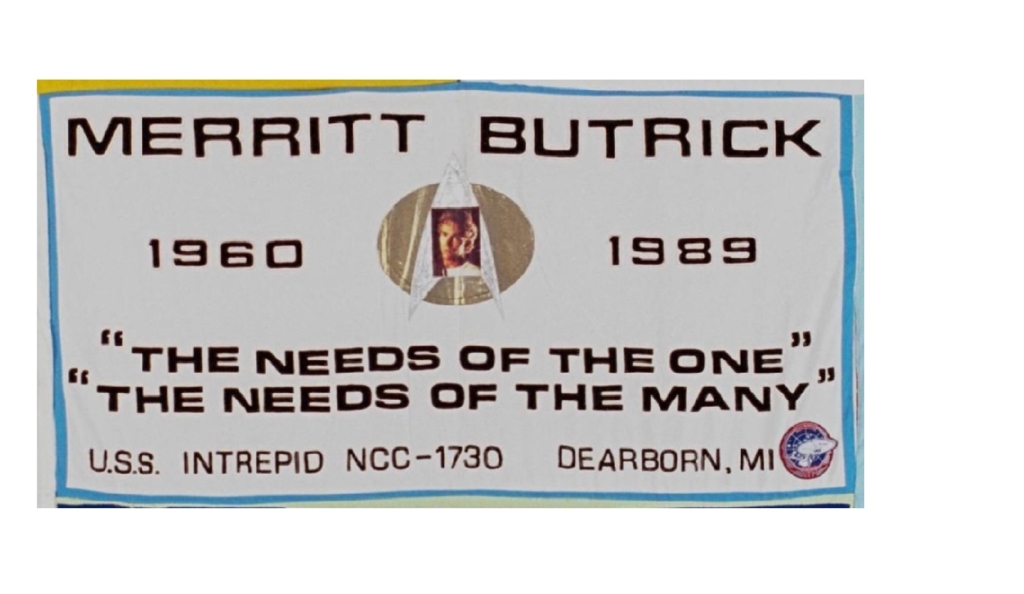
‘Star Trek’ film actor Merritt Butrick dies of AIDS-related illness at the age of 29.
A native of Gainesville, Florida who grew up in the San Fransisco area, Butrick portrayed Dr. David Marcus, son of James T. Kirk and Dr. Carol Marcus, in two movies: Star Trek II: The Wrath of Khan and Star Trek III: The Search for Spock.
“I’m part of a legend,” said Butrick about his work on the Star Trek films. “I gave what I had to give at the right time and place for my own personal gratification. I look at my resume at this point and it reminds me of how well I’ve done in the few years I’ve done it.”
Butrick had just been cast in ST II after starting work as a regular on the short-lived but critical and cult favorite 1982 “new wave” high school series Square Pegs, playing Johnny “Slash” Ulasewicz opposite an equally young Sarah Jessica Parker and Jamie Gertz.
At the time of his death, he had recently received critical praise on stage for his role as a male prostitute in the play Kingfish.
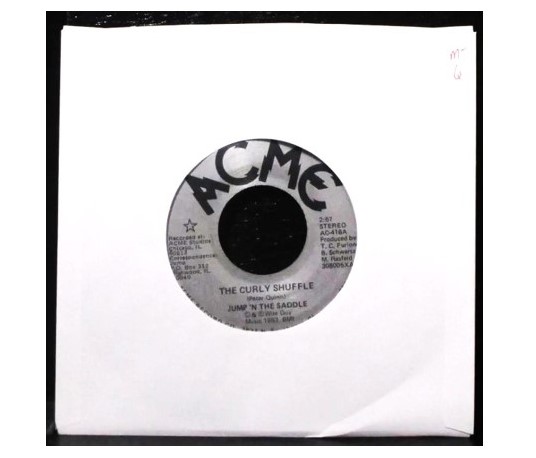
Michael “Mike” Rasfeld, a Chicago recording artist who created the ultimate hang-out for the music community, dies of AIDS-related illness at the age of 37.
Learn More.Rasfeld started the Acme recording studio in 1973, and in the years that followed, he became an important link among people in the Chicago performing arts scene.
“I first met Michael Rasfeld in 1971, when he was running sound and lights for the Godzilla Rainbow Troupe at the old Kingston Mines Theater,” wrote Albert Williams for the Chicago Reader.
An unofficial offshoot of Charles Ludlam’s Ridiculous Theatrical Company in New York, Godzilla Rainbow Troupe was pursuing a pansexual, fantastical, outrageous style of theater and served as a launching pad for several of Chicago’s most distinctive talents.
Rasfeld’s recording studio, located in a storefront in the Lakeview neighborhood, achieved some notoriety in 1983 when it produced the novelty song “The Curly Shuffle” by Jump’n The Saddle.
Rasfeld attended a live show of Jump’n The Saddle, where the audience went wild for their song “The Curly Shuffle.” He offered to record and co-produce the song and release it on Acme Records, according to the Mike Rasfeld website.
Once recorded, Rasfeld pushed “The Curly Shuffle” to Chicago radio stations and almost instantly it became the Number 1 record in the city. By November, it was the Number 15 song in the U.S.
Then Atlantic Records signed Jump’n the Saddle to an album deal, and Acme was booked to work on the album. Rasfeld also went on tour with the band to be their sound technician. But when it became apparent that there were no more novelty hits on the album, Atlantic decided not to promote the tour or the album.
Still, the advance from Atlantic gave Rasfeld some financial relief for his business. Better yet, he was able to bring notable musicians — including Pinetop Perkins, Magic Slim, and Dizzy Gillespie — into Acme to record.
In 1988, Rasfeld invested in CD mastering technology and became the only studio in Chicago able to make the special audio master for CD’s. The same year, he began teaching a recording class at the studio for Columbia College.
That was also the year Rasfeld was diagnosed with AIDS. His last project was a jazz record by veteran Second City music director Fred Kaz.
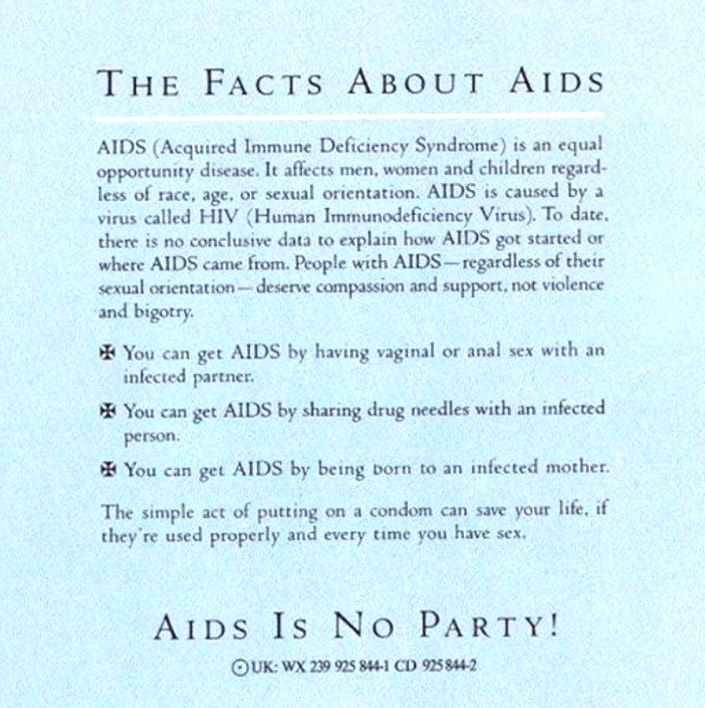
Pop star Madonna includes a leaflet titled “The Facts about AIDS” in the sleeve of her album Like a Prayer.
Learn More.The leaflet, which described HIV/AIDS as “an equal opportunity disease,” delivered straight-forward information for everyone to consider, such as: “People with AIDS – regardless of their sexual orientation – deserve compassion and support, not violence and bigotry.”
This was followed by three simple facts on how you could get infected with HIV, and then an equally simple message urging her fans to use condoms.
Like A Prayer was Madonna’s fourth studio album and it was considered her most introspective release to date, a “confessional album.” The album received universal acclaim from music critics and fans, but the inclusion of the safe sex pamphlet was considered controversial, according to In magazine.
Luckily, Madonna seemed to thrive in controversy, and the sly move only strengthened her bond with the gay and trans communities.
With roots in the dance world, Madonna had already lost a number of close friends to AIDS by this time, including her best friend and former roommate Martin Burgoyne. In August 1986, Burgoyne was diagnosed with AIDS-related complex (ARC), as it was called then. Madonna said that as Burgoyne’s health declined, she helped care for him, paid his medical expenses at St. Vincent’s Hospital, and leased an apartment for him close to his medical caregivers, according to Attitude magazine.
She said she will never forget how, on November 30, 1986, she held Burgoyne’s hand while he died. He was only 23 years old.
“Madonna would ultimately teach me more about sex than I ever learned at school,” wrote Savas Abadsidis in HIV Plus magazine in 2018. “It’s probably hard for younger folks to recall a world where Madonna didn’t exist — so it’s equally hard for them to understand what an indelible impact she had.”

Elwood Thornton, a baritone who performed with Oakland Symphony, dies of AIDS-related illness at the age of 45.
Learn More.Thornton also sang with the San Jose Symphony, and performed at the Midsummer Mozart Festival and other local classical music events.
* * * * * * * *
Photo of quilt panel from the AIDS Memorial Quilt

Christopher Bernau, who was one of the first openly gay actors in the world of TV soap operas, dies of AIDS-related illness at the age of 49.
Learn More.Most famous for his role as Alan Spaulding on Guiding Light, Bernau delighted audiences with his portrayal of a complex villain with the “vices of the middle class” and “virtues of industrial America.”
Bernau trained in the drama department at the University of California Santa Barbara before getting his big break, appearing in the New York Shakespeare Festival’s 1962 production of Antony and Cleopatra. In 1964, he joined the national tour of Who’s Afraid of Virginia Woolf?
These roles, in addition to performing at Canada’s Stratford Festival, led to an appearance in a story arc on cult Gothic soap opera Dark Shadows from 1969 to 1970. On the show, he created the role of Philip Todd and appeared in 22 episodes.
His most famous role, however, was that of villain Alan Spaulding on the soap opera Guiding Light, a role he played from 1977 to 1984 and again from 1986 until shortly before his death in 1989. Bernau began performing on Guiding Light in 1977 while he was still in the Cherry Lane Theatre production of The Passion of Dracula. In the comic take on the vampire tale, Bernau performed the title role and was credited by The New York Times as achieving “a fine. balance between the awesome and the ridiculous.”
Bernau continued to work on Guiding Light for as long as he could after being diagnosed with AIDS.
Two weeks after his death, cast members held a memorial service for Bernau in Manhattan. On Friday, July 13, 1989, the closing credits of that day’s episode of Guiding Light included a tribute to Bernau and his work.
Stephen D. Hassenfeld, the chief executive officer of Hasbro who restored the company’s reputation as the world’s largest toy manufacturer, dies of HIV-related illness at Columbia Presbyterian Medical Center in New York City. He was 47 years old.
Learn More.Hasbro’s domination of the toy manufacturing field in the 1980s was attributed to Hassenfeld’s aggressive acquisition of other toy manufacturers, such as Milton Bradley, Playskool, Child Guidance toys, and Coleco Industries, the maker of Cabbage Patch dolls.
The company’s success was also based in large part on the success of its G.I Joe line of 3½-inch plastic soldiers and of Transformers, toys that converted from vehicles to robots.
Hassenfeld was the first-born son who became Hasbro’s chief executive after his father died in 1980, according to Family Business magazine. Over the course of a decade, he would build Hasbro into the largest toy manufacturer in the world, rated #1 by Forbes.
“Hasbro had also cultivated the casual culture of a family business in style as well as fact — the kind of company where executives wear open-collared sport shirts to the office, and where employees are invited to Hassenfeld weddings and bar mitzvahs and given financial help for sickness, college bills, or family problems,” wrote Dan Rottenberg of Family Business magazine.
In late July 1987, Hassenfeld’s declining health forced him to miss ten weeks of work, and he did what he could to manage the company from his New York apartment. He returned to the office in October, announcing that he had endocarditis, a heart condition, and was fully recovered.
Over the course of the next year, however, Hassenfeld took steps to protect the company in the event that he should die. Most significantly, Hassenfeld and his brother Alan reorganized the company’s management structure in December 1988, just six months before Hassenfeld’s death.
When Hassenfeld was hospitalized in May 1989, Hasbro stock shot up in heavy trading amid rumors that the company would be sold. Alan Hassenfeld summoned an emergency board meeting and vowed to maintain the company’s family identity, according to Family Business magazine.
Within two weeks of Stephen Hassenfeld’s death, the board elected Alan to succeed him as chairman and CEO.
“My brother taught me a lot — probably almost everything I know about this business,” Alan told Family Business magazine. “This isn’t meant to sound hokey, but many times if I’m trying to think a situation out, I’ll still sit and talk to my brother. In some cases, I don’t totally admit that my brother’s not here.”
Stephen Hassenfeld’s legacy continues with the charitable organizations he established during his lifetime: the Hasbro Charitable Trust, Hasbro Children’s Foundation, and the Stephen D. Hassenfeld Children’s Center for Cancer and Blood Disorders, according to Ken Gault of Think Queerly.

Steve Rubell, co-founder of the world-famous Studio 54 nightclub, dies at Beth Israel Medical Center in New York at the age of 45.
Learn More.Owning and operating Studio 54 in Manhattan from its opening on April 26, 1977 until 1979, Rubell and his business partner Ian Schrager hosted celebrities, society figures and crowds of clubbers. The nightclub became the global epicenter of the disco craze and featured live appearances by music stars like Grace Jones, Donna Summer and Gloria Gaynor.
The venue’s location at 254 West 54th Street was an opera house in the 1920s, and then became a television studio in the 1950s and 1960s, housing productions of the game show Password and the children’s show Captain Kangaroo.
The space was converted into the world’s most famous nightclub by Rubell and Schrager, who met while attending Syracuse University. Behind the scenes, public relations expert Carmen D’Alessio lured celebrities she knew from the fashion industry to come to Studio 54 and play. With connections like Bianca Jagger, Liza Minnelli, Andy Warhol and Truman Capote, D’Alessio built a buzz around the club that drew attention from the media and throngs of young people hoping to cross the velvet ropes into a world where anything could happen.
Rubell often worked the club’s front door, selectively admitting celebrities and spurning others queued outside. In January 1980, Mr. Rubell and Schrager were sentenced to 3½ years in prison for tax evasion, but they reduced their sentences by turning in several other club owners. They sold Studio 54 shortly after their release from prison in January 1991, and then opened a new club, the Palladium, which would become just as popular.
In the film Studio 54 The Documentary, Rubell’s brother, Dr. Donald Rubell, said, “I was the one who told him he had AIDS.”
Dr. Rubell recalled that his brother had “vague symptoms” of HIV infection, and so he administered the test.
“You have to remember at that time AIDS wasn’t a disease,” he says. “It was a condemnation. So he wouldn’t let me tell our parents.”
Rubell’s funeral at the Riverside Chapel on Amsterdam Avenue and 76th Street would be attended by some of his most famous patrons, including Calvin Klein and Keith Haring. His body is buried at Beth Moses Cemetery in Farmingdale, New York.
* * * * * * * *
Photo of quilt panel from the AIDS Memorial Quilt
Sources:
History.com / A&E Television Networks
The New York Times
The Washington Post
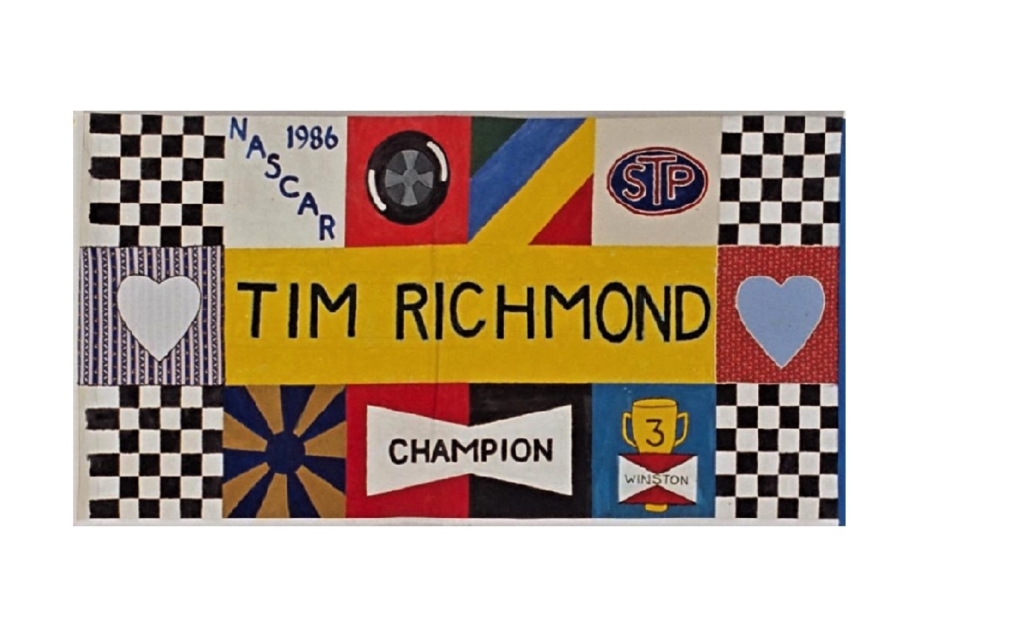
Race car driver Tim Richmond dies of AID-related illness at the age of 34.
Learn More.One of auto racing’s brightest stars, Richmond is the inspiration behind much of the film Days of Thunder, starring Tom Cruise.
The 1980 Indianapolis 500 rookie of the year, Richmond was involved in an Indy car crash where his car was sliced in two at Michigan International Speedway, and was persuaded to switch to stock cars. By 1986, Richmond would win seven races in three months.
Shortly after his most victorious season, Richmond would suffer a near-fatal bout of pneumonia and receive a diagnosis of HIV-positive. Still, Richmond would regain his health enough in 1987 to return to NASCAR for an eight-race run that brought him wins at Pocono and Riverside, California.
Unaware of his illness, other drivers accused Richmond of being a drug user and persuaded NASCAR to test him. When drug tests were inconclusive, NASCAR asked to see Richmond’s medical records. Richmond refused and filed a defamation suit against NASCAR that was settled out of court when it was ruled that his medical records were relevant to the case.
In 1988, NASCAR would suspend Richmond for what the organization said was violation of its drug policy. Although NASCAR later lifted the ban, Richmond would never drive again.
According to the film Tim Richmond: To the Limit, Richmond spent his final days in seclusion. After Richmond’s death, numerous women would claim that he infected them with the AIDS virus.
* * * * * * * *
Photo of quilt panel from the AIDS Memorial Quilt
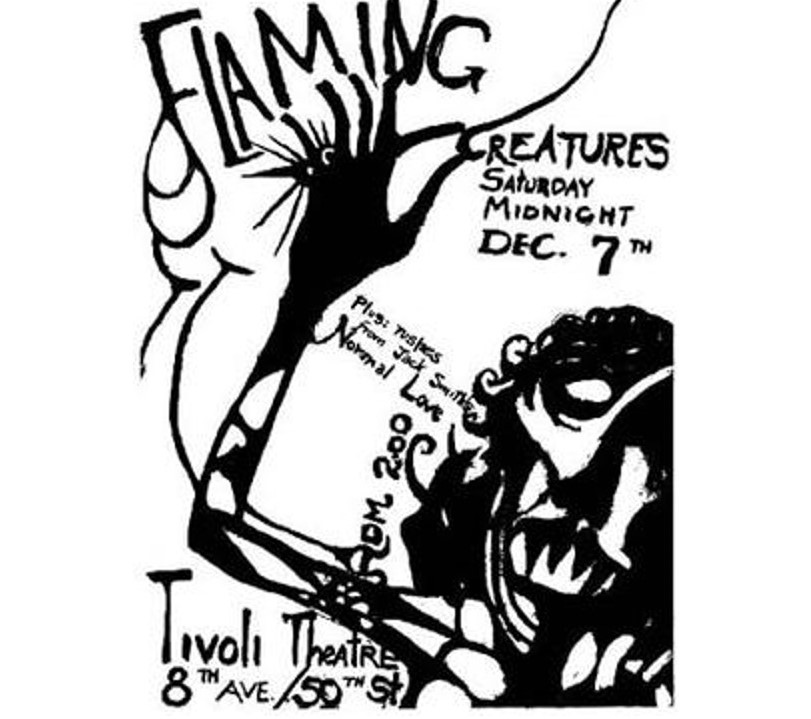
Jack Smith, a pioneer of underground cinema and the director/ cinematographer of Flaming Creatures, dies of AIDS-related illness at Beth Israel Hospital in Manhattan. He was 57.
Learn More.Smith was considered by many to be the founding father of performance art, and was recognized as a master photographer. The most famous of Smith’s works is Flaming Creatures (1963), a film that prompted a series of New York Police Department raids on downtown screenings of the 45-minute film.
During a screening of Flaming Creatures on March 3, 1964, police seized the 16mm print and the projection equipment, and arrested event producer Jonas Mekas, theater manager Ken Jacobs and ticket taker Florence Karpf on charges of obscenity.
In the trial that followed, esteemed writer Susan Sontag would testify on behalf of the defense to the film’s status as a work of art. Sontag saw Flaming Creatures as an intentionally outrageous and funny spoof of Hollywood B movies, but she also insisted that the film was “a small but valuable work in a particular tradition, the poetic cinema of shock.”
”The only thing to be regretted about the close-ups of limp penises and bouncing breasts, the shots of masturbation and oral sexuality, in Jack Smith’s Flaming Creatures is that it makes it hard simply to talk about this remarkable and beautiful film, one has to defend it,” Sontag wrote in the April 13, 1964 issue of The Nation.
However, New York officials considered some scenes to be pornographic and copies of the 45-minute movie were confiscated wherever it was screened. The movie gained additional notoriety when footage was screened during Congressional hearings and right-wing politician Strom Thurmond mentioned it in anti-porn speeches.
“The case remains one of the most notorious public battles over artistic freedom of expression in American movies,” wrote Michael Koresky for the Lincoln Center’s Film Comment.
Filmed on the roof of Smith’s Loisaida studio apartment with reportedly stolen film stock and a basic 16mm camera, Flaming Creatures represented the independent spirit of The New American Cinema.
Film Affinity USA/UK wrote: “The orgy scene in the film is perhaps the greatest combination of art and film. [It] plays like a tragic meeting of the old America with the freshly birthed new morality in America. What is even more remarkable is the ‘earthquake’ caused by Smith’s shaking camera at the end of the orgy. It is as if the world is opening up on Smith’s creatures and swallowing them and all their perversions. The spirit of the film is the reason it should be preserved for generations to come.”
Apart from filmmaking and occasionally appearing in his own work, Smith worked as an actor. He played the lead in Andy Warhol’s unfinished film Batman Dracula, Ken Jacob’s Blonde Cobra, and appeared in several theater productions by Robert Wilson. He also worked as a photographer and founded the Hyperbole Photographic Studio in New York.
After his last film, No President (1967), Smith turned his attention to performance art. He also spent the months leading up to his death transforming his home into an elaborate stage set for a never-to-be-filmed work, Sinbad in a Rented World.
About a month after Smith’s death, friends held a memorial service at Performance Space 122 in the East Village.
New York performance artist and AIDS activist Penny Arcade tried to preserve Smith’s apartment as a museum dedicated to Smith and his work, but the effort failed. Smith’s archival works were legally awarded to his estranged sister and ultimately purchased by the Gladstone Gallery in New York
Kenneth J. Lackey, film critic for Drummer magazine, dies of AIDS-related illness at San Francisco’s Hospice By The Bay at the age of 35.
Learn More.By day, Lackey was on the editorial staff of Desmodus Inc., publishers of Drummer. By night, he was the star server at Church Street Station, charming the after-bar crowds and taking dozens of meal orders without writing anything down and never making a mistake.
Lackey also had an amazing memory for film trivia, according to the Bay Area Reporter.
“If you ever had a question about a film, a star, a producer or director (including Oscar, Emmy, Grammy and Tony Award winners), Ken was the man to ask, including a biographical sketch thrown in for good measure!” wrote the Bay Area Reporter.
Prior to moving to San Francisco, Lackey attended George Washington University, where he studied theater, and worked as a model in New York.
Paul Shenar, best remembered for his performance as the drug lord Alejandro Sosa in Scarface, dies of AIDS-related illness at the age of 53.
Learn More.Born and raised in Milwaukee, Wisconsin, Shenar moved to New York City after graduating from the University of Wisconsin. He debuts on Broadway in Tiny Alice as Brother Julian, and continues to work on the NYC stage for several years.
In 1965, Shenar would move to Philadelphia to help found the American Conservatory Theater, where he is not only a regular performer throughout his career, but a teacher and advisor as well.
From there, roles on television and the big screen would follow. In 1975, Shenar portrays Orson Welles in the television movie The Night That Panicked America, receiving received some of the best reviews of his career. He continues working steadily on television through the end of the decade, and in the early 1980s starts receiving feature film roles.
In 1983, Shenar delivers a memorable performance as the diabolical Colombian drug lord Alejandro Sosa in Brian De Palma’s Scarface. Other notable roles are Dr. Lawrence in Luc Besson’s The Big Blue (1988), Joshua Adams in Deadly Force (1983), Paulo Rocca in the Arnold Schwarzenegger film Raw Deal (1986), and Ben Gardner, the father of a troubled Kristy McNichol, in Alan J. Pakula’s Dream Lover (1986).
Shenar would die in West Hollywood.
Critically acclaimed actor Michael Carmine dies of AIDS-related illness at his home in Manhattan. He was 30 years old.
Learn More.Born in Brooklyn, Carmine graduated at the age of 16 from the High School for the Performing Arts in 1975, and then attended the California Institute for the Arts.
Carmine won critics’ praise for his performance in Off Broadway and Broadway productions of Reinaldo Povod’s play Cuba and His Teddy Bear. He created the role of Papo in another Povod play, La Puta Vida.
Among his screen credits are Batteries Not Included, Scarface and Turk 182; on television, he appeared in episodes of Search for Tomorrow, Hill Street Blues, M*A*S*H, and Miami Vice. His final TV appearance was in 1988’s Tour of Duty, and his final film role in Longtime Companion was released nearly a year after his death.

Alan Murphy, a U.K. guitarist with a long pedigree of contributions to new wave bands, dies of AIDS-related illness at Westminster Hospital. He was 35.
Learn More.Murphy played guitar with Kate Bush, Go West, Mike + the Mechanics, and Level 42, among many others.
Murphy’s big break came in late 1978, when he was invited to audition for the Kate Bush band as a second guitarist for an upcoming tour. He was nervous, according to the Alan Murphy tribute site, because he wasn’t familiar with Kate Bush’s quirky musical style.
“Alan was offered the job, mainly he felt due to Kate being impressed with the way he made whale noises,” according to Lenny P.
After touring in 1979 with Kate Bush, Murphy joined her in the studio to record tracks for Never for Ever (1980). This was the first album he had worked on as a full-fledged band member and not just a studio musician.
Murphy also formed a band called The Stapleton All Stars, named after a London pub called The Stapleton. They later changed the name to SFX. The Fender guitar company arranged for the band to play their products during pub promotions from 1981 to 1983.
In 1984, Murphy performed a guitar solo on Nick Heyward’s single “Warning Sign.” Next, Peter Cox and Richard Drummie formed Go West and brought in Murphy to help them build their sound. Chrysalis released Go West’s eponymous 1985 album and Daning on the Couch (1987). On the latter release, Murphy played keyboards, guitars, guitar solos, percussion on various tracks.
While touring in the U.S. with Go West, Murphy began to feel fatigued and sought medical care at a stop-over in San Francisco. Go West front man Peter Cox later realized that it was at that time when Murphy likely learned he was HIV positive.
In 1987, Murphy joined Level 42 — already an established act on the Polydor label — and performed on the 1988 album Staring At The Sun, which was recorded at Miraval studios in France.
“We had a new album, a hit single with ‘Heaven In Our Hands,’ and it all looked like business as usual, but with a slightly rockier edge,” Level 42 bass guitarist Mark King told The Express in 2016.
“But then, sadly, within 18 months Al Murphy became ill with AIDS and died in 1989. It was awful.”
Shortly before his death, Murphy played acoustic guitar on a Kate Bush cover of the Elton John/Bernie Taupin hit “Rocket Man,” and in 1991 it was released as a track on Two Rooms, a John/Taupin tribute album. The music video featured a guitar and lit candle on an otherwise empty chair.

Olympic champions and other world-class skaters assemble in New York City to perform in “Skating for Life – A Celebration of Champions,” a benefit for HIV/AIDS support programs.
Learn More.Featuring 24 skaters, the show transformed the New York State Armory at Lexington Avenue and 26th Street into a winter wonderland with a skating rink and lit holiday trees. The benefit was produced by the Design Industries Foundation for AIDS, which was made up of professionals in the fashion, textile, interior design and related fields.
British figure skater John Curry dazzled the audience with a solo performance that incorporated mime and then again in a romantic duet with U.S. champion skater Judy Blumberg.
“The image of Mr. Curry as the epitome of a ballroom dancer is new,” wrote New York Times dance critic Anna Kisselgoff. “But unwinding in and out of embraces, he and Miss Blumberg, a first-rate dramatic skater, made for a picture in tenderness.”
Curry’s final appearance would be later that month in “Ice Stars’ Hollywood Revue,” a CBS special. He would die on April 15, 1994 from complications of AIDS.
A five-time British Champion and gold medalist in the 1976 Olympics, Curry is still remembered as one of the greatest stylists and artists in figure-skating history.
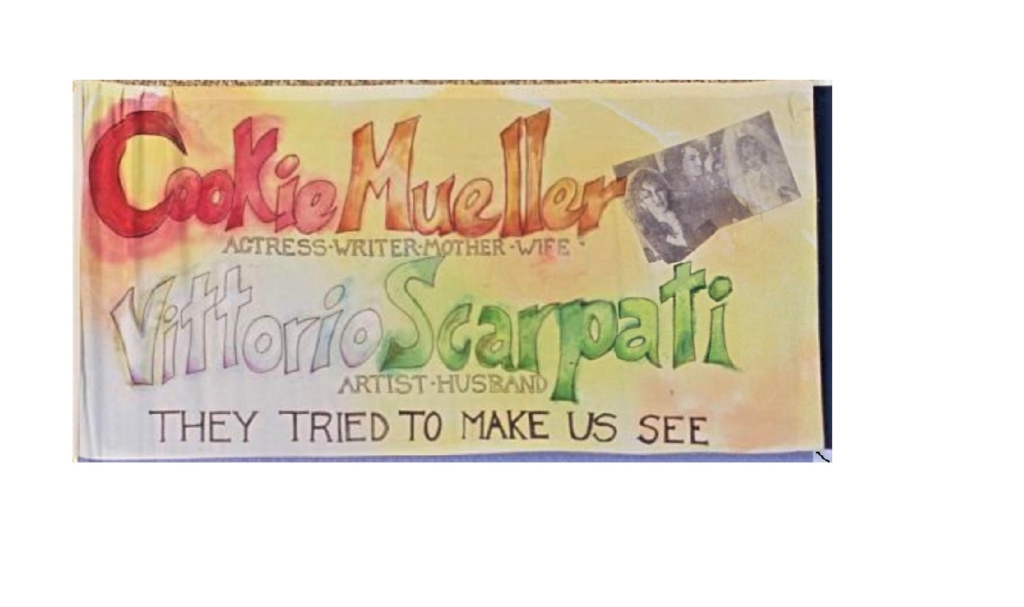
Cookie Mueller, a key member of film director John Waters’ Dreamlanders ensemble, dies from AIDS-related causes in New York City at age 40.
Learn More.Mueller would meet John Waters at the premiere of his 1969 film Mondo Trasho. Cookie went on to join Waters’ Dreamlanders ensemble and would act in five movies for Waters.
Moving to New York City in 1976, she became a cocaine dealer and writer. She wrote the health column “Ask Dr. Mueller” for the East Village Eye, was an art critic for Details magazine, and wrote the novella Fan Mail, Frank Letters, and Crank Calls, the memoir Walking Through Clear Water in a Pool Painted Black, and several collections of short prose.
Mueller became a muse to many of the photographers and directors of the NYC art/music/film scene. She would have her portrait taken by Robert Mapplethorpe, and appear in Amos Poe’s Subway Riders, Edo Bertoglio’s Downtown ’81 and Michel Auder’s A Coupla White Faggots Sitting Around Talking. She also would be featured prominently in her friend Nan Goldin’s iconic The Ballad of Sexual Dependency.
Goldin would later recall that she was with Mueller on Fire Island in New York when they first learned of AIDS in 1981, referred to as a “gay cancer” at the time. “Cookie just started reading this item out loud from The New York Times about this new illness… we all kind of laughed it off.”
By 1985, many of Golden’s close friends and acquaintances would be diagnosed with the virus, including Mueller.
Goldin would write in ASX: “We were very obsessed with what caused it: There were all kinds of rumors, everything from amyl nitrate to bacon. I was in denial that people were going to die. I thought people could beat it. And then people started dying.”
In 1986, Goldin would photograph Mueller’s wedding to Vittorio Scarpati. An artist who was an HIV-positive heroin addict, Scarpati would create a heartbreaking series of whimsical deathbed drawings of himself and Mueller.
Scarpati would die in 1988, and Goldin would photograph Mueller, by that time walking with a cane, beside her husband’s casket. After Scarpati’s death, Mueller’s health would begin a steep decline.
“When I went to see Cookie in Provincetown, she had lost her voice,” recalls Goldin. “Her laughter and her verbal wit had been so much of her personality. The fact that she couldn’t talk, the fact that she couldn’t walk without a cane was so devastating that I was calling every doctor, screaming at the impotence I felt.”
Shortly before her dealth, Mueller would write in her final column for the East Village Eye:
“Fortunately I am not the first person to tell you that you will never die. You simply lose your body. You will be the same, except you won’t have to worry about rent or mortgages or fashionable clothes. You will be released from sexual obsessions. You will not have drug addictions. You will not need alcohol. You will not have to worry about cellulite or cigarettes or cancer or AIDS or venereal disease. You will be free.”
* * * * * * * *
Photo of quilt panel from the AIDS Memorial Quilt
La Cage aux Folles actor Rémi Laurent dies of AIDS-related illness in Paris at the age of 32.
Learn More.Born and raised in Suresnes, Laurent starred in a number of French films in the late 1970s and 1980s, but he is best known for his role in the film La Cage aux Folles as Laurent, the son of Renato Baldi.
Laurent also had roles in Les Plouffe (1981) and Let’s Get Those English Girls (1976).
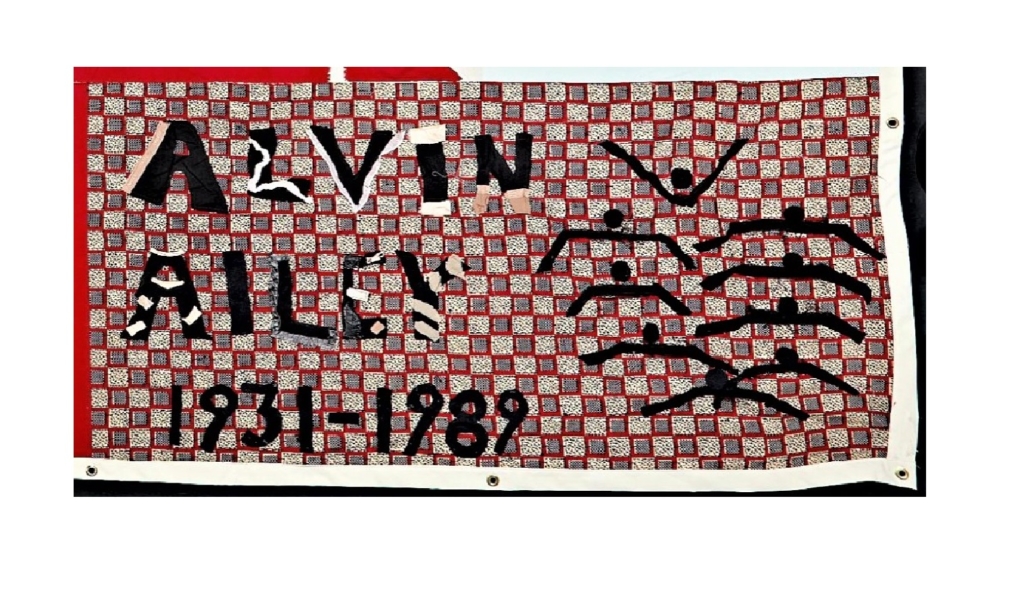
Alvin Ailey, the African American choreographer and activist who founded the Alvin Ailey American Dance Theater and the Ailey School in New York City, dies of AIDS-related illness.
Learn More.Ailey’s early childhood would be spent in Texas during the Jim Crow era, a time and place that would inspire some of his most iconic choreography. He discovered dance after moving to Los Angeles but didn’t fully commit to the art form at first.
Then, in the mid-1950s, Ailey would join the Lester Horton Dancers, later becoming a choreographer and then director of the company. In 1958, he decided to open his own dance company, establishing the Alvin Ailey American Dance Theater in New York City.
Ailey and a group of young, black modern dancers perform for the first time on March 30, 1958 at New York’s 92nd Street YM-YWHA. In its first years, the Company would travel to booked performances on what Alvin Ailey called “the station wagon tours” in a vehicle driven by a longtime friend of the Company, Mickey Board.
In 1960, he would choreograph his classic masterpiece Revelations, which brings the Company international acclaim.
Over the next 30 years, Ailey would create ballets for many notable companies, including the American Ballet Theatre, Royal Danish Ballet, London Festival Ballet, the Joffrey Ballet, and Paris Opera Ballet.
“As common practice at the time, Ailey maintained a closeted persona regarding his sexuality but would utilize his art as an outlet for it,” writes Smithsonian in the website for the National Museum of African American History & Culture.
“His choreographed ballets for AAADT exhibited imagery reminiscent with male and female homosexuality such as juxtaposing same-sex partnering with religious and hypermasculine archetypes.”
Although Ailey dated intermittently, he wouldn’t find long-term companionship while trying to conceal his sexuality from much of the world. And when he dies amid the AIDS epidemic, his doctor reports the cause of his death as a rare blood disease.
Among the many posthumous accolades for Ailey, President Barack Obama would award him the Presidential Medal of Freedom in 2014, the highest civilian honor, in recognition of his contributions and commitments to civil rights and dance in America.
“Ailey’s work was groundbreaking in its exploration of the African American experience and the enrichment of the modern dance tradition, including his beloved American masterpiece Revelations,” the award description would state.
The Ailey company continues to perform at the New York City Center and tours cities around the world. Ailey’s masterpiece, Revelations, is currently streaming on the dance company’s website.
* * * * * * * *
Photo of quilt panel from the AIDS Memorial Quilt
Gary Tucker, an influential member of Chicago’s theater community, dies of AIDS-related illness in Atlanta. He was 42.
Learn More.Tucker directed Tennessee Williams’ A House Not Meant to Stand for the Goodman Theatre’s 1980-1981 season.
Williams wrote the play — which turned out to be his last — after Tucker and Goodman artistic director Gregory Mosher worked with him on producing a one-act titled Some Problems for the Moose Lodge. Tucker and Mosher urged Williams to expand the one-act into a full-length play, and the result was A House Not Meant to Stand.
“To many of us, Gary Tucker will always be remembered for his work in less illustrious company and circumstances,” Albert Williams wrote in the Chicago Reader. “Under the name Eleven, he founded and directed the Godzilla Rainbow Troupe, with which [Tommy] Biscotto, [J Pat] Miller, [Mike] Rasfeld, and others did some of their earliest and best work.”
An unofficial offshoot of Charles Ludlam’s Ridiculous Theatrical Company in New York, Godzilla Rainbow Troupe lived up to its name, according to Williams.
“It was monstrous and beautiful; it breathed fire and gave off a glowing wet afterglow; it had a hell of an impact, and it was gone almost as soon as it had started,” write Williams. “In such productions as Whores of Babylon, Turds in Hell, and Tobacco Road, Tucker brought ‘genderfuck’ (aka ‘cosmic drag’) theater to Chicago, mixing and matching sexual identities with a whimsical disregard for propriety or credibility. It was gaudy, cheap, funny, sad, coarse, delicate. Just like Gary Tucker. May he rest in peace.”
Biscotto, Miller and Rasfeld also died of AIDS-related illness in the 1980s.
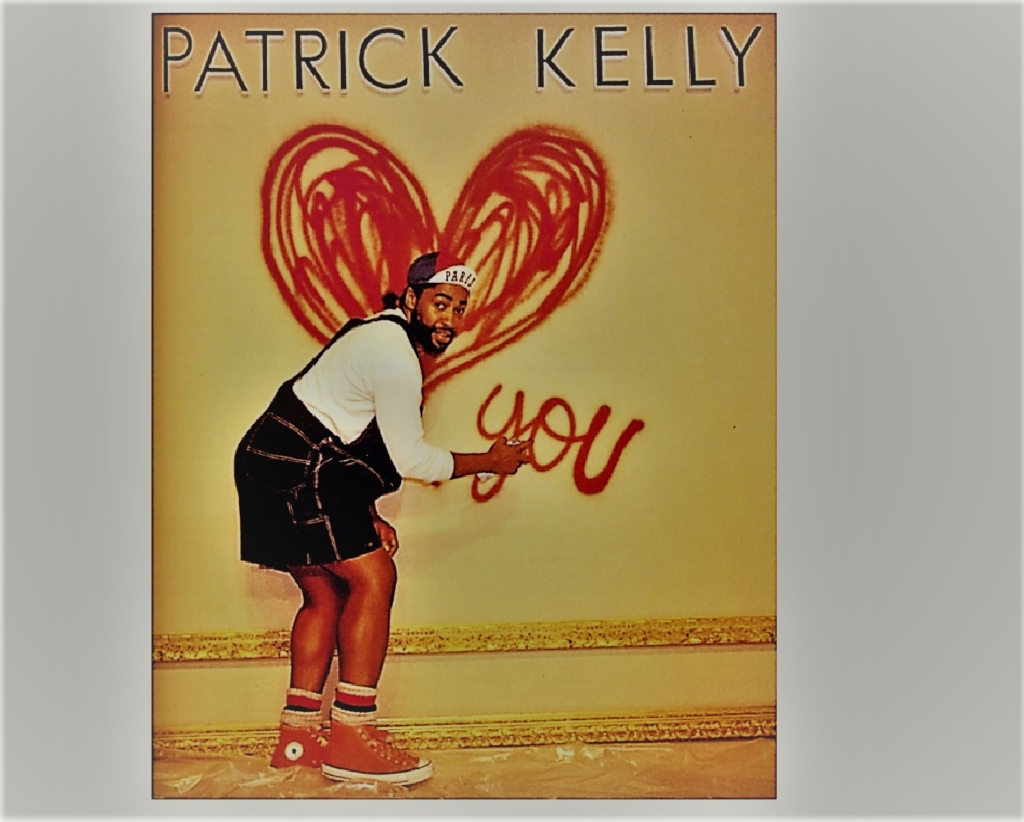
Patrick Kelly, the first American designer to be admitted to Paris’ Chambre Syndicale du Prêt-à-Porter, dies at the Hotel Dieu, a hospital near the Cathedral of Notre-Dame, at the age of 35.
Learn More.Kelly was part of a generation of Black designers who introduced a new energy and perspective into the fashion industry in the 1980s.
“Patrick’s particular contribution was a quirky, surrealist take on design accented by the subversion of racist imagery as an act of Black empowerment and reclamation,” writes Darnell-Jamal Lisby in i-D.
Celebrated for his designs that incorporated references to pop culture and Black folklore, Kelly moved to Paris after becoming frustrated by the lack of support from the fashion industry in New York. Black supermodel Pat Cleveland recalled how she and Kelly first met through a mutual friend:
“[Kelly] made this banana costume for me because he knew I liked to dance like Josephine Baker. So we went out that night, and I did this hair show in Columbus Circle, and I sang like Josephine Baker in that outfit.”
When Kelly told Cleveland about his struggles with the fashion industry, Cleveland said she told him, “You better go to Paris, because there’s no room for Black boys in New York. They’re not going to give you the break you’re going to get in Paris.”
Once in Paris, Kelly’s popularity quickly grew. With a perspective rooted in his experience as a Black man from the South, Kelly incorporated details into his work, such as mismatched buttons, which his grandmother had employed while mending clothes.
As Kelly’s reputation in Paris rose, his popularity among the Black American media grew, too. Ebony magazine published a feature on Kelly’s journey to success in Paris, and Jet magazine regularly covered him, as they did other notable Black designers in America and internationally.
Kelly also incorpated his racial perspective in many elements of his runway shows. At the start of his shows, he would walk onto the runway and spray-paint a large heart on the stage set.
In the gift bags given to the attendees, Kelly would include a “Love List” of items ranging from his favourite foods, like fried chicken, and music from hip-hop to gospel. He would also give everyone a tiny brown doll with molded black hair.
The designer was always seen in outsize overalls — even if the occasion was formal. He wore a bike messenger’s cap, its brim flipped up to reveal “Paris” embroidered on the underside. Kelly acknowledged most every stereotype attributed to Southern blacks.
“It was Patrick’s way of subtly giving his typically predominantly white audiences a brief education on his design process while simultaneously outlining aspects of various Black experiences in the hope of expanding their purview,” writes Lisby in his tribute to Kelly.
In 1985, the first “Patrick Kelly Paris” commercial collection was featured in a six-page spread in French Elle magazine.
Kelly would make history, becoming the first American admitted to the Chambre Syndicale du Prêt-à-Porter, France’s prestigious organization of fashion designers. In doing so, he was canonized among the likes of Chanel, Yves Saint Laurent and Dior.
He is buried in the Père Lachaise Cemetery in Paris, where his epitaph states “Nothing Is Impossible.”
West Hollywood couple Steven Jenkins and his partner Philip Saylor die when they carry out a mercy killing/suicide pact at Cedars-Sinai Medical Center in Los Angeles. Jenkins was 35 and dying of AIDS; Saylor was 40.
Learn More.Saylor shot Jenkins in the head with a .38-caliber revolver, killing him instantly, and then shot himself, Los Angeles Police Department detective Dan Andrews told United Press International (UPI). When the gunshots rang out, hospital staff and several patients ran to Jenkins’ room and found both dead.
Until last year, Jenkins and Saylor operated Abner’s Yellow Barn Furniture Emporium, an antique shop in Van Nuys, and otherwise lived a relatively private life together in West Hollywood, according to Andrews.
Jenkins had been suffering from AIDS-related illnesses for about two years and was admitted to the hospital in mid-December needing urgent care, Ron Wise, a spokesman for the hospital, told The New York Times, Jenkins was being treated as a terminal patient with ”end-stage AIDS,” according to Wise.
The Los Angeles Times reported that Jenkins’ condition in his final weeks was dire: “Intravenous tubes fed him painkilling doses of morphine. Pneumonia clogged his lungs. A progressive eye disorder blurred his vision, threatening to blind him. Too ill to stand, he was virtually motionless. Sometimes, he would hallucinate.”
Jenkins was cared for in Suite 5906, an intensive care room on the fifth floor of Cedars-Sinai, in a ward with others suffering from fatal diseases, though not necessarily AIDS, according to the UPI story. One month later, in February 1990, the hospital would open a $2.5 million, 24-bed AIDS treatment center designed to treat both the physical and psycho-social components of the disease.
Hospital psychiatrist Dr. Geoffrey Newstadt said coroner’s workers retrieved a note from the scene, adding that it offered no rationale for the act.
“It seems to me very clear that this couple had a suicide pact, and they were going to keep it a secret from everybody,” Dr. Newstadt told the LA Times.
In the days following Jenkins’ and Saylor’s deaths, many in the HIV/AIDS support community expressed sympathy for both men.
Andrew Weisser, a spokesman for the AIDS Project of Los Angeles, told The New York Times that his organization recently recorded as many as five suicides in one month and that the actual number was probably higher. He said suicides were becoming fairly common among AIDS patients and that their suffering was sometimes compounded by rejection by members of their families and others.
Rand Schrader, the chairman of the Los Angeles County Commission on AIDS, told The Times that he wondered if the reason Saylor killed himself as well as his friend was because he also had AIDS.
“As he watched his friend’s suffering, was he saying, ‘Can I face this?'” Schrader reflected, adding, “As one person goes, it is often viewed that the person who goes first may be the luckier one. Who will take care of the survivor if he is also HIV positive?”
David Johnson, the AIDS coordinator for the City of Los Angeles, said that, unlike other fatal diseases like cancer or heart disease, AIDS does not come as an isolated case affecting only an individual.
“It’s a holocaust that is happening to an entire generation in a community,” Johnson said. “The stresses that creates can really make people crazy. All of us in that community are dealing with terrible stress and pain and grief.”
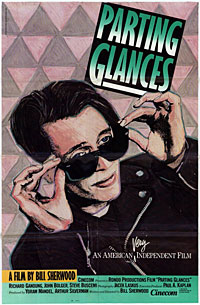
Bill Sherwood, a promising filmmaker whose career was just taking off, dies from AIDS-related illness in New York City at the age of 37.
Learn More.Sherwood is known for his 1986 film — and his only film — Parting Glances, for which he was Director, Editor and Screenwriter. Made for $310,000, the film is a bittersweet romantic comedy that spans a 24-hour period in the upwardly mobile New York gay community.
With its realistic look at urban gay life in the Ronald Reagan era and at the height of the AIDS crisis, many film critics consider it an important film in the history of gay cinema. It was also one of the first American films to address the AIDS pandemic.
In 2007, as a part of the Outfest Legacy Project, a restored print of Parting Glances received its world premiere at the Director’s Guild of America in Los Angeles. The four major stars of the film, Richard Ganoung, John Bolger, Steve Buscemi and Kathy Kinney, were in attendance and participated in a panel discussion after the viewing. Parting Glances was Buscemi’s feature film debut.
In 2014, the Advocate released its “top 175 essential films of all time for LGBT viewers,” placing Parting Glances at #10.

Pop artist Keith Haring dies of AIDS-related illness at the age of 31 at his LaGuardia Place apartment in Greenwich Village.
Learn More.Between 1980 and 1989, Haring achieved international recognition and participated in numerous group and solo exhibitions. His first solo exhibition in New York was held at the Westbeth Painters Space in 1981, according to the Keith Haring Foundation.
Throughout his career, Haring devoted much of his time to public works, which often carried social messages. He produced more than 50 public artworks between 1982 and 1989, in dozens of cities around the world, many of which were created for charities, hospitals, children’s day care centers and orphanages.
Haring was diagnosed with AIDS in 1988. In 1989, he established the Keith Haring Foundation, its mandate being to provide funding and imagery to AIDS organizations and children’s programs, and to expand the audience for Haring’s work through exhibitions, publications and the licensing of his images.
Haring enlisted his imagery during the last years of his life to speak about his own illness and generate activism and awareness about AIDS. By expressing universal concepts of birth, death, love, sex and war, and using a distinctively bold style, Haring attracted a wide audience and assured a timeless accessibility of his imagery. His work has become a universally recognized visual language.
Since his death, Haring has been the subject of several international retrospectives. His work can be seen today in the exhibitions and collections of major museums around the world.
* * * * * * * *
Photo of quilt panel from the AIDS Memorial Quilt
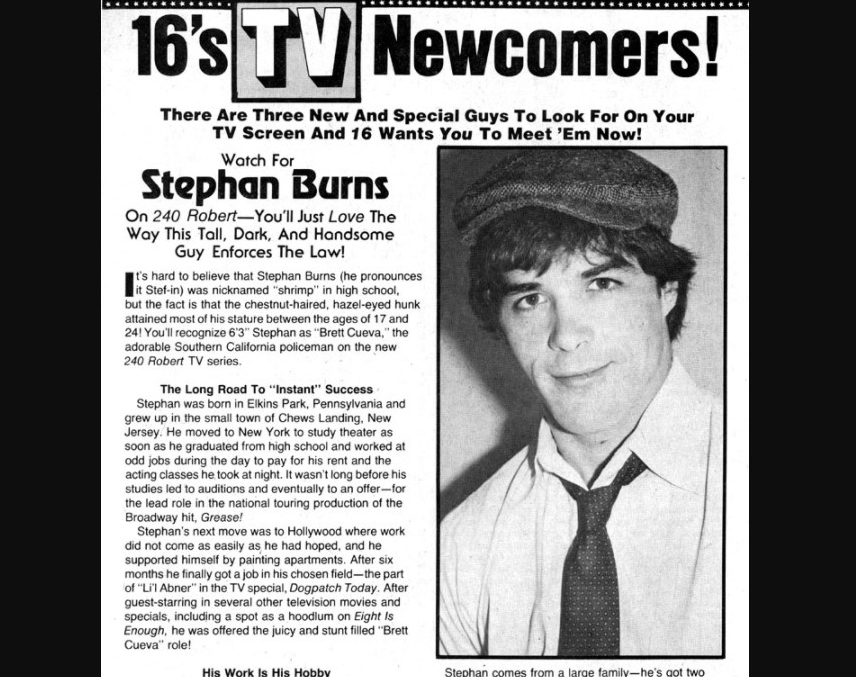
Stephan W. Burns, an actor known for playing Pete Stancheck in Herbie Goes Bananas and Jack Cleary in the TV miniseries The Thorn Birds, dies in Santa Barbara of AIDS-related illness at the age of 35.
Learn More.In 1984, Burns reportedly received an emergency blood transfusion after being seriously injured in a car accident. Various reports contend that the blood was contaminated and infected Burns with HIV.
Burns wanted to be an actor all his life. At an early age, he began staying up late to watch old musicals on television from his small-town home of Chews Landing, New Jersey. After graduating from high school, Burns moved to New York to study theater while working odd jobs during to pay for his rent and acting classes.
At 6’3″ tall, handsome and naturally athletic, Burns commanded attention at auditions and eventually was cast in the lead role in the national touring production of the Broadway musical Grease. Soon after, he moved to Los Angeles, where he faced much stiffer competition for acting roles. But in 1978, after six months in Hollywood, Burns was offered the title role in the TV special Li’l Abner in Dogpatch Today.
But his breakthrough role would come two years later, with the lead in Herbie Goes Bananas, the fourth in Walt Disney Productions’ Love Bug series. Working alongside veteran actors Vito Scotti, Harvey Korman, Charles Martin Smith, and Cloris Leachman, Burns caught the attention of ABC executives and was cast in the TV drama 240-Robert as a second-season replacement for Mark Harmon.
Pop culture magaine 16, known for introducing hunky entertainers to its young readers, published a profile on Burns as one of “three new and special guys to look out for on your TV screen.” According to the article, Burns was living in Silver Lake with a black and white cat named Svatch and enjoyed riding horses in the Hollywood hills.
Unfortunately, an actors’ strike delayed the start of the season and 240-Robert was cancelled after only three more episodes due to poor ratings. But ABC had Burns in mind for another project – The Thorn Birds, a mini-series based on the 1977 best-selling novel by Colleen McCullough featuring a forbidden love story set in the Australian outback. In the drama’s first three parts, Burns played Jack Cleary, an older brother of the lead character Meggie Cleary. The drama would go on to receive several Emmys and Golden Globe Awards.
In 1984, Burns reportedly received a blood transfusion which was contaminated with the AIDS virus while reeiving emergency medical treatment following a car accident. [It should be noted that, other than on Wikipedia and a 240-Robert fan page, information about the car accident and the source of Burns’ subsequent infection could not be verified.]
Burns would have only a handful of acting roles in 1986 and 1987, before succumbing to AIDS-related illnesses and dying in early 1990. A rock musical he was writing called Terminal Hotel would never be completed.
The first national AIDS fundraising concert by the pop music community raises about $1.5 million for HIV/AIDS organizations, including the Gay Men’s Health Crisis.
Learn More.In the concert’s finale, Dionne Warwick, Whitney Houston, and about 40 other performers sang “That’s What Friends Are For,” a hit song from 1985 considered the unofficial anthem of those in the fight against AIDS. At the song’s end, Houston and Warwick are seen hugging.
Organized by Arista Records, the benefit concert took two years to come together and, in the process, unearthed troubling attitudes in the pop music community toward gay men and AIDS, according to Entertainment Weekly.
The idea for a benefit concert took off in March 1988, when Grammy Awards committee member Jonathan Tisch and his mother, a volunteer at the Gay Men’s Health Crisis, were attending the Grammys at Radio City Music Hall. Tisch’s mother, Joan, said there had yet to be a major rock concert to benefit AIDS. Tisch was recruited then and there to organize the event.
According to Entertainment Weekly, Tisch assembled a group to oversee the event, including two record company presidents, Clive Davis of Arista and David Geffen of Geffen Records.
By early 1989, the group had settled on the idea to produce a superstar concert to be called Rock and a Hard Place, featuring six or so multi-platinum artists. They also agreed on a date for the concert: June 6, 1989.
The first band announced for the concert was the heavy metal band Guns N’ Roses, from Geffen’s label. Shortly thereafter, staffers at GMHC, the concert’s major beneficiary, discovered that the band had recorded a song, ”One in a Million,” that included the lyrics:
“Immigrants and faggots, they make no sense to me
They come to our country, and think they’ll do as they please
Like start a mini-Iran, or spread some f—in disease
Within the month, GMHC issued a request to Guns N’ Roses to withdraw from the concert. It was a decision that GMHC did not come to easily. David Geffen was a major donor.
Geffen told Entertainment Weekly that GMHC should have let Guns N’ Roses to perform.
”I don’t care what their record was,” Geffen said. ”If you need a blood donor and the only person who can give you a transfusion is Adolf Hitler, you take the blood.”
The incident caused Clive Davis and Arista to take the lead in organizing the event, and the concert date was pushed to March 1990.
“As much as the show reflected the somewhat conservative musical tastes of Clive Davis, it also demonstrated his relentless charitable determination,” wrote music critic Ron Givens in EW. “After volunteering to use his label’s anniversary as the foundation for the benefit, Davis gained the cooperation of nearly every artist he wanted. Everyone agreed to appear for just expense money; none of the artists performed extended sets, and many of them sang with the house orchestra rather than with their own backup musicians.”
During the concert, various actors (Chevy Chase, Jane Curtin, Michael Douglas, Whoopi Goldberg, and Melanie Griffith) hosted the show and made short presentations about HIV and AIDS.
Goldberg also performed in a bittersweet skit about a girl with AIDS, and Jennifer Holliday dedicated a song from the musical Dreamgirls to that show’s director, Michael Bennett, who died of complications from AIDS in 1987.
Outside Radio City Music Hall, members of ACT UP handed out fliers. In the lobby, GMHC distributed safe-sex packets with condoms.
The concert was videotaped and later aired on CBS during television prime-time hours.

Halston, one of the most successful fashion entrepeneurs in history, dies of AIDS-related illness at Pacific Medical Center in San Francisco at the age of 57.
Learn More.Born Roy Frowick Halston in Des Moines, Iowa, Halston led a classic heartland childhood playing in soap box derby races, fishing, visiting farms, and the like. He took an interest in sewing from his mother, and from an early age he showed a special interest in making hats.
His family moved in 1952 to Chicago, where Halston enrolled in a night course at the Chicago Art Institute and took a day job as a window dresser. Halston continued to design hats and finally obtained his break when a small story on his fashionable creations appeared in the Chicago Daily News.
It was at this time that he would take his middle name Halston as his professional moniker. His hat sales took off, and in 1959, Halston left Chicago for New York City to work for the famed French milliner Lilly Daché.
Following that Halston accepted a position at the fashionable store Bergdorf Goodman, where he charmed his clients and made a grand name for himself. In 1962 he designed the famous pill box hat worn by Jackie Kennedy at the President’s Inaugural, making the Halston name a household word.
Later that year he was bestowed the Coty’s Fashion Critics Award. In 1966, Halston designed his first ready-to-wear collection for Bergdorf Goodman and continued creating magic with his hat creations. Women’s Wear Daily heralded him as “New York’s Top Milliner.”
He quickly became the toast of fashion society, including Liza Minnelli, Martha Graham, Lauren Bacall, and Elizabeth Taylor among his close circle of friends and clients.
Halston’s career sky-rocketed during the 1970’s and his designs set the standard for American designers. The Halston name became synonymous with classically cut, simple, spare and elegant designs, a phenomenally successful fragrance line Halston by Halston for women X12 and Z14 for men, and the fabric known as “Ultra suede.” Throughout most of the seventies he epitomized the glamour, as well as the decadence of the era, becoming a central figure in the nightlife scene of New York’s Studio 54 disco.
By 1988, the designer had effectively retired and retreated from the limelight — and it wasn’t long after until he was diagnosed with HIV, according to AP News. After learning of his diagnosis, Halston moved to San Francisco to be cared for by his family, where he reportedly spent his last days touring the California coastline in his Rolls Royce car — which Halston asked his family to auction off after his death in order to donate the proceeds to AIDS research.
Despite his tragic death, Halston’s legacy still lives on today, with his dazzling life story portrayed in films and biopics, including the Netflix miniseries, Halston.
* * * * * * * *
Photo of quilt panel from the AIDS Memorial Quilt
CBS broadcasts AIDS fund-raising concert That’s What Friends Are For during television “prime time.”
Learn More.The TV special, taped at New York’s Radio City Music Hall, featured “two hours of sweet music and good thoughts,” according to Entertainment Weekly.
In the concert’s finale, Dionne Warwick, Whitney Houston, and about 40 other performers sing “That’s What Friends Are For,” a hit song from 1985 considered the unofficial anthem of those in the fight against AIDS. At the song’s end, Houston and Warwick join in a hug.
The concert was the first national AIDS fund-raising effort by the pop music community and collected about $1.5 million for AIDS organizations. Organized by Arista Records, the show took two years to come to fruition and, in the process, unearthed troubling attitudes in the pop music community toward gay men and AIDS.
The serious side of the evening was evident in scattered moments. Outside Radio City before the show, members of the AIDS-activist group ACT UP handed out fliers. In the lobby, a New York City group, the Gay Men’s Health Crisis (GMHC), dispensed brochures and safe-sex packets with condoms. During the concert, the actors who hosted the show (Chevy Chase, Jane Curtin, Michael Douglas, Whoopi Goldberg, and Melanie Griffith) gave short speeches about AIDS. One of the chairmen of the benefit, Loews Hotels CEO and President Jonathan Tisch, told the audience, ”We must do everything in our power to end this plague.”
Two of the performances reflected the problem that had brought everyone together. Whoopi Goldberg did a bittersweet skit about a girl with AIDS, and Jennifer Holliday dedicated a song from the musical Dreamgirls to that show’s director, Michael Bennett, who died of complications from AIDS in 1987. The rest of the show concentrated, as it was supposed to, on entertainment. Twenty-two current and past Arista acts performed, including Barry Manilow, Melissa Manchester, Patti Smith, Milli Vanilli, Daryl Hall and John Oates, and Taylor Dayne. Some of the live concert music won’t be seen on the TV special, but the notoriously audience-shy Carly Simon will appear in a segment taped before the concert started.
As much as the show reflected the somewhat conservative musical tastes of Clive Davis, it also demonstrated his relentless charitable determination. After volunteering to use his label’s anniversary as the foundation for the benefit, Davis gained the cooperation of nearly every artist he wanted. Everyone agreed to appear for just expense money; none of the artists performed extended sets, and many of them sang with the house orchestra rather than with their own backup musicians. Plus, CBS agreed to air the show in prime time. To accomplish all this took considerable clout. ”Clive Davis is a hero here,” says Katharine DeShaw, director of development at GMHC. ”He was willing to put himself on the line.”
Why did Davis do it? ”The cause,” he says. ”It’s the most urgent health problem facing us in this country. Nobody can remain immune from the effects of this terrible plague.” Davis prefers to give credit to the musicians who performed at the benefit: ”This wasn’t a command performance for Clive Davis. The artists responded openly that this was something they wanted to do.”
And yet it seems puzzling that it has taken this long for the pop music community to stage a major national AIDS benefit. At a time when a wide variety of causes is being embraced by musicians, from the environment to human rights to the ethical treatment of animals, these activists haven’t done very much to fight this major health problem.
There have been exceptions. Royalties from the song ”That’s What Friends Are For” have raised more than $1.5 million for the American Foundation for AIDS Research (AMFAR). Madonna donated seats at her Madison Square Garden concert in 1987 and raised $250,000 for AMFAR. In Oakland Coliseum last June, the Grateful Dead headlined a 9 1/2-hour concert that raised $500,000 despite selling only two-thirds of the seats available. Various artists, such as the B-52’s and Los Lobos, have done public-service TV ads. But, according to fund-raisers at AMFAR (the most prominent nationwide group raising money to fight AIDS), musicians haven’t done as much as people in movies, TV, or the fine arts. ”Other areas of entertainment have done more, much more,” says a fund-raiser at AMFAR, who asked not to be named. ”I would like to see more support. I’d like to see [artists like] Bono and Sting get up on stage for us. I’d like to see Live-Aid for AIDS.”
As successful as the Arista benefit was, it followed two frustrating years that included a major controversy and one planned event that fell through. Back in 1988, Loews Hotels executive Jonathan Tisch was in the audience for the Grammy Awards at Radio City. Tisch, who headed the committee that brought the Grammys to New York, was chatting with his mother, Joan, a volunteer at GMHC. ”She said that, to her knowledge, there hadn’t been a major rock event to benefit AIDS,” Tisch recalls. ”I asked, ‘Who are you going to have do it?’ She said, ‘You.”’ So Tisch put together a group to chair the event, including two record company presidents, Clive Davis of Arista and David Geffen of Geffen Records.
By early 1989, the organizers had decided to produce a superstar concert the following summer to be called ”Rock and a Hard Place,” featuring six or so multi-platinum artists. In February, the heavy metal band Guns N’ Roses, from Geffen’s label, was the first band announced for the June 8 concert. Shortly thereafter, staffers at GMHC, the concert’s major beneficiary, discovered that the band had recorded a song, ”One in a Million,” that includes this homophobic observation:
Immigrants and faggots, they make no sense to me They come to our country, and think they’ll do as they please Like start a mini-Iran, or spread some f—in disease
By mid-March, GMHC asked Guns N’ Roses to withdraw. ”We felt that the group would be in total conflict with what we were trying to accomplish,” GMHC’s DeShaw remembers. ”It was an extremely difficult decision. David Geffen is an important person, and you never want to offend a major donor.”
Geffen is still angry about that decision, feeling that Guns N’ Roses would have raised a lot of money. ”I don’t care what their record was,” he says. ”If you need a blood donor and the only person who can give you a transfusion is Adolf Hitler, you take the blood.”

John “Jack” Winkler, who taught classics at Yale and Stanford, dies of AIDS-related illness at the age of 46.
Learn More.Winkler’s 1989 book Auctor and Actor — which treats the Latin novel The Golden Ass as a detective story — was named best work of classical scholarship by the American Philological Association. In addition to being a classical scholar, Winkler was also a queer theorist and political activist.
Born in St. Louis, Missouri in 1943, Winkler attended a Jesuit high school, where he first learned Greek. From 1960 to 1963, he studied at St. Louis University, also a Jesuit institution. Upon graduating, he joined the Benedictine religious order, living first at St. Lawrence’s Abbey in Ampleforth, England, and then continuing at the St. Louis priory.
In 1970, Winkler left the Benedictines and decided to pursue a career in classics and earned his Ph.D. from the University of Texas in 1974. For the next five years, Winkler taught classics at Yale, where he became an advocate for feminist, gay, and minority causes. He helped to found Yale’s women’s studies program, openly supported the university’s Gay Alliance, and co-produced an LGBT-themed radio show called Come Out Tonight.
In 1977, Winkler was the sole faculty member to help organize Yale’s first Gay Rights Week. That same year, he was the only faculty member to join a class-action lawsuit brought by women students against Yale for its tolerance of sexual harassment of students by faculty. Jack left Yale for Stanford in 1979, and continued to be a leading voice for gay students and faculty.
Upon being diagnosed with AIDS in August 1987, he announced a two-year sabbatical. He spent the last years of his life co-editing essay collections, translating fragments from Greek novels, and publishing his most influential work, Constraints of Desire: The Anthropology of Sex and Gender in Ancient Greece. He donated half of the book’s income to the San Francisco AIDS Foundation.
He was the author of three books and 19 articles, many of them reinterpreting classical works.
* * * * * * * *
Photo of quilt panel from the AIDS Memorial Quilt
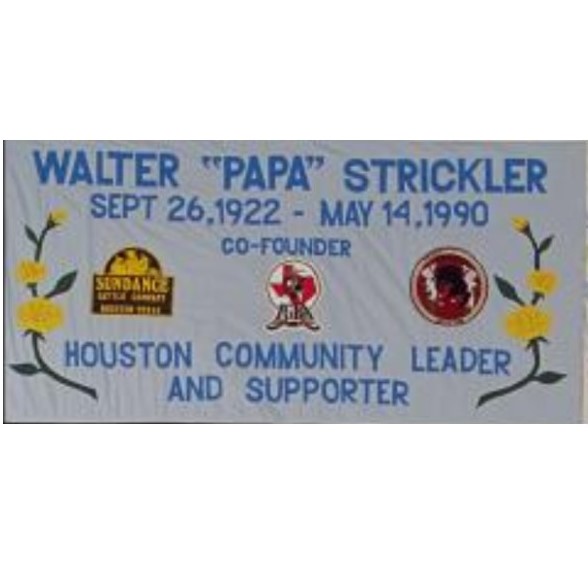
Walter Strickler — also known in the Texas gay rodeo community as “Papa” and “Uncle Bud” — dies of AIDS-related illness at Park Plaza Hospital in Houston. He was 67 years old.
Learn More.Strickler was a founder of the Texas Gay Rodeo Association, fulfilling a lifelong dream of creating a way to bring gay cowboys and rodeo fans together. He was also owner and operator of the country-western gay bar The Barn, which was located in Houston’s Montrose neighborhood.
For his contributions to the community, Strickler was named a Grand Marshal of Houston’s Pride Parade in 1983, along with Marion Pantzer, co-owner of one of Houston’s first lesbian bars.
Strickler was born in 1922 in Jennings, Louisiana, and studied at the University of Southern Louisiana, Chicago University, and Rice University, earning a Master of Arts degree from Rice. He served in the U.S. Navy during World War II, and then worked for Shell for 30 years as a mathematician, according to his obituary in the Montrose Voice.
As his career at Shell came to an end, he opened The Barn in the mid-1970s. Every day, he would take a seat at the front of the country-western bar and quietly read the newspaper, and this is where friends would often find him. But this belied how busy he was in the community.
In addition to founding the Texas Gay Rodeo Association with his partner Terry Clark, Strickler served as the organization’s Treasurer. He also was a charter member of the Houston Gay and Lesbian Political Caucus (now known as the Houston LGBTQ+ Political Caucus) and a founding Board Member of the Montrose Clinic, which became Houston’s leading medical provider during the AIDS Crisis and is now known as Legacy Community Health Services.
He was Treasurer of the Houston Tavern Guild and an active member of the Bar Owners Association of Texas. Through fundraisers held at The Barn, Strickler helped raise money for the Danny Villa Living Memorial Fund, named for a local performer and humanitarian who died of AIDS-related illness, and which provided financial assistant to people living with HIV/AIDS.
The Texas Gay Rodeo Association presented Stickler, posthumously, as Grand Marshal of the 1991 rodeo event.

Franklyn Seales, best known for playing the finicky business manager Dexter Stuffins on the sit-com Silver Spoons, dies of AIDS-related illness at the age of 37.
Learn More.Born on the Caribbean island nation of St. Vincent, Seales studied at John Houseman’s Acting Company in New York in the early 1970s. The 1978 PBS drama, ″Trial of the Moke,″ proved to be Seales’ first big break.
Between 1982 and 1986, Seales played business manager Dexter Stuffins on the NBC-TV sitcom Silver Spoons, in which Houseman played a stoic grandfather. His other television appearances included Hill Street Blues and Amen.
Among his motion picture credits are The Onion Field and Southern Comfort. A versatile performer, Seales took on stage roles in productions that ranged from Shakespeare to the theater of the absurd.
A member of L.A. Classic Theatre Works, Seales performed in unconventional productions, including Conversation at Night With a Despised Character. Following Seales’ performance in this production, Los Angeles Times critic Lawrence Christon said he was “one of America’s most compelling stage actors.”
Seales died at his family’s home in New York City.
* * * * * * * *
Photo of quilt panel from the AIDS Memorial Quilt

Dan Turner, author of several plays at Theatre Rhinoceros and other Bay Area theaters, dies in San Francisco of AIDS-related illness at the age of 42.
Learn More.Turner was one of the first two patients diagnosed with AIDS at San Francisco General Hospital in 1982. At the time, doctors told him that he had a rare cancer, Kaposi’s sarcoma.
Turner was born in 1947 in Bloomington, Illinois, where his father managed the Hotel Rogers. When he was a teenager, his family moved to Cheboygan, Wisconsin, and he began acting in high school drama productions. In college at Fairfield University in Connecticut, he spent a year abroad at Exeter College in England and traveled throughout Europe. After earning his Bachelor’s degree, he volunteered to work in Malawi with the Peace Corps and then in Alabama with the AmeriCorps VISTA program. He was in Alabama when he wrote and produced his early play Cottonmouth.
In the early 1970s, he studied playwriting with Kenneth Cameron at the University of Iowa, writing and producing the play Light Years. He moved to Texas to accept an internship with the Dallas Theater, but quickly found that the program’s leaders didn’t approve of Turner’s openly gay identity and progressive political views.
San Francisco became Turner’s next destination. He joined the productions of both regional and gay theater companies and collectives, and taught a playwriting course at the Eureka Theatre, birthplace of Angels in America. He occasionally traveled to Los Angeles for acting opportunities. A prolific artist, Turner also wrote essays and critical articles for local gay papers, as well as poetry, novels, and short stories. Some of his erotica appeared in gay magazines such as In Touch and Blueboy.
In 1976, Turner contracted hepatitis, and in the same year, he traveled with Tennessee Williams to New Orleans, New York and Cape Cod. Turner became in awe of Williams, who was in failing health and yet woke at 4:00 a.m. every day to write.
“I had been perpetuating (my hepatitis) through this negative mind trip,” Turner later told the Los Angeles Times. “From then on, when my mind said, ‘You can’t do it,’ I’d say, ‘But that’s just your mind.’”
He returned to San Francisco with renewed hope. He wrote and produced three musical plays, two of which (Cinderella II and Comeback) were in collaboration with playwright-novelist Daniel Curzon. He also directed several plays.
In February 1982, Turner was diagnosed wish Kaposi Sarcoma and was one the first patients of Dr. Paul Volberding at San Francisco General Hospital. He befriended AIDS activist Bobbi Campbell and together they laid the groundwork for the organization People with AIDS San Francisco. Both were open about their AIDS diagnosis and began to be sought-after as speakers for community events. In May 1983, Turner and Campbell represented People with AIDS at the second annual AIDS Forum.
Still, Turner continued to be involved in San Francisco theater, and his work began to incorporate his AIDS activism. In 1984, he wrote parts of The AIDS Show at the Theatre Rhinoceros. In 1987, Turner was featured in the televison documentary The Fighting Edge, which addressed how people with AIDS could continue to lead productive lives.
With an eight-year-long illness, Turner was the longest-living known person with AIDS by the time of his death. He outlived his friend Campbell by almost six years.
“He was a shining symbol,” longtime friend Maura Nolan told the Los Angeles Times. “When Dan would walk into the hospital room of some person afflicted with AIDS, it was as if hope walked though the door.”
* * * * * * * *
Photo of quilt panel from the AIDS Memorial Quilt
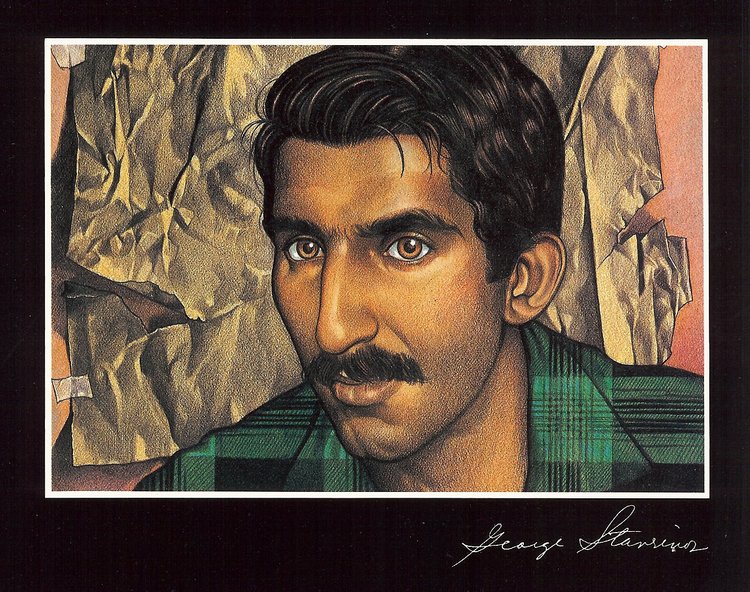
George Stavrinos, best known for his illustrations for New York fashion retailers Barney’s and Bergdorf Goodman, dies of AIDS-related illness at the age of 47.
Learn More.In the late 1970s , Stavrinos’ work became familiar to many gay men through his illustrations for numerous magazines, including GQ, Cosmopolitan, and Christopher Street, according to Visual AIDS, a project created in 1988 to preserve a visual record of the work of HIV+ artists.
Stavrinos also provided illustrations for the New York City Opera, and illustrated the cover of a novel by West Hollywood writer Felice Picano as well as an excerpt of Paul Monette’s first novel, Taking Care of Mrs. Carroll, which appeared in the August 1978 issue of Blueboy.
Stavrinos was famous for his high-contrast drawings and technical proficiency using pencil. He used the style of Superrealism, a movement of the late 1960s and early 1970s in which art approaches the realism of photography.
“He created an arresting new look that set the pace for his contemporaries and still continues to be an influence,” writes Cyril Foiret, founder of Trendland.
His process began with hundreds of photographs of his model in various poses and at various focal lengths using a Polaroid SX-70. He would then create an environment around the model that included a variety of shapes and materials, such as pottery, fans, lights and various geometric designs.
In 2007, Stavrinos was elected posthumously to the Society of Illustrators Hall of Fame.
Paul Giovanni — a playwright, actor, director, singer and musician best known for writing the music for the 1973 British horror film The Wicker Man — dies of AIDS-related illness at Cabrini Medical Center in New York. He was 57.
Learn More.Giovanni wrote the music for the The Wicker Man‘s soundtrack, and also wrote the lyrics and performed in the songs “Landlord’s Daughter” and “Gently Johnny. The music was played by a group of six musicians, using a combination of traditional and modern instruments.
The New York Times considered a highlight of Giovanni’s career to be his 1978 Broadway play, The Crucifer of Blood, a Sherlock Holmes drama. He wrote and staged the play, which received a Tony Award nomination for best director. The play would be turned into a movie for TV in 1991, shortly after Giovanni’s death.
But many fans of cult films credit Giovanni with crafting one of the most memorable and haunting musical accompaniments to a film with his soundtrack for The Wicker Man.
“Haunting and warm in both measures, Paul Giovanni’s rustic folk soundtrack for The Wicker Man is the perfect compliment to a dark fairytale,” writes reviewer Laura Thomas. “His enchanting score and its thorough integration within the film’s narrative mean that The Wicker Man oscillates between folk musical and horror.”
He also worked on several films as producer and production manager, according to Turner Classic Movies.

Julio Rivera, a New York-born Puerto Rican bartender, is brutally murdered inside a schoolyard in Jackson Heights, Queens by three white men from the area. He was 29 years old.
Learn More.Three men in the neighborhood of Jackson Heights went out armed with a claw hammer, a plumber’s wrench and a kitchen knife, hunting for a gay man to assault. They saw a gay couple walking along the avenue, but they decided to keep looking because they didn’t “like the odds” of a three-on-two fight, according to Richard Shpuntoff, director of Julio of Jackson Heights.
They moved on to the grounds of a local public school known to be a gay cruising area. There they found Julio and killed him. The New York Police Department initially and erroneously classified Rivera’s murder as a drug-related crime.
According to Arianna Martinez of the Latinx Project, Rivera’s murder resembled the deaths of at least a dozen other gay men killed in the Jackson Heights neighborhood in the previous 20 years — and none of them were solved or prosecuted.
Only after LGBT groups and Rivera’s family raised public awareness about the NYPD’s mishandling of the murder case did the NYPD reclassify the death as a hate crime and direct resources to finding the men responsible.
According to testimony by one of the perpetrators, 21-year-old Daniel Doyle, two men — Erik Brown, 21, and Esat Bici, 19 — lured Rivera, into an isolated corner of PS 69’s schoolyard. Brown and Bici beat Rivera with the hammer and a beer bottle, and then Doyle stabbed Rivera. They left Rivera to die of the knife wounds.
Gay activists have been warning since the mid-1980s that physical attacks against gay men were increasing at an alarming pace, and they attributed this to a fear of HIV/AIDS, according to a 1986 report in the Los Angeles Times. LGBT leaders also explained the rise in homophobic violence as a reaction to conservative religious leaders’ claim that the AIDS epidemic was “God’s way of punishing the gay community.”
Almost at the exact time that HIV cases first began to emerge in New York, the LGBTQ civil rights struggle faced a reactionary backlash led by Anita Bryant and Rev. Jerry Falwell, whose “Moral Majority” inveighed against giving rights to gay people. It didn’t help that President Ronald Reagan, a Moral Majority ally, largely ignored the growing crisis in the early 1980s and only responded publicly when it became clear that HIV/AIDS was spreading to the heterosexual population.
In 1992, local gay activists founded the Queens Pride Parade to commemorate Julio Rivera’s death and to raise the visibility of the LGBT community in Jackson Heights. The parade, which takes place annually in early June, attracts up to 40,000 people.
Jim Samuels, winner of the 1982 San Francisco Comedy Competition, dies of AIDS-related illness at the age of 41.
Learn More.Born in Oakland, Samuels was a popular comedian and sometime comedy teacher. In the mid-1970, Samuels and then-comedy-partner Marty Cohen were regulars on Merv Griffin’s television show and several other variety programs. In 1977, Samuels performed solo in a comedy skit on the TV show Don Kirshner’s Rock Concert and would embark on a solo career officially in the early 1980s.
Dubbed San Francisco’s Dean of Comedy by his friends and competitors, Samuels was also part owner of the Holy City Zoo club, a small but influential comedy club located at 408 Clement Street between 5th and 6th Avenues in San Francisco.
Samuels died at Garden Sullivan Hospital in San Francisco.
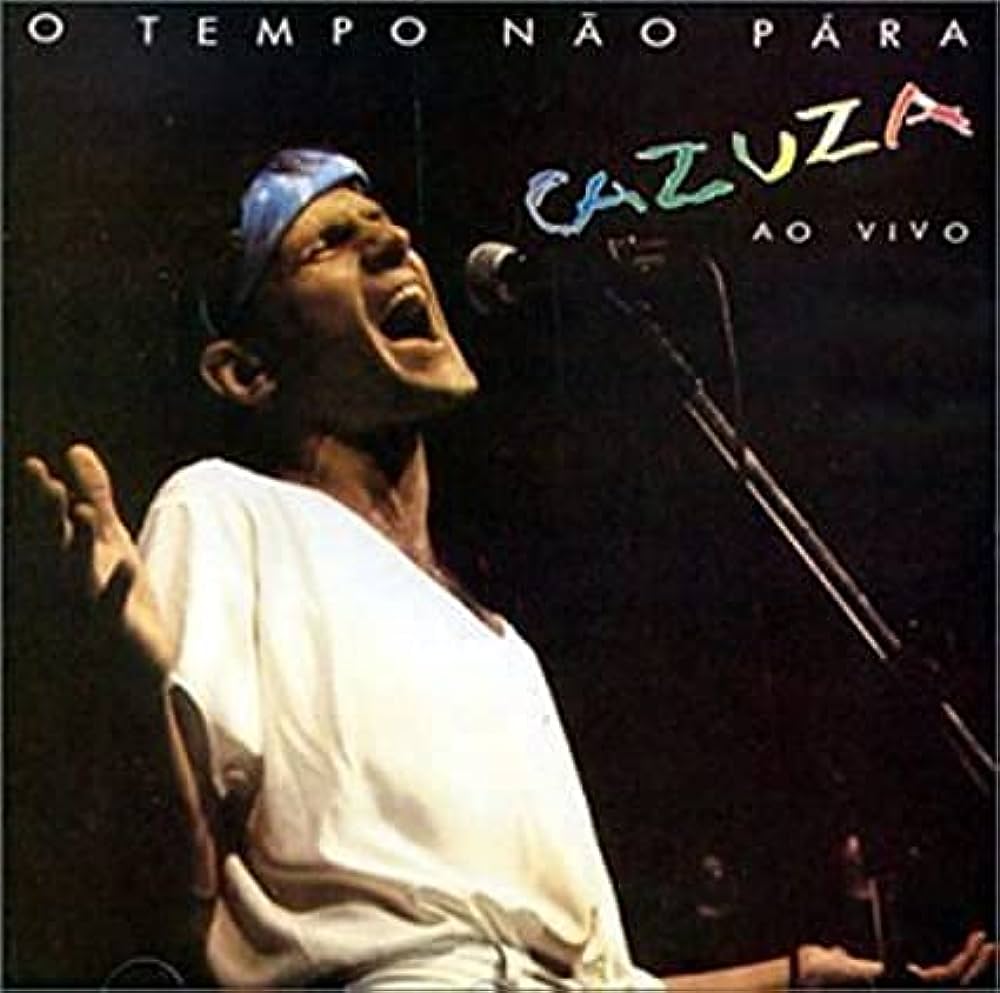
Brazilian rock legend and heartthrob Cazuza dies from AIDS-related illness at his parents’ Ipanema home at the age of 32.
Learn More.“Cazuza was forced to navigate his way through the trying social and medical realities of living with AIDS in Brazil during the 1980s,” according to Brazil: Five Centuries of Change by Thomas E. Skidmore.
Prior to the arrival of AIDS in Brazil in 1983, a sexual liberation had taken hold in the country’s major cities. Because the first reported AIDS cases were that of gay men, it would be commonly referred to by Brazilians as a “gay cancer” or “gay plague,” and would cause widespread panic and fear.
“Cazuza would come to embody much of the conversation around (homo)sexuality and AIDS that would consume Brazil in the late 1980s,” Skidmore writes. “Cazuza had relationships with both men and women. He made easy references to kissing girls and having girlfriends, but he neither ascribed to being gay per sé nor denied his interest in men… He would be able to defy the notion that AIDS was purely a gay man’s disease; though he slept with men, he was not necessarily identified, by himself or others, as gay.”
Mixing Bossa Nova music with 1960s British and American rock, he composed and recorded ″Cazuza,″ his first solo album in 1985, a record known for its biting, sarcastic tone and lyrics.
Changing the ways in which HIV/AIDS were discussed and understood in Brazil, Cazuza demonstrated that people with AIDS could continue to be productive. According to author and literary critic Marcelo Secron Bessa, Cazuza had become the “face” of AIDS in Brazil.
Cazuza dies in his sleep in his parents’ home in the beachfront neighborhood of Ipanema.
″Fortunately, he died without pain, sleeping,″ his father, Joao Araujo, director of one of the largest record companies in Brazil, would say on television.
Cazuza’s funeral at Sao Joao Batista Church in Rio’s Botofogo neighborhood would draw hundres of fans.
His mother Lucinha Araújo, would go on to create the ‘Sociedade Viva Cazuza’ [Viva Cazuza Society], to help people with AIDS. A movie about Cazuza’s life would be released in 2004.

Kaisik Wong, an avant-garde fashion designer who worked in the Bay Area from the 1960s to the 1980s, dies of AIDS-related illness in San Francisco. He was 40.
Learn More.Kaisik Wong was the creator of what would become to be known as “wearable art,” but he was relatively unknown outside of the Bay Area. One of Wong’s pieces — a 1973 patchwork vest that was photographed for the fashion book Native Funk and Flash (1974) — would be replicated by a Balenciaga designer in 2002, causing renewed interest in Wong’s work (as well as outrage in the fashion industry over the obvious plagiarism).
Born in San Francisco in 1950, Kaisik Wong grew up in Chinatown. When he was 14, he began silk screening fabrics and making his own clothes, including shoes, hats and belts, according to Wong’s brother Kailey, who spoke to the Los Angeles Times in 2002, when the Balenciaga vest scandal broke.
Kaisik dropped out of high school at 15 to study at the Pacific Fashion Institute. He began taking his design inspiration from other young people gathering in the Fillmore, the Avalon and other meccas of the hippie movement, his brother said.
Wong was just 17 when he moved to New York City in 1967, and began working with designers. He traveled to Paris and met Yves Saint Laurent, Thierry Mugler, and Pierre Cardin. When Cardin asked Wong to work for him, he declined, preferring to focus his energy and talent on creating his own designs, his brother said.
In his travels, he sought out people who celebrated art and spectacle, and found himself in the inner circle of legendary surrealist Salvador Dali. Dali, who had a keen interest in the artistic aspects of fashion, saw Wong’s work and invited him to collaborate on a series of costumes for the Spanish surrealist and his wife, Gala.
For himself, Wong created a costume inspired by the Monkey King, a trickster character in Chinese myth, and wore it when he visited Dali and also to other special events. Wong’s panel for the AIDS Memorial Quilt references the Monkey King, which to Wong was both a costume and persona.
Uninspired by the state of the fashion industry in New York and Paris, he decided to return to the creative wellspring that was 1970s San Francisco, and he launch his own fashion label, Muuntux. His garments used unusual shapes and materials to emphasize the handmade fabrication.
Well-known in the local art and theatrical community, Wong was sought out to create costumes and performance pieces. Surrealist filmmaker (and later photographer) Steven Arnold invited Wong to create the elaborate costumes that are featured in his ground-breaking film Luminous Procuress. Wong also created costumes and set designs for The Cockettes, a multiracial drag ensemble that performed monthly in the “Nocturnal Dream Show” at the Pagoda Palace Theater.
“Wong was the epitome of the outsider as designer,” states the art-fashion blog Undo and Unravel. “Amazingly, he didn’t use patterns to create collections that veered more towards costume than everyday staples that would hang in a closet. Wong often referenced ancient cultures in his work, which was the main source of the fantastical nature of his aesthetic.”
In 1973, Wong closed Muuntux and began producing one-of-a-kind pieces for the San Francisco boutique Obiko, as well as I. Magnin and Henri Bendel. He also began designing for stage performers, such as Tina Turner and Robin Williams (whose comedy career began in San Francisco).
“He helped to pave the way for a more emotional and rebellious glamour in American fashion, injecting the themes of love, funk, surrealism, psychedelic dreams, and mysticism into his dazzlingly obscure designs,” wrote Colby Mugrabi in his tribute to Wong.
In a 1978 interview with New York Magazine, Wong said his whimsical clothing for celebrities and performers had a practical purpose.
“The idea is to get people together and get them in touch with the changing of the seasons,” Wong said. “The clothes in the collection are merely functional versions of what we do in the theater.”
Following Wong’s death in July 1990 from AIDS, his mother insisted on maintaining his workroom exactly as it was and refused to sell any of the finished pieces, according to his brother Kailey.
“His scissors, sewing machine and pins were just the way they were, as if he was going to the store and coming right back,” Kailey told the LA Times.
In 1996, the de Young Museum mounted a retrospective of Wong’s work, bringing together more than 30 of his wearable art looks. And in early 2002, almost 12 years after Wong died, Wong’s brother Kailey received an email from a friend that included a photo of a vest in Balenciaga’s new collection — and he immediately recognized the design as a piece Wong created in 1973.
Having already seen designs similar to Wong’s work in the Star Wars movie franchise, Kailey said he wasn’t all that surprised to see his brother’s work replicated by a Paris-based fashion house.
“I guess nothing is original,” Kailey told the LA Times. “Except maybe Kaisik.”
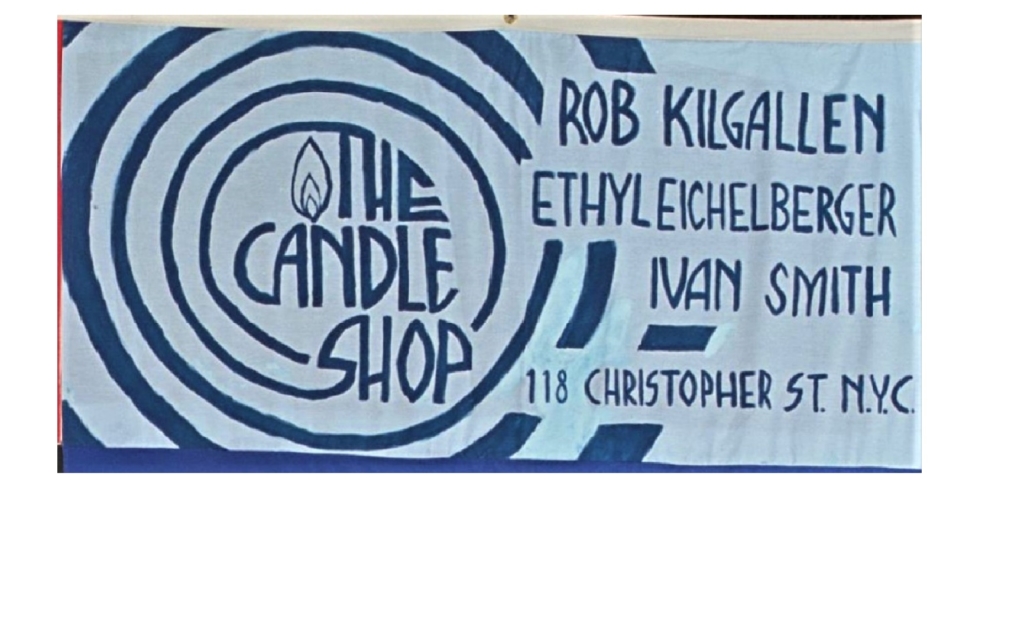
Flamboyant actor Ethyl Eichelberger, who turned theatrical conventions upside down in their career as a performance artist, playwright and director, committs suicide. Eichelberger was 45 years old.
Learn More.Eichelberger was diagnosed with AIDS and chose to end their life on their own terms. Their body was discovered in their Staten Island home by friends Lola Pashalinski and Linda Chapman.
Eichelberger was equally at ease playing characters male or female, including Abraham and Mary Todd Lincoln, King Lear, Medusa and Klytemnestra.
They wrote more than 30 plays, many of them marked by such Eichelberger trademarks as fire-eating, cartwheels and impromptu accordion concerts.
Eichelberger was born to Amish parents on July 17, 1945, and was named James Roy. After studying theater at Knox College in Galesburg, Illinois, they attended the American Academy of Dramatic Arts in New York and worked with Charles Ludlam and the Ridiculous Theatrical Company.
It was here where they perfected their flair for comedy and their craftmanship as a wig maker. In 1975, they legally changed their first name to Ethyl.
As their reputation grew, they began making forays into mainstream theater, doubling as the courtesan and the abbess in the Flying Karamazov Brothers production of ”The Comedy of Errors” at Lincoln Center.
Eichelberger played themself in Oliver Stone’s movie, ”The Doors.”
* * * * * * * *
Photo of quilt panel from the AIDS Memorial Quilt

Bobby DeBarge, a singer celebrated for his falsetto vocals and a co-producer the band DeBarge, dies of AIDS-related illness at a hospice in Grand Rapids, Michigan. He was 39.
Learn More.DeBarge was the lead singer of the Motown R&B group Switch, and later on, he served as both mentor and a co-producer of his siblings’ band, DeBarge.
Bobby DeBarge was the oldest male of eight DeBarge children born to Robert and Etterlene DeBarge over the course of their 21-year marriage. His mother was a black gospel singer who encouraged her children to hone their musical talents. His father was domineering and physically abusive to members of the family, according to Parle magazine.
Bobby DeBarge started his career as a singer as part of Barry White’s background group, and when White broke up the group, DeBarge and other members formed a group named Hot Ice. In 1977, Greg Williams formed the band Switch, featuring DeBarge and his brother Tommy. Switch managed to get the attention of Jermaine Jackson, and they were soon signed to Motown Records.
Bobby DeBarge released six albums with Greg Williams and Switch members with the last album in 1980. By 1981, DeBarge was overseeing the production of his siblings’ debut album The DeBarges; he also co-wrote with younger brother El the song, “Queen of My Heart.”
The group’s third album, In a Special Way (1983), featured the hit single “Time Will Reveal.” But the group would have their biggest hit in 1985 with “Rhythm of the Night.”
Personal problems, including substance abuse which eventually led to drug trafficking charges in Wisconsin in 1988, plagued DeBarge in later years and took focus away from his musical career. Despite having an amazing voice, Bobby DeBarge didn’t release a solo album until 1995, titled It’s Not Over. The album was released just before he died, and he didn’t get the chance to see the project promoted.
In 2019, TV One produced the biopic The Bobby DeBarge Story.
James K. Heady, owner of Male Image barbershop and Image Leather shop, dies of AIDS-related illness at San Francisco’s Hospice By The Bay at the age of 45.
Learn More.With the two businesses that he co-owned with his partner, Gary Mootz, Heady worked long hours but still found time to travel and pursue hobbies, according to the Bay Area Reporter. He and Gary often spent time sailing their boat, “The Crisco Kid,” on San Francisco Bay.
Born and raised in Ohio, Heady joined the U.S. Navy in 1964 and served as the launch director for the USS Independence. After the service, he moved to London and worked as a cab driver, and then returned to the U.S. to study architecture. Heady moved from Phoenix to San Francisco in 1977.
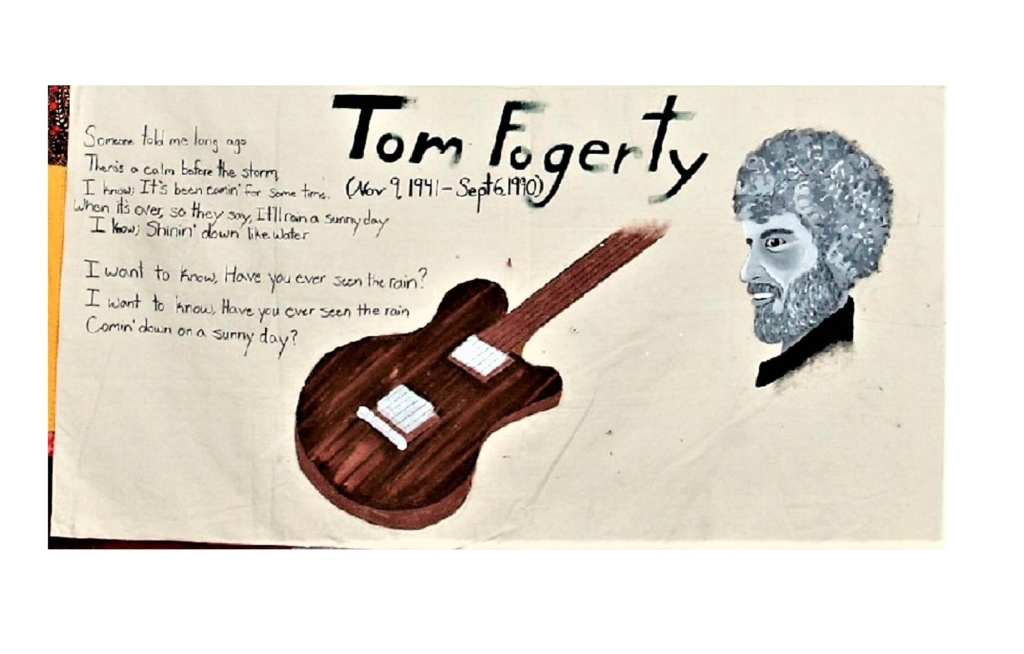
Tom Fogerty, member of Creedence Clearwater Revival and older brother of frontman John Fogerty, dies of AIDS-related illness in Scottsdale, Arizona at the age of 48.
Learn More.Born November 9, 1941 in Berkeley, California, Fogerty holds a significant place in rock history. As the rhythm guitarist for Creedence Clearwater Revival, he played on plenty of rock classics and had a solo career.
In the four years the band was together, they never had a #1 single in the U.S. However, the band holds the record for the most number of No.2 chart hits without ever having had a No.1. They also had a U.K. #1 hit with Bad Moon Rising.
At some point in the 1980s, after moving to Scottsdale, Arizona, Fogerty underwent surgery for his back and an unscreened blood transfusion caused him to be infected with AIDS virus. The cause of his death was initially reported as tuberculosis.
In the eulogy that John Fogerty made at his brother’s funeral, he said: “We wanted to grow up and be musicians. I guess we achieved half of that, becoming rock ‘n roll stars. We didn’t necessarily grow up.”
When Creedence Clearwater Revival was inducted into the Rock and Roll Hall of Fame in 1993, Tom Fogerty’s widow brought his ashes in an urn.
* * * * * * * *
Photo of quilt panel from the AIDS Memorial Quilt

Ray Stephens, best known for his starring role in the 1980s TV series The Great Space Coaster, dies of AIDS-related illness at the age of 35.
Learn More.Stephens became the lead singer of The Village People in 1985, recorded with the group for their album, Sex Over the Phone, and acted in the movie Village People: New York City.
He was an actor, known for in roles in The Runaways (1975) and Cat’s Eye (1985). He is also heard singing the tune Cat’s Eye during the closing credits of the 1985 Stephen King movie.
Stephens reportedly became infected with the HIV virus ‘ death through the intravenous use of drugs.
Jorge Bolet, regarded as the last of the great romantic concert pianists, dies of AIDS-related illness at his home in Mountain View, California at the age of 75.
Learn More.Bolet was famous for his performances and recordings of large-scale Romantic music, particularly works by Franz Liszt, César Franck, and Frederic Chopin. He also specialized in piano transcriptions and unusual repertoire, including the difficult works of Godowsky.
Bolet, who was born in Havana, had been performing in the U.S. and abroad for years before critics and audiences suddenly recognized him as a great master. In the 1970s, he started to receive rave reviews.
“There may be others who can play the notes, but Bolet, with his roots in an older tradition than most today … has a feeling for the line, the elegance, the suave sound, the tapered phrase of high romanticism that is virtually unmatched today,” Harold Schonberg said of the pianist in a 1978 review for The New York Times.
Bolet parlayed his new-found popularity into a recording contract with Decca and a world tour. At his most prolific, he was giving up to 150 concerts a season.
For London/Decca Records, he made more than two dozen recordings, including nine of piano works by Liszt, according to The Washington Post. He also recorded music by Brahms, Debussy, Grieg, Rachmaninoff, Schumann, and Tchaikovsky.
Bolet retired from the concert stage in June of 1989, about six months after learning he was HIV positive. His last Carnegie Hall appearance was on April 16, 1989, and his final performance was a solo recital at the West Berlin Philharmonie on June 8, 1989, according to The New York Times.
His last recordings, made in March 1990, were of two sonatas and selected nocturnes, by Chopin.
A website created as a tribute to Bolet includes a Spotify playlist and complete discography of his work, as well as a detailed biography of the master pianist.

John Sex, a cabaret performer and performance artist, dies of AIDS-related illness in New York City. He was 34.
Learn More.With his trademark platinum-blond hair which stood straight up, John Sex was a standout personality of the 1980s East Village art scene. His act combined parodies of schmaltzy Vegas songs with a burlesque edge, and he would typically take the stage in 10-inch platform heels, a shiny zip-up jumpsuit, or cut-out leather pants.
“The character of John Sex was not all that much off from the real John Sex, but more of a mythical version of himself as an omnisexual rockstar parody or phallocentric version of Tom Jones,” wrote Richard Metzger, host of the British talk show Dangerous Minds. “He couldn’t turn it off if he wanted to, which I can assure you, he did not.”
Born John McLoughlin in 1956, he grew up on Long Island and attended the School of Visual Arts in New York City as a member of the cohort that included Keith Haring, Kenny Scharf and Jean-Michel Basquiat. In 1981, he exhibited some of his word-based art at the New York / New Wave exhibition at P.S. 1 and at the Beyond Words show at the Mudd Club.
He switched from painting to performance art after meeting downtown performers Klaus Nomi and Joey Arias in the early 1980s, according to Metzger. He took the stage name “John Sex” after Nomi and Arias gave him that nickname to poke fun at his promiscuity.
With his back-up singers The Bodacious Ta-Tas, Sex created a nightclub act that was equal parts Las Vegas and Times Square. He played to club audiences at the Pyramid Club, Danceteria, Limelight, The Palladium and The Saint. Notable numbers were “Jet Set,” “Hustle With My Muscle,” “Sex Appeal,” “Bump and Grind It,” and “Rock Your Body.
Sex was immortalized in the 1986 book Art After Midnight: The East Village Scene by Steven Hager. In 1988, Sex released a music video of “Rock Your Body” that surprised everyone when it was picked up by MTV. After a few months of the video being played in nightclubs nationwide, Sex started getting paid well for his live performances ($3,500 per gig), Metzger said. Clubs in Palm Beach, Miami, and Atlanta offered to fly Sex in to perform, but soon his health began to deteriorate and he was unable to travel.
Metzger was 23 years old when he saw Sex perform for the last time in 1989.
“I was the doorman of the upstairs VIP room at [the Mars nightclub] — Vin Diesel worked the front door — and saw the show,” Metzger wrote. “[Sex] was still a high-energy performer, but the medication he was taking made him puffy and his hair had started to fall out, and so he was obliged to cut off his trademark hairdo, fashioning the hair that was left into a jeweled crown.”
John Sex is featured among the artist tributes on the website for Visual Aids, an organization that utilizes art to fight AIDS. In 2017, he was memorialized in Ain Gordon’s show Radicals in Miniature, which featured tributes to Sex and other “unfamous legends” of the 1970s and 1980s downtown art scene.

Internationally known drag artist Craig Russell dies of AIDS-related illness at Toronto Western Hospital at the age of 42.
Learn More.Billed during the 1970s and 1980s as a “female impersonator,” Craig Russell performed monologues and songs as Bette Davis, Carol Channing, Janis Joplin, Judy Garland, Marlene Dietrich, Peggy Lee, and Mae West. Considered “the ambassador of Canada’s gay culture,” he performed his act in Las Vegas, Hollywood, Berlin, London, and Paris.
In 1977, Russell starred in the film Outrageous, which was based on a book about his life as a hairdresser-by-day and drag-performer-by-night. The following year, Russell was awarded Best Actor for his performance by the Berlin International Film Festival. He also won awards at the Virgin Islands Film Festival in both Best Actor and Best Actress categories.
Born in Toronto, Russell was introduced to show business in 1965 by screen siren Mae West when he was 17 years old. He took a part-time job as West’s secretary, but quit several months later to study hairdressing in Toronto, according to The New York Times.
In 1970, at the age of 22, he gave his first performance at a Toronto gay club, impersonating Tallulah Bankhead, wrote The NY Times.
Culture writer Joe E. Jeffreys wrote the following about Russell for the LGBTQ Archives:
“Equally remarkable as the range of his characterizations was Russell’s three-octave vocal range that allowed him to impersonate Barbra Streisand in her own key. He could perform a duet between Ella Fitzgerald and Louis Armstrong. For his act’s finale, he frequently performed a run-down of all the ladies who had performed in Hello, Dolly!”
According to Jeffreys, fans particularly loved Russell’s impersonation of anti-gay crusader Anita Bryant singing “The Battle Hymn of the Republic.”
“As a female impersonator, Russell attempted genuine verisimilitude, but he also added a great deal of his own personality and comic sensibility,” Jeffreys wrote. “His approach lies somewhere between the sharp-witted performances of drag comedians such as Charles Pierce or Lynne Carter and the dead-on likenesses of impersonators such as Jim Bailey or Jimmy James.”
After his award-winning performance in Outrageous, Russell had a one-man off-Broadway show, A Man and His Women, in 1977. He was booked at large and prestigious venues around the world.
However, Russell’s career began to decline when substance abuse and other issues began to interfere with his ability to perform. In 1986, Russell returned to Toronto to film a sequel to Outrageous. It was released in 1987 to mixed reviews.
In 2020, thirty years after Russell’s death, Outrageous Misfits, a book about the life and legacy of Russell was published by Dundurn Press.
_ _ _ _ _
Graphic from the collection “AIDS Awareness: The Fight Against AIDS,” published in 1993 by the comic book company Eclipse Enterprises. The Craig Russell trading card is featured in the U.S. National Library of Medicine’s historical collection.
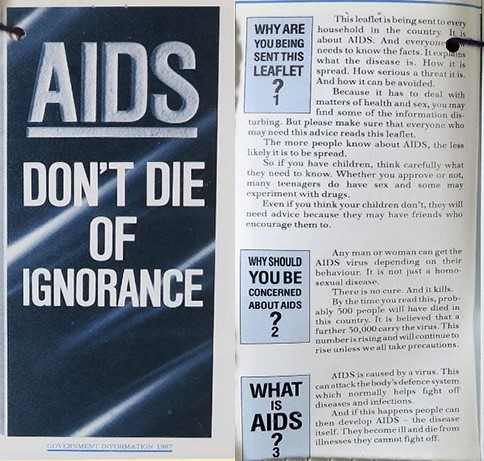
Margaret Thatcher, the first female prime minister in British history, announces her resignation after 11 years in Britain’s top office, a time during which she opposed the government health secretary’s straightforward approach to AIDS awareness.
Learn More.British government papers released in December 2015 show Thatcher tried to reign in Health Secretary Norman Fowler’s AIDS awareness campaign in the mid-1980s by urging the elimination of precise explanations of which sexual practices were most likely to lead to HIV infection, according to The Guardian.
In 1985, Fowler submitted a memorandum to the prime minister’s office that provided details about “Don’t Die of Ignorance,” a country-wide public health campaign that included explicit health warnings in large advertisements in the Sunday papers.
Thatcher expressed her opposition in her trademark blue felt pen comments on the memo: “Do we have to do the section on risky sex? I should have thought it could do immense harm if young teenagers were to read it.”
She was particularly alarmed by references to anal intercourse in the campaign’s section titled “What is risky sex?”
When the privy council committee coordinating the government response to AIDS decided to move forward with Fowler’s campaign, Thatcher continued to voice opposition.
“I remain against certain parts of this advertisement,” she wrote to the committee. “I think the anxiety on the part of parents and many teenagers, who would never be in danger from AIDS would exceed the good which the advertisement might do … To place advertisements in newspapers, which every young person could read and learn of practices they never knew about, will do harm.”
Following her objections, the language in the media ads were subsequently amended.
In a 2021 interview the National HIV Story Trust, a British organization that seeks to preserve the history of the AIDS epidemic in the U.K., Fowler said the late Thatcher and her party chairman, Norman Tebbit, “were both neurotic about getting too associated with [AIDS] and too associated sometimes with the people in it.”
Fowler described how the Conservative Party leader expressed concerns about the increasing rates of HIV infection and death, but held “no great sympathy for the subject,” according to Pink News.
In her 2018 book People Like Us, Caroline Slocock provided an alternative view of the prime minister. Slocock recalled that during her time as private secretary to the prime minister, Thatcher eventually visited an AIDS hospice to visit patients dying of illnesses related to the virus.
Thatcher arranged the visit without any media notice, in part because she did not wish to draw focus from the work already being done by Diana, Princess of Wales, according to Slocock.
Slocock, who accompanied Thatcher on this trip, wrote about her recollection of the prime minister’s encounter with an AIDS patient:
“I have never been at the bedside of a dying person before and I feel strongly that family and friends should be there at this moment, not us … [Thatcher] responds by taking a seat by his side, asking questions, expressing sympathy, connecting in a simple and genuine way, to which he responds sweetly. She comes across as more of a mother than a Prime Minister…
“After about ten minutes, we leave him and go into the second room. Inside, sitting in a chair beside his bed, is a young American man, also extremely thin. The virus has attacked his brain too, as it does in the final stages, we are told afterwards, and he is excited and confused. At first he thinks she must be a creation of his own mind, a delusion. But then he begins to believe that she really is Margaret Thatcher, but sent to him miraculously to hear his thoughts and to pass them on to President Bush. He tells her to ring the president. It is imperative that action is taken now to help people like him – that is his message. He is overexcited, it is very difficult to know how to respond, and it is very, very sad.
“Margaret Thatcher is unfazed and behaves as if she has all the time in the world. She places her hand on his arm, asks him a few questions about his life and listens, in a way that demonstrates that she is real, not a phantom, and is there because she cares and wishes him well. He calms down in response. It is simple, human stuff, but I am in awe of it.
“When we leave them, we ask the staff about [the patients’] families. It turns out that neither have felt able to tell their parents that they are gay, let alone that they have AIDS, and so they are dying alone.”
Tim Dlugos, a New York City poet affiliated with the St. Marks Poetry Project dies of AIDS-related illness at the age of 40.
Learn More.Tim Dlugos authored eight poetry collections, including the Lambda Literary Award-winning A Fast Life: The Collected Poems of Tim Dlugos (published posthumously in 2011 by Nightboat Books). Born on August 5, 1950, in Springfield, Massachusetts, Dlugos eventually found his tribe at the Poetry Project at St. Mark’s Church in the mid-1970s.
Dlugos’ published works also include Je Suis Ein Americano (Little Caesar Press, 1979) and Entre Nous: New Poems (Little Caesar Press, 1982). Poet and publisher Ted Berrigan called him “the Frank O’Hara of his generation.”
In 1988, after learning he was HIV-positive, Dlugos enrolled at Yale Divinity School with the intention of becoming an Episcopalian priest. Shortly before his death, Dlugos published his poem “G-9” in The Paris Review, which includes the following passage:
… where
my friend’s remains should be
there’s just the empty base
of an urn. Where are his ashes?
His mother hands me
a paper cup with pills:
leucovorin, Zovirax,
and AZT. “Henry
wanted you to have these,”
she sneers. “Take all
you want, for all the good
they’ll do …”
As the cultural arts community continues to be disproportionately impacted by the AIDS epidemic, insurance companies begin to escalate their coverage rates for theaters, museums, film companies, and other purveyors of the arts. It becomes nearly impossible for individuals who test positive for HIV to obtain private health insurance to pay for their medical costs.
Learn More.Insurance rates went up 400% for La Mama, a nonprofit off-off-Broadway theater company in New York which estimated that 53 people associated with the theater had died of AIDS, according to reporting by the Los Angeles Times. LA Times reporter Sean Mitchell described a similar impact on the film and television industry in Hollywood.
“The incidence of AIDS in Hollywood threatened the jobs and health benefits of some studio employees diagnosed as carrying the virus, as studio executives contended with rising insurance premiums,” wrote Mitchell in December 1990.
A 1986 study of the first 10,000 persons living with AIDS estimated the healthcare costs in their treatment “from diagnosis to death” to average $146,000 (the equivalent of about $425,000 today). The insurance industry quickly responded by adjusting its policies, requirements and procedures for people living with HIV — and also for organizations that the industry considered were at high risk of employing people who would become infected with the virus.
“Before the advent of the AIDS antibody test, insurers were already using supposed indicators of homosexuality as underwriting criteria,” said journalist Deborah Stone in a 1990 article for The American Prospect. “Single men between 25 and 45, particularly if employed in occupations deemed stereotypically gay, were being denied individual policies for life and health insurance.”
Insurance companies began rejecting individual applicants living in urban areas with a significant population of people living with HIV or, alternatively, they would dramatically raise the insurance rates for those already covered by a policy.
“With HIV disease, the health care system is faced with the task of caring for approximately 1 million people in the United States who have a disease that has only been recognized for a few years and whose course, treated or untreated, is still only partly understood,” wrote Albert R. Jonsen and Jeff Stryker in their 1993 report to the National Academy of Sciences titled The Social Impact of AIDS in the United States.
Jonsen and Stryker’s report goes on to describe how a positive HIV test would immediately make someone ineligible for private insurance, because it would be considered an indication of a “preexisting condition.” Also, as many HIV-positive people became ill and could no longer work, their insurance policies would be cancelled by their previous employers.
In the 1980s and early 1990s, private insurance was the primary means that Americans used to pay for health care and to provide for needs that were too big to meet through normal work income and savings. Through private health insurance, American workers created their own social aid, while public social insurance programs — such as Social Security pensions, disability insurance, and Medicaid — were designed only to be safety nets, and not primary sources of support.
And yet, as more people were infected by the virus and became seriously ill, social service programs became the primary source of healthcare for a growing number of people, according to Jonsen and Stryker.
Various proposals were introduced to include HIV as a disease covered by Medicare (similar to end-stage renal disease) and the designation of HIV as a Medicaid-eligible condition, but leaders in the White House and Congress refused to adopt them.
“Such structural reforms have generally been rejected by the executive and legislative branches of state governments on two major grounds: concerns over the equity of HIV-specific funding streams and the potentially large impact on already strained entitlement programs,” wrote Jonsen and Stryker in 1993.
Yet, in 1990, President George Bush signed into law the most important piece of legislation to date that was designed to help people living with disabilities, include HIV. The landmark Americans With Disabilities Act extended protection to people with AIDS.
In his first speech about AIDS, Bush said: “Once disease strikes, we don’t blame those who are suffering … We try to love them and care for them and comfort them. We don’t fire them, we don’t evict them, we don’t cancel their insurance.”
Jonsen and Stryker concluded their report with the following: “The chorus of voices calling for reform of the health care system has been growing louder in the early 1990s, but it seems to have less to do with AIDS and more to do with the realization that many of the working poor and middle class (nearly 40 million Americans) find private health insurance beyond their reach and public programs inadequate.”
Dancer and choreographer Antonio Mendes — who performed with the Pacific Ballet, San Francisco Opera Ballet, Marin Civic Ballet and the National Ballet of Portugal — dies of AIDS-related illness at the age of 41.
Learn More.Mendez was also Director of the Redwood Empire Ballet in Santa Rosa, where he also taught. Mendes was fired from the Redwood Empire Ballet when the organization’s board members learned he had AIDS.
Mendez is memorialized in the project Dancers We Lost: Honoring Performers Lost to HIV/AIDS.
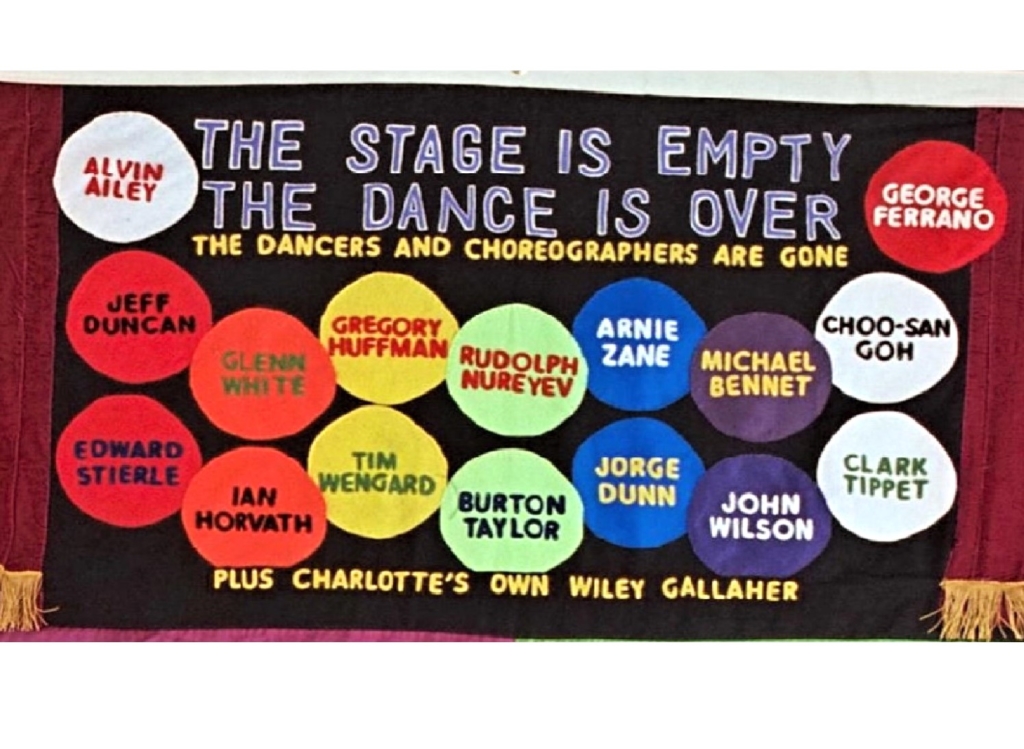
Former leading dancer with the Joffrey Ballet, known for his speed, lightness and strong acting ability, Burton Taylor dies of AIDS-related illness in White Plains, New York at the age of 47.
Learn More.Taylor danced such roles as Captain Belaye in John Cranko’s Pineapple Poll and Arthur Saint-Leon in Robert Joffrey’s Pas des Deesses. Taylor made his professional debut with the Eglevsky Ballet in 1959. He joined the American Ballet Theater in 1962 and the Joffrey in 1969, dancing with the company through 1978.
Taylor also wwas a contributing editor of Dance magazine from 1979 to 1983, and wrote several dance articles for The New York Times.
* * * * * * * *
Photo of quilt panel from the AIDS Memorial Quilt
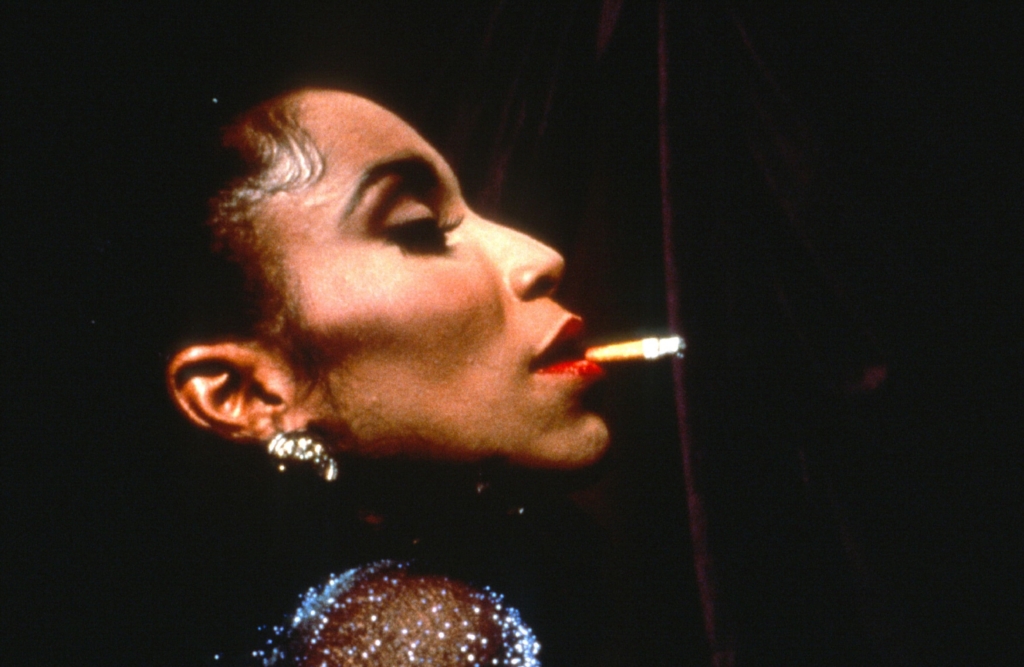
The film Paris is Burning, documenting the Harlem Ballroom scene of the late 1980s, debuts in New York City. The AIDS crisis would come to touch many of the lives seen in the movie.
Learn More.Directed by Jennie Livingston, Paris is Burning helped shine a light on New York’s ballroom subculture, a vibrant scene where Black and Hispanic gay men, drag queens and transgender women competed in competitions involving fashion runways and vogue dancing battles. The contestants often represented various “Houses,” self-organized groups which served as surrogate families for members of a community ostracised from mainstream society.
The documentary — which took Livingston seven years to fund, make and release — was was an immediate hit with critics and fans of independent movies, and since then, it has become a staple of queer cinema. The appeal of the film transcends time in its thematic core of resilience rooted and thriving in a community cast off by society.
“The defiant joy we witness in the ball walkers at so many moments of the film — despite the AIDS pandemic, racism, homophobia, transphobia, poverty, homelessness, violence, harassment, addiction, and whatever other hardships they may have been dealing with at any given time — was infectious when the film premiered, and remains so today,” wrote filmmaker Michelle Parkerson on the 30th anniversary of the film’s release.
Yet, almost immediately, the film was met with sharp criticism from some of its subjects, who claimed that the filmmaker and Miramax, the film distributor, made considerable profits while they largely remained in impoverished conditions.
Miramax reported more than $4 million in gross earnings from its U.S. theatrical release — modest for a Hollywood film but representing considerably wealth to Ballroom participants. A legal battle between some of the surviving featured performers and Miramax would ultimately be resolved with a payment of about $55,000, divided among 13 performers based on screen time.
The film also drew criticism from feminist scholar bell hooks, who put forth the idea that Livingston – a middle-class, white, genderqueer lesbian – was an enabler of cultural appropriation.
“Much of the controversy has centered on a perceived appropriation of a Black gay subculture by a privileged white filmmaker,” said Parkerson in her article for The Criterion Collection upon its re-release of the film. “It has also involved the perennial question of who has the right to tell someone else’s story, which, I posit, is the lingering dilemma at the doorstep of any documentary project.”
Upon the 2020 re-release of Paris is Burning, Livingston said in an interview that her perspective as the filmmaker was valid, even though she was not a member of the Ballroom subculture.
“My agenda was to tell a great story while not imposing my view, but that is a struggle,” Livingston told Hyperallergic. “Whenever you tell a story, you have that control. In terms of my race, I felt very welcome. I was honored they trusted me, but as a white Jewish person, I knew that I wasn’t from their world. I tried to be the absolute best listener that I could, and it helped to work with a great editor in Jonathan Oppenheim. We tried to balance what people were saying without imposing our own agendas onto the film.”
Most of the film’s subjects died in the 15 or so years following its theatrical release, due to factors like transphobic violence, poverty, and AIDS. Venus Xtravaganza, who was a sex worker, was murdered in a New York hotel room in 1998. In the TV series Pose, Venus would be the inspiration for character Aphrodite Xtravaganza, created by writer and activist Janet Mock to give Venus “a second life.”
Angie Xtravaganza, the Mother of the House of Xtravaganza, died of AIDS-related illness in 1993, as did Dorian Corey. Pepper Labeija died in 2003 of a heart attack. Willi Ninja, who perfected the art of voguing and trained others in the dance style, died of AIDS-related illness in 2006.
“Existing only in memory, enshrined in celluloid, they are and were stars, but they didn’t get to see the fruits of their culture become mainstream and profitable,” writes Canadian film critic Willow Catelyn Maclay. “Rewatching the movie is a bittersweet experience, because there is deep beauty in the ballroom scene, but the sun always rises and parties always end.”
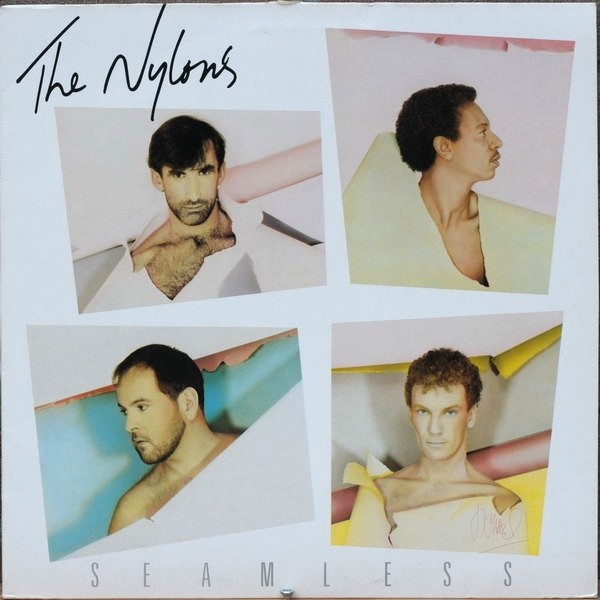
Marc Connors, a member of the Canadian a cappella group The Nylons, dies of AIDS-related illness at the age of 41.
Learn More.Known for their covers of pop songs such as The Turtles’ “Happy Together” and The Tokens’ “The Lion Sleeps Tonight,” The Nylons began performing in 1978. Marc Connors (pictured lower right) was one of the four original members of the group.
“The singers merged elements of doo-wop with R&B; and pop and delivered the package tightly bound in articulate arrangements that favored simple tempos and straightforward tonalities,” wrote Los Angeles Times music critic John D’Agostino in 1991.
After releasing their fourth album, Seamless, in 1984, the group was invited to perform on the Canadian children’s television show Sharon, Lois & Bram’s Elephant Show to sing one of the songs on the album, “The Lion Sleeps Tonight.” They also attracted new fans in the U.S. from their performance of the theme song to the mid-1980s sitcom Throb, starring comic actor Diana Canova.
Angela F.M. Pancella, author of Voice and Style: Marc Connors of The Nylons, included in the biography the following passage that Connors wrote in his journal:
“I am dying. It’s now clear I will not recover. I am sad for my parents and especially for Ian. And my sisters, friends and fans. My death will affect a wide circle of people. And yet I’m not really that important or significant. Altho [sic] who is? I guess I most wanted to be someone who contributed to people’s lives, the way I cherish Chaplin or Tchaikovsky or so many book and filmmakers and actors. I’ve had some effect in that area-I’ve moved and excited people. I’m sorry I haven’t left more of an intellectual legacy….
“As I write all this I wonder what it is that I regret, what I could want to live for? I’ve traveled, but not everywhere I wanted. I wanted to go to Africa, to Bali, to know France and speak French for real, to speak Italian. To live in Greece. To be a hit in Paris. To write. I don’t know what. To win an Academy Award. To build a home. To work in wood. To have a theatre company and do good work. To write a symphony. To make a lot of money. To live in Kyoto. To make a wonderful movie, like Miss 1000 Spring Blossoms. To build wonderful low-cost apartment buildings that work to create beauty, nature, friendship and community. To market great healthy food. To help Mom to have that restaurant. To do anything to make them both happy. Build them a house. To really deal with issues and important thoughts of life today in works of art. To add to the world’s faith by disseminating my credo. To beat AIDS. To be a beacon for others to help them believe it can be done and that the spiritual is real. To write my life — in real honesty, all the sexual warts and all. I wish I had been more courageous, less a nervous wreck. A better actor. Less critical of myself, less depressive, unstable. But just as searching. I don’t have many ‘achievements,’ but many satisfactions. I don’t think life is about achievements anyway…”
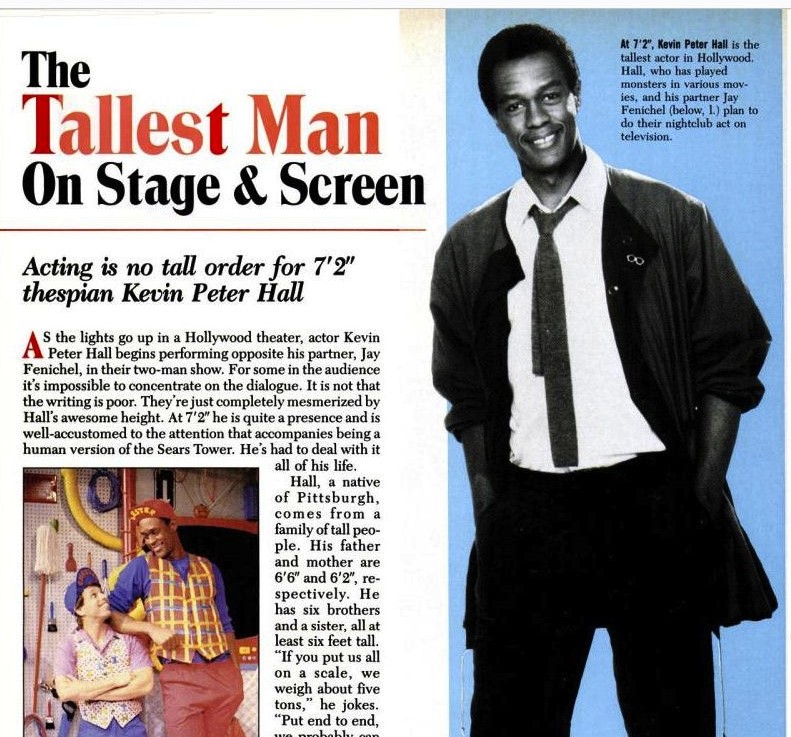
Kevin Peter Hall, a 7’3″-tall actor known for his TV and film roles as monsters, dies of AIDS-related illness a month short of his 36th birthday.
Learn More.Hall’s enormous stature landed him numerous roles in films and TV as monsters and aliens, most famously as the title role in the 1987 science fiction action film Predator and its 1990 sequel, Predator 2. He is also remembered for playing Harry the Sasquatch in the 1987 film Harry and the Hendersons and in the television series of the same name.
Hall became known in the industry for mastering the technique and art of performing in often-cumbersome masks and costumes.
“When you look at Kevin Peter Hal in that wardrobe, makeup and with that size, and you see him against Arnold [Schwarzenegger] you believe ooh-ooh, Arnie’s in trouble,” Predator co-star Carl Weathers said in The Man Behind the Predator featurette. “He made it work. Kevin Peter Hall really made the thing work.”
When Rick Baker won the 1988 Academy Award for Makeup for his work on Harry and the Hendersons, he thanked Hall for his “brilliant performance.”
In 1990, Hall was reprising his role as Harry for TV when he announced that he had contracted HIV from a contaminated blood transfusion following a car accident. He portrayed Harry for the first sixteen episodes of Harry and the Hendersons before his illness forced him to give up the role.
A monster on the screen, in real life Hall was known as big-hearted and “a sweetheart of a guy.”

Phil Zwickler, who directed documentaries and wrote articles about the AIDS crisis, dies of AIDS-related illness at his home in Manhattan. He was 36 years old.
Learn More.Zwickler’s films included Rights and Reactions: Lesbian and Gay Rights on Trial, an account of the 1986 New York City Council hearings on the gay rights bill.
The documentary, which Zwickler produced and directed with Jane Lippman, won the Gold Plaque at the 1987 Chicago International Film Festival and a special jury prize at the 1988 San Francisco Film Festival, according to The New York Times.
Zwickler also collaborated with the experimental German film maker Rosa von Praunheim on the documentaries Silence Equals Death and Positive. Exploring the the rage and frustration of people with AIDS, the films were screened at the Berlin International Film Festival and then at the New York Public Theater as part of the 1990 Documentary Festival of New York.

Leland (“Lee”) Hickman, a Los Angeles-based experimental poet, dies of AIDS-related illness in his North Hollywood apartment. He was 56 years old.
Learn More.Lee Hickman was known best as the publisher and editor of Temblor, which was influential in launching the careers of many poets in its five years of publication (1985-1989).
According to internationally recognized poet Bill Mohr, who was a friend of Hickman’s, a history of the Los Angeles Poetry Renaissance of 1948-1992 would be incomplete without a mention of Hickman. As Temblor‘s editor, Hickman was instrumental in introducing poetry fans to the work of “Language writers.” He was also something of an outlaw, at a time when homosexuality was considered criminal behavior.
Leland Ervin Hickman Jr. was born in Santa Barbara, California in 1934. Mohr said Hickman told him that when he was 14, he was sent to a detention site for youth after he was caught having a sexual relationship with an older man. After returning home, he resumed high school and then attended Santa Barbara College (now University of California, Santa Barbara). After a tour in the Army, Hickman moved to New York City to pursue a career in theater. During this time, he was arrested and jailed twice for “solicitation” after approaching men for sex.
He returned to Southern California in 1960 to perform at the Equity Library Theatre West in Los Angeles, and ultimately decided to settle permanently in LA with his partner, the actor Charles Macaulay. For a while, he and Macaulay lived in a house owned by veteran actor Raymond Burr. He began attending Beyond Baroque’s Wednesday night poetry workshop, which was led by John Harris (who would soon open the Papa Bach Bookstore).
In 1966, Hickman’s poetry career began in earnest with the publication of his poem “Lee Sr Falls to the Floor” in The Hudson Review. The poem was inspired by the death of his father from carbon monoxide poisoning six years earlier. Shortly after the poem was published, he received a $500 award from the National Endowment for the Arts.
A short time before Christmas 1971, Hickman gave his friend Harry Northrup a list of poetry to study “to be a good poet.” The list included “Great Books” such as The Book of Tao (also known as Tao Te Ching) by Lao-Tse and the Complete Works of Samuel Beckett, as well as the works of contemporary poets William S. Burroughs and Rimbaud. Hickman also recommended that Northrup “try to learn a language,” like Ancient Greek, Latin, Anglo-Saxon English, French or Spanish.
In the early 1970s, Hickman was arrested twice for having sex with men in Griffith Park, according to Mohr. Around this time, Hickman was experiencing writer’s block, and was frustrated by his inability to produce new work.
In 1977, Hickman became editor of Bachy poetry magazine, which was published by Papa Bach Bookstore. Three years later, he published a book-length section of his serial poem, “Tiresias,” entitled Tiresias, Great Slave Lake Suite (Momentum Press, 1980) and was named a finalist for the Los Angeles Times Book Award in Poetry. Dealing with the gay underworld of the 1970s, the poems were seen by one Times critic as “rough, discomforting, scary.”
After Bachy ceased publication in 1981, Hickman edited two issues of Boxcar: A Magazine of the Arts in 1983-84 and then launched Temblor in 1985. A typesetter by profession, Hickman also designed the magazine, according to the LA Times. In 1988, Hickman received a fellowship in literature from the Broady Arts Fund.
Hickman dedicated himself to long hours at a publishing house, setting type during the day and then staying late into the night to do production work for Temblor. According to Mohr, Hickman had to make great personal sacrifices in order to get the literary magazine published.
The tenth and final issue of Temblor was issued in 1989. By then, Hickman’s health had begun to decline, and he could no longer sustain the energy required to produce what the Village Voice called “an important American literary journal.”
Hickman’s work continues to be re-discovered and re-published. A collection of early poems by Hickman was published posthumously under the title Lee Sr Falls to the Floor (Jahbone Press, 1991) and Tiresias: The Collected Poems of Leland Hickman was published by Nightboat Press in 2010.
Of the latter collection, poet and critic Kevin Killian (1952-2019) wrote: “It is a prophetic, shamanic work fueled by rage, grief and sudden bursts of homosexual feeling. Hickman lived in a dangerous age in dangerous cities, and he was punished, imprisoned, institutionalized for his penchant for public sex.”
The University of California San Diego maintains an archive of Temblor‘s correspondence and manuscripts.

The red ribbon becomes a symbol of compassion for people living with AIDS and their caregivers.
Learn More.The Visual AIDS Artists Caucus launches the Red Ribbon Project to create a visual symbol to demonstrate compassion for people living with AIDS and their caregivers. The red ribbon would become the international symbol of AIDS awareness.
New York artist Patrick O’Connel and other artists band together and started making art in response to AIDS, calling their collective Visual AIDS. The artists, which hold public events and organized gallery shows to raise AIDS awareness, perhaps make their biggest impact with a simple little symbol: the AIDS awareness ribbon.
The idea started with Marc Happel, a costume designer invited to a meeting of the Visual AIDS artist caucus.
After several trips to upstate NY, where he had seen yellow ribbons tied around trees to honor servicement, Marc thought that Visual AIDS could do something similar, to acknowledge the war at home. Marc proposed that the group fold a ribbon and pin it on their lapels; the group decided that the ribbon ought to be red — the color of blood.
A local ribbon supplier donated spools of red grosgrain ribbon, and Visual AIDS began cutting, folding, and pinning. The Visual AIDS Artist Caucus members held what they called “ribbon bees” — like a quilting bee, where a bunch of people gathered to work.
The looped, inverted-V shape came after trying out numerous styles. Visual AIDS would hand-cut, fold, and pin thousands of ribbons, all just to hand out for free, attached to pamphlets.
On Sunday, June 2, Visual AIDS (working with Broadway Cares and Equity Fights AIDS) would launch the Red Ribbon project at the 45th Annual Tony Awards.
The Tonys host, Jeremy Irons, wore the red ribbon, and so did many winners, presenters and guests (Daisey Eagan, Kevin Spacey, Penn and Teller, Tyne Daly, Mercedes Ruehl, Jerry Zaks, Joel Grey, Keith Carradine, and more).
The guests and presenters were asked not to speak directly about what the red ribbon meant. This resulted in media curiosity and the red ribbon became an overnight phenomenon.
Thomas Lasorda Jr., the only son of the Los Angeles Dodgers iconic manager, dies of AIDS-related illness at his Santa Monica home. He was 33 years old.
Learn More.The cause of Lasorda Jr.’s death was reported to be “pneumonia and severe dehydration,” although it was widely known that he was gay and had AIDS. Lasorda Jr.’s death certificate read: “Immediate cause: a) Pneumonitis – 2 weeks. Due to: b) dehydration – 6 weeks. Due to c) probable Acquired Immune Deficiency Syndrome – 1 year.”
After his son’s death, Lasorda Sr. publicly denied that his son died of AIDS, claiming that his illness was cancer, and asked that all charitable donations in Tommy Jr.’s name go to the Association of Professional Ball Players of America.
“My son wasn’t gay,” Lasorda Sr. told Peter Richmond, who wrote about the complicated father-son relationship for GQ magazine in 1992.
“I was FURIOUS!” West Hollywood journalist Karen Ocamb wrote on The AIDS Memorial Instagram page. “Tommy Jr. was a fashionista around WeHo … I was so furious at this deliberate homophobic erasure especially at a time when the announcement could have done so much good.”
Lasorda Jr., who was known as “Spunky” to friends and family, was born in Greenville, S.C. in 1958 while his father was still playing for the Montreal Royals in the Triple-A minors. A few years later, Lasorda Sr. ended his pitching career and took a job as a scout for the Dodgers organization, which by then had moved its major league team from Brooklyn to Los Angeles. The Lasorda family moved from Greenville, where family matriarch Jo was born and raised, to the Los Angeles-area city of Fullerton.
As a teenager, Lasorda Jr. attended Fullerton’s public high school, Sunny Hills, where friends remembered him as having “a style and a self-assurance uncommon in a man so young.” His friends were all girls and his interests were fashion and beauty.
After graduating, he enrolled in the Fashion Institute of Design and Merchandising and took a lackadaisical approach to his studies, according to his classmate Cindy Stevens. He moved to West Hollywood, described by writer Peter Richmond in GQ magazine as “a pocket of gay America unlike any other, a community bound by the shared knowledge that those within it had been drawn by its double distinction: to be among gays, and to be in Hollywood.”
Lasorda Jr. immersed himself in the unparalleled nightlife of WeHo, becoming known in the community as someone to be seen, adorned in a royal blue waistcoat or a tailored Edwardian gabardine jacket, his face meticulously enhanced with make up, and his bleached hair styled according to his whims.
Described by Richmond as “a man of striking looks, with long blond hair, startlingly and wincingly thin,” Lasorda Jr. would visit Rage, the Duck Club, Club Zero and especially Rose Tattoo, a club with male strippers.
He also spent considerable time at his father’s ballclub and on the road with the team, sharing Lasorda Sr.’s love of the game. There, Lasorda Jr. befriended Glenn Burke, who played for the Dodgers. Burke’s teammates knew Burke was gay and were seemingly accepting of it.
But Lasorda Sr. “didn’t like him because of his sexuality,” according to John Casey of The Advocate. “So Burke started the friendship with the junior Lasorda, and it raised eyebrows and ire at that time, as it most certainly would have in the mid-1970s in professional sports.”
In the mid-1980s, Lasorda Jr. decided to adopt a markedly different routine, one “of health clubs and abstinence and sobriety and religion,” Richmond wrote for GQ. “But by then, of course, the excesses of the earlier years had taken their inexorable toll.”
He moved to Santa Monica, just far enough away from the temptations of West Hollywood. As his illness progressed, his celebrated beauty began to fade. Still, he continued to dress with elegance and distinction, and he would occasionally visit some of his old haunts.
When Lasorda Jr. died in early June of 1991, he was surrounded at his bedside by his parents and his sisters, the LA Times reported. By all accounts, he was well-loved by his family. His memorial service was attended by Frank Sinatra and Don Rickles, and Pia Zadora sang one of Lasorda Jr.’s favorite songs, “The Way We Were.”
More than half of single adults under 45 years old say fear of getting AIDS has caused them to change their sexual behavior, according to a New York Times/CBS News Poll.
Learn More.The poll, conducted by telephone with 1,424 randomly selected adults nationwide, also found indications that many people now know someone who is living with AIDS.
Of the respondents who were single and under 45 years of age, 52% said they had changed their sexual behavior as a precaution against HIV and AIDS. Of the behavioral adjustments they had made, respondents most frequently cited using condoms and limiting the number of sexual partners.
Of all the people surveyed (including those married and older than 45), 20% reported that they had changed their sexual behavior due to the fear of getting AIDS. The subgroups reporting the highest rates of behavior change are single adults (43%), those aged 18-29 (40%), Blacks (38%), residents of large cities (35%), and Hispanics (32%).
In addition, the survey showed that 21% of respondents either knew “someone who has AIDS” (12%) or knew “someone who has died from AIDS” (17%). In comparison, only 2% said they knew someone with AIDS in the NYT/CBS News’ poll conducted six years before, in 1985.
Many respondents to the 1991 poll — 40% — said they “know a lot” about AIDS, compared with 11% in the 1985 poll. Both polls had an overall margin of sampling error of +/- 3%.
ADVERTISEME
Performer-writer Philip Mills, who performed in drag in San Francisco under the name Doris Fish, dies of AIDS-related illness at the age of 38.
Learn More.Co-founder with Miss X and Tippi of the long-lived Sluts-a-Go-Go drag trio, Doris would perform songs and skits based on such cult favorites as The Valley of the Dolls.
Mills would co-write and (as Doris Fish) star in the cult film classic Vegas in Space (1991).
Steven Grossman, the first openly gay music artist to address the concerns and sensibilities of gay life in his work, dies of AIDS-related illness at his San Francisco home at the age of 39.
Learn More.Grossman’s only album, Caravan Tonight (1974), was hailed by Stephen Holden in Rolling Stone as “one of the most auspicious singer/songwriter debuts of the ’70s.”
According to Joseph Dalton of Queer Music Heritage, Caravan Tonight is regarded as a landmark, because it was the first recording for a major label by an openly gay artist whose work addressed gay life. Caravan Tonight was recorded in late 1973 and early 1974, at a time when Alice Cooper, David Bowie, and Lou Reed were using androgyny and gender-bending as flamboyant symbols to subvert popular culture.
“Grossman wasn’t interested in pandering to clichés. Instead he offered a painfully honest portrait of a sensitive gay man’s real life,” writes biographer and New York Times writer James Gavin. “Wild promiscuity was the accepted defiant lifestyle, but Grossman’s songs ached with sadness and some disapproval over the frivolity of the new so-called ‘liberation,’ which had made commitment unfashionable.”
“His voice is great and his songs personal and beautiful,” wrote Vito Russo in Gay Magazine. “He is going to be the one to bridge the gap between straight and gay audiences.”
“Grossman’s simple and heartfelt message and persona stood out in sharp contrast to the hypersexual posturings of bigger rock stars of the era,” William Lang said of Caravan Tonight. “Steve isn’t cute about his sexuality like David Bowie; nor does he see sexuality as a spice for an innocent’s view of decadence, as does Alice Cooper; nor does he invent a never-never land to exploit as do the New York Dolls. Steve sings of a gay world that is familiar to most of us.”
Caravan Tonight sold around 15,000 copies — not enough, apparently, for Mercury Records to renew Grossman’s contract.
“If this record appeared today, it would still be relevant, but probably no more successful,” wrote Robert Cochrane in Culture Catch. “Consider this a parable of the poverty attached to the sin of innovation.”
Paul Broussard is beaten and stabbed to death in a gay-bashing attack outside a Houston nightclub. He was 26 years old.
Learn More.In actions indicative of the homophobia-fueled violence in many parts of the country, ten youths drove from the northern Houston suburb of The Woodlands to the heavily gay area of Montrose to “beat up some queers,” in the words of one of the convicted teens.
Paul Broussard, Clay Anderson, and Richard Delaunay were walking home just after 2:00 a.m. when they were approached by Jaime Aguirre, Javier Aguirre, Derrick Attard, Jon Buice, Paul Dillon, Raphael Gonzalez, Gayland Randall, Leandro Ramirez, Brian Spake, and Jeffrey Valentine.
The large group of youths had already spent hours on an alcohol-fueled drive through Montrose, harassing men they presumed to be gay. They identified their targets by asking directions to Heaven, an area gay bar, and threw rocks at men who answered with directions. All but three of them were under 17 years old, and the oldest of them – Brian Spake – was 22.
Upon seeing Broussard, Anderson, and Delaunay, the carloads of men stopped and asked how to get to Heaven. Upon receiving directions, they jumped out of their cars and attacked the three men with a variety of weapons, including steel-toed boots, nail-studded two-by-fours, and a Buck knife wielded by Jon Buice. They also pummelled them with their fists. Anderson and Delaunay managed to flee their attackers, but Broussard became trapped, and immediately he was surrounded and fatally beaten.
Broussard, a young banker and graduate of Texas A&M, suffered abrasions, puncture wounds, a broken rib, bruised testicles, and three stab woulds. As he lay dying, blood poured onto the pavement from a chest wound 17-year-old Buice had inflicted with his knife. That didn’t stop two of his attackers from rifling through his pockets and taking a comb as a souvenir. The attackers returned to their cars and drove off.
Broussard was treated by EMS and then airlifted to St. Joseph’s Hospital, where he died shortly after. His mother, Nancy Rodriguez, flew into Houston from Atlanta, Georgia, and met with city police as well as with Anderson and Delaunay.
Initially, Houston newspapers did not report Broussard’s murder as a hate crime. As a result, gay activists like Ray Hill organized large public protests, some with Broussard’s mother Nancy participating. The resulting media attention led to a girlfriend of one of the assailants calling the police. All ten were soon arrested.
Hill, who coined the phrase “The Woodlands Ten,” lobbied the prosecutor and District attorney for “meaningful sentences.”
Derrick Attard received probation for agreeing to identify the other nine. Four more also received probation, and Broussard’s mother Nancy – aided by the Houston Crime Victim’s Office – worked with the D.A. to set the terms (which included the order for them to pay for Anderson’s hospital bill and Broussard’s funeral).
Buice confessed to inflicting the stab wound that the Harris County Medical Examiner’s Office said caused Broussard’s death, and received a 45-year sentence. Dillon received a 20-year sentence for attempted murder and aggravated attempted murder. The three remaining assailants received sentences of 15-years-and-one-day, for their admitted participation in the beatings. Their sentences were criticized by Broussard’s mother Nancy as being too light.
Over the years, Nancy Rodriguez travelled from her home near Macon, Georgia to Texas to attend more than 20 parole hearings in her efforts to keep her son’s assailants in prison.
Erik Mead, who performed in San Francisco venues under the drag name Tippi, dies of AIDS-related illness at the age of 39.
Learn More.With drag queens Miss X and Doris Fish, Tippi created the performance group Sluts-a-Go-Go in San Francisco. They would create and perform drag shows for 10 years in Bay Area venues like Club 181.
Tippi would also perform in a featured role in the camp cult film Vegas in Space (1991), written by Philip Mills (who performed in drag as Doris Fish). Favorites of the Castro district drag scene, Doris and Tippi produced a weekly cable news show in 1986 about the gay community.
Mead and Mills were roommates, and Mills would precede Mead in death by two months.
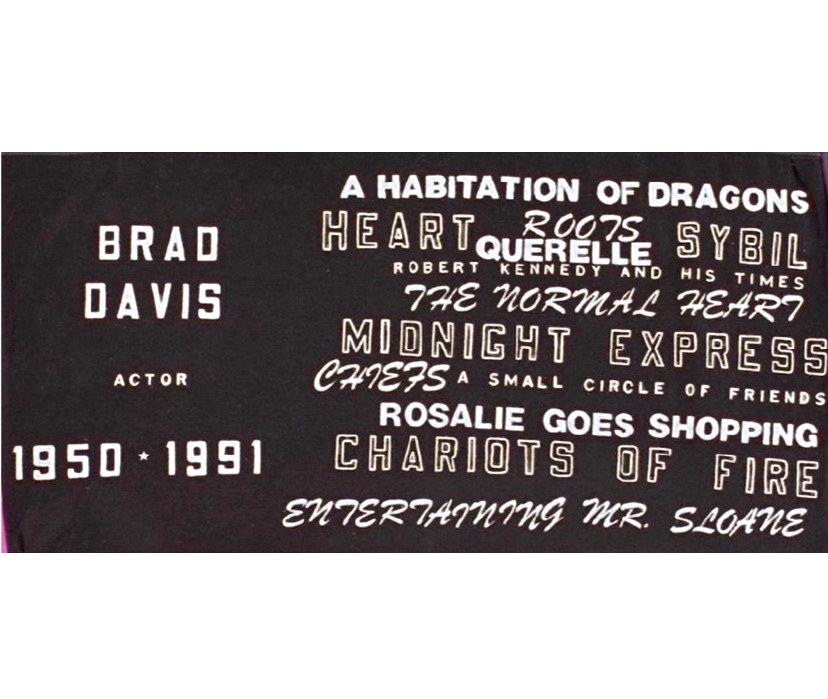
Brad Davis, a film actor known for his powerful performances in Midnight Express (1978) and Chariots of Fire (1981), dies of AIDS-related illness in Los Angeles at the age of 41.
Learn More.Davis also played lead roles in the film Querelle (1982) and in Larry Kramer’s The Normal Heart (1985).
In early December 1985, Cedars-Sinai Medical Center notified Davis that he was HIV-positive, probably the result of intravenous drug use, according to Davis’ wife of 15 years, Susan Bluestein Davis. In an interview with South Coast Today, Bluestein said that her husband’s diagnosis needed to be kept secret in order for him to continue working in the film industry.
“I make my money in an industry that professes to care very much about the fight against AIDS,” Davis wrote in a book proposal developed in the final weeks of his life. “But in actual fact, if an actor is even rumored to have HIV, he gets no support on an individual basis. He does not work.”
Davis’ book, which his wife would complete, would be titled After Midnight: The Life and Death of Brad Davis (1997). According to Bluestein, Davis wanted the world to know that he had been HIV-positive, had developed full-blown AIDS, and had worked in the industry without ever holding up the production of his projects.
In 1978, after landing the lead in Alan Parker’s hit movie Midnight Express, Davis had become an overnight sensation. His quick exposure to wealth and fame led to a series of bad lifestyle choices, and he became addicted to alcohol and drugs.
With his career destroyed and his marriage badly damaged, Davis joined Alcoholics Anonymous in 1981 and became sober. However, the bills from his old lifestyle kept coming due in the form of health problems and then a diagnosis of HIV in late 1985.
Davis kept his condition a secret until shortly before his death in early September 1991. Later, his wife revealed that he committed assisted suicide by a drug overdose.
* * * * * * * *
Photo of quilt panel from the AIDS Memorial Quilt

About six months after testing positive for HIV, EZTV Founder John Dorr reads some of his AIDS-related poems during “The Age of AIDS: Sorrow and Hope,” a fundraiser in West Hollywood for Project Angel Food.
Learn More.Co-sponsored by the City of West Hollywood, the poetry event featured readings by Dorr, Robert Crosson, Gill Cuadros, Carol Muske Dukes, Lewis MacAdams, and Harry Northrup, and was hosted by actor Bruce Davidson (who had won the 1990 Golden Globe Award for Longtime Companion). The event was held in memory of Tim Dlugos (1950-1990), Leland Hickman (1934-1991), and Cookie Meuller (1949-1989), poets and writers who died of AIDS-related illness.
Door told the audience about how he received the news on April 5, 1991, that his HIV test came back positive and days later, he was hospitalized with HIV-related pneumonia. With raw vulnerability, he shared what his life has been like since then.
Dorr was well-known in West Hollywood as a purveyor of media arts, favoring feature-length movies using home analog video equipment. In 1982, he rented the city’s community center (now the site of STORIES: The AIDS Monument in West Hollywood Park) and presented several evenings of his own work, as well as the work of other video-filmmakers including Ken Camp (As the World Burns) and Richard Moyer (Rimbaud in L.A. starring Michael Kearns, Hollywood’s first openly gay actor). This was Dorr’s first use of the term EZTV, according to the EZTV Online Museum.
In 1983, Dorr opened EZTV Video Gallery at 8543 Santa Monica Blvd. in West Hollywood. The space housed a 40-seat screening area and two editing systems. By the mid-1980s, EZTV became a place where members of the West Hollywood community could gather to grieve the loss of those who died of AIDS. Dorr provided his space free of charge for memorial services. In addition, a number of groups focusing on the AIDS crisis (including Queer Nation, ACT Up/LA, AIDS Project Los Angeles, Louise Hays Foundation, and Being Alive) met at EZTV for events, activities and meetings.
Many of EZTV earliest participants died of AIDS-related illnesses, including Mark Addy, James “Dillinger” Baker, Victor Davis, Benedict Falvo, Earl Miller, and Wallace Potts. John Dorr would die of AIDS-related illness about 14 months after this poetry event, on January 1, 1993.
– – – – –
Photo from video taken by Michael J. Masucci.
Los Angeles Lakers basketball star Earvin “Magic” Johnson announces that he is HIV-positive.

Tony Richardson, an English theater and film director whose career spanned five decades, dies of AIDS-related illness at St. Vincent’s Medical Center in Los Angeles. He was 63 years old.
Learn More.Richardson won the Academy Award for Best Director in 1964 for the film Tom Jones. Richardson’s early films, such as A Taste of Honey and The Loneliness of the Long Distance Runner, were an important part of England’s kitchen sink realism movement.
Born in Shipley, West Riding of Yorkshire in 1928, he attended Wadham College, Oxford, where his contemporaries included Rupert Murdoch, Margaret Thatcher, Kenneth Tynan, Lindsay Anderson and Gavin Lambert.
Richardson’s career began in 1953, when he directed productions of Othello and Dostoyevsky’s Gambler for the BBC. He left television in 1955 to become associate artistic director of the new English Stage Company, eventually becoming joint artistic director.
He directed John Osborne’s play Look Back in Anger at the Royal Court Theatre, while also directing Shakespearean productions in Stratford-upon-Avon. In 1957, he directed Laurence Olivier in Osborne’s next play The Entertainer, again for the Royal Court Theatre. By then, he was well on his way to establishing himself as part of the British “New Wave” of directors.
In 1959, Richardson moved onto film projects, co-founding Woodfall Film Productions with John Osborne and producer Harry Saltzman. Their first production was the film version of Look Back in Anger, which Richardson directed.
He made his first Hollywood film, Sanctuary, in 1960 for 20th Century Fox, according to The New York Times.
At the time, Richardson was critical of big Hollywood studios for being afraid to take risks.
“It’s impossible to make films that appeal to everyone, and the only solution is to make them at a non-prohibitive cost, and to try to adhere to a strong, independent point of view that will appeal to at least one body of customers: the ones who want to be stimulated by provocative ideas,” he said in 1960.
In 1962, Richardson and actress Vanessa Redgrave were secretly married, but Redgrave sought and received a divorce five years later. He would father two daughters with Redgrave, and another daughter with Grizelda Grimond.
Richardson was bisexual, but never acknowledged it publicly until after he contracted HIV.
In 1974, Richardson moved to Los Angeles to work with Sam Shepard on a script, which was never realized. His next notable film was the 1984 comedy-drama The Hotel New Hampshire with Rob Lowe and Jodie Foster, which he wrote and directed. Four more major films followed, his last being Blue Sky starring Jessica Lange and Tommy Lee Jones. In all, he directed 23 films, according to the Los Angeles Times.

Jacques Morali, French music producer and creator of the Village People, dies of AIDS-related illness in Paris at the age of 44.
Learn More.The musical group The Village People was originally formed in 1977 by Morali with his business partner Henri Belolo and lead singer Victor Willis.
Morali hired Willis as a background singer for an album he was producing for the Ritchie Family, and saw in him the potential to be the star of his new project.
“I had a dream that you sang lead vocals on an album I produced, and it went very, very big,” Morali reportedly told Willis, according to The Village People website. “I have four tracks. I can’t pay you much right now but if you agree, I’ll make you a star.” Willis agreed and the rest is history.
Those initial four tracks were San Francisco (You’ve Got Me), In Hollywood (Everyone’s a Star), Fire Island, and Village People. Willis performed the songs with professional background singers and they were released as the album Village People. When the album became a fast hit, Morali and Belolo moved fast to find more members for the group.
The Village People’s iconic characters were developed to appeal to disco’s large gay audience. With its members portraying various gay-fantasy personas from American culture, the group became so popular, their music broke through the confines of the club scene to enjoy mainstream success worldwide.
With Willis, Morali wrote their biggest hit, “Y.M.C.A.,” which was added to the National Recording Registry of the Library of Congress in March 2020. Morali (with Belolo and Willis) wrote another big hit with “Go West.”
During the late ’70s and early ’80s, Morali produced nearly 70 disco albums. But when the disco craze faded in the early ’80s, Morali and Belolo would follow up Village People’s success by developing the pop-rap act Break Machine and bringing breakdancing to Europe.
After Morali’s death, Belolo turned to licensing European pop dance acts, such as 2 Unlimited, Eiffel 65, Gala and Haddaway, for the French market.
* * * * * * * *
Photo of quilt panel from the AIDS Memorial Quilt
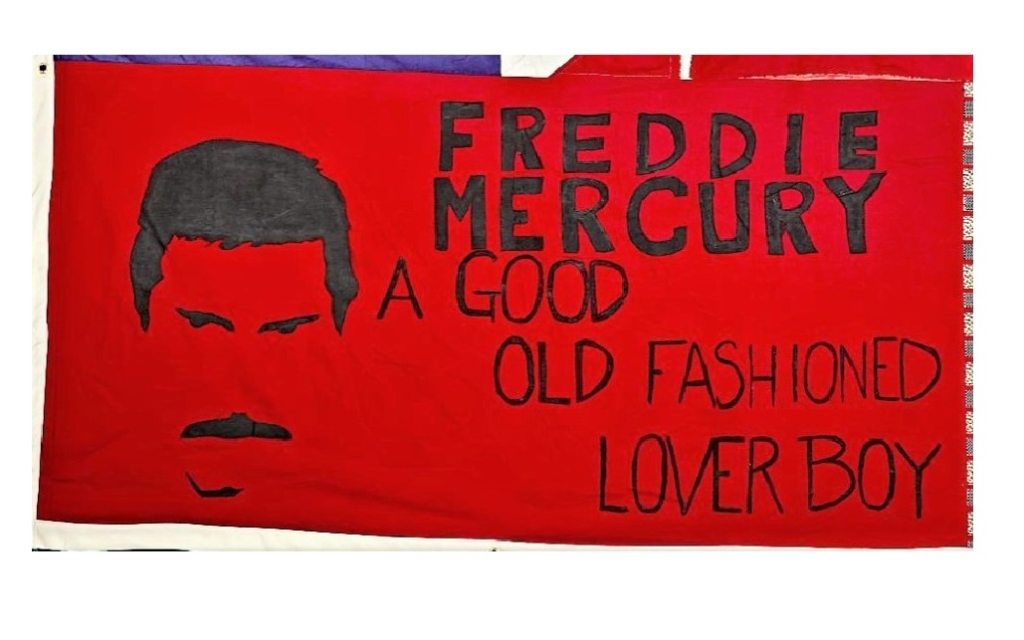
Freddie Mercury, the lead singer-songwriter for the rock band Queen, dies at the age of 45 of AIDS-related illness at his home in west London one day after he publicly announces he is HIV positive.
Learn More.Regarded by fans and critics alike as a consummate showman, Mercury was openly bisexual and enjoyed a colourful rock-star lifestyle.
Born Frederick Bulsara on the East African island of Zanzibar on September 5, 1946, Mercury studied piano in boarding school in India, then befriended numerous musicians at London’s Ealing College of Art.
Mercury would become famous for being one of the rock world’s most versatile and engaging performers and for his mock operatic masterpiece, ‘Bohemian Rhapsody.’ Released in 1975, the six-minute song was nearly never released due to its length and unusual style.
But Mercury insisted to his bandmates and music executives that it be included in their album “A Night at the Opera” and the song would go on to be a worldwide hit and timeless rock anthem.
When members of the music community began to become sick and die from AIDS, Mercury would express fear about becoming infected with HIV, recalls friend Peter Freestone, who believes the singer first suspected he was ill as early as 1987.
For the final two years of his life, Mercury would keep his illness secret from everyone, except those he was closest to, according to his bandmates, and he would live in almost total seclusion.
Only Freddie’s close family and friends were invited to his funeral.
Ten years later, Mercury and Queen would be recognized for their contributions to American music history when they are inducted into the Rock and Roll Hall of Fame in 2001.
* * * * * * * *
Photo of quilt panel from the AIDS Memorial Quilt
Paul Martin Heltsley, a writer for Drummer and other leather-related magazines, dies of AIDS-related illness at his home in San Francisco. He was 29 years old.
Learn More.Heltsley, who wrote under the name Paul Martin, was an assistant editor at Drummer magazine and often led workshops at QSM and San Francisco State Unviversity. He was one of the founders of San Francisco Leather Bears and a member of the National Leather Association and the Phoenix Uniform Club.
Heltsley also composed music in a variety of genres, including jazz, punk and electronica. Prior to moving to San Francisco in 1988, he performed in a punk band in Seattle.
“He cared passionately about the physical , psychological and spiritual implications of Leather and SM,” Heltsley’s partner, Roy Cameron, told the Bay Area Reporter.
“As an expression of his deep personal love of the people in his life, and his desire not to have his friends worry about him, Paul remained silent, even to the end, as to the seriousness of his illness,” Camerson said.
A tree was planted in the AIDS Memorial Grove at San Francisco’s Golden Gate Park as a permanent tribute to Heltsley.

Stan Hadden, a senior administrative aide to California Senate President Pro Tempore David A. Roberti and one of the most influential voices on AIDS policy in Sacramento, dies of AIDS-related illness at the age of 35.
Learn More.As fierce fighter for HIV/AIDS policy for 10 years, Haddon is credited with shepharding the creation of the California AIDS Advisory Committee in 1983 and writing legislation supporting a coordinated approach to local HIV/AIDS programs and services in 1985.
According to Stephen Colbrook’s paper “Clandestine Networks and Closeted Bureaucrats: AIDS and the Forming of a Gay Policy Network in California,” Haddon was a key player among policymakers who jumped into action when the AIDS crisis unfolded. When Hadden learned that a new deadly disease was spreading through San Francisco’s gay community, he brought the epidemic to the attention of his boss, David Roberti, who was the president of the California senate.
Colbrook wrote:
“Hadden quickly emerged as a pivotal figure in California’s response to the AIDS crisis. He was affable, forthright, and pragmatic, burnishing a well-deserved reputation as the AIDS Tsar of California. By 1987, his monthly AIDS newsletter had 25,000 subscribers, and his correspondence reached beyond California to activists in Texas, Illinois, and New York.”
Sen. Roberti provided Hadden with a significant degree of autonomy, with which Hadden used to craft a large portion of California’s early AIDS legislation, including Senate Bill 1215, which expanded the state budget for prevention education by $11 million. Passed in 1985 by an overwhelming bipartisan majority in both the Assembly and Senate at a time when budget funds were thin, SB 1215 cemented California’s leading role in addressing the HIV/AIDS crisis. In 1985, nearly half of the total state spending on the AIDS epidemic was attributed to California, according to Colbrook.
Hadden’s leadership also throughout the 1980s also helped steer California’s action on the epidemic toward a focus on patient confidentiality and individual rights. This focus was not always adopted by other states in their approach to the AIDS crisis. On the other end of the spectrum was Texas, whose political leaders created policy centered on the disease’s perceived threat to the heterosexual population.
Hadden was one of only a few in the 1980s Sacramento political scene who were open about their LGBT identity, journalist Karen Ocamb would later write in The Pride. Scores of administrative and political aides to California legislators remained in the closet, fearful that open knowledge of their sexual identity would end their professional careers. Elected officials and potential candidates who identified as LGBT also remained silenced by the very real fear of ruination.
In the final two weeks of his life, Hadden received round-the-clock nursing care as part of a hospice program. Sacramento AIDS Foundation spokeswoman Patty Blomberg noted that the AIDS care Hadden received might not have existed if it were not for his influence and persistence.
Blomberg told the Sacramento Bee that Hadden had slipped into a coma early that morning and then died at about noon at his farmhouse along the Sacramento River, surrounded by friends and family who had flown in from as far away as Michigan.
Hadden’s funeral would bring in friends and colleagues from around the state, including Ocamb and John Duran, then President of the Board of LIFE AIDS Lobby who would become Mayor of the City of West Hollywood.
“In a gesture unheard of for the suits of Sacramento, a huge rainbow flag was unfurled and solemnly marched down the street to the Capitol,” Ocamb recalled.
“Stan’s memory will go on, because he made a contribution to this state that many of us can only dream of making,” Senate President Pro Tem Roberti said during Hadden’s memorial service at St. Francis Church in midtown Sacramento.
* * * * * * * *
Photo of quilt panel from the AIDS Memorial Quilt

Jerry Nolan, drummer for the band The New York Dolls and a punk rock pioneer, dies of AIDS-related illnesses at St. Vincent’s Hospital in New York. He was 45.
Learn More.The New York Dolls was an early 1970s glam-rock band that had a profound influence on bands as diverse as the Sex Pistols to Motley Crue. Nolan joined the band in 1972 after the original drummer, Billy Murcia, died of a drug overdose while on tour in the U.K. he played on the Dolls’ first two albums (New York Dolls and Too Much Too Soon).
Nolan and bandmate Johnny Thunders left the Dolls of 1975 to form a new band, The Heartbreakers, with Richard Hell. By this time, both were addicted to heroin.
Malcolm McLaren, the manager of The Sex Pistols, booked The Heartbreakers in 1976 for the doomed Anarchy in the UK tour, where they only played seven of the 19 booked gigs. As chaotic as the tour was, The Heartbreakers managed to get a record deal from the exposure and released their first and only album, L.A.M.F.” in 1977.
L.A.M.F. initially received poor reviews, largely due to its poor production quality, but appreciation for the work has grown over time. New Musical Express magazine named L.A.M.F. one of the greatest albums of all time.
The band became so iconic of the punk scene that it appears on the cover of what is arguably the definitive book on the punk rock era, Please Kill Me: The Uncensored Oral History of Punk.
What also accompanied The Heartbreakers’ reputation as a punk rock super-band was the band members’ problem with heroin addiction. In fact, their drug habit was immortalized in the song “Chinese Rocks,” co-written by Johnny Thunders and Dee Dee Ramone of The Ramones.
Unable to produce a second album, the band broke up and Nolan began a series of music projects and his creative output began to dwindle. In late 1991, after years of intravenous drug use, Nolan was hospitalized at St. Vincent’s Hospital for bacterial meningitis and bacterial pneumonia. During treatment, he suffered a stroke and went into a coma, from which he never recovered. He spent his final weeks on a life support system.
In 2017, Nolan’s story was featured in Stranded in the Jungle: Jerry Nolan’s Wild Ride – A tale of drugs, fashion, the New York Dolls, and Punk Rock, by Curt Weiss. In the book, many who knew Nolan described him as a top musician and charismatic performer. He was also known as “a racist, a junky and a ruthless exploiter of the many women who fell for him,” according to a book review by Only Rock and Roll.
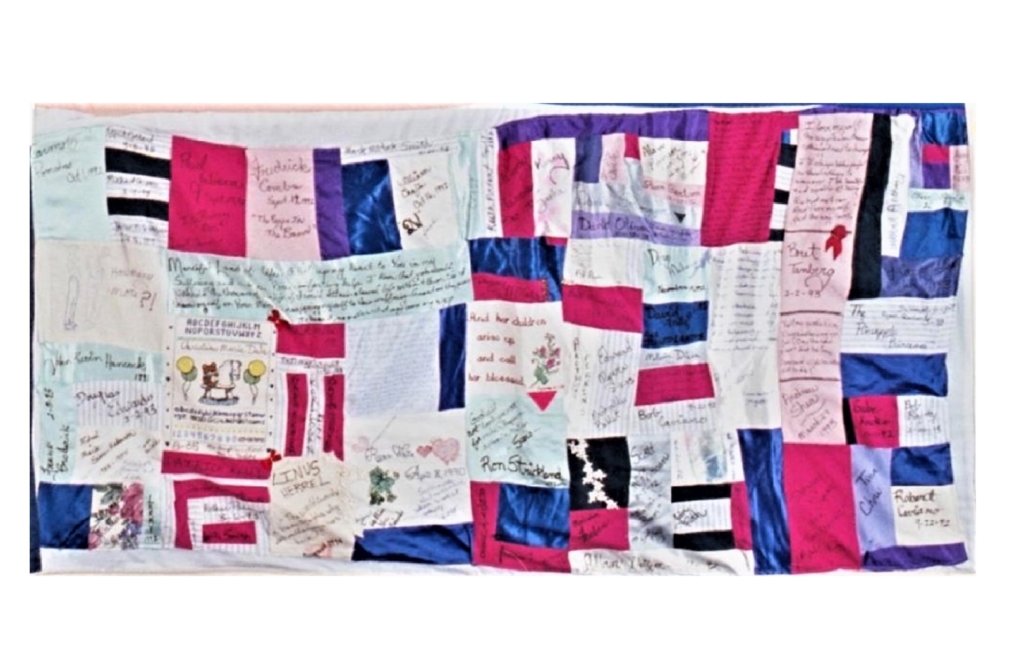
Jewelry designer and activist Tina Chow dies of AIDS-related illness in Pacific Palisades, California at the age of 41.
Learn More.Born Bettina Louise Lutz, the supermodel, jewellery designer and fashion collector, was married to restaurateur Michael Chow in 1972 and became known professionally as Tina Chow. In the 1970s, she was featured prominently in advertising campaigns for the Japanese cosmetic line Shiseido.
“Chow broke the mold of being a model with an androgynous look and a distinctly chic fashion sensibility that gave her notoriety,” writes artist Maxwell N. Burnstein in his tribute to her on the Council of Fashion Designers of America website.
Karl Lagerfeld credits Chow as the inventor of minimal chic, and Kate Moss considers her to be her style icon. Recognized as having a profound influence on the styles of her era, Chow was initiated into the International Best Dressed List Hall of Fame in 1985.
The same year, Helmut Newton took a portrait photograph of Chow and her husband in which their power dynamics are made evident.
“In the photograph, the two are separated, physically, by the counter of a bar,” writes Cynthia Cruz in The Critical Flame. “He standing in dark glasses, holding a glass in his hand, staring at her while she is on the other side, in a long white dress, her eyes made dark with make-up, tied to the bar with rope.”
In the mid-1980s, Chow began to find the non-stop party lifestyle tiresome, and was encouraged by artist Andy Warhol to turn her attention to jewellery design. She incorporated stones and crystals associated with healing properties into bamboo and used traditional Japanese basket weaving techniques to follow the shapes of uncut stones.
“Chow’s pieces of jewelry are unusual, neither delicate or what one might usually consider ‘beautiful,'” writes Cynthia Cruz in her tribute to Chow. “Instead, the pieces are solid, anchored.”
The piece for which Chow is best known is her Kyoto Bracelet, constructed of black bamboo with seven rose quartz pebbles inside.
Around this time, Chow also deepened her commitment to AIDS charity work. In an interview with the Chicago Tribune, she explained, “I lost several friends to AIDS, and I felt my life slipping away while I continued to party.”
She also separated from her husband and embarked on a series of affairs, first with a film star who introduced her to Tibetan Buddhism and the Dalai Lama, and later with the French aristocrat Kim D’Estainvillle.
In 1989, Chow and her husband divorced. Five months later, she learned that she was HIV positive. Chow refused to take any of the medicine her Western doctors recommended. Instead, she opted for a holistic approach, attempting to heal herself with crystals, macrobiotics, teas, and similar somatic modes of healing.
After Chow had made her illness public, she continued to work with AIDS organizations, including Project Angel Food. She ultimately lost her life from complications from AIDS at her home in Pacific Palisades on January 24, 1992.
* * * * * * * *
Photo of quilt panel from the AIDS Memorial Quilt

After stunning the world three months earlier with the news he had contracted the HIV virus, basketball great Magic Johnson returns to play in the 42nd NBA All-Star game in Orlando, Florida, where the crowd greets him with a standing ovation.
Learn More.On November 7, 1991, Earvin “Magic” Johnson held a news conference to announce he had tested positive for HIV and he was immediately retiring from the Los Angeles Lakers. At the time, Johnson, was one of the biggest stars in basketball, having won five NBA championships with the Lakers and played in 11 All-Star games.
Despite not playing during the 1991-92 regular season, Johnson was such a hugely popular point guard that fans voted him to the All-Star team representing the Western Conference. Johnson played a total of 29 minutes, during which he scored 25 points, made nine assists and helped the West beat the East, 153 to 113. As the conclusion of the game, players from both teams came onto the court and hugged Johnson, who was also named the game’s Most Valuable Player.
Later in the year, Johnson would play in the 1992 Olympic Summer Games as a member of the American basketball squad — nicknamed the Dream Team. The American team would capture the gold medal.
In the late 1990s, Johnson would retire from his storied athletic career and become an AIDS activist and successful entrepreneur.
Photo courtesy of the NBA.

Considered one of the “Big Three” science fiction writers in America, Isaac Asimov died in Manhattan of AIDS-related illness at the age of 72.
Learn More.The cause of death was initially reported as heart and kidney failure. In 2002, the Asimov family would correct the record to reflect that Asimov died from AIDS-related illness.
A prolific writer, Asinov was best known for writing science fiction attentive to scientific accuracy and logic. He also wrote mysteries, fantasy, and nonfiction.
His most famous work is the Foundation series, the first three books of which won the one-time Hugo Award for “Best All-Time Series” in 1966. His other major works include the Galactic Empire series and the Robot series. In addition, he also wrote over 380 short stories, including the social science fiction novelette “Nightfall,” which in 1964 was voted the best short science fiction story of all time by the Science Fiction Writers of America.
Asimov’s wife, Janet, would make public the details around Asimov’s HIV-positive status in the last 10 years of his life with the posthumous release of his autobiography It’s Been a Good Life.
Asimov suffered a heart attack in 1977, and six years later, he underwent triple bypass surgery at NYU Medical Center, during which he contracted HIV from a blood transfusion. His HIV status was kept secret out of concern that the anti-AIDS prejudice prevelant in the 1980s might extend to his family members.
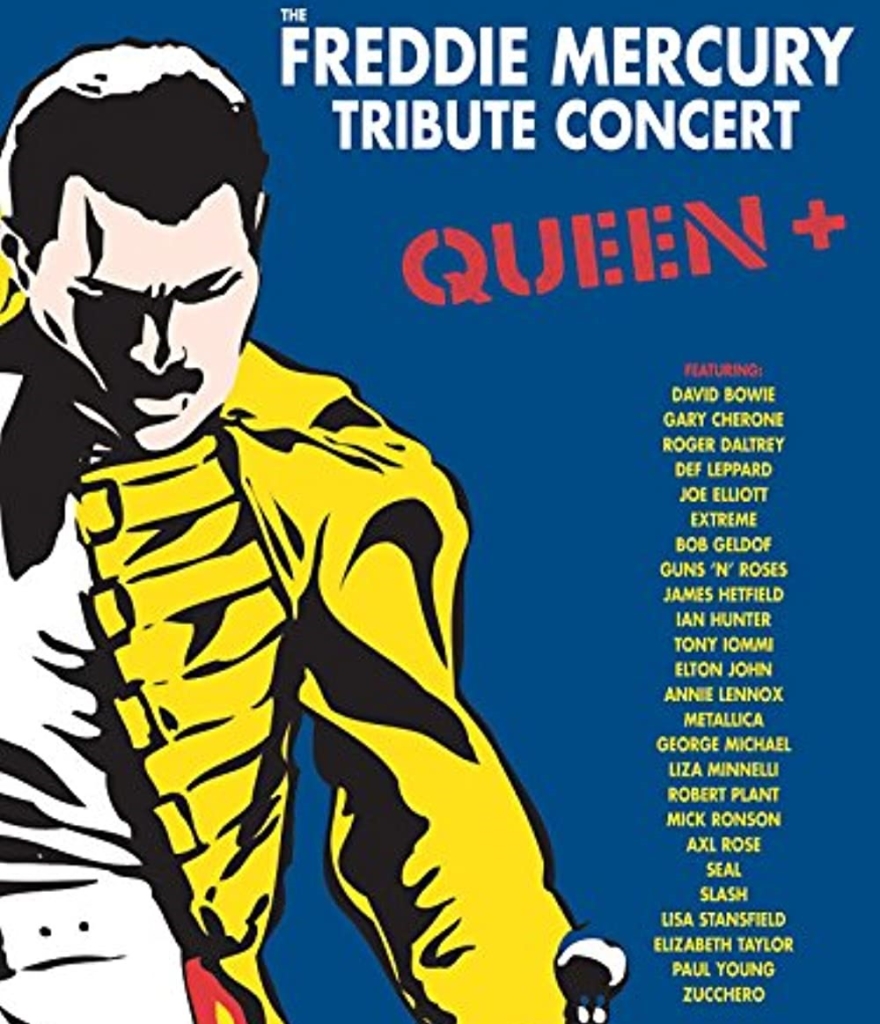
The sold-out Freddie Mercury Tribute Concert for AIDS Awareness is broadcast in 76 countries, with an estimated that one billion people tuning in worldwide.
Learn More.Considered one of the biggest benefit concerts of all time, the Freddie Mercury Tribute Concert featured “warm-up acts” by Metallica, Def Leppard, and Guns N’ Roses.
Between bands, several video clips honoring Freddie Mercury were shown. Film star and AIDS activist Elizabeth Taylor then spoke about AIDS prevention, which was followed by a compilation of Mercury’s performances.
Then came the main event: a greatest-hits set from Queen featuring stand-in vocals from superstars that included David Bowie, Robert Plant, Elton John, Annie Lennox, Axl Rose and George Michael.
“It was George Michael who seized the day with a passionate, thrilling performance of “Somebody To Love.” wrote London-based music critic Jamie Atkins in U Discover Music.
After Queen front man Freddie Mercury died on November 24, 1991 after a long battle with AIDS, his bandmates decided to honor him with a concert to raise money for AIDS research. This form of tribute was fitting, given that, seven years earlier, Mercury had delivered the performance of his life at the Live Aid benefit concert.
The concert was held in London’s Wembley Stadium and all 72,000 tickets sold out in three hours, despite that the only confirmed act was Queen and the band still did not have a new front man.
All proceeds from the concert were used to launch the Mercury Phoenix Trust (MPT), a nonprofit organization dedicated to funding programs for HIV/AIDS awareness and treatment.
Since then, MPT has released tapes of the concert at various times to raise money for HIV/AIDS programs and, in 2020, for the World Health Organization’s COVID-19 Solidarity Response Fund.
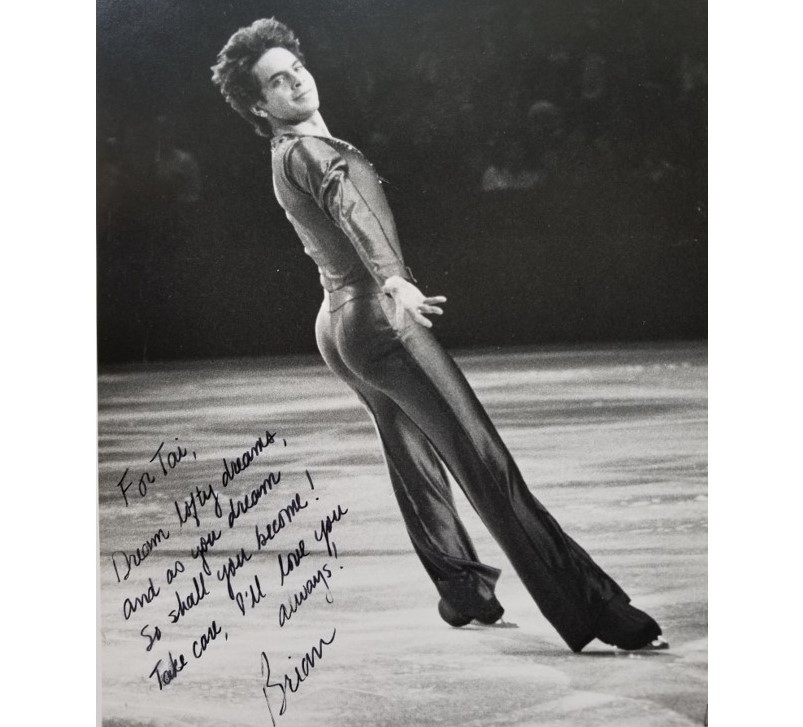
Three-time Canadian men’s champion Brian Pockar dies of AIDS-related illness in Calgary at the age of 32.
Learn More.Pockar was the 1982 World bronze medalist, a Canadian national champion from 1978 to 1980, and competed at the 1980 Winter Olympics. After turning pro, Pockar toured with “Stars on Ice” and worked as a choreographer.
Pockar was the first figure skater to successfully complete a triple one-foot
salchow/double flip combination jump at the World Championships. He was recognized as one of Canada’s best athletes when he was presented with five
Alberta Achievement Awards, and in 1982, was presented with the Government of Canada Sport Excellence Award.
Pockar was very quiet about his struggle with AIDS, according to columnist Filip Bondy of The New York Times.
“Even after his death, Pockar’s family members have tried to avoid sensational revelations,” Bondy wrote in a November 1992 column about AIDS deaths among figure skaters. “Through a spokesman, the family released a simple statement: ‘Brian wanted to be remembered for his accomplishments in life, and not for the cause of his death.'”
Pockar was posthumously inducted into the Skate Canada Hall of Fame. Annually, Skate Canada’s Alberta-Northwest Territories/Nunavut Section hosts the Brian Pockar Male Seminar, which provides training to male figure skaters. The Pockar Foundation helps fund this seminar every year.
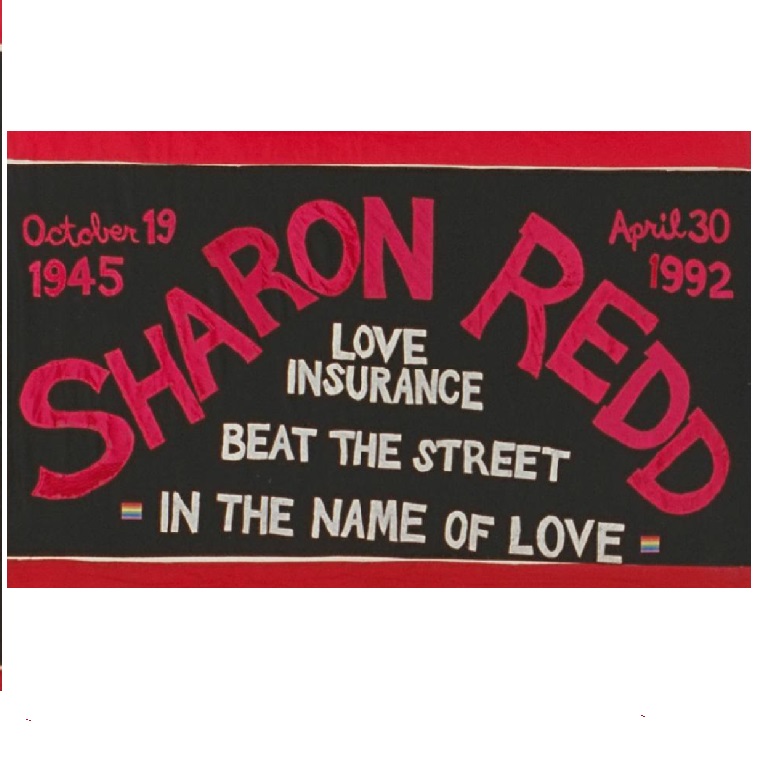
Sharon Redd, a singer and actress whose voice energized nightclubs in the 1970s and 1980s, dies of AIDS-related illness. She was 46.
Learn More.Redd signed with United Artists in 1968 and immediately recorded four singles, which included the Hank Williams song “Half as Much.” She also landed a lead role in the Australian production of the rock musical Hair, and recorded the song “Easy to be Hard” (1969) for the Australian soundtrack of the musical.
“All these records helped her to establish a reputation as a very fine R&B singer with an expressive voice,” writes music critic Stian M. Eriksen. “They reveal a much more soulful Sharon than what you find on most of her club hits of the ’80s.”
After Redd returned from Australia, she won the first “Schaefer Beer Talent Hunt” and became known nationwide as the “Schaefer Beer Girl. This exposure helped her secure a spot as one of Bette Midler’s backup singers (called “The Harlettes”) from 1973 to 1978.
Redd, Charlotte Crossley and Ula Hedwig were thought of as the consummate Harlettes trio, according to the Bette Midler fan site Bootleg Betty.
“Sharon Redd and Charlotte Crossley are two beautiful brown ladies with some of the best pipes in the music business. Add the sleek willowy frame of Ula Hedwig and a voice that ranges from the purest high tones to the gutsiest blue notes, and what you get is some of the freshest and most dynamic music being created in the New York nightclub circuit,” wrote Don Bradshaw (also known as “Mister D”), editor of Bootleg Betty.
To perform with “Miss M,” the Harlettes had to master a wide range of musical styles, ranging from ’30s and ’40s ballads to modern rock, country, blues, and gospel. Their act grew so strong, club owners sought to book The Harlettes as a separate act during the months Midler retreated to write new shows, and they even recorded an album under the name Formerly of The Harlettes.
“With Bette, we learned the importance of theatre, that is, creating a character that enhances the music we were singing,” Redd told an interviewer in 1978. “In addition, this helped to sustain a high-performance level under widely varying conditions and locations. Bette emphasized the importance of the group to her show and we learned to work together.”
Redd also performed vocals with Bonnie Raitt, Gwen McCrae (“Love Insurance”), and Norman Connors (“You Are My Starship”), and by the end of the decade, she had a solo deal with Prelude Records, which was known for disco hits.
During the heyday of disco, Redd released three albums for Prelude. After releasing her first LP, she was steered toward Prelude’s production powerhouses Eric Matthew and Darryl Payne, according to music site Ransom Note.
Matthew and Payne employed the recent technology of drum machines and synthesizers to create an “electronic undercurrent” to Redd’s dynamic vocals, and created a fresh sound that influenced the future of music.
“For me, with Sharon, Eric and Darryl forming their post-disco Prelude triptych, they recorded the definitive proto-House rhythm – building the foundations for what we know as House,” writes the author of House Hunting.
While Redd’s singles didn’t register on radio playlists, they were in constant circulation in the dance clubs. Her “boogie bomb” recordings of “Can You Handle It,” “Never Give You Up,” “Beat the Street,” and “Love How You Feel” became nightclub standards. Many DJs, recognizing the malleability of the work, issued creative re-mixes to extend their popularity.
After her third and final Prelude album, Redd slowed down and occasionally did more session work. She released a new single in 1991, but that would prove to be her final work.
She was diagnosed with HIV and, after stepping on broken glass during a 1992 performance, Redd’s immune system became overwhelmed. Her health steadily declined and she died in May 1992 in upstate New York.
“I made a decision,” Redd told an interviewer in 1978. “This is my life, and I thank God there’s been enough success to make it all seem worthwhile.”
Robert Gladstein, choreographer, dancer and former assistant director of the San Francisco Ballet, dies at his home of AIDS-related illness at age 49. The New York Times and Los Angeles Times report the cause of death as “cancer.”
Learn More.Gladstein was a principal dancer of the San Francisco Ballet in 1970, the company’s ballet master in 1975, and, in 1980, its assistant director and artistic coordinator. In his time with the company, he choreographed more than 30 ballets, including Symphony in Three Movements and Psalms. Some of these works were televised on San Francisco’s PBS station, KQED.
Born in Berkeley in 1943, Gladstein made his debut at age 10 when he danced in a production of The Nutcracker by the San Francisco Ballet School, according to The New York Times. He graduated from the school in 1960.
In 1967, he joined the company of New York’s American Ballet Theatre. After three years, he returned to the San Francisco Ballet as a principal dancer. After assisting in multiple efforts to rescue San Francisco Ballet from near bankruptcy in 1974, Gladstein served as the company’s Ballet Master from 1975 until 1980, when he became the Ballet’s Assistant Director and Artistic Coordinator.
He left California again in 1986 to become ballet master for the Dallas Ballet, a position he held until 1988.
Gladstein also was a member of the dance advisory panel of the National Endowment for the Arts from 1981 to 1986, a time when then-President Ronald Reagan attempted to abolish the federal arts grant program. When Reagan’s efforts to kill the NEA failed, he then began a campaign to defund the program and initially cut its budget in 1981 from $158.8 million to $143.5 million.
The Robert Gladstein Papers, which include performance materials, photography, souvenir books, correspondence, and sheet music from his time at the San Francisco Ballet, are preserved in the Museum of Performance and Design’s Performing Arts Library. Gladstein’s biography is included in the project Dancers We Lost: Honoring Performers Lost to HIV/AIDS.

With the country’s refugee camps in Guantanamo Bay exceeding capacity, President George H.W. Bush closes the U.S. to any additional asylum-seekers from Haiti, ordering the Coast Guard to return directly to Haiti any refugees they encounter in the sea.
Learn More.The decision left in limbo a group of more than 300 Haitians who had tested positive for HIV and were quarantined with their families in Camp Bulkeley, a separate detention center in Guantanamo Bay. The Haitians in Camp Bulkeley qualified for refugee status in the U.S., but a Bush Administration policy forbid HIV-positive people from entering the country.
Issued from President Bush’s vacation home in Kennebunkport, Maine, the new order officially ended a policy that allowed refugees from Haitians to plead their case for asylum with Immigration and Naturalization Service (INS) officials, and triggered responses of concern and outrageous from human rights leaders.
“This is a violation of international law,” Ira Kurzban, a human rights lawyer in Miami who was unsuccessful in getting the Supreme Court to rule on the Haitian refugee issue, told the Los Angeles Times.
“The U.N. convention on the status of refugees prohibits the return of refugees when they would face persecution,” said Kurzban. “Apparently the President’s version of the new world order is to ignore existing international treaty obligations.”
Kurzban’s comment referenced President Bush’s 1991 speech in which he called for building “a new world order” where the rule of law would govern the conduct of nations,.
Jocelyn McCalla, executive director of the National Coalition for Haitian Refugees, told the Los Angeles Times that the U.S. policy shift would cost Haitian lives.
“It’s also an admission in our opinion that U.S. (immigration and asylum) policy is not working — if there ever was a policy,” said McCalla. “The Administration would rather accept the status quo than do something to restore democracy and achieve stability that would be beneficial for Haiti and all countries in the region.”
Henceforth, the U.S. Coast Guard would return all asylum-seekers from Haiti to their country, which was reeling from the emergence of a violent junta intent on persecuting anyone seen as problematic to the military-led leadership. Many Haitians were in the crosshairs of the new leaders, including officials from the previous democratically elected administration, as well as members of community associations, trade unions, and groups that promoted literacy, democracy, and women’s rights, according to the Human Rights Watch World Report 1993 – Haiti.
Following President Bush’s order of May 24, 1993, White House advised Haitians fearful of persecution to file a claim with the U.S. Embassy in Port-au-Prince, Haiti.
Starting on May 25, 2993, the U.S. Coast Guard positioned 10 vessels off the shores of Haiti to intercept and escort back any seaworthy boats filled with refugees. For any craft that could not complete the return journey, Coast Guard officials would bring aboard the refugees and transport them directly to Haitian ports.
The decision to turn back fleeing Haitians did not affect the more than 12,000 Haitian asylum-seekers detained in Guantanamo Bay. Since the military coup ousted Haiti’s democratically elected president in September 1991, Coast Guard vessels had plucked refugees from the seas and transported them to the Guantanamo Bay camp, where claims for political asylum were reviewed by INS officials. More than 20,000 migrants determined to be fleeing economic hardship rather than political persecution already had been returned to Haiti.
Earlier this month, the number of refugees being intercepted by the Coast Guard had dramatically increased, according to the Los Angeles Times. Bush Administration officials said that they had worked in recent weeks to open a second refugee camp in the Dominican Republic or in another Caribbean nation, but they could not secure the cooperation of another country.
“At this point we have no choice but to require all Haitians to be picked up and sent back to Haiti,” said White House deputy press secretary Judy Smith. She said the United States will take new steps to urge Haitians not to attempt the crossing.
In imposing the new restrictions, the White House also said that Bush had called for an “intensification” of humanitarian assistance efforts in Haiti as requested last week by the Organization of American States.
* * * * *
Photo from the U.S. National Archives.
Robert Pruzan, longtime photographer for the Bay Area Reporter who also created photographic art, dies of AIDS-related illness at Davies Medical Center in San Francisco. He was 45 years old.
Learn More.Pruzman documented the queer history of San Francisco throughout the 1970s and 1980s, according to Gary Aylesworth of the Bay Area Reporter. His work was published in Drummer, Manifest, Sports Illustrated, and the San Francisco Examiner’s Image magazine, as well as in Geoff Mains’ book Urban Aboriginals.
“Although he worked in photojournalism for years, his fine art photography is brilliant and important,” wrote Aylesworth. “There are, perhaps, a quarter of a million slides in his collection.”
Born in 1946 in Seattle, Pruzman studied mime in Paris with Etienne Decroux in the 1960s. As Decroux’s first assistant, he taught mime to many who would become notable performers, like Bill Irwin , Geoff Hoyle, and Leonard Pitt. He returned to the U.S. and taught mime in New York City.
Pruzman took an interest in floral arranging after taking a class in Japanese ikebana, and in 1973, he moved to San Francisco, where he began working as a horticulturist and photographer. Advancing his parallel interests, he became a member of the California Horticultural Society and photographed the first Haight Street Fair in May 1978. He also photographed the Castro Street Fair, early Pride Parades, and the Folsom and Up Your Alley Fairs through 1991.
In addition to documenting San Francisco’s gay and leather communities, Pruzman regularly photographed opera stars like Pavorotti and drag artists like Divine. Harvey Milk, Wavy Gravy, Nancy Pelosi, Jane Dornacker, Robert Mapplethorpe — all were captured by Purzman’s camera.
Friends told the Bay Area Reporter that Pruzman’s apartment was filled with exotic plants. He curated many gardens throughout the Bay Area, and longtime friend Nancy McNally said Pruzman inspired her to create the AIDS Memorial Grove in Golden Gate Park, which would open about a month after Pruzman’s death with a memorial service and planting in his honor.
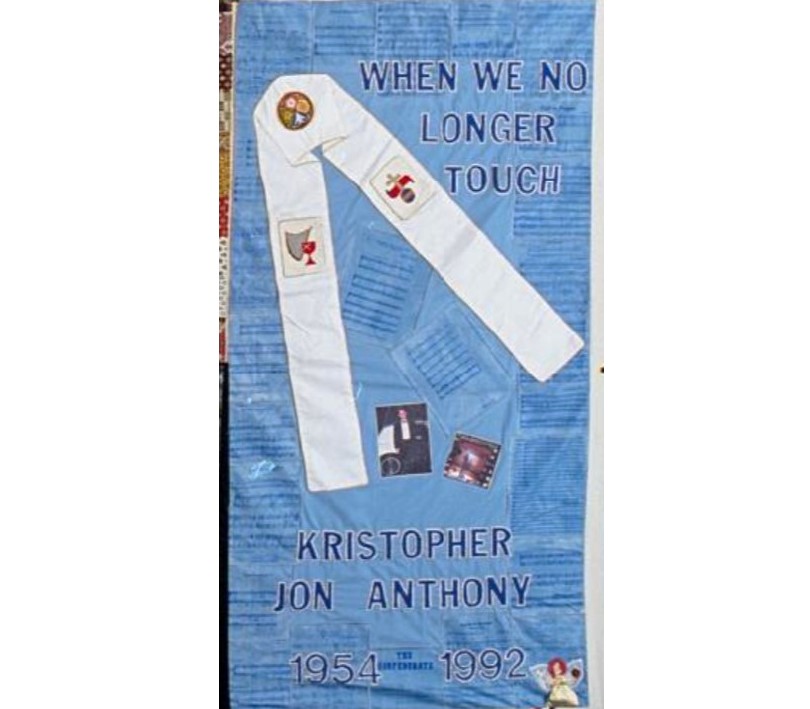
Kristopher “Kris” Anthony, composer-in-residence for the Turtle Creek Chorale, dies of AIDS-related illness at his Dallas home. He was 38.
Learn More.Anthony first composed for the Turtle Creek Chorale in July 1982 and he continued to compose for and sing with the Chorale until the end of his life. His work for the Chorale culminated in his composition for When We No Longer Touch: A Cycle of Songs for Survival, a choral rendition of the stages of grief that was composed by composer-in-residence Kristopher Anthony.
During that time with the Turtle Creek Chorale, he composed and created arrangements and revoicing for the following productions:
Anthony was also director of music for the Central Christian Church and a member of the Dallas Handbell Ensemble. Originally from Onalaska, Wisconsin, Anthony received his Bachelor degree from the University of Wisconsin-La Crosse and his Masters in Music Theory and Composition from the University of Miami, according to the Dallas Voice. He moved to Texas to pursue his doctorate degree at the University of North Texas.
Anthony found a home for his talents at the Turtle Creek Chorale, which was founded in early 1980, according to Michael Sullivan in The Dallas Way. The group was named after the small stream that passed through the queer-friendly Dallas neighborhood of Oak Lawn.
“In some cities, the newly-formed choruses boldly chose to use the word ‘gay’ in their name, but in the buckle of the Bible Belt, the founders of just such a chorus in Dallas decided against it for what seemed obvious reasons,” Sullivan wrote in 2017.
Chief among those reasons was the fact that many of the singers were public school teachers, and the local superintendent was a a notoriously homophobic man who threatened to fire openly gay teachers.
The group first rehearsed in February 1980 with 39 singers. On June 24, 1980, 70 members of the Chorale gave its first formal concert at the campus of Southern Methodist University in Dallas. By the end of its first season, the group had grown to 83 members.
In 1985, HIV/AIDS began to impact the Chorale. As members began to get sick and die, the group transformed to become a space for its members to grieve and heal through performance and community, according to the University of North Texas’ 2017 exhibit Threads of Remembrance.
In its 1987 holiday performance, the Turtle Creek Chorale placed a poinsettia on the piano to honor the memory of those who had died of HIV/AIDS. When the number of fatalities reached 20, the tradition evolved into having a poinsettia placed at the front of the stage for each individual.
In April 1994, PBS would televise the documentary After Goodbye: An AIDS Story, which looked at the impact of epidemic on the Turtle Creek Chorale. The film follows the Chorale through rehearsals and performances of When We No Longer Touch: A Cycle of Songs for Survival, a choral rendition of the stages of grief that was composed by Kristopher Anthony.
At the time the documentary was filmed in 1993, the Chorale had already lost more than 90 members to AIDS, including Anthony.
By 2013, the AIDS death toll at the Chorale would reach 197. Still to this day, during its holiday performances, the group places on the stage a field of poinsettia plants, one for each Chorale member who has passed.
* * * * * * * *
Photo of quilt panel from the AIDS Memorial Quilt
David Wojnarowicz, an AIDS activist prominent in the East Village art scene, dies of AIDS-related illness at his home; he was 37.
Learn More.David Wojnarowicz was notable for incorporating in his art personal narratives influenced by his struggle with AIDS as well as his political activism.
In early 1981, Wojnarowicz met photographer Peter Hujar, and they were briefly lovers. Wojnarowicz came to see Hujar as a friend and mentor, referring to him in an essay as “my brother, my father, my emotional link to the world.”
After Hujar died of AIDS in late 1987, Wojnarowicz moved into his loft on 2nd Avenue between 1st and 2nd streets and successfully fought the landlord to retain the lease. After being diagnosed with AIDS, Wojnarowicz dedicated the remaining years of his life to photography, writing, and activism.
Wojnarowicz began to include in his work more political content, notably about the social and legal injustices related to the government response to the AIDS epidemic. In 1989, Wojnarowicz appeared in Rosa von Praunheim’s widely acclaimed film Silence = Death about gay artists in New York City fighting for the rights of people living with AIDS. In a collaboration with video artist Tom Rubnitz, he produced the short film Listen to This (1992), a critique of the Reagan and Bush administrations’ homophobic responses and failure to address the crisis.
Wojnarowicz also wrote Close to the Knives: A Memoir of Disintegration (1991), a collection of essays covering his troubled childhood, his life as a NYC artist, and his AIDS diagnosis. A year later, he published Memories that Smell like Gasoline, a memoir interspersed with ink drawings.
In 1992, the band U2 used Wojnarowicz’s tumbling buffalo photograph Untitled (Buffaloes) for the cover art of its single “One.” The band further adapted this imagery during its Zoo TV Tour. The single and subsequent album became multi-platinum over the next few years, and the band donated a large portion of its earnings to AIDS charities. An oversized gelatin print of Untitled (Buffaloes) sold at auction in October 2014 for $125,000, more than four times the estimated price.
In 2018, the Whitney Museum of American Art in New York presented David Wojnarowicz: History Keeps Me Awake at Night, an exhibit of his work. Author Christine Smallwood wrote at length in The New York Times Magazine about one of the pieces in the exhibit.
“If you know one work by David Wojnarowicz, it is probably (Untitled) One Day This Kid, a black-and-white self-portrait of the artist as a prepubescent, surrounded by text,” Smallwood wrote. “This kid is wearing suspenders and a gee-whiz face, all forehead and chin and two buck teeth. His ears stick out like satellite dishes. It’s the early ’60s, and Wojnarowicz looks as if he walked into the Sears photo studio directly from the set of Leave it to Beaver. Then you read the words:
‘One day this kid will get larger. … One day this kid will feel something stir. … One day this kid will do something that causes men who wear the uniforms of priests and rabbis, men who inhabit certain stone buildings, to call for his death. One day politicians will enact legislation against this kid. … He will be subject to loss of home, civil rights, jobs and all conceivable freedoms. All this will begin to happen in one or two years when he discovers he desires to place his naked body on the naked body of another boy.’
Smallwood continued, “It remains a powerful statement about innocence, shame, hate, homophobia and the dangers posed to individual liberty by repressive governments.”
The Art History website smarthistory calls this work “a kind of time machine.”
When Wojnarowicz created (Untitled) One Day This Kid in 1990, many gay men in urban centers like New York City were dying of AIDS-related illnesses, and no effective treatment or cure was available. It was a time when politicians and religious leaders were demonizing gay men and pressuring the government to continue to under-fund and under-respond to the epidemic.
“Wojnarowicz catches his innocent past self before his ‘fall,’ warning him of what is to come as punishment simply for loving people of the same sex,” wrote smarthistory writer Jon Davies. “It deploys sentiment to illustrate how homophobia destroys children, because many of us are aware of our difference in our early years and quickly understand that we may be hated for it.”
After Wojnarowicz died, his body was cremated and some of his ashes were scattered in protest on the White House lawn during an AIDS protest.
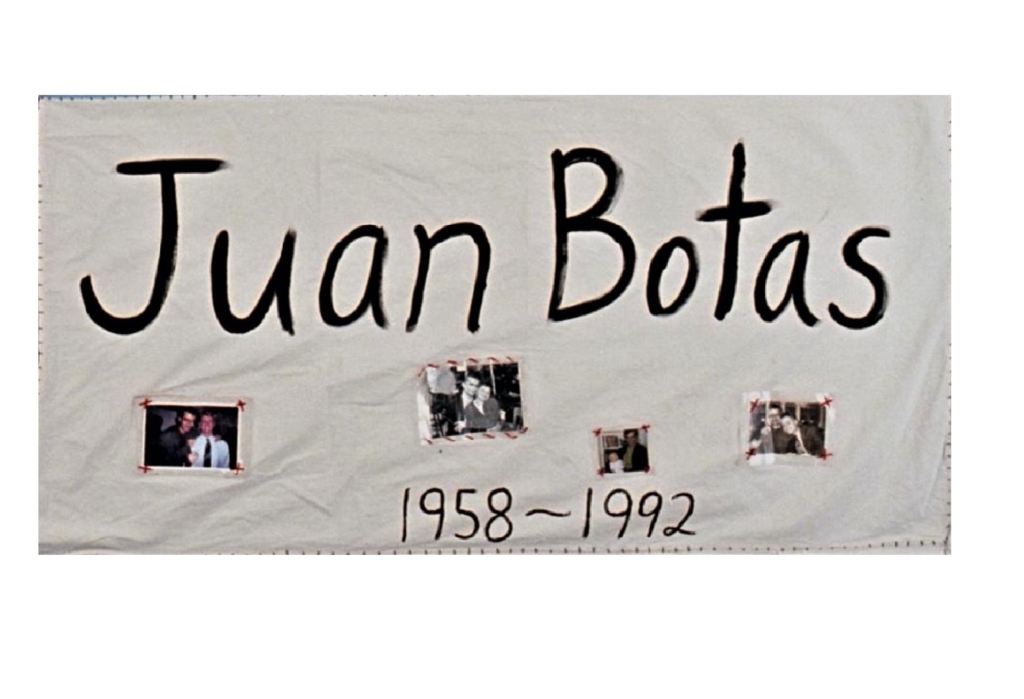
Juan Suárez Botas, illustrator, graphic designer and film maker, dies of AIDS-related illness at St. Vincent’s Hospital in New York City at the age of 34.
Learn More.Botas’ illustrations appeared on the covers of Time, Fortune, U.S. News & World Report and other magazines. His drawings appeared in The New York Times, Vogue and other publications.
Botas moved to the U.S. from Spain in 1977. At the time of his death, he was directing a documentary about his AIDS treatment group at the time of his death, which was released as One Foot on a Banana Peel, the Other Foot in the Grave: Secrets from the Dolly Madison Room.
A friend of film director Jonathan Demme, Botas was a major influence on Demme’s decision to make the film Philadelphia.
* * * * * * * *
Photo of quilt panel from the AIDS Memorial Quilt

Glynis Johnson, who played bass in the Chicago punk bands Friends of Betty and Red Red Meat, dies of AIDS-related illness in her hometown of Valparaiso, Indiana. She was 32.
Learn More.Glynis Johnson formed the band Friends of Betty in 1984 with Tim Rutili and Ben Massarella. Rutili, who was six years younger than Johnson, was a film school student when they became a couple.
“She was an amazing, funny, smart, beautiful person,” Rutili told reporter Jeff Johnson of The Awl in 2013. “And I loved her. I can’t even tell you how much I loved her. And I still really miss her. Even last night, we played in Athens and I was talking to a girl and she did this gesture that reminded me of Glynis and it sort of killed me for a second. I do miss her.”
As a noisy punk band, Friends of Betty attracted a following at local bars and released a 1988 album Blind Faith II. When the album failed to sell, the band changed its name to Red Red Meat and changed their sound to a “hazed-but-focused blues-touched rock,” Chicago Reader music. critic Peter Margasak wrote in 1994.
Johnson grew up in Valparaiso, Indiana, and worked for a while in Portland, Oregon as a painter and carpenter, according to a 1992 article in the Chicago Reader. She moved to Chicago to become part of the music scene.
“She was a Rolling Stones freak,” wrote Bill Wyman of The Reader. “Every summer, she and some friends would hold a Steaks and Stones barbecue.”
Bandmate, flatmate and boyfriend Tim Rutili said he and Johnson had been going out for five or six years when he noticed that she was spending more and more time with drug addicts at a local bar. Shortly after, he broke up with her and moved out of their apartment.
In the years that followed, Johnson’s began to experience chronic infections, and doctors told her she had bronchitis, according to Wyman.
“She started getting thin, and her hair began to fall out,” Wyman wrote. “In August [1992], she went to visit her mom back in Valparaiso …. There she learned what some of her friends suspected she already knew, that she’d been suffering the effects of AIDS for at least two years.”
When Rutili learned that Johnson was living with AIDS, he sought out an HIV test for himself and he was relieved when the test came back negative, he told The Awl. .
“I don’t know if she got it from using needles,” he said. “A bunch of people who were hanging out [with her] at this bar died, and Glynis was the first to go.”
Rutili said he struggled with feelings of guilt for a long time.
“I had this thing where I wished I could have done something to stop it. Now I know that I couldn’t do anything to stop it, but for years I thought there was something I could have done to make her choose between me and death,” he said. “It’s tough when the first person you fall in love with dies, when the person who teaches you how to fall in love dies. I know that’s set into everything I’ve ever done.”
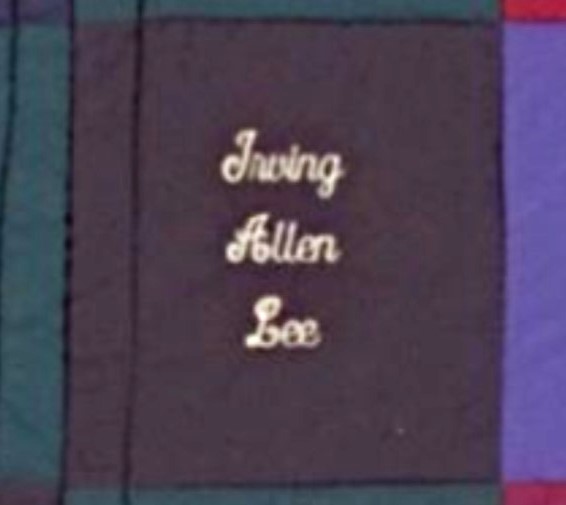
Daytime television actor Irving Allen Lee dies of AIDS-related illness at his Manhattan home. He was 43.
Learn More.Lee was a Broadway and television actor most known for his roles on daytime soap operas. From 1977 to 1984, he played Detective Calvin Stoner on The Edge of Night, notable for writing and performances on an artistic level more elevated than any other soap of its time. From 1986 to 1988, Lee played Dr. Evan Cooper on Ryan’s Hope.
Lee appeared in several musicals, including Ride the Winds (1974), Rock-a-Bye Hamlet (1976) and A Broadway Musical (1978), all of which had short runs on Broadway. In 1974, he replaced Ben Vereen in Pippin at the Minskoff Theatre, was the original understudy for the two male roles in Ain’t Misbehavin’ (1978) and recreated the role of Big Daddy in the revival of Bob Fosse’s Sweet Charity (1986).
According to The New York Times, Lee was a theater director as well, staging productions at the Manhattan Theater Club, the Henry Street Settlement and the Boston Summer Arts Theater Festival. He was also an adjunct professor in the theater arts division of Marymount Manhattan College.
He was born in New York City the son of a minister, Allan Ezekiel Lee, and his wife, Ruth, according to Film Reference. He received a theater degree from Boston University, and then joined the Olatunji African Dance Company as the associate artistic director of its theater company.
* * * * * * * *
Photo of quilt panel from the AIDS Memorial Quilt

Anthony Perkins — an Oscar-nominated stage and film actor best known for his role as Norman Bates in Alfred Hitchcock’s Psycho — dies at his Hollywood Hills home of AIDS-related illness with his wife and two sons at his side. He was 60.
Learn More.“Hitchcock and I got along very well and he let me make several changes and suggestions,” Perkins said. “He used to find me at the end of the working day and thank me, even though it sometimes meant he had to take a car journey to do so. I haven’t had that sort of treatment from many people.”
“When [Psycho] debuted in 1960, mainstream horror consisted mostly of immortal figures like Dracula and scientific freaks of nature in films like Godzilla, King of the Monsters! and Creature from the Black Lagoon. Psycho, on the other hand, emerged with a grounded villain,” wrote Peyton Robinson for Film School Rejects.
Perkins portrayed Norman Bates as a courteous young man with a timid smile — and a capacity for violence just lurking under the surface of his boyish demeanor. This character struck such a nerve with film audiences in 1960 (and still to this day), that the Bates role would follow Perkins for years in American film circles.
After Psycho, film fans forgot that Perkins had been a notable Broadway actor and a bit of a teen idol throughout the 1950s. In 1957, he starred in Fear Strikes Out, a biopic about Red Sox player Jimmy Piersall, and film critics raved about Perkins’ performance. A review in Variety stated, “Every recent young star has been compared to James Dean. From now on the standard is Tony Perkins.”
But his time with Paramount Pictures was fraught with pressure from studio executives who thought Perkins should hide his homosexuality and take pains to appear more masculine. In his biography of Perkins, author Charles Winecoff wrote about how a studio executive told Perkins to end his relationship with actor Tab Hunter and to “get a girl.” Perkins response was “But I love him!”
Hunter told Attitude that while Paramount felt entitled to tell Perkins how to live his life, Hunter had a better experience with his studio, Warner Brothers.
“Warner Brothers never said a word about my sexuality, and that’s just the way I wanted it,” said Hunter. “However, Paramount did have something to say about my relationship with Tony… Despite the opposition, we did continue seeing each other.”
In 1961, after receiving recognition at Cannes for his part in the Ingrid Bergman film Goodbye Again, Perkins relocated to Europe and starred in several films there throughout the 1960s, including Orson Welles’s The Trial (1963).
He returned to the U.S. and worked on Murder on the Orient Express (1974), Mahogany (1975) and the Disney sci-fi adventure The Black Hole (1979). He also co-wrote the 1973 film The Last of Sheila with Stephen Sondheim.
Perkins was living with Sondheim as they worked on The Last of Sheila, and it was around this time that Perkins began subjecting himself to a series of psychiatric attempts to “cure” his homosexuality, coordinated by psychologist Mildred Newman, who had written the pop-psychology best-seller How to be Your Own Best Friend. In 1972, he submitted to “electroshock aversion therapy” under Newman’s direction.
“The electroshock treatments took a terrible toll on Perkins,” said Doug Ireland in Gay City News. “The talent that made him sought after by such distinguished film directors as Claude Chabrol, Jules Dassin, and Orson Welles faded away, as did his looks.”
He and his wife volunteered with Project Angel Food, an organization that provides meals for individuals who are homebound due to HIV. Shortly before he died, he told his sons that he learned “more about love, selflessness and human understanding from the people I have met in this great adventure in the world of AIDS than I ever did in the cutthroat, competitive world in which I spent my life.”
* * * * * * * *
Photo of quilt panel from the AIDS Memorial Quilt
Morant Ricardo Bethony dies of AIDS-related illness at Walter Reed National Military Medical Center in Bethesda, Maryland. The 3-month-old boy was a detainee, along with his parents, at Guantanamo Bay Naval Base in Cuba.
Learn More.The infant’s mother, 22-year-old Silieses Success, was a Haitian asylum-seeker being held by the U.S. military at Camp Bulkeley, a detention facility that housed HIV-positive refugees and their families. She gave birth to her son in June at the facility. The infant’s father, Morant Bethony, was housed with them.
When the infant contracted AIDS-related pneumonia, Naval personnel arranged for the mother and infant to be flown to Walter Reed National Military Medical Center in Bethesda, Maryland. This is how Silieses Success and her son became the first Haitian refugees to reach the U.S. It would be months before others could follow, because a federal travel policy adopted by the Bush Administration banned HIV-positive people from entering the U.S.
Efforts at Walter Reed to save the baby were unsuccessful, and he died. The infant’s mother later told her husband that hospital personnel did not permit her to view the body of her dead son.
“They said they buried it. They don’t tell us where,” the infant’s father told The New York Times.
Following the death of her infant child, Immigration and Naturalization Service (INS) officials would transfer the mother to a prison on Varick Street in New York City. INS officials told The New York Times that they did not want HIV-infected immigrants released into the general U.S. population.
Meanwhile, the infant’s father, Morant Bethony, continued to be held at Camp Bulkeley in Cuba, along with 276 other refugees.
“We have nothing to do but sit like animals,” Bethony said. “Why can’t I be with my wife? Why?”
Bethony told The New York Times that he and his wife fled Haiti, because the new regime sought to persecute them for their work as human rights activists. His wife’s parents, who were supporters of the overthrown President Jean-Bertrand Aristide, were murdered by Haitian soldiers in 1991.
“My wife asks why she is held in a jail with criminals and users of drugs,” he said “She is no criminal.”
In the months ahead, the media attention on Morant Bethony and Silieses Success would inspire activists to hold protests outside the INS prison and elsewhere. In December 1992, ACT UP, churches and other organizations formed a coalition to provide housing and services for HIV-positive Haitian refugees.
Silieses Success would eventually be freed from prison in 1993, with the help of law students from American University and Yale and lawyers from the university law clinics and the Center for Constitutional Rights.

Keith Prentice, an actor who played the part of Larry in both the original stage and film versions of The Boys in the Band, dies of AIDS-related illness in Kettering, Ohio. He was 52.
Learn More.Prentice worked on TV, film and the New York stage. He appeared on the TV soap Dark Shadows during the series’ final months in 1971, and for a number of years, his picture was displayed on the label of Tasters Choice coffee.
Prentice studied at the American Academy of Dramatic Arts in New York City. His stage musical credits include Sail Away, The Sound of Music, Paint Your Wagon, and The King and I, according to the Internet Broadway Database.
In 1968, he appeared off-Broadway in the production of The Boys in the Band, which was groundbreaking for its portrayal of gay life. The play is set at a birthday party the summer before the Stonewall riots. He also appeared in the film version of the play, which was directed by William Friedkin. As the first major film studio production to deal frankly with homosexuality, every member of the show’s original Off-Broadway cast appears in the iconic film.
Prentice had the striking good looks to be cast — twice — in the part of Larry, described in the play notes as an “extremely handsome” commercial artist who prefers multiple sex partners.
Prentice’s final film role was in Cruising (1980), which was also directed by Friedkin.
In 1982, Prentice moved to Kettering, Ohio and co-founded Kettering Theatre Under the Stars. He directed summer shows there until 1992, the year of his death.

Paul Jabara, songwriter of some of the top dance hits of the 1970s, dies of AIDS-related illness in Los Angeles at the age of 44.
Learn More.He was known for spontaneously entertaining friends and strangers alike with highlights from his latest production, according to his memorial website. He was a one-man show who delighted in performing for an audience.
Jabara was credited with conceiving and distributing the first AIDS red ribbons, and he co-founded the Red Ribbon Project in 1991.
At Jabara’s memorial service, his friends and collaborators paid tribute to him by performing a song he wrote entitled “We’re Gonna Win.” The song was performed just once; it has been locked in a vault and has never been performed again.
* * * * * * * *
Photo of quilt panel from the AIDS Memorial Quilt

Denholm Elliott, a British actor known to steal scenes in Hollywood movies, dies of AIDS-related illness at his home on Ibiza, Spain. He was 70.
Learn More.With more than 125 film and television credits, Elliott was honored with the Most Excellent Order of the British Empire for his contribution to the arts, according to the Los Angeles Times.
Among his most notable film roles were the abortionist in Alfie (1966), Marcus Brody in Raiders of the Lost Ark (1981) and Indiana Jones and the Last Crusade (1989), and Coleman the sarcastic butler in Trading Places (1983). For his performance in A Room with a View (1985), Elliott was nominated for the Academy Award for Best Supporting Actor. He won the BAFTA Award for Best Actor in a Supporting Role in three consecutive years in the 1980s, becoming the only actor to have achieved this distinction.
Active to the end of his life, Elliott performed in early 1992 as the burglar in a film based on the raucous British play Noises Off. He also portrayed George Smiley, author John le Carre’s British super-spy, for the 1991 PBS season opener of Masterpiece Theater, titled “Murder of Quality.”
The American film critic Roger Ebert described him as “the most dependable of all British character actors.”
* * * * * * * *
Photo of quilt panel from the AIDS Memorial Quilt
Terry E. Clark, who co-founded the Texas Gay Rodeo Association with his partner Walter “Papa” Strickland, dies of AIDS-related illness in Houston at the age of 47.
Learn More.Clark was an original member of the Mustangs Leather/Levi Club and an associate member of the Texas Riders, Knights D’Orleans, and Triangle Club of Denver , according to the Texas Obituary Project. He was named Grand Marshal of the 1991 Gay Pride Parade in Houston.
His partner, Walter Stickler, preceded him in death in 1990.
Allen R. Schindler, a gay man awaiting discharge from the Navy, is followed to a park near his base in Sasebo, Japan and brutally killed. He was 22 years old.
Learn More.One night in September 1992, a little more than a month before, Schindler was serving as radioman aboard the USS Belleau Wood while en route from San Diego to Japan. As a prank, Schindler broadcast an unauthorized message, “2-Q-T-2-B-S-T-R-8” (“too cute to be straight”), which led to a disciplinary hearing.
When he appeared at captain’s mast for the unauthorized radio message, Schindler requested that the hearing be closed. But the captain held an open hearing, with 200-300 people in attendance. Schindler was put on restrictive leave and was unable to leave the ship.
In the month that ensued, Schindler was subjected to anti-gay harassment, according to several of his friends. He was often shoved as he walked the ship’s halls and threatened with comments like “there’s a faggot on this ship and he should die.” Deciding he could no longer survive the homophobic climate aboard the ship, he told his commanding officer that he was gay, knowing that his disclosure would lead to a discharge. Schindler immediately felt a sense of relief: “If you can’t be yourself, then who are you?” he wrote in his diary.
By late October, the Belleau Wood was docked in Japan and Schindler’s confinement had ended. To escape the hostility of his shipmates, he went off-base, where he met a group of gay American entertainers, including dancer Eric Underwood, whom he told about the harassment.
The night of Oct. 27, Schindler was followed into a park bathroom shortly before midnight by two drunken shipmates. Airman Charles Vins watched and occasionally joined in while the other, Airman Apprentice Terry M. Helvey, kneed Schindler in the groin, struck him in the face and then, cradling his head in the crook of his arm, punched him repeatedly.
Once Schindler was on the floor, Helvey began stomping on him with the heel of his boot, causing, according to the pathologist who performed the autopsy, abrasions, contusions and lacerations of the forehead, eyes, nose, lips, chin, neck, Adam’s apple, trachea, lungs, liver, and penis. As the assailants fled, witnesses arriving on the scene summoned the Shore Patrol, and medics tried to revive Schindler without success.
Helvey and Vins were identified by witnesses and arrested the next morning. As Helvey was being led away, he told a shipmate, “The bastard deserved it.” Vins received a quick court-martial and was sentenced to just four months in exchange for testimony against Helvey.
The incident received little press coverage until Underwood organized a letter-writing campaign to several media outlets, exposing the anti-gay harassment Schindler had faced, according to the Bay Area Reporter. The military newspaper Pacific Stars and Stripes printed Underwood’s letter, and a reporter from the paper investigated the story.
In April 1993, just six months after her son’s death, Dorothy Hajdys would be invited by the Human Rights Campaign to speak at a candlelight vigil in honor of her son in Washington, DC. She would tell Wisconsin’s In Step magazine that she hoped President Bill Clinton would follow through on his proposal to end the ban on gays in the mllltary.
“It’s too late for Allen. But maybe this will save someone else’s life,” she said.
Hajdys, a fundamentalist Christian who initially had trouble accepting that her son was gay, became an unlikely activist for LGBT civil rights.
“If you would have told me I would have been at the March on Washington standing before a million people and being seen all over the world, I would have told you you were nuts,” she later told Esquire magazine.
On May 27, 1993, Helvey’s trial would end with a conviction of murder and a sentence of life imprisonment. At his sentencing, Helvey would cry and apologize to Schindler’s mother, and insist he did not kill her son because he was homosexual. This apology reduced his punishment from death to life, according to the Los Angeles Times.
The apology contrasted sharply with earlier testimony by Navy investigator Kennon F. Privette. He told the jury how Helvey admitted to brutally beating Schindler during interrogation the day after the murder.
“He said he hated homosexuals. He was disgusted by them,” said Privette. He quoted Helvey as saying: “I don’t regret it. I’d do it again.”
During his trial, Helvey offered no explanation for why he killed Schindler, nor did he disclose any details of what led up to the killing except to say that he and two other sailors from the Belleau Wood had purchased two large bottles of whiskey, a bottle of schnapps, a bottle of vodka, orange juice and a six-pack of beer and went drinking in a park.
Helvey said he had met Schindler before but did not explain how he knew his shipmate was a homosexual.
In August 1997, Lifetime would broadcast Any Mother’s Son, a movie based on the story of Allen Schindler’s murder. The movie would win the GLAAD Media Award for Outstanding Made for TV Movie, and Bonnie Bedelia would be nominated for a CableACE Award for her portrayal of Dorothy Hajdys.

As discrimination against people living with HIV and AIDS rises and begins to take more subtle forms, voters in Colorado pass a ballot measure designed to remove discrimination protections for the LGBTQ community.
Learn More.The amendment overturned municipal ordinances adopted in the late 1980s and early 1990s by Denver, Boulder, and Aspen that
protected gays and lesbians from discrimination.
“The conservative Christians who drafted and campaigned for Amendment 2 used a powerful slogan, No Special Rights, which suggested gay men and lesbians sought not equal but ‘special’ rights,” Princeton historian William Schultz wrote in his 2018 op-ed for The Washington Post. “This slogan, combined with an ad campaign that used lurid images from San Francisco’s gay pride parade, enabled Amendment 2 to defy pollsters and secure victory by a 53-46% margin, even as Bill Clinton and Democratic Senate candidate Ben Nighthorse Campbell carried the state.”
Initiated by a Colorado Springs-based religious organization named Colorado for Family Values, the ballot measure caused far-reaching implications regarding legal protections for the LGBTQ community. The vote shocked local HIV/AIDS advocates and put others in the nation on alert.
“Amendment 2 took the LGB community by surprise, partially because the religious right had never attacked so directly through political means,” stated Lauren L. Yehle in her 2019 paper “Movement and Countermovement Dynamics Between the Religious Right and the LGB Community Arising from Colorado’s Amendment 2.”
She continued: “Throughout the 1980s, the religious right focused on realizing its anti-abortion goals …. Meanwhile, the AIDS epidemic was ravaging urban gay communities, forcing the LGB community to face inwards and reassess priorities.”
A group of Denver activists responded by forming a new advocacy organization, Equality Colorado. The group’s mission was to inform Colorado voters about Amendment 2 — after the fact — and coordinate political work within the LGBTQ community, including lobbying and preparing for the next campaign.
In the months that followed, convention organizers and business owners were persuaded to boycott the State of Colorado, causing the economy to lose nearly $120 million by the end of 1993, according to Princeton historian William Schultz. The American Foundation for AIDS Research (AmFAR) was among the first to cancel an event — a large fundraiser in Aspen — in protest.
“AmFAR could not continue business as usual in Colorado,” AmFAR President Mervyn F. Silverman, MD., said in a letter published in the Los Angeles Times. “Amendment 2 represents the kind of officially sanctioned homophobia which has fueled this plague we know as AIDS. HIV may be the cause of AIDS, but the virus is aided and abetted by denial, hatred and extremists who seek to pit Americans one against the other.”
Philadelphia Mayor Ed Rendell declared that he would not attend the U.S. Conference of Mayors, because it was being held in Colorado, saying, “As a statement of denouncing bigotry and affirming civil rights, I will personally request that the conference be moved to Philadelphia, the birthplace of civil rights.”
Meanwhile, Christian conservatives put forward No Special Rights initiatives in eight additional states: Arizona, Florida, Idaho, Maine, Michigan, Missouri, Oregon, and Washington. Six failed to make the ballot, and the two that did (Idaho and Oregon) were voted down.
Two years later Amendment 2 itself was overturned by the U.S. Supreme Court in Romer v. Evans.
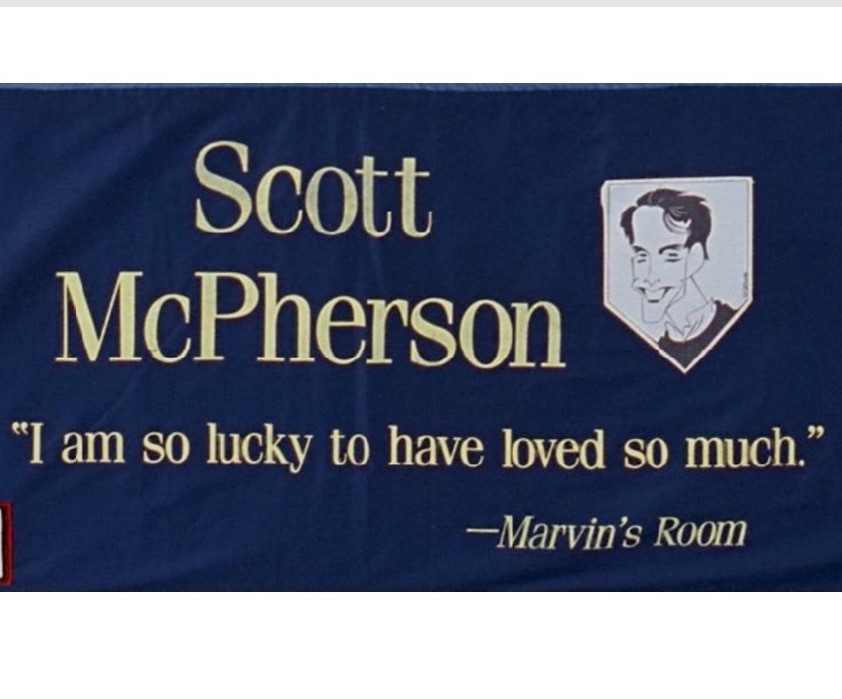
Scott McPherson, creator of the Drama Desk Award-winning Marvin’s Room, dies of AIDS-related illness in Chicago at the age of 33.
Learn More.McPherson, who also wrote the stage plays ‘Til the Fat Lady Sings and Scraped, was one of the first openly gay, HIV-positive American artists. His play Marvin’s Room was first produced in 1990 at Chicago’s Goodman Theatre, telling the story of two sisters who reunite after many years when one is diagnosed with leukemia.
“Amidst the homophobia and AIDS hysteria that gripped the nation, [McPherson] has spoken eloquently, both in his writing and in interviews, of the personal and familial ravages of chronic illness and the need for loving support and connection with lovers, family and friends,” reads the tribute to McPherson by the Chicago LGBT Hall of Fame.
Known as one of Chicago’s most vital creative forces, McPherson moved to the city from Ohio in 1981 and began performing in theatrical productions, commercials and industrial films. His first full-length play, ‘Til the Fat Lady Sings, was directed by Eric Simonson at Lifeline Theatre in Chicago in 1987 and received a Joseph Jefferson Citation for Best New Work, according to Broadway World. His one-act play, Scraped, premiered in a Chicago New Plays production at the Organic Theatre.
Marvin’s Room, McPherson’s second and last full-length play, has been performed throughout the U.S. and around the world. Following its 1990 premiere at the Goodman Theatre Studio, the production went on to the Hartford Stage, Playwrights Horizons and Minetta Lane in New York, London’s West End and the Tiffany Theatre in Los Angeles.
In spite of variable and increasingly failing health, and the illness and recent death of
On February 5, 1992, McPherson’s lover, ACT UP activist and cartoonist Daniel Sotomayor, died of AIDS-related illness. As his own health deteriorated, McPherson continued to write for the stage.
He even managed to attend Chicago Mayor Richard Daley’s annual Commission on Human Relations luncheon at the Palmer House hotel in late February. McPherson attended the event in a wheelchair to protest the award that Mayor Daley was giving posthumously to Sotomayor, a political action thought by activists to be highly hypocritical in light of the mayor’s refusal to spend city funds on HIV/AIDS care.
“If you want to honor Danny,” he yelled at the mayor during the event, according to the Chicago Reader, “increase the AIDS budget! Pass Helen Shiller’s resolution!”
Witnesses to the incident said that McPherson and the activist pushing his wheelchair, Mark Schoofs, were surrounded by guards as they continued to interrupt the mayor’s speech, chanting “Fewer awards! More money!”
Afterward, McPherson told the Reader, “You know, I went to a lot of demonstrations with Danny but I always felt a little hesitant. These things are really not my style; I’m too polite. But I think this is the closest I’ve ever felt to Danny. This was really in his spirit.”
McPherson was working on a new play when he succumbed to his illness about eight months later, in early November.
In 1996, four years after McPherson died, Marvin’s Room was adapted into a major motion picture starring Robert DeNiro, Meryl Streep, Diane Keaton, Leonardo DiCaprio, Gwen Verdon and Hume Cronyn.
* * * * * * * *
Photo of quilt panel from the AIDS Memorial Quilt
David Oliver, star of the Emmy Award-winning television series A Year in the Life, dies of AIDS-related illness at his Los Angeles home. He was 30.
Learn More.Oliver also appeared for two years on the NBC soap Another World, according to Variety. Additional TV credits include the TNT television movie Miracle in the Wilderness, and the NBC movie of the week If It’s Tuesday, It Still Must Be Belgium.
In A Year in the Life, Oliver played Sam Gardner, a business-school student who falls into an unexpected romance. The show, which premiered on NBC in 1986, followed the lives of Sam and other members of his family for a year.
He also played the lead in the 1988 action movie Defense Play.
On stage, he appeared in several San Diego Civic Light Opera productions, including L’il Abner and The Unsinkable Molly Brown. He also performed regularly at the Edinburgh Theater Festival, according to The New York Times.
He also appeared Elegies, a play about AIDS, at the Canon Theater in Beverly Hills and Club 20-20 in Century City.
From a secret location in Denver, KGAY begins broadcasting as the nation’s first 24-hour radio station devoted to an LGBTQ audience,
Learn More.“From the heartland of homophobia, this is KGAY,” said station manager Clay Henderson as he began the station’s first broadcast.
Broadcasting a format of alternative music, talk and “mainstream news from a gay perspective” via satellite hookup, KGAY could be listened to via home satellite or through AM stations transmitting the signal. Henderson told The Seattle Times.
With a potential audience of 7.5 million in North America, the new station quickly found its way to listeners. KGAY regularly fielded calls from across North America, many coming from listeners in small towns in the U.S. and Canada. Nearby Colorado Springs, a hub for the Christian conservatives who advocated for the passage of the anti-hate legislation Amendment 2, received the KGAY signal through the local AM station KXRE.
“It was an emotional setback when Colorado passed the anti-gay law,” Henderson said. “We took some time off to decide what we were going to do. We finally decided to stay here and fight. We’re behind enemy lines, and we’re keeping the communication open. We’re prepared for anything to happen.”
In the weeks since the passage of Amendment 2, anti-gay factions in Colorado had become more activated, according to the Denver Post. HIV/AIDS service organizations and LGBTQ establishments in Denver reported an uptick in bomb threats and harassing phone calls, and anti-gay graffiti appeared overnight in many Colorado towns. This is why Henderson was keeping the location of the radio station a secret.
Henderson’s interest in radio began when members of the Ku Klux Klan used explosives to destroy a Pacifica Radio transmitter, which was located in his grandparents’ cotton field in Texas. Henderson said he and his friend Will Gunthrie were able to launch KGAY through the acquisition of $1 million from private investors and the use of a signal subcarrier on Turner Broadcasting’s WTBS signal.
KGAY stopped broadcasting in late 1993, but not before Amendment 2 was hit with an injunction upheld by the Colorado Supreme Court. In 1996, the U.S. Supreme Court would rule Amendment 2 unconstitutional, forcing it to be removed from Colorado’s constitution.
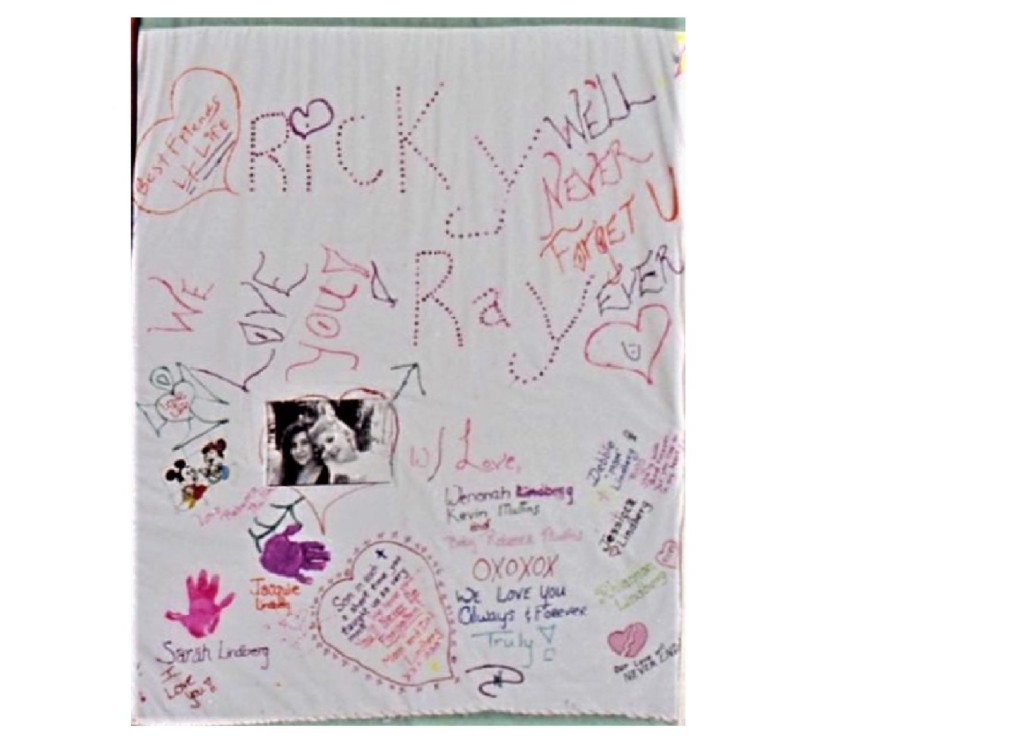
Ricky Ray, the eldest of three hemophiliac brothers barred from school in Florida because they carried the AIDS virus, dies at the age of 15 at his home in Orlando.
Learn More.Ricky and and his two younger brothers, Robert and Randy, sparked a national conversation on AIDS in 1987, after their court battle to attend school led to boycotts by local residents and the torching of their home in Arcadia, Florida.
Last month, President-elect Clinton had telephoned the boy to offer his support. Bedridden with AIDS, Rick let it be known that he wanted to talk to then-President-elect Bill Clinton about the deadly disease.
When Ricky was handed the telephone in his room at All Children’s Hospital, Clinton was on the other end.
“Ricky told him, ‘I hope you do everything you said you would to make a difference,'” said Ricky’s mother, Louise. “He said that Clinton told him that he was going to do everything in his power to make things better.”
* * * * * * * *
Photo of quilt panel from the AIDS Memorial Quilt
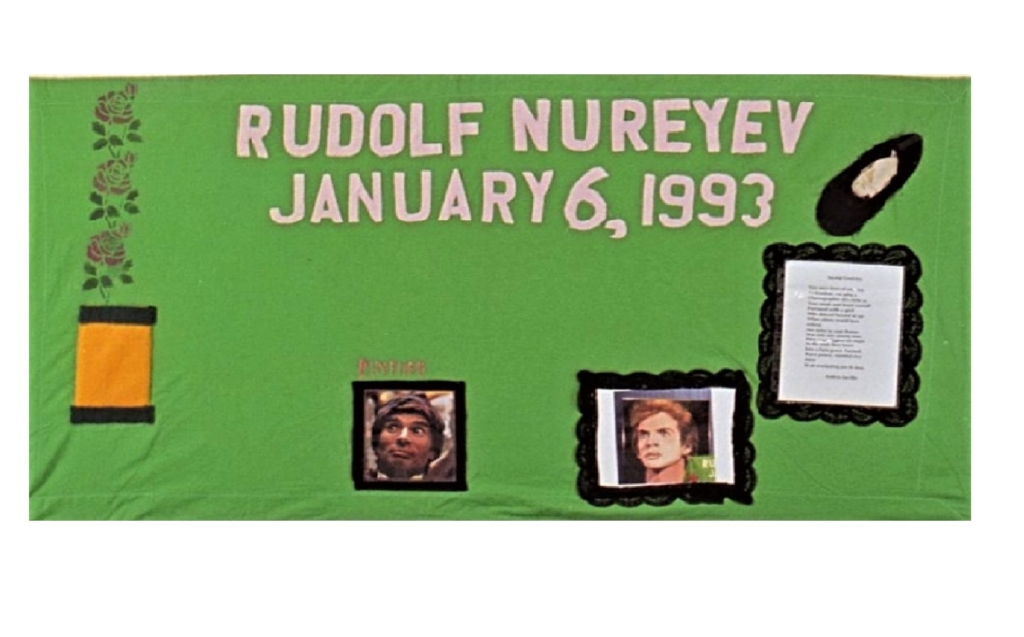
World-renowned ballet dancer Rudolf Nureyev dies of AIDS-related illness at the age of 54.
Learn More.Nureyev is born in 1938 aboard the Trans-Siberian express, near Lake Baikal. He spends his childhood and youth in Ufa, capital of the Soviet Republic of Bashkir. His parents are Tartar Muslims.
In 1961, Rudolf Nureyev dances with the Kirov Ballet, which is on tour in Paris. His first appearance on stage is at the Palais Garnier, in Act III from La Bayadère. Days later, he demands political asylum at Le Bourget airport and refuses to board an airplane to the USSR. He joins the Ballets du Marquis de Cuevas the next day.
He becomes internationally famous as a flamboyant performer and a charismatic celebrity who revived the prominence of male ballet roles and significantly widened the audience for ballet.
In 1973 he codirects (with Robert Helpmann) and stars in a filmed version of Don Quixote, and he has acting roles in the films Valentino (1977) and Exposed (1983).
From 1983 to 1989, Nureyev would be artistic director of the Paris Opéra Ballet, the oldest ballet company in the world. He would be diagnosed with HIV in 1984, his second year at the POB.
He continues to choreograph for the American Ballet Theatre and the Paris Opéra Ballet even as his health declines from AIDS-related complications.
Nureyev enters the hospital Notre Dame du Perpétuel Secours in Levallois-Perret on November 20, 1992 and remained there until his death. His funeral was held in the marble foyer of the Paris Garnier Opera House.
* * * * * * * *
Photo of quilt panel from the AIDS Memorial Quilt

Frank Banks, a beloved entertainer at the Mint piano bar in San Francisco, dies of AIDS-related illness at the age of 46.
Learn More.Oklahoma-born Frank Banks held a long-standing gig at The Mint piano bar, located at 1942 Market Street, and drew fans that included Bay Area Reporter publisher Thomas Horn and then-Mayor Dianne Feinstein
“From 1975 to 1988 Frank Banks was both defined by and helped define The Mint in San Francisco,” wrote Michael Flanagan of the Bay Area Reporter in his 2018 tribute to Banks. “He would go on to play other bars before he left and his presence here was felt all the way to City Hall, but The Mint was the place where he came alive and entertained a broad swath of the city.”
According to Flanagan, Banks was born in Wagoner, Oklahoma on May 11, 1946, and grew up in Albuquerque, New Mexico. As a teenager, he became the church pianist for his local Baptist church.
After graduating from college, he returned to Albuquerque to teach English and music and, during his summers off from school, he played piano at area venues such as the Alpine Theater, the Tiffany Saloon, and Melodrama. In 1972, a reporter for the Albuquerque Tribune wrote that Banks “really knows how to make that old piano roll.”
After finishing the 1973-1974 school year, he moved to San Francisco, where he quickly established himself on the piano bar circuit, according to Flanagan.
In 1976, Banks started playing at The Mint, and by the next year, he had a weekly gig, playing Wednesdays through Sundays. In early 1982, Banks recorded his one and only album, Frank Banks Live at The Mint. On the album, Banks gives a nod to his birthplace with the songs “Oklahoma” and “I Cain’t Say No,” both of which were a part of his repertoire. Flanagan wrote that the album has the ability to transport listeners to a place that no longer exists — The Mint in the early ’80s.
“The Mint was a lively bar, and you hear people laughing, glasses tinkling and most of all the rapport between Banks and his audience during sing-alongs,” Flanagan wrote.
Banks was also involved in providing entertainment for The Great Tricycle Race, The Mint’s annual fundraising event for charitable organizations. Held every Memorial Day, the race consisted of flamboyantly costumed two-person teams, one contestant pushing the other on a tricycle. Afterward, a party with music was held at The Mint. In 1984, “The Incomparable Frank Banks” was featured in the ad for the event, which drew over 1,200 people.
Author Molly Martin wrote on her blog that in the ’80s, she and her then-partner, Pat, were regulars at Bay Area piano bars — including The Mint. Of all the piano players in town, Banks was their favorite. Martin appreciated the way he clearly enunciated the words to songs, so she could learn lyrics on the fly. Her partner appreciated how Banks knew every American standard, and performed them with passion and precision.
But they were also drawn to Banks’ nights at The Mint, because this is where Broadway stars would stop in to join the fun.
“When a star or a known accomplished singer would come in, those of us around the piano would make way for them,” she recalled. “The singer could choose any song — (Banks) knew them all — and we would transition from a chorus to an audience.”
Martin also remembered that many members of the San Francisco Gay Men’s Chorus also found their way to Banks’ piano.
“Every night was a surprise,” she wrote on her blog, which has been preserved by the San Francisco Oral History Project.
In the late 1980s, The Mint began to shift away from being a piano bar, and Banks started performing at other venues, including J.J.’s, Nine’s, Sutter’s Mill and Charpe’s, according to Flanagan. His final performance was on August 29, 1992, at the Square Bar, located at 405 Mason Street. Shortly afterward, he returned to Albuquerque to spend the last six months of his life.
* * * * * * * *
Resources:
Bay Area Reporter, June 20, 2018; Frank Banks, musical master of The Mint :: Bay Area Reporter (ebar.com)
“Singing Our Hearts Out at The Mint,” by Molly Martin; Singing Our Hearts Out at The Mint – FoundSF
Photo of quilt panel from the AIDS Memorial Quilt

Jerry Mills, one of the most important queer underground comic artists of his time, dies of AIDS-related illness. He was 41 years old.
Learn More.Mills was the creator of the gay comic strip Poppers, about Billy, a West Hollywood hottie, and his sidekick Yves, a nebbish who tries to steer his friend toward better choices. The comic first appeared in the adult magazine In Touch for Men in April 1982, and then was published in Advocate Men later on.
“Though the relationship between Billy and Yves is your typical odd-couple dynamic, you still learn a lot about the dangers of extremes through their interactions,” writes Sara Century for SYFY Media. “Billy could absolutely stand to be a little more prudent, while Yves would be better off adopting some of Billy’s go-with-the-flow attitude.”
Poppers was also published in France (Gai Pied Hebdo) and Japan (Barazoko), and in the comic book Gay Comix, according to reviewer Elisa Rolle. In addition to Poppers, Mills also made cartoons and contributed a story to the first Meatmen anthology.
As the AIDS crisis emerged, Mills’ work addressed the complexity of modern-day sexual relations, and he began to promote safer sex in his storylines, according to the editors of The Other 1980s: Reframing Comics’ Crucial Decade, Brannon Costello and Brian Cremins.
Mills was also a member of the AIDS Coalition To Unleash Power/Los Angeles (ACT UP LA), and was involved in many of the group’s protests and “zaps” in the late 1980s.
Shortly after Mills’ death, ACT UP/LA members decided to memorialize him with a political protest against Amgen, a pharmaceutical company based in Thousand Oaks, California. Amgen became ACT UP’s target due to the exorbitant price the company set for its HIV-treatment medications Epogen and Neupogen.
At ACT UP’s protest on March 3, 1993, activists carried signs with Mills’ name, along with the name of Richard Iosty, another local ACT UP member who died of AIDS shortly before Mills.
Gerald “Jerry” Vallaire, vice president of the South of Market Individuals Lifestyles Events, dies of AIDS-related illness in San Francisco at the age of 41.
Learn More.When Vallaire was diagnosed in 1989 with AIDS, he closed his successful florist business, and dedicated his time to raising funds for AIDS service programs, according to the Bay Area Reporter.
As part of Up Your Alley Productions, Vallaire helped to produce benefits such as the Ringold Alley Fair, Let’s Go Navy, The Charity Bowl, The Military Ball and Art for AIDS. His involvement in the benefits led to thousands of dollars for AIDS causes.
Born in 1951 in New Orleans, Vallaire was born to a family trade of operating wholesale and retail floral businesses. But he was interested in the performance arts, and moved to New York City to pursue dance and theater. There, he performed in productions with Richard Chamberlain, George Maharis, Margaret Hamilton, Ann Miller and George Chakaris.
But when his stage career failed to take off, he moved to San Francisco and opened a florist business, , Styles and Stamens. But when Vallaire began getting involved in fundraising events, his performance background came in handy and he acted as choreographer of many dance productions created for the events.

Musician Elton John, who since the late 1980s has been leveraging his celebrity to raise money for AIDS research, decides to launch the Elton John AIDS Foundation (EJAF).
Learn More.Following the deaths of his friends Ryan White in 1990 and Freddie Mercury in 1991, Elton John established EJAF, a nonprofit organization to support innovative HIV programs focusing on prevention, education, direct care and support services.
In early 1993, John started hosting his annual Foundation Academy Awards Party, which has become one of the biggest Oscar parties in Hollywood and one of the most successful fundraisers anywhere.
The first party was produced by activist Patrick Lippert, according to Claude Bernardin and Tom Stantin in their book Rocket Man: Elton John from A-Z. Lippert, who was executive director of the 1991 nationwide campaign Rock the Vote, died of AIDS-related illness a few months after the Oscar party.
John continues to throw his Academy Awards viewing party every year, and the event keeps moving to larger and larger venues to accommodate the growing number of attendees to this invitation-only event. In the late 1990s, the party was held in the upscale Beverly Hills restaurant Spago, and in recent years, the event has been held under white tents erected in West Hollywood Park.
Guests pay an entry fee in order to attend and, once inside, they are encouraged to pledge donations to EJAF in between the Academy Awards broadcast and also make bids in the auction held at the end of the event. In 2018, the event raised almost $6 million, according to the Los Angeles Times.
EJAF puts donated money toward programs and organizations committed to ending HIV and AIDS. One current grant recipient is AIDS United and its Fund for Resilience, Equity and Engagement (FREE), which focuses on providing support to Black gay, bisexual, queer and same-gender-loving men and transgender and gender-nonconforming people in the U.S. EJAF also provides multi-million-dollar grants to HIV/AIDS organizations in Africa and other parts of the world most impacted by HIV infection.
EJAF also has dedicated $125 million to its Rocket Fund, a campaign to ensure that LGBTQ+ people across the globe have access to quality health services responsive to their needs.
Established as one of the top philanthropic funders of HIV/AIDS grants worldwide, EJAF has raised over $600 million to support HIV-related programs in 90 countries, according to EJAF. The foundation estimates the number of people reached with education, prevention services, treatment, testing and other support to be more than 100 million.
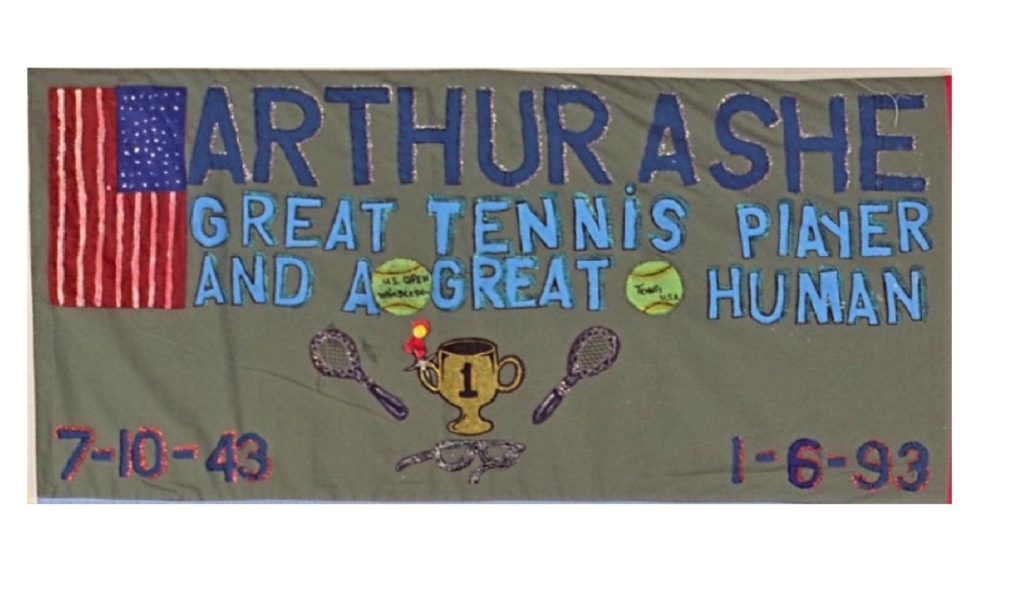
Tennis star Arthur Ashe dies of complications from AIDS at the age of 49. Ashe’s body is laid in state at the governor’s mansion in Richmond, Virginia, where thousands of people line up to pay their respects to the ground-breaking athlete and social activist.
Learn More.Ashe is celebrated for being the first (and only) African American male tennis player to win the U.S. Open and Wimbledon singles titles.
Attending UCLA on a full scholarship in 1965, Ashe wins the individual NCAA tennis championship and helps UCLA win the team championship. He then serves in the U.S. Army for two years.
Ashe begins his career in earnest in 1968, winning the U.S. Open while still an amateur player. He becomes the first black man to win a Grand Slam event.
He becomes a trailblazer in the world of tennis, winning multiple Grand Slam titles in his career. He also becomes known for his commitment to charitable causes and humanitarian work. He establishes tennis programs for inner-city children and campaigns against apartheid in South Africa. He retires from tennis in 1980 after suffering a heart attack.
In 1988, Ashe begins experiencing paralysis in his right arm. After undergoing exploratory brain surgery and a battery of tests, doctors determine he has toxoplasmosis, a parasitic disease that is commonly found in people infected with HIV. Another set of tests reveals he is HIV positive.
Doctors believe Arthur Ashe contracted HIV from blood transfusions during his second heart surgery. Despite that, Ashe and his wife try to keep his HIV diagnosis private. After a friend that worked at USA Today calls Ashe about his condition, he decides to go public.
Two months before his death, he founds the Arthur Ashe Institute for Urban Health, to help address issues of inadequate health care delivery to urban minority populations. He also dedicates time in his last few months to writing “Days of Grace,” his memoir that he finishes only days before his death.
Arthur Ashe dies of AIDS-related pneumonia in New York at the age of 49. His body was laid in state at the Governor’s Mansion in his hometown of Richmond, VA. More than 5,000 people line up to walk past the casket.
His funeral is attended by nearly 6,000 people including NYC Mayor David Dinkins, Virginia Gov. L. Douglas Wilder, Secretary of Commerce Ron Brown, and Rainbow Coalition chairman Jesse Jackson. Andrew Young, the former U.N. ambassador and Atlanta mayor who had performed Arthur’s marriage ceremony, delivers the eulogy.
On what would have been Arthur’s 53rd birthday, July 10, 1996, a statue of him was dedicated on Richmond’s Monument Avenue. Before this, Monument Avenue had commemorated Confederate war heroes; in fact, as a child Arthur would not even have been able to visit Monument Avenue because of the color of his skin.
Arthur is depicted carrying books in one hand and a tennis racket in the other, symbolizing his love of knowledge and tennis.
In 1997, the USTA announced that the new center stadium at the USTA National Tennis Center would be named Arthur Ashe Stadium, commemorating the life of the first U.S. Open men’s champion in the place where all future U.S. Open champions will be determined.
* * * * * * * *
Photo of quilt panel from the AIDS Memorial Quilt

Karen Dalton — a folk guitarist, banjo player, and singer who released two albums on the cusp of 1970 — dies of AIDS-related illness at her home near Woodstock, New York. She was 55.
Learn More.“Karen Dalton sang in a room-hushing confessional style, with a tone that earned her constant comparison with Billie Holiday,” wrote Tom Moon, author of 1000 Recordings To Hear Before You Die. “She was a singer of transfixing nuance and uncommon emotional control.”
Dalton accompanied herself with a 12-string guitar, just like Lead Belly (Huddie William Ledbetter), one of her favorite folk-blues performers.
Dalton was part of the 1960s Greenwich Village folk scene, and she performed with folk luminary Bob Dylan, Moon wrote in a profile of Dalton for NPR. Her debut album, It’s So Hard to Tell Who’s Going to Love You the Best (1969(, was produced by Nik Venet, who also helped launch Linda Ronstadt’s career.
Born in Texas in 1937 and raised in Oklahoma by Southern Baptist parents, Dalton was twice married and divorced by the time she was 21. She arrived in New York City in the early 1960s with her guitar, banjo, “and at least one of her two children,” according to music writer Laura Barton in The Guardian.
“Although Dalton was in the right place at the right time, hanging with the right people and boasted a rare talent, she was also self-destructive.” Barton wrote. “She drank heavily, used drugs and had a tendency to disappear on a whim. She played only cover versions, and her decision to not play her own material in an era that belonged to singer-songwriters perhaps also hindered her success.”
Still, her covers of standards were distinctive enough to garner a dedicated following among music fans and musicians alike. Bob Dylan said she was his favorite singer in Cafe Wha? in the Village.
Throughout the ’60s, Dalton travelled from New York to perform in folk venues across the country, such as the Attic, a coffee house near the University of Colorado. She enjoyed the rural life that touring sometimes provided, and even set up house in Colorado for a few years.
In the late 1960s, Capitol Records signed Dalton to make an album. The process of recording was so daunting to her that singer-songwriter Fred Neil had to tell her that the tape wasn’t rolling (when it was) in order to get her to perform, according to Barton.
It’s So Hard to Tell You Who’s Going to Love You the Best was released in 1969 by Capitol Records, and is still appreciated by fans of authentic folk music. Pitchfork magazine lists the album at #52 on its 200 Best Albums of the 1960s.
Listening to “It Hurts Me Too,” a song on the album, is like opening a window to the 1930s. Barton’s singing gives the listener a direct link from the 1960s folk revival back to the original folk songs of Woody Guthrie.
Unfortunately, It’s So Hard didn’t sell well, and Capitol dropped Dalton. But then her friend Michael Lang was given a label to run at Paramount (Just Sunshine Records), and he signed her to produce her second album, In My Own Time (1971). To promote the album, Lang booked Dalton as the opening act for a tour headlined by Santana, and this experience proved to be disastrous for Dalton.
“It obviously didn’t work,” Robert Yapkowitz, co-director of the 2021 documentary Karen Dalton: In My Own Time, told The Guardian. “In part because of the audience, and in part because Karen wasn’t able to perform at that arena level.”
Following the tour, Dalton returned home depressed and increasingly drawn to drug use, according to Jim Farber of The Guardian.
She fell away from the music industry, and reportedly spent time unhoused in New York City. After a failed attempt at a Texas rehab, she returned to New York and settled in a friend’s cabin in Woodstock. Dalton was diagnosed as HIV positive some time in the late 1980s.
After her death, a book of her writings was released in 2012. Her music has been re-issued every so often, causing a surge of new fans, including artists Nick Cave and Devendra Banhart.
Richard “Rick” Redewill, owner of the Lone Star Saloon, Cocktails Bar and the PIT, dies of AIDS-related illness at Kaiser French Campus in San Francisco. He was 40 years old.
Learn More.In the summer of 1989, Redewill opened the Lone Star Saloon on the corner of Howard and 7th, serving just beer and wine at first because he didn’t have a liquor license. Redewill sought to foster an atmosphere in the bar that appealed to the neighborhood’s working class men who felt more at home in the city’s South of Market area, than in the Castro.
In October of that year, the bar was rendered structurally unsafe after the Loma Prieta earthquake struck. Only six months old, the Lone Star had to be demolished. Redewill relocated the bar to 1354 Harrison Street, where it remains today. The new space appealed to the biker crowd that previously made The Ambush — a leather bar across the street that closed in 1987 — their headquarters. And members of the Bear community also were attracted to the bar, making the Lone Star famous as a “Bear Bar.”
“Bar owners such as Rick Redewill were seen as community leaders,” wrote Ron Suresha in his post “Rainbow MC and the old Lone Star.” “During that time – following the closure of all gay SF baths – the Lone Star functioned as a kind of Bear community center that attracted a wealth of creative gay men’s culture: visual arts, writing, music, sex, even sports. The fact that it served as a nexus for such a plethora of culture at perhaps the height of the onslaught of AIDS deaths is a matter of wonder.”
“Bonsai Pete” Vafiades, who Redewill hired to bartend at the Lone Star, told Suresha:
“Bar life in the City (and elsewhere) was important in the way that gay men form community – which is not so much the case in gay life today – and the earthquake was the adversity out of which this first Bear community was forged.”

Anthony Sabatino, an Emmy-award-winning art director who regularly produced the Soul Train Music Awards, dies of AIDS-related illness at his Los Angeles home at the age of 48.
Learn More.Anthony Sabatino became art director of the televised dance show Soul Train in 1971 and produced its awards show for seven years. He also designed other awards shows, including the Golden Globes and the People’s Choice Awards.
Born in Galveston and educated at the University of Houston and Brandeis University, Sabatino also worked on films (Richard Pryor’s Here and Now and Walk on the Wild Side), game shows (Truth or Consequences), television specials (for Bing Crosby, Liberace and George Burns), and talk shows (for Pat Sajak and Joan Rivers).
Nominated eight times for an Emmy, Sabatino won in 1988-89 for Fun House, a children’s game show that aired from 1988 to 1991.

Angels in America: Millennium Approaches, the first installment of Tony Kushner’s two-play epic that uses AIDS as a metaphor for a national spiritual decline in the 1980s, wins four Tony Awards, including best play, best director of a play, and best leading actor and featured actor in a play.
Learn More.Also winning Tonys for Angeles in America were Ron Leibman and Stephen Spinella (acting), and George C. Wolfe (directing).
Angels in America also won the 1993 Pulitzer Prize for Drama.

Héctor Lavoe, considered to be among the most important singers in the history of salsa music, dies of AIDS-related illness. He was 46.
Learn More.From the 1960s through the 1980s, Lavoe helped to establish the popularity of salsa music in the U.S. and across the world. A charismatic soloist, Lavoe also performed with Tito Puente, the Fania All Stars and, early in his career, the Willie Colon Orchestra.
“Puerto Rican vocalist Héctor Lavoe was a real-life superhero of salsa, a diamond in the rough who could channel the full range of human emotions in a single fleeting note,” Suzy Exposito wrote in Rolling Stone for the magazine’s tribute to the top 50 Latin Pop Songs. Lavoe’s 1976 Hit “El Periódico de Ayer” was listed as #5.
Born Hector Perez in 1946 and raised in the Machuelo Abajo barrio of Ponce, Puerto Rico, Lavoe studied music in school and was inspired by the folk musician Jesús Sánchez Erazo (1900-1979). At the age of 16, he left home for New York City, moved into his sister’s Bronx apartment, and began performing with various Latin musical groups, including Kako All-Stars, Johnny Pacheco’s pachanga band, and ultimately Willie Colón’s salsa band.
Pacheco, co-owner of the salsa label Fania Records, suggested that Colón record Lavoe on a track of Colón’s first album El Malo (1967). Pleased with Lavoe’s performance, Colón kept him in the studio to record the rest of the album’s vocal tracks. Several of the songs became hits, including “El Malo” and “Canto a Borinquen.”
At Colón’s invitation, Lavoe joined the band and began performing Saturday nights at the Tropicoro Club. Soon after, he met Carmen Castro, who became pregnant but refused to marry Lavoe, according to Antonio Mejias, author of The Singer, Hector Lavoe. Lavoe’s first son, José Alberto Pérez was born in October 1968. Lavoe was also involved with Nilda “Puchi” Román, who in September 1969 gave birth to Lavoe’s second son, Héctor Jr. Lavoe married Román, and at his new wife’s request, agreed to keep to a minimum any contact with Castro and José Alberto.
Lavoe found his sudden success and his complicated personal life to be overwhelming, and soon he was addicted to heroin and prescription drugs, according to veteran salsa musician Pete Nader, who performed with Lavoe.
“[Lavoe’s] addiction resulted in him showing up late for gigs, and he eventually did not show up to some scheduled performances at all,” writes Nader on his website Pete Nader’s Salsa Legends and Masters Academy.
After trying in vain to get Lavoe to quit his drug habit, Colón fired him, according to Nader. But by then, Lavoe had developed his own fan following, and he was able to leverage this with Fania Records to launch a solo career with his own band.
In 1975, he released an album with an audacious title, La Voz (“The Voice), with the salsa hit “Mi Gente” (“My People”). Lavoe followed this up in 1976 with the album De Ti Depende and continued to build fans with the hit “Periódico de Ayer.”
The cover of his 1978 album Comedia featured Lavoe impersonating silent film star Charlie Chaplin. It was apparent that Lavoe’s playful personality and singing style was gaining force, and Comedia would feature several hits, including “El Cantante” and “Bandolera.”
During this period, he was frequently featured as a guest singer with the Fania All Stars, recording numerous tracks with the band.
In 1979, Lavoe sought help from a Santeria priest for his drug addiction and depression. At her advice, he managed to break his dependence on narcotics by isolating himself for two months and cutting all communication with family and friends, according to Nader.
But the years that followed would challenge Lavoe’s attempts to remain off drugs. In 1985, he was diagnosed with HIV. Then, two years later, his son Hector Jr. was killed in a shooting accident, according to The New York Times. Lavoe tried to commit suicide in 1988, the same year he was nominated for a Grammy Award in 1988 for his recording Lavoe Strikes Back.
“Of all the recordings of Hector Juan Pérez Martínez, Strikes Back is not the one that showcases his best vocal performance,” writes Jaime Torre Torres for Fania Records. “However, in each track, he surrendered his soul. And because of this, it is an album that we will never get tired of listening to over and over again.”
Two weeks prior to Lavoe’s death, Fania released a two-CD set of Lavoe’s best recordings.
Upon news of Lavoe’s passing, New York City musician Peter Watrous wrote in The New York Times: “Mr. Lavoe was an incandescent singer, an improviser who used a boyish sound to impart passion. His voice, high and pure, turned the most banal lyrics into pleas, and when he improvised, he moved from clipped, abrupt rhythms to a graceful float that made his singing extraordinarily beautiful.”
Lavoe’s death would initially be reported in the media as a heart attack.
Lavoe’s life story would be featured in the film El Cantante” (2007), with salsa artist Marc Anthony starring in the role of Lavoe and Jennifer Lopez as Lavoe’s wife Puchi. Anthony told Lewis Beale of The New York Times that he grew up in New York listening to Lavoe’s music.
“He was our Bob Dylan,” Anthony said. “He spoke the language of the people. He wasn’t refined, was from the streets. He understood what it was like to be Puerto Rican in this country, to be lucky yet destructive at the same time.”

Celebrity hairdresser Robin Weir, who visited the White House twice a week to style Nancy Reagan’s hair when she was First Lady, dies of AIDS-related illness at Sibley Memorial Hospital in Washington, D.C. He was 45.
Learn More.Weir was also the hairdresser for other women in the public eye, including Elizabeth Dole, Joan Rivers and Edie Gorme. During official state visits to Washington, Margaret Thatcher, Indira Ghandi and Queen Beatrix also received services from Weir, according to United Press International. His business surged because of his association with the First Lady.
Nancy Reagan said in a statement she was “very saddened to hear the news” of Mr. Weir’s death, according to The New York Times. “Robin was not only my hairdresser, but he was also my friend.”
During the Reagan presidency, Weir went to at least one summit conference with the president and helped the Smithsonian Institution stage an exhibit on hairstyles, according to the Los Angeles Times. People magazine called Weir “The Beauty Ambassador.”
In a 1984 interview with Iris Krasnow of UPI, Weir said that people would often pump him for personal information about his celebrity clients, but he was not willing to ruin his reputation by talking.
“People looooove to ask about the personal lives of some of my clients, you know, ‘What’s she reallllly like?'” he told Krasnow. “I say, ‘Well she has moles on her chin and lumps on her head.”
Weir also said he was aware of the jokes about Nancy Reagan’s hairstyle — “like if she falls down, she’ll break her hair.”
But Weir insisted that Mrs. Reagan’s hair was very soft.
“At any time, you can run your fingers through it,” he said. “It’s just that she has very thick, good hair.”
While serving the First Lady, Weir said he charged her $18 for a cut and $18 for a set. He would style her hair in the White House residence in a salon that Weir said was once a playroom for John John and Caroline Kennedy.
When Weir died, all the major media outlets in the U.S. reported on his death.
René Klijn, a Dutch singer and model who became famous for talking on a Netherlands TV show about his HIV-positive status, dies in The Hague at the age of 30.
Learn More.Klijn was a former member of the late 1980s Dutch boyband Bam to Bam Bam and a fashion model who achieved his greatest fame in November 1992 by sharing details about his HIV-positive condition on the Dutch talk show De Schreeuw van De Leeuw.
Klijn was born in The Hague of Indonesian immigrants who put him up for adoption as an infant, according to With Pride. When he was 17 years old, he moved to Amsterdam and began working as a fashion model and background singer.
In the late 1980s, Klijn joined the boyband Bam to Bam Bam, which briefly achieved fame for its single “Like a Locomotion.” In 1990, he left the band to embark on a solo career. But his plans were derailed when he tested positive for HIV. Such was the stigma associated with HIV and AIDS, Klijn decided to isolate himself.
Still, word of Klijn’s condition got out, and The Netherland’s most notorious talk show host, Paul de Leeuw, contacted him about making an episode of De Schreeuw van de Leeuw about AIDS. After initial hesitation, Klijn agreed to be his guest on de Leeuw’s show.
“The most important thing I could do was the program,” Klijn said. “Breaking the taboo … Because as soon as people no longer fear the disease, it becomes a lot more pleasant.”
The entire show focused on Klijn and his illness, and featured appearances by Klijn’s family and healthcare providers. De Leeuw, who was known to invite D-level celebrities to his show for the express purpose of making fun of them, took the liberty of cracking jokes about HIV and AIDS. Some viewers were outraged by de Leeuw’s perceived insensitivity toward Klijn, but other viewers found de Leeuw’s approach to be destigmatizing, according to Netherlands media.
The broadcast was viewed by millions and provided a greater awareness of the disease across The Netherlands. The episode of De Schreeuw van De Leeuw won a Bronze Rose d’Or from the European Broadcasting Union.
At the end of the show, Klijn performed the song “Mr. Blue,” which he subsequently recorded the following year with Candy Dulfer on saxophone and background vocals by Loïs Lane and de Leeuw. It was released as a single in early 1993 and reached No. 1 on the Dutch Single Top 100 and Dutch Top 40 charts. It became the country’s best selling single of the year, with all proceeds donated to an AIDS research foundation.
Klijn also started making a full-length album, but was unable to finish it due to the deterioration of his health.
After his death, the René Klijn Foundation was founded to focus on the prevention of AIDS. Klijn was survived by his partner, Maarten Jansen, who scattered his ashes over the Hudson River in New York.
Emile Ardolino, who won an Oscar for the dance documentary He Makes Me Feel Like Dancin’ and directed the hit movies Dirty Dancing and Sister Act, dies at his Bel Air home of AIDS-related illness at the age of 50.
Learn More.Ardolino gained prominence in the mid-1970s as a producer and director of dance programming on television. In the late ’80s, he made a splash in Hollywood with Dirty Dancing, followed by the hits Three Men and a Little Lady and Sister Act.
Born in New York City, Ardolino performed in several theater productions at New York’s Queens College, and portrayed the character “Boy” in a touring version of The Fantasticks.
Ardolino’s awards mounted through his efforts for the Dance in America series for PBS. He won his first Emmy for directing Choreography by Balanchine IV in the 1978-79 season and a Directors Guild of America award for The Spellbound Child in the 1980-81 season.
Jacques d’Amboise, a principal dancer with New York’s City Ballet, invited him to direct He Makes Me Feel Like Dancin’, detailing the dancer’s work with children. The film won Ardolino not only the Oscar but two more Emmys and a Peabody award.
Ardolino also had a long-term relationship with producer Joseph Papp and translated to television such New York Shakespeare Festival works as A Midsummer Night’s Dream and The Dance and the Railroad.
His first feature film, 1987’s Dirty Dancing, was a huge box-office success, grossing more than $50 million in its initial U.S. release.
“I do love dance,” Ardolino said in a 1987 interview with The New York Times. “I do love music. It was a script in which the dance was used to move the plot along, to reveal character, and the story didn’t stop; in addition to which, I saw a subtext of body language throughout. So I related to all that immediately.”

Rocker Ray Gillen dies from AIDS-related illness in New York at the age of 34.
Learn More.Gillen was best known as the lead singer for Badlands, which was notable for its 1989 self-titled record and 1991’s Voodoo’s Highway. Gillen also performed with Black Sabbath in the mid-1980s and recorded most of the vocals on Phenomena’s Dream Runner album.
Born in New York and raised in New Jersey, Gillen was still a teenager when he began playing the New Jersey club circuit with various bands, including Quest (1978–80), F-66 (1980–81), Savage, and, most notably, Vendetta and Harlette.
“They were quite good, really, performing a small set of original material sandwiched in between credible renditions of numbers by bands like Deep Purple, Led Zeppelin, Van Halen, and the like,” said Gillen’s friend Marc Fevre. “But it wasn’t really until 1985, when he joined former Rainbow drummer Bobby Rondinelli’s outfit, ‘Rondinelli,’ that Ray’s career began to take real shape.”
In 1986, Black Sabbath started touring for the Seventh Star album when after only a few shows, singer Glenn Hughes got into a fist-fight and lost his voice due to the related sinus and throat injuries. Gillen stepped in and finished the tour, and then contributed to Black Sabbath’s next album The Eternal Idol. However, Gillen and drummer Eric Singer quit before the album was released.
In 1988, Gillen formed Badlands with Jake E. Lee and Eric Singer and toured until 1992. He first showed HIV symptoms around 1990, when his bandmates began to notice his weight loss.
Lee said he was unaware of Gillen’s diagnosis until a meeting with then-Badlands manager Paul O’Neill, who threatened to tell Atlantic Records about his illness if they fired him. Gillen reportedly said to Lee, “Well, it’s not true, so … fire him.”
“So we did fire him. And he did tell Atlantic Records that,” Lee recounted. “And we got kind of screwed on the second record because of it.”
In 1993, publisher of Metalhammer magazine Wilfried F. Rimensberger invited Gillen to Munich perform in a rock festival that would launch a series of concerts across Europe in 1994. But Gillen would bow out when it became clear that he was too ill to perform. He was hospitalized and died soon after.
In February of 1994, vocalist Glenn Hughes organized a memorial concert in tribute to Gillen with performances by a number of rock luminaries, including singer Sebastian Bach of Skid Row, former Mariah Carey guitarist Paul Pescoe, and Hughes’ own band, Trapeze.
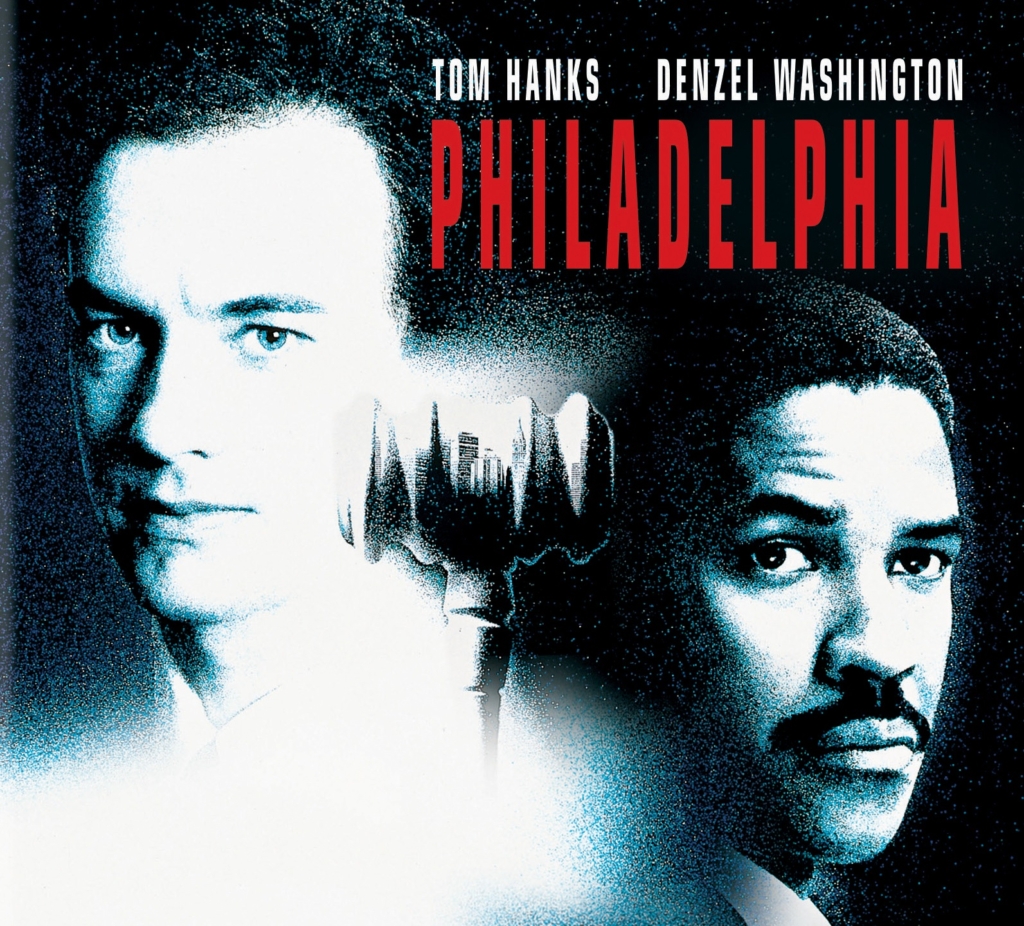
The film Philadelphia starring Tom Hanks as a lawyer with AIDS, opens in theaters. Based on a true story, it is the first major Hollywood film on AIDS.
Learn More.Filmed on location, Philadelphia included in its cast about 50 people living with AIDS, most of them clients of the Action Wellness healthcare center.
Earning $200 million at the box office and several Oscar nominations, Jonathan Demme’s courtroom drama was a catalyst for conversations, acceptance and other film projects that might never been produced.
Philadelphia was inspired by actual legal cases, including that of Geoffrey Bowers, who was wrongfully terminated from the law firm Baker McKenzie after he developed Kaposi’s sarcoma lesions on his face, just like movie’s leading character Andrew Beckett, according to Looper.
in addition to the Bowers case, the film drew inspiration from the successful discrimination suit filed by Clarence Cain, according to reporting in the Los Angeles Times. Cain, a Philadelphia lawyer who managed the regional office for a chain of low-cost legal clinics, was fired after he told his supervisor that he had AIDS.
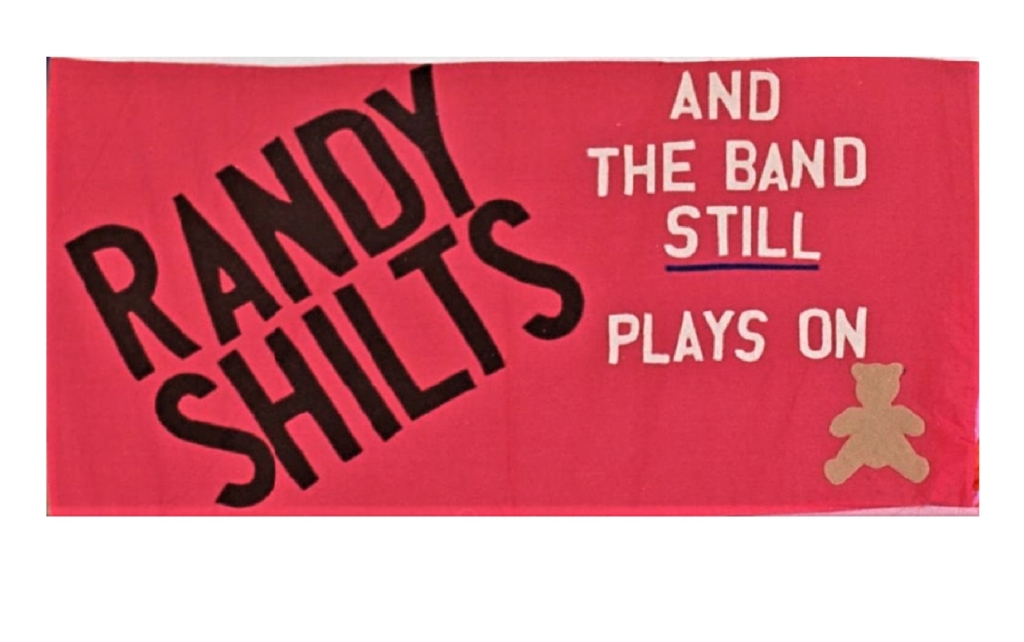
Randy Shilts, a U.S. journalist who covered the AIDS epidemic and who authored And the Band Played On: Politics, People and the AIDS Epidemic, dies of AIDS-related illness at age 42.
Learn More.Randy Shilts joined the newsroom of The San Francisco Chronicle in 1981 to report on gay politics, making him the first full-time openly gay journalist in the U.S. mainstream press. As one of the earliest people in the media to recognize the importance of AIDS as a national issue, Shilts dedicated his writing career to bringing the epidemic to the attention of the American public.
He authored three books, including The Mayor of Castro Street: The Life and Times of Harvey Milk and And The Band Played On: Politics, People, and the AIDS Epidemic (1980-1985).
Although Shilts had been tested for HIV earlier, Shilts postponed learning the results out of fear the knowledge would compromise his objectivity. He was informed he had tested positive for the virus the day he wrote the final page of And The Band Played On.
When Shilts pitched the book to publishers, he was rejected until St. Martin’s made a modest offer with an advance of $16,000, recalls friend Michael Denneny, who edited the book. And The Band Played On would go on to sell more than 100,000 hardcover copies, and some 600,000 paperbacks.
“He worked four years on that book,” Denneny says. “He went into debt. At one point, literally to pay his rent, he had to empty this huge water jug full of pennies, nickels and dimes.”
He died while planning a fourth book examining homosexuality in the Roman Catholic Church.
At his memorial service at Glide Memorial Church, his friend and assistant Linda Alband placed his press card on his casket.
* * * * * * * *
Photo of quilt panel from the AIDS Memorial Quilt

Derek Jarman, an LGBTQ rights activist and independent filmmaker, dies of AIDS-related illness at St. Bartholomew’s Hospital in London. He was 52.
Learn More.Best known as the director of low-budget surrealistic films such as Sebastiane (1975), Caravaggio (1986) and Edward II (1991), Jarman was credited with infusing 1970s and 1980s independent British cinema with fresh energy and a provocative point of view. He also directed music videos for the Smiths, Bryan Ferry, Pet Shop Boys, Bob Geldof, Patti Smith, and Marianne Faithful, according to The New York Times.
The imagery and energy of Jarman’s work — which included film, painting and writing — reflected the violently homophobic place that London was during the 1970s and 1980s, British director Neil Bartlett wrote in a 2014 tribute to Jarman in The Guardian.
“Jarman’s films – and later, his activism – were crucial points of reference in my generation’s struggles to endure and enjoy life,” wrote Bartlett. “Even before I had the good fortune to meet him in person, I intuited that here was a true ally, fighting in much the same way as I and my friends and colleagues were to find a way through some very dark times.”
Standing out from the backdrop of British traditionalism, Jarman was frequently regarded as the country’s most avant-garde director.
“Critics drew attention to his radical techniques, including the nonnarrative structure of his films, and his ‘painterly’ style,” arts and culture author Tim Lawrence wrote in AIDS, The Problem of Representation and Plurality in Derek Jarman’s Blue. “Ironically, it was Jarman’s anti-commercialism and the financial restrictions that resulted from this stance that pushed him into adopting these techniques.”
Jarman’s final — and perhaps most daring — film project was Blue, which was released at the Venice Biennale four months before his death. The film is both a serene soundscape (by Simon Fisher Turner) and spoken-word account of Jarman’s experience with AIDS, set against a delphinium blue screen.
Blue was inspired by the ultramarine light Jarman saw as his eyesight deteriorated from AIDS. At the end of the film, Jarman narrates his view of the future:
“Our name will be forgotten, in time, no one will remember our work. Our life will pass like the traces of a cloud … I place the delphinium, blue, upon your grave.”
Swapnil Dhruv Bose wrote in Far Out magazine about how Blue captures the experience of having AIDS like no other work of art.
“By showing us around 70 minutes of a static blue screen, Jarman makes a bold choice to make the viewer confront an unchanging reality while he talks about various issues that haunted him,” Swapnil Dhruv Bose wrote. “He explains the choice in the film itself, claiming that ‘blue transcends the solemn geography of human limits.’ It contributes to the construction of a paradoxical experience that is simultaneously clinically cold and vibrantly warm, inherent with all the ironies of the human condition.”
After testing positive for HIV in 1986, Jarman spoke publicly about his diagnosis amid the public panic in England about the virus. The same year, he bought a cottage in Dungeness, Kent for 32,000 pounds (roughly US$48,000). He and his partner, Keith Collins, moved in and Jarman soon began designing a garden there.
After Jarman’s death in 1994, Collins continued to live in the cottage until 2018, when he died of a brain tumor. Concerned that the cottage and its accompanying garden would be sold to a private owner, friends of Jarman and Collins raised the money to buy the property and arranged for an arts charity, the Art Fund, to maintain it, according to Rebecca Mead’s article in The New Yorker.
Among those fundraising friends were actor Tilda Swinton, who got her start in Jarman’s films; David Hockney, whom Jarman befriended in the 1960s; and Sandy Powell, the Academy Award-nominated costume designer (including for her work on Shakespeare in Love [1998], The Aviator [2004], and The Young Victoria [2009]). All told, $4 million was raised to save the property and preserve it as a tribute to Jarman and his work. The garden was clearly important to Jarman and his artistic process throughout his illness.
In a journal about his life at the cottage, Jarman wrote: “It isn’t a gloomy garden. Its circles and squares have humor — a fairy ring for troglodyte pixies — the stones a notation for long-forgotten music, an ancestral round to which I add a few new notes each morning.”
In this same journal, published in 1991 as Modern Nature, Jarman wrote in his characteristically unfettered and upbeat way about his illness and declining health:
“As I sweat it out in the early hours, a ‘guilty victim’ of the scourge, I want to bear witness how happy I am, and will be until the day I die, that I was part of the hated sexual revolution. And that I don’t regret a single step or encounter I made in that time; and if I write in future with regret, it will be a reflection of a temporary indisposition.”
Throughout his creative career, Jarman took big risks to make gay life and issues central to his work, according to the Associated Press.
Jarman’s breakout film Sebastiane (1975) was considered radical for its exploration of homosexuality in the life of Saint Sebastian. Also hailed as audacious was Jarman’s decision to have the film’s dialog performed in Latin.
In the 1986 film Caravaggio, Jarman interpreted a defining moment in painter Michelangelo Merisi da Caravaggio’s life — a swordfight which ended in the death of Caravaggio’s opponent — as a lovers’ quarrel turned deadly.
In Edward II (1991), Jarman addressed the king’s intimate liaison with his favorite Piers Gaveston. The film was based on Christopher Marlowe’s 1593 play, a work unusual for its time in openly portraying a gay relationship. It begins with Edward II (portrayed by Steven Waddington) and Gaveston (Andrew Tiernan), lounging on a bed, while two sailors are seen having sex nearby.
“Next, a naked man crowned in gold kisses a great big snake,” historian and screenwriter Alex von Tunzelmann wrote in The Guardian in his tongue-in-cheek exploration of the historical basis of Jarman’s film. “If you look very closely, you may detect an extremely subtle hint of homoeroticism here.”
Jarman was bold in his work and also in his advocacy for gay rights. According to The Washington Post in its obituary for Jarman, the film director voiced his disapproval of openly gay actor Ian McKellen accepting a knighthood from the queen, because the country’s conservative government had recently adopted anti-gay legislation.
“As a queer artist, I find it impossible to react with anything but dismay to his acceptance of the honor from a government which has stigmatized homosexuality,” Jarman wrote in The Guardian in January 1991.
“Maybe Ian McKellen will use this knighthood to try to influence the government. But I’m not at all certain. I think it’s a co-option and allows anyone to say: ‘The Tory Party isn’t so bad. It’s not really anti-gay. After all it gave Ian McKellen a knighthood.’ And he fell for them and accepted,” Jarman wrote.
For Jarman, it was important to raise awareness about the realities of HIV and AIDS, albeit while maintaining a degree of dark humor about it, because these political gestures were necessary to break through the homophobic stigma surrounding AIDS in society.
“Derek Jarman refused to live, work, or die quietly,” wrote the Thames and Hudson museum on its website. “A prolific artist and activist, he defined the bohemian ’60s in London, blazed into the queer punk scene of the 1970s, and went on to wield his colossal creativity and pride against the stigma and fear of the AIDS epidemic.”
At the time of his death in 1994, Jarman had produced 11 feature films, 10 books, hundreds of paintings, dozens of experimental short films, several music videos – and one fantastical garden.
* * * * * * * *
Photo of quilt panel from the AIDS Memorial Quilt
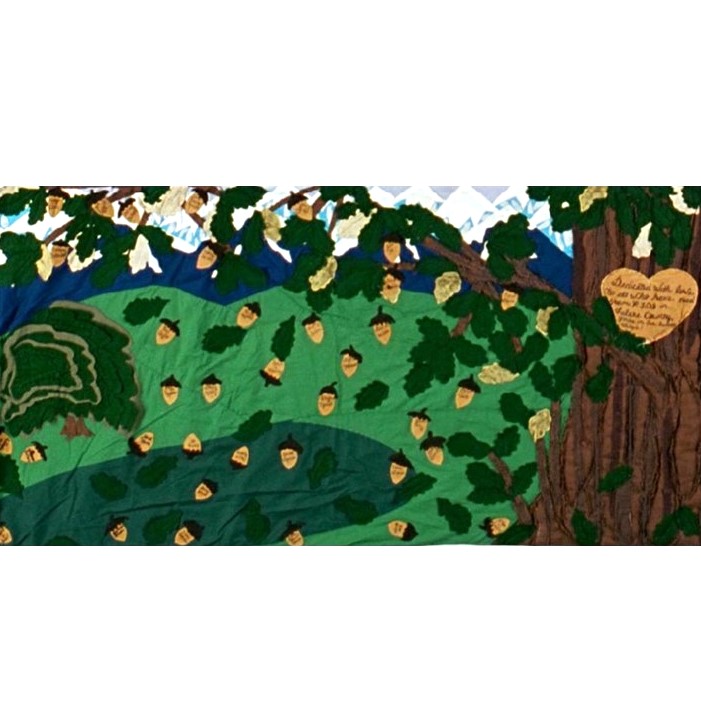
Dack Rambo, an actor best remembered for playing Jack Ewing in 51 episodes of the TV show Dallas, dies of AIDS-related illness at Delano Regional Medical Center in California at the age of 52.
Learn More.Rambo had a long list of TV credits spanning four decades and also roles in ten feature films.
Even if you couldn’t name the actor who was born Norman Jay Rambo, his face was beyond familiar to TV viewers of the 1980s, owing to appearances on everything from Charlie’s Angels to Murder, She Wrote. He held a special place in the hearts of soap fans, thanks to his roles on All My Children and Dallas.
He started his TV career with his twin brother in The Loretta Young Show. Both he and his brother played the character Peter Massey, one of seven children being raised by the widowed Christine Massey, played by Loretta Young.
He and his brother later sang as the Rambo Twins, styling themselves after the Everly Brothers, but the act ended in 1967 when his brother was killed at the age of 24 in a car accident.
During the 1970s and 1980s, Rambo made guest appearances on Marcus Welby, M.D.; House Calls; Wonder Woman; Fantasy Island; and The Love Boat. He also acted the lead role in Sword of Justice in 1978-79, and played Wesley Harper on the 1984 TV series Paper Dolls.
He earned the appellation “handsome hunk” during his days as Jack Ewing on “Dallas” and capitalized on it by launching his own line of underwear.
While working on Another World in August 1991, Rambo learned that he was infected with HIV.
He was in his dressing room that morning, preparing for his scenes, when the phone call came. After receiving his diagnosis, he put down the phone, went to the set and proceeded to tape his 40 or 50 pages of lines for the day’s work. Then he walked out of the New York studio that Friday afternoon before Labor Day and never went back.
Rambo then flew home to the San Joaquin town of Earlimart, not far from where he grew up. He broke the news to his sister, Beverly, 48, and his mother, Beatrice, 82, according to People magazine. Both took the news hard.
“At first I was totally devastated,” Beverly told People. “We lost one brother, and I didn’t think I could live with losing another.”
Retreating to his Earlimart ranch, Rambo spent the next three weeks in bed, he says, “wallowing in self-pity.”
“First of all, I was scared,” he told The Washington Post. “I felt a lot of anger and a lot of rage. And actually wanting to die. But all those things were short-lived.”
He took time to determine what he wanted to do next. He decided to go public with his HIV-positive diagnosis and released a statement announcing that he had the AIDS virus and would devote himself to working for the cause of AIDS education and research.
Rambo was among the first well-known actors to disclose his HIV status. In an interview with the Los Angles Times shortly after his announcement, he disclosed that he was bisexual and talked about feeling on the set of Dallas that he was suspected of being gay and vulnerable to AIDS.
“I knew there were whispers going on behind my back,” he said. “Either ‘he’s gay’ or ‘he’s this or ….’ People were just assuming. And people didn’t really know anything about my private life.”
A few months later, in late 1991, Rambo told The Wasington Post, “I feel fabulous, I’ve never felt better.”
He said he adopted a healthier lifestyle and even stopped dying his hair, which had been graying since he was 30 years old.
“I don’t drink anymore … I really baby myself and I’m very selfish with myself,” he said. “I don’t want anyone to interfere with me taking care of myself.”
He said he regularly sought advice on nutrition, read everything he could on AIDS and followed the conventional wisdom of treating the virus before it could become a full-blown disease. He said he had yet to suffer any symptoms of AIDS and was in ongoing discussions with doctors about what medications he should take.
Around that time, Rambo began volunteering with APLA (AIDS Project Los Angeles), one of the largest AIDS service providers in the country.
“He’s very committed to this,” said Anthony Sprauve, director of communications for APLA.
Shortly afterward, Rambo developed an AIDS-related cancer and underwent chemotherapy. He also turned to holistic treatment, according to People magazine. In the summer of 1993, he thought he’d halted the virus through prayer.
“There is no disease that cannot be healed,” he said then. “I will believe that until the day I drop.”
Rambo died at Delano Regional Medical Center in Earlimart.
* * * * * * * *
Photo of quilt panel from the AIDS Memorial Quilt
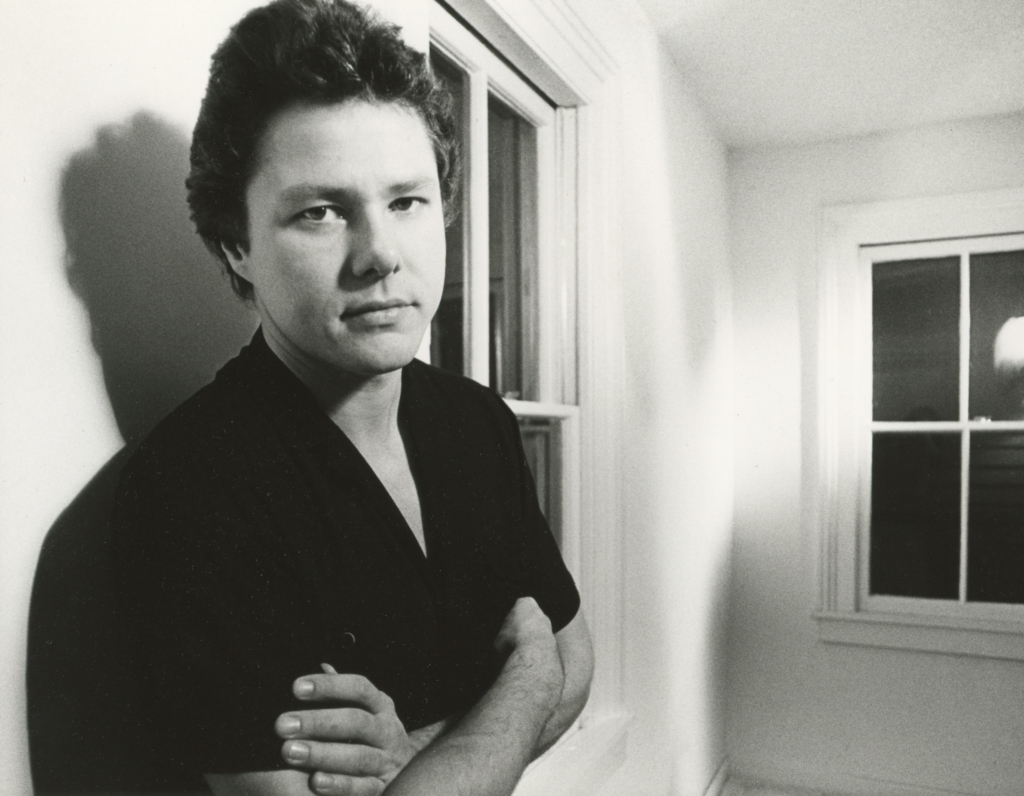
Musician and songwriter Dan Hartman dies of AIDS-related illness at his Westport, Connecticut home at the age of 43.
[photo by Jerry King Musser]
Learn More.Hartman wrote and recorded “Free Ride” (1973) with The Edgar Winter Group and collaborated with scores of the country’s top recording artists from 1976 to 1994.
His song, “I Can Dream About You,” reached No. 6 on the Billboard Hot 100 in 1984 and No. 12 on the UK Singles Chart in 1985. The James Brown song “Living in America,” which Hartman co-wrote and produced, was even more successful, reaching No. 4 in March 1986.
Hartman worked with veteran singer-songwriter Neil Sedaka, who lived near him in Westport. Hartman would invite Sedaka to his home studio to record.
“I was proud to have recorded two LP’s with him,” Sedaka said. “He was so respected, that he was able to get such luminaries as Edgar Winter, Rick Derringer, Mary Wilson, Ashford & Simpson, and Gary U.S. Bonds to join me on several duets.”
Hartman’s longtime friend Glenn Ellison told the website Memories of Dan Hartman: “Dan was the genuine article, full of passion and joy for just living. He definitely has a spiritual side, that wasn’t so religious, as it was about the soul, and how to make the most out of the time we have on earth.”
Ellison said he and Hartman met in January 1984 on a plane travelling from New York to Los Angeles. Two months later, Ellison got a job offer in New York, and Hartman invited him to live in his house until he found a place of his own.
“I was in and out of Westport for the next 10 years,” Ellison said.
One of Ellison’s favorite memories was Hartman’s European tour when “I Can Dream About You” was climbing the charts. He noticed that every time Hartman sang the song, crowds would respond by singing and dancing with him.
“When you hear the song today, there is the same response. It is an all-time pop masterpiece,” he said.
Hartman was diagnosed with HIV in the late 1980s, and kept his HIV status a secret and supposedly did not seek treatment, even after friend and intermittent collaborator Holly Johnson (formerly of the band Frankie Goes to Hollywood) announced his own HIV status in 1991.
In 1993, Hartman’s health declined and he was in and out of the hospital. Ellison had returned to California a few years before and was able to see Hartman only periodically.
“As fate would have it, in December, I was out of a job so I flew back and spent the entire month at his newly remodelled home. We had the greatest time of our ten-year friendship,” Ellison recalled. “He rallied and seemed to be making a full recovery. We turned the house into a Christmas fantasy, saw all the holiday shows in Manhattan and laughed 24/7. When I flew back to LA on New Year’s Day, I thought he would live forever.”
Hartman would die about four months later.
In his last will and testament, Hartman created the Dan Hartman Arts and Music Foundation (located in the Los Angeles area).
[photo by Jerry King Musser]

British figure skater and Olympic gold medalist John Curry dies of AIDS-related illness in Binton, Warwickshire, at the age of 44.
Learn More.As a young child, Curry became a skater because his parents wouldn’t let him study dance. But when Curry was 16 years old, his father committed suicide, and two years later, Curry began training in ballet in addition to skating.
His dedication to both arts resulted in a distinctive skating style and this eventually brought him to the Olympic Winter Games at Innsbruck in February 1976, where he won the gold medal.
“Already in the lead after the first two sections of his event, [Curry] skated a program that was superb in its cool beauty of movement,” wrote Dennis L. Bird, a culture writer for the UK publication Independent. “There were three immaculate triple jumps, and the whole performance was a perfect blend of athletic skating and musical interpretation. Leon Minkus’s ballet Don Quixote had surely never inspired such artistry.”
Following the 1976 World Championships, Curry turned professional and founded a skating company. For about 10 years, he choreographed routines for the company and toured his skaters much like a traditional dance company.
In early November 1987, Curry dazzled the audience with two performances at ”Skating for Life – A Celebration of Champions,” an AIDS benefit show in New York City. His first appearance was a solo performance that incorporated mime and dance with skating, and he skated again in a romantic duet with U.S. champion skater Judy Blumberg.
“The image of Mr. Curry as the epitome of a ballroom dancer is new,” wrote New York Times dance critic Anna Kisselgoff. “But unwinding in and out of embraces, he and Miss Blumberg, a first-rate dramatic skater, made for a picture in tenderness.”
Curry’s final public performance would be later that month in “Ice Stars’ Hollywood Revue,” a CBS special.
In December 1987, Curry was diagnosed with HIV, and in mid-1991 with AIDS. In October 1992, he gave an interview to the London Mail in which he spoke about both his disease and his sexual orientation.
“My whole circle of friends died. I don’t mean lovers, but I’m talking about people you go to the theater or to dinner with,” he told the Mail.
Following Curry’s death, Dennis L. Bird wrote in the Independent:
“The word ‘genius’ should be used sparingly, but it is entirely justified in relation to John Curry. To the prescribed disciplines of ice-skating he brought a free-ranging artistry, an innovative imagination and musical sensitivity, which in effect created a new art-form: the re-interpretation of some of the great composers in terms of movement on ice.
Curry is still remembered as one of the greatest stylists and artists in figure-skating history.
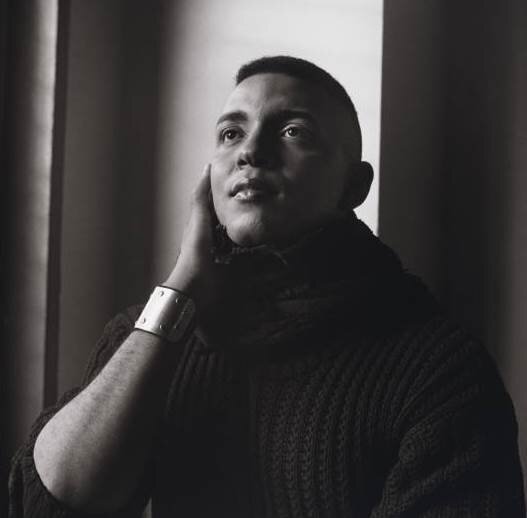
Assotto Saint, a Haitian-born poet and performance artist, dies of AIDS-related illness in New York City at the age of 36.
Learn More.Among the first Black activists to disclose his HIV positive status, Saint was one of the first poets to include the subject of AIDS in his work. He was also a performance artist, musician, editor, human rights and AIDS activist, theatrical founder, and dancer.
After immigrating from Haiti to New York in 1970 when he was 13 years old, Saint graduated from Jamaica High School and was briefly enrolled as a pre-med student at Queens College. Soon, however, he turned his attention to theater and dance, and adopted the name Assotto Saint —“Assotto” for a ceremonial drum used in Haitian vodoo rituals and “Saint” for Haitian revolutionary leader Toussaint L’Ouverture. Through the 1970s, Saint’s passions grew to include poetry, music, and fiction.
In 1980, Saint fell in love with Jaan Urban Holmgren, a Swedish-born composer, and they began to collaborate on a number of theatrical and musical projects. Their relationship would last 14 years, during which time Holmgren would write songs for Saint’s many theater pieces on gay Black life, including including Risin’ to the Love We Need and New Love Song. Saint was the founder and artistic director of Metamorphosis Theater, where many of their collaborative pieces were performed.
Saint founded the publishing house Galiens Press, which published his book of poems Stations and the anthologies Here to Dare and The Road Before Us. With Holmgren, Saint also performed as lead singer in the “techno pop duo” band Xotika, and released the dance song “Forever Gay” on the album Feeding the Flame: Songs by Men to End AIDS.
Saint was dancer with the Martha Graham company, and appeared in Marlon Riggs’ Non Je Ne Regrette Rien (No Regret).
“Assotto was always prepared to die,” writes author Victoria Brownworth for Lambda Literary. “If that makes him sound like a fatalist or a Zen master, he was neither. He was just clear about what was going to happen. And he knew the work had to be done and quickly, urgently, before time ran out.”
Here is the beginning of Saint’s final poem for his life-partner, Jan Holmgren, who was dying of AIDS:
A Lover’s Diary
monday, march 29, 1993
-01-
vigil on two chairs
iwhisper “hey, good morning”
he doesn’t respond
iwatch his labored breathings
the head nurse suctions him up
-02-
“he’s turned for the worse”
dr mcmeeking mumbles
weeks, days, just can’t tell
“hours” insists my mother
furious iescort her out
-03-
the oscars come on
the crying game stars don’t win
hoping he can hear
iremind him he’s my light
death rattles my scream for help
-04-
the nurse rushes in
mother returns with prayers
icradle him close
pleading “stay, one more day, stay”
eleven twenty, he’s gone
-05-
bathe him with my tears
parched lips thirst for a wet
kiss
istick my tongue deep
bitter taste of bloody phlegm
moans spat out ishut his eyes
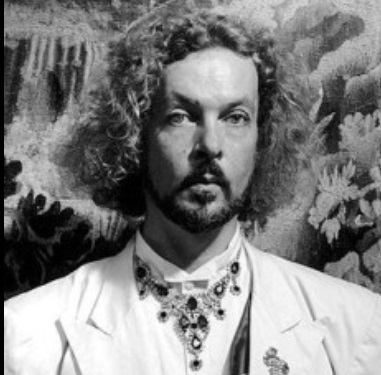
Steven Arnold, a multidisciplinary artist and protégé of Salvador Dali, dies of AIDS-related illness in West Hollywood. He was 51.
Learn More.Out of the fantastical dreamscape of “Zanzabar,” his Los Angeles studio, Steven Arnold created photography, drawings, paintings, makeup design, costume design and set design. He also produced two films, one of which was Luminous Procuress (1971), which starred his childhood friend Pandora in the title role and featured the San Francisco-based gender-bending performers The Cockettes.
“Arnold seamlessly weaved celebrity, glamour, and camp theatricality with ancient ritual, two-spirit philosophy, and eastern art into a majestic Baroque-inspired tableaux,” said culture writer Miss Rosen in her Another Man article, “Steven Arnold, the Queer Mystic Who Shaped 1960s Counterculture.”
Born in Oakland, California in 1943, Arnold would spend hours in the attic of his childhood home, using old costumes and props from a vaudevillian uncle to create his own personal art spectacle, according to Miss Rosen.
In high school, he befriended another student, Pandora, who would become his lifelong friend and collaborator It was also at Oakland Technical High School where the art teacher, Violet Chew, took Arnold under her wing and introduced him to Eastern spiritual traditions, art history, and fashion.
In the mid-60s, Arnold was awarded a full scholarship to attend the San Francisco Art Institute, and there he created two films – Messages, Messages (1968) and Luminous Procuress (1971) – that are now considered groundbreaking works of cinema.
His first film was premiered at the St. Regis Hotel in New York by iconic surrealist painter Salvador Dalí and was subsequently invited to Director’s Fortnight at Cannes. Eager to make a big splash in his hometown, Arnold rented the Palace Theatre in San Francisco’s North Beach for the film’s premiere in February 1968, selling 2,000 tickets on opening night.
Following the success of his film screening, Arnold began hosting the “Nocturnal Dreamshow,” a weekly cult movie night at the Palace Theatre in San Francisco that established the “midnight movies” tradition, according to Tyler Akers of Gayletter magazine.
It was here that “The Cockettes” first performed and introduced audiences to outrageous displays of gender fluidity and non-binary presentation.
“Arnold celebrated the idea that male and female are both part of the whole human experience in each of us, like yin and yang,” wrote Akers in Gayletter. “In interviews, he would often discuss the Zen teachings of Eastern philosophies as well as the Native American idea of ‘two-spirit’ people and Carl Jung’s concept of a collective unconscious.”
Arnold’s second film, Luminous Procuress, also brought critical acclaim, and he was honored with the New Director Award at the 1972 San Francisco International Film Festival. He was also invited to New York to exhibit at the Whitney Museum of American Art.
After graduating with a Masters of Fine Art, Arnold left the Bay Area to establish a studio in Los Angeles on Beverly Boulevard near North Virgil Avenue. Soon he was inviting friends and acquaintances over so he could dress them up as deities and mystics, and photograph them.
He issued three photographic collections: Angels of Night (1987), Epiphanies (1987), and Reliquaries (1983). A fourth collection, Theophonies, was released posthumously as a photographic exhibit in 2022.
The Fahey/Klein Gallery in Los Angeles, which exhibited Theophonies, issued a press release that included this description of Arnold’s photographic process:
“Steven Arnold’s tableau photography represents a confluence of his myriad other disciplines. After sketching storyboards inspired by his dreams, a habit from his filmmaking days, Arnold would craft his tableaus using cardboard, seamless paper, metallic and patterned fabrics, cut paper, paint, and selections from his obsessive collection of antiques, costumes, make-up, and dime store finds. Finally, he would dress, paint, and pose his models within his tableau, bringing his vision to life, then captured with his Hasselblad, often utilizing multiple exposures.”
Today, Arnold’s photographs are in the collections of the Museum of Modern Art and the Whitney Museum of American Art in New York City, the Museum of Contemporary Art in Los Angeles, and the Cincinnati Art Museum, according to The New York Times.
_ _ _ _ _ _ _
Photo courtesy of The Steven Arnold Museum and Archives
Joel Harrison, an Alvin Ailey protégé who founded the Hudson Repertory Dance Theater, dies of AIDS-related illness at the age of 47.
Learn More.After spending much of the 1970s and early 1980s dancing with Alvin Ailey’s company in New York, the New York City and San Francisco Opera Ballets, the National Ballet of Venezuela. and the Carlos Carvajal’s Dance Spectrum in the Bay Area, Harrison returned to his hometown of Jersey City, New Jersey and founded the Hudson Repertory Dance Theater in 1983.
Harrison said he was inspired to create his own dance company by Arthur Mitchell, the New York City ballet dancer who created the Dance Theater of Harlem, according an interview with The New York Times.
“The whole premise of the company is to create a facility for minority artists from all cultural backgrounds,” Harrison told Barbara Gilford of The Times, ”and to mount and show their work – whether dancers, choreographers, musicians or composers.”
In the forming of his dance company, Harrison strove to create a microcosm of the racial and ethnic diversity of Hudson County. The result was a company that included Japanese, Chinese, Black, Hispanic and white dancers.
Located in the Barrow Mansion, a large, white Greek Revival-style building on Wayne Street in Jersey City, the Hudson Repertory Dance Theater held classes for its 75 students as well as rehearsals and performances.
The company’s most popular show occurred in December, with Harrison’s annual production of Ebenezer’s Dream, a ballet based on A Christmas Carol by Charles Dickens. In 1988, Harrison began holding performances at the Park Theater in Union City, New Jersey.
“We have to educate, especially in Hudson County, and create an impact on the population here,” Mr. Harrison said.
Harrison’s aunt, N. Beatrice Worthy, recalled the day she realized her nephew had a talent for dance.
“One Saturday morning, I was cleaning my room and had gone into another room to get something. When I got back, Odessa’s son Joel, who was about five or six years old, was dancing to one of the records I had on my record player — Brahms or something. He didn’t know I was watching him, but I was so amazed at how he could dance,” she told Karen Leahy of The New Sun. “I didn’t say anything to him, but I went to his mother and said, ‘You have got to put that child in dance school!'”
Harrison became a dedicated student of classical ballet at the American Ballet Theater School and at Juilliard. He undertook additional studies in modern dance at the Merce Cunningham Studio and with Alwin Nikolais, according to The Times.
Harrison’s Aunt Beatrice said that she was also there to help her nephew create the Hudson Repertory Dance Theater, and she was pleased to see that he had grown up to be a man with a generosity of spirit.
“When he was running the dance school, there was a little fellow whose mother couldn’t afford to pay the 25 cents for dance classes, but he would go along with a friend of his and stand in the corner to watch,” Worthy recalled. “Joel turned around and saw the boy trying to do what the others were doing, so he brought him in and let him take classes without charge.”
Following Harrison’s death, Worthy became head of the Hudson Repertory Dance School.
“Of all the things I’ve done in my lifetime, I think I’m proudest of the dance school,” she said.
Joel Harrison is memorialized with a biography on Dancers We Lost: Honoring Performers Lost to HIV/AIDS.
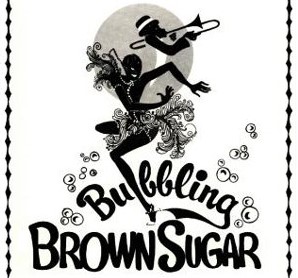
Billy Wilson, the director and choreographer of Bubbling Brown Sugar and other Broadway musicals, dies of AIDS-related illness at St. Vincent’s Hospital in Manhattan. He was 59.
Learn More.“Wilson was known as an experienced and dependable director who injected extra life and energy into his productions, adding small, telling details and encouraging performers to be more expressive than they believed they were,” according to New York Times art critic Jennifer Dunning.
In a 1976 interview in The Times, he described the process of turning Guys and Dolls into a Black musical as something “like taking chicken soup and making it a little more gumbo.”
Born William Adolphus Wilson, he was raised in Philadelphia and received a scholarship at 15 to study classical ballet with Anthony Tudor. He made his New York debut at age 19 in the City Center production of Carmen Jones and went on to dance on Broadway in Bells are Ringing and Jamaica.
He went to London to perform in a production of West Side Story, and remained in Europe for 10 years. From 1961 to 1965, he was a soloist with the Dutch National Ballet, where he starred in Othello, a ballet created for him by Serge Lifar.
He returned to the U.S. an international ballet star.
On Broadway, Wilson choreographed and staged shows that included Eubie, for which he shared credit with Henry Le Tang; Merlin; a production of Stop the World, I Want to Get Off with Sammy Davis Jr.; and Alan J. Lerner’s last Broadway show, Dance a Little Closer, along with the 1976 hit Bubbling Brown Sugar.
He was nominated for three Tony Awards, and he directed and choreographed the all-black production of Guys and Dolls in 1976 and choreographed the Emmy Award-winning television show Zoom.
He married Sonia van Beers, a fellow dancer, and became father to a daughter, Alexis, and son, Parker.
In the late 1970s, Wilson became life partners with Chip Garnett, and they remained together for 18 years, until Garnett died. Wilson would die just six months later.
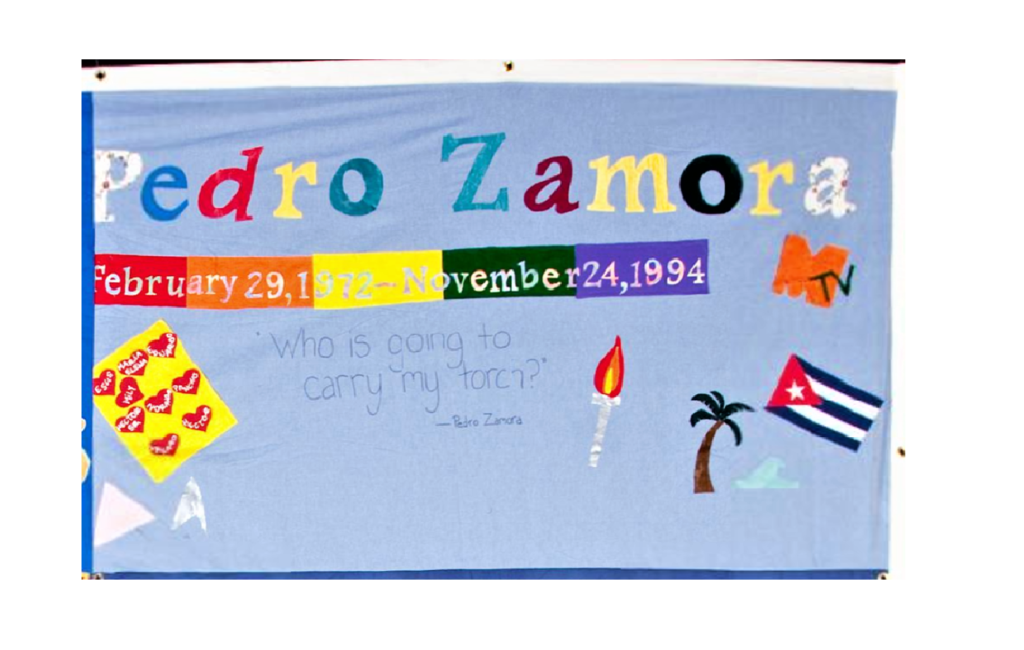
Pedro Zamora, an HIV-positive man appearing in MTV’s popular show The Real World, dies of AIDS-related illness at age 22.
Learn More.As one of the first openly gay men with AIDS in media, Zamora brings international attention to HIV/AIDS and LGBT issues and prejudices through his appearance on MTV’s reality television series, The Real World: San Francisco.
Zamora’s commitment ceremony to his partner Sean Sasser, which is filmed for the show, is also the first same-sex ceremony in television history. Zamora dies just hours after the finale of The Real World: San Francisco aired on MTV.
* * * * * * * *
Photo of quilt panel from the AIDS Memorial Quilt
Keith McDaniel, who was a principal artist with the Alvin Ailey American Dance Theater and on Broadway, dies of AIDS-related illness at his Los Angeles home at the age of 38.
Learn More.Film and stage superstar Shirley MacLaine said of McDaniel: “He was dynamic, strong, and possessed a muscled body that inspired awe on the stage.”
A Chicago native, McDaniel was known around the world as a master of modern dance technique and for his ability to stand out onstage “for the quiet radiance he brought to all his roles,” according to art critic Jennifer Dunning of The New York Times.
He began his career in 1975 with the Alvin Ailey American Dance Theater, where he performed as a naïve youngster in Donald McKayle’s District Storyville and Talley Beatty’s Stack-Up. McDaniel transitioned seamlessly to more mature roles, like the sensual lover in Elisa Monte’s Treading and the ecstatic baptismal celebrant in Ailey’s Revelations.
After he leaving the Ailey Company in 1983, he appeared on Broadway in Leader of the Pack, and then Kiss of the Spider Woman as a lead dancer and dance captain, partnering with Chita Rivera.
McDaniel moved to Los Angeles to work in film, television and music videos, appearing in Beaches, Great Balls of Fire, The Lady Killers, and Basic Instinct. On television, he was seen on the Tracey Ullman Show, Moonlighting, and several Academy Awards broadcasts.
“He was,” remembered Matt Tapscott, his partner, “a very kind, caring, loving and spiritual person who was totally committed to his career and his family.”
McDaniel is memorialized in the project Dancers We Lost: Honoring Performers Lost to HIV/AIDS.
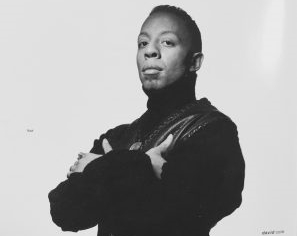
Record producer and songwriter David Cole dies of AIDS-related illness at the age of 32.
Learn More.Half of the dance-music duo C+C Music Factory, Cole and his musical partner Robert Clivillés produced numerous high-energy dance tracks, such as “Make You Sweat (Everybody Dance Now),” “Here We Go Let’s Rock & Roll” and “Things That Make You Go Hmmm.”
The New York-based act solidified their white-hot status when they won the 1991 Billboard Award for Best New Pop Artist, beating out Boyz II Men, Color Me Badd, EMF and others. After performing an elaborately choreographed medley of their hits, Cole and Clivillés along with vocalists Zelma Davis and Freedom Williams assembled at the podium to accept their award. It was one of the last appearances C&C Music Factory would ever make together.
Cole and Clivillés met in the mid 80s, when both were DJing at New York City clubs. Before they had their big break with “Make You Sweat,” they worked behind-the-scenes, co-writing and producing songs for artists like Chaka Khan and Grace Jones, co-producing remixes, and acting as managers for various groups. Together, they wrote and produced four songs on Mariah Carey’s 1991 album Emotions, including the smash hit title track.
Cole’s success continued to climb as he continued to produce mega-hits with Aretha Franklin, James Brown, Lisa Lisa and Cult Jam, and many top musical acts of the late ’80s and early ’90s. Cole won a Grammy for the soundtrack for the hit movie The Bodyguard (1992) starring Kevin Costner and Whitney Houston.
Cole died on January 24, 1995 from spinal meningitis brought on by HIV at the age of 32.
Mariah Carey wrote the song “One Sweet Day” in memory of Cole.
In a 2018 interview with pitchfork, Carey spoke about Cole:
“He was one of the only people I used to have in the studio when I would sing, because I respected him as a singer. He would push me in different areas where he could actually sing it to me and I would be like, ‘Oh, this is cool. I like that’ … Half the time, I would lose my voice afterwards, because he would just push me.”
The tribute to Cole on thegranvarones reads:
“I remember watching MTV when the news of David’s death broke. The realization that fame and talent could not and would not protect the young and talented knocked the wind out of me. Even now as an adult, I am still saddened by the loss of such a brilliant artist. David Cole, in his all too brief time on this planet, blessed us with a catalog of music that has and will continue to inspire generations. Rest well, David. May you forever dance in peace!”
Olympic gold-medal diver Greg Louganis discloses that he is HIV-positive. The announcement draws criticism from some who believe Louganis should have disclosed his status prior to competing in the 1988 Olympics.
Learn More.In a TV interview with ABC’s 20/20, Louganis says he knew he was HIV-positive before the 1988 Summer Olympics in Seoul, South Korea, and was greatly concerned when he hit his head on the board during a dive and shed blood in the pool.
Since the Seoul Games, Louganis’s infection has developed into AIDS, according to the definition established by the Centers for Disease Control.
“According to the CDC, I have AIDS versus HIV,” Louganis told Barbara Walters. “I do have AIDS.”
Louganis, 35, who won four gold medals at the 1984 and 1988 Summer Olympics, retired from the sport in 1988 and was recently pursuing an acting career. He discloses his homosexuality at the 1994 Gay Games in New York.
Olympic athletes are tested for an array of performance-enhancing drugs, but they are not required to reveal their HIV status. Mike Moran, spokesman for the U.S. Olympic Committee, tells the Los Angeles Times that the policy was not likely to change.
Regarding the blood that spilled into Seoul’s Chamshil Pool, the International Olympic Committee and FINA, swimming and diving’s world governing body, issue statements saying that a minuscule amount of blood in chlorinated water poses no threat to anyone.
Louganis, 35, joins two other major athletes who shared their HIV-positive status.. Magic Johnson left the Los Angeles Lakers in 1991 after saying he was infected with HIV. Tennis star Arthur Ashe died in 1993 of AIDS-related causes.
Musa “Queen” Njoko reveals her HIV-positive status to Ilanga, a Zulu newspaper, becoming South Africa’s only recording artist living openly with the virus.
Learn More.Njoko’s story landed on the newspaper’s front page, which resulted in her being expelled from her church and threatened with death by her partner. She told the Ilanga that she was diagnosed with HIV a year ago, in 1994, the year of South Africa’s independence from white minority rule. She was 22 years old, and her doctor told her she had three months before AIDS would end her life.
“I waited … three, four months, I waited for death,“ Njoko told NationNews in a 2010 interview. “I would make sure that I rested properly in my bed, put my arms on my chest just to make sure that at least in my coffin, I would look decent. It was very lonely and very emotionally draining and quite sad.”
Njoko decided to become an advocate and activist for HIV-positive people, because of the lack of information about the disease. She was angry and frustrated.
“There was no information at all, except that it was known as a disease for people who had multiple partners, a disease for gay people and for people who were sex workers,” she said.
She believed that people — particularly women — were becoming infected because they believed they didn’t need to be concerned about HIV if they didn’t belong to any of those groups. And yet, when her doctor tested her for the AIDS virus, she said that Njoko “fitted the profile — Black, young, from a township, with a child.”
She wanted to raise awareness about the ever-increasing risk of being infected, so she took the courageous step of disclosing her HIV status in the local newspaper.
Just a few years later, Njoko would find herself organizing the funeral of another activist who publicly disclosed her HIV status in media. Gugu Dlamini, a 36-year-old South African woman who volunteered as a field worker for the National Association of People Living With HIV/AIDS, was stoned and stabbed to death by neighbors in 1998 after she announced on a local radio station that she was HIV positive.
Njoko somehow avoided a fate similar to Dlmini’s and would become a long-term HIV survivor, thriving as a gospel singer and motivational speaker. But for almost 10 years, she would have to manage her disease largely without the treatment options available in other countries.
In South Africa, antiretroviral drugs (ARVs) would not become available to its citizens until 2004. Former President Thabo Mbeki and Health Minister Dr Manto Tshabalala-Msimang questioned the research on ARV treatment for HIV and AIDS. During this time, Njoko would endure a six-month bout of meningitis, followed by bone-marrow tuberculosis. Then in 2002, she almost lost her right arm in a car accident, resulting in the permanent limited use of her right hand.
But she perservered, and by 2010, she would be known as the voice for countless women who were still afraid to speak about the issues of rape, abuse and HIV. Njoko would travel extensively, making her voice heard at conferences and ministering to those living with HIV/AIDS.
In 2016, Njoko would write the musical theatre production In My Own Voice about her journey with HIV against the backdrop of 1990s South Africa, deprived of healthcare resources and rife with intolerance for those with HIV/AIDS. The show would hold its world premier at the Durban Playhouse in South Afirica on July 22, 2016 on the final evening of the 21st International AIDS conference.
Njoko would also become a key role player in South African Voices: Towards a Museum of HIV Memory and Learning, an AIDS educational project at Durban’s KwaMuhle Museum. The museum exhibition offered people a space to celebrate achievements in addressing the HIV/AIDS crisis in South Africa.
Njoko continues to pioneer for HIV/AIDS, women’s health and human rights.
“Life can still be lived to its fullest, but it might change a bit from what you envisioned,” she said in 2016. “Eat properly, follow your treatment, and look after your spiritual and emotional well-being.”

Rapper Eazy-E dies from AIDS-related illness at the age of 31, one month after being diagnosed.
Learn More.As a founding member of the rap group N.W.A. (which stands for Niggaz Wit’ Attitude), Eazy-E was the executive producer of the gangster rap album, Straight Outta Compton, released in 1988. The album’s raps about gunplay, drug dealing, raw sex, gang solidarity and police harassment in a Los Angeles suburb included one song that is a fantasy of violent revenge against racist police officers.
Born Eric Lynn Wright, Eazy-E dies at Cedars-Sinai Medical Center after being hospitalized on Feb. 24 for what he thought was asthma. Tests reveal he has AIDS, and on March 16 he would release a statement that he had contracted the disease.
An album that Eazy had been working on would be released posthumously in 1995, and an EP of unreleased tracks would be issued on the seven-year anniversary of his death.
One of his children, singer E.B. Wright, would go on to produce A Ruthless Scandal, a documentary about the final days of her father’s life. His story is also depicted in the 2015 biopic Straight Outta Compton, directed by F. Gary Gray.
* * * * * * * *
Photo of quilt panel from the AIDS Memorial Quilt

Irish pop star Jimmy McShane, who was a “one-hit wonder” in the U.S. with the song “Tarzan Boy,” dies of AIDS-related illness in his hometown of Derry. He was 37.
Learn More.“Tarzan Boy” was the 1985 debut single by the Italian-based act Baltimora, which consisted of Jimmy McShane and Maurizio Bassi. The song went top five across Europe, reached number three in the U.K, top five in Japan and reached No 13 in the U.S.
Born in Derry in 1957, McShane was drawn to performing at a young age, and he enjoyed dying his hair and wearing unconventional clothes.
“He had a tough time growing up,” his brother Damien McShane told the Derry Journal in 2018. “He had a larger-than-life personality and naturally people gravitated towards him, but his years at St. Peter’s were difficult for him. Jim was bullied the entire time for being different, and at the time, I never even considered that he was gay, it just wasn’t talked about.”
At the first chance he got, he moved to London to attend stage school and subsequently tried – and failed – to break into the West End musical scene. A few years later, he returned to Derry and took a job as an emergency medical technician with the Red Cross, according to the Belfast Telegraph.
But then a friend from London reached out and things brightened for McShane. Disco singer Dee D. Jackson needed back-up dancers for her European tour, and McShane embraced the opportunity.
When the act toured Italy, McShane fell in love with the country and particularly enjoyed its underground dance scene, according to The Living Room by Matt and Andrej Koymasky. In 1985, he made Milan his new home and learned to speak Italian.
Italian producer Maurizio Bassi approached McShane about being the lead singer for his new project, Baltimora, and in 1985 they released their first single, “Tarzan Boy.” With its distinctive jungle call, the song became a huge hit and Baltimora were suddenly international pop stars. The next year, Baltimora performed their hit song on American Bandstand (actually, McShane lip-synched), and McShane was interviewed by the legendary Dick Clark.
The media began to refer to McShane as “Baltimora,” on the misconception that it was his stage name, rather than the group’s collective title, and this caused internal strife between Bassi and McShane. When the band’s next single “Key Key Karimba” failed to chart in 1987, Bassi broke up the act.
McShane returned to Italy, and in 1994, he was diagnosed with AIDS. He called his family and arranged to move back to his childhood home in Derry to live out the last year of his life, according to the Derry Journal.
McShane’s brother said that before the pop artist died, he spent the last of his savings on a birthday party for his youngest nephew, James.
On the day of McShane’s funeral, the residents of Derry came out into the streets to watch the funeral procession make its way from Long Tower Church to Derry City Cemetery. Many wore red ribbons as a mark of respect for their hometown celebrity.
Tony Azito, a dancer and character actor celebrated for his ability to accentuate his lanky, hyperextended body, dies of AIDS-related illness at St. Vincent’s Medical Center in New York City. He was 46 years old.
Learn More.Tony Azito, the lanky, loose-limbed Broadway actor who led the Keystone Kops in the New York Shakespeare Festival’s 1981 production of “The Pirates of Penzance,” died yesterday at St. Vincent’s Hospital in Manhattan. He was 46 and lived in Manhattan.
The cause was AIDS, said Bonnie Egan, a friend.
Mr. Azito was born in Manhattan and attended public schools in Manhattan and Queens. He studied drama at the Juilliard School, where he worked with John Houseman in the experimental company that later became the nucleus of the Acting Company. He also studied with the dancer and choreographer Anna Sokolow.
He left Juilliard in 1976 to take the role of Mr. Peachum’s assistant in the Shakespeare in the Park production of “The Threepenny Opera.” A year later, he appeared as Dr. Nakamura in the Brecht-Weill musical “Happy End,” which starred Meryl Streep. Both performances were widely praised.
In 1980, he was nominated for a Tony Award and received a Drama Desk Award for his role as the Sergeant in “Pirates.” He also appeared in the film version of the operetta.
Mr. Azito spent four years with the LaMama Experimental Theater Company, appearing in a dozen shows. In the 1970’s, he often performed cabaret at Reno Sweeney and the Ballroom. With the Shakespeare Festival, he appeared as Bardolph in “Henry IV” (1985) and Feste in “Twelfth Night” (1986).
His film credits included “Union City,” “Private Resort” and “Bloodhounds of Broadway,” as well as small roles in “The Addams Family” and “Moonstruck.” In the television series “Miami Vice” he had a recurring role as the drug dealer Manolo.
Filipino singer-songwriter Rodel Belvis Naval, called “Ody” by his friends, dies of HIV-related illness in Toronto, Canada at the age of 42.
Learn More.Best known for the songs “Lumayo Ka Man Sa Akin” and “Muli,” Naval was considered one of the most versatile artists in the Philippines entertainment world. He drew thousands of fans to his concerts in Las Vegas, Los Angeles, New Mexico, Singapore, Japan, and Toronto.
Naval was 26 years old when he immigrated from the Philippines to join other family members already settled in Canada in 1979. A year later, he performed in three major concerts in Los Angeles and then a series of concerts in Las Vegas, Lake Tahoe, and Mexico.
In 1989, he returned to the Philippines and recorded his first album, Finally. After a 1990 performance in Japan, he released the album Lumayo Ka Man Sa Akin, which featured the hit song “Muli.”
The song became popular with fans both young and old, and it still remains a favored selection in Filipino karaoke bars. The second album also included Naval’s most popular song, “Lumayo Ka Man Sa Akin.”
“When the lyrics of this song was being written by Rodel in Japan, his mind was on our mom who had just passed two months earlier,” his sister Delia told Esquire Philippines. “He missed our mom so much that he wrote the lyrics within 15 minutes.”
Naval’s final album was Once Again (1992), from which the songs “Ikaw Pa Lamang” and “Kailan Kaya” enjoyed platinum success.
In 1993, Naval became ill and returned to Canada to receive medical attention, according to People Pill. While in Toronto, he auditioned for musical production Miss Saigon and won the role of assistant commissar. He continued to give performances, even while his health was in rapid decline. In April 1994, he performed in two concerts, one in Toronto and the other in Los Angeles.
In an interview before his death, Naval said, “Maybe there is a purpose to all of this, and if I can help others because of what happened to me, let it be so.”
Two years after Naval died, two of his sisters founded Rodel Naval Care Outreach (RoNaCo) to help people in the poverty-stricken areas of Manila affected by HIV.
Steve Silver, the creator and producer of the San Francisco musical revue “Beach Blanket Babylon,” dies of AIDS-related illness at his home in San Francisco. He was 51.
Learn More.A native of San Francisco who became a fixture in the city’s arts and social scene over the past two decades, Silver was notable not only for the cabaret he created in 1974, but also for his philanthropy and tireless efforts on behalf of many San Francisco charities.
Beach Blanket Babylon, believed to be the nation’s longest-running musical revue, has been seen by more than three million people, including celebrities and dignitaries like Queen Elizabeth and Bob Hope.
The San Francisco Chronicle described the show’s roots as a combination of “Vegas lounge acts, the Follies Bergere, God Rush-era extravaganzas, English music halls, a child’s birthday party gone mad, and dopey beach party movies.”
Silver, who retained creative control of Beach Blanket Babylon until his death, continually updated the show. In one of the newer numbers, actors dressed as Bill and Hillary Clinton are accosted by Newt Gingrich singing “King of the Hill, move over Bill, goodness gracious, Newt is on fire” to the tune of “Great Balls of Fire.”
A former painter, Silver came up with the idea for the show in 1974, naming it after the Annette Funicello-Frankie Avalon “Beach Blanket” movies.
Silver’s grave stone at Cypress Lawn in Colma, California includes a sketch of Silver done by legendary caricaturist Al Hirschfeld, perhaps the only Hirschfeld work executed in stone.
Richard Frank, a critically acclaimed stage actor who portrayed as Jules Bennett on the ABC sit-com Anything but Love, dies of AIDS-related illness at Midway Hospital in Los Angeles. He was 42.
Learn More.In Anything but Love (1989-1992), Frank provided comic moments to the series’ love story involving characters played by Jamie Lee Curtis and Richard Lewis. Frank also gave a notable performance as Father Vogler in the 1984 movie Amadeus.
On stage, Frank originated the role of infamous lawyer and informal powerbroker Roy Cohn in Tony Kushner’s play Angels in America. The Los Angeles Times’ Myrna Oliver described Frank as “a versatile actor equally comfortable with Shakespeare and modern works.”
He earned the 1991 Los Angeles Drama Critics Circle Award for his performance as the homosexual window dresser Molina in Kiss of the Spider Woman at South Coast Repertory in Costa Mesa. He also won a Dramalogue award for his portrayal of Herman in Five Easy Pieces at Los Angeles’ Mark Taper Forum in 1985.
By 1993, Frank had been public about his affliction with AIDS. In the wake of his public disclosure, Frank was asked to guest-star on the TV show Life Goes On. In the episode “Bedfellows,” Frank played Chester, the hospital roommate of Jesse McKenna (played by Chad Lowe), while both were admitted for illnesses related to their AIDS statuses. Frank’s character lost his battle with AIDS before the episode’s end, but not before passing on wisdom to Jesse for his own dealings with his illness.
Following his landmark appearance on Life Goes On, Frank’s health began a gradual decline, but throughout 1994, he kept up his steady guest turns on series ranging from The Larry Sanders Show to Matlock.
By the beginning of 1995, in order to preserve his health, Frank made the decision to become a television director. That year, an episode of Mad About You he directed became his final work in show business.
In 2006, actor Jamie Lee Curtis told Today that Frank inspired her to participate in the AIDS Walk sponsored by AIDS Project Los Angeles (APLA). She also became a member of the advisory board for the Children Affected by AIDS Foundation and helped to raise money for children whose lives were impacted by the AIDS crisis.
“I have tried to keep Rick’s incredible life spirit alive in my daily actions and work, both in and out of show business,” Curtis said. “I write books for children to help them understand the secrets that we adults seem to know about life, feelings, and loss. I dedicated my book Where Do Balloons Go? to Rick.”
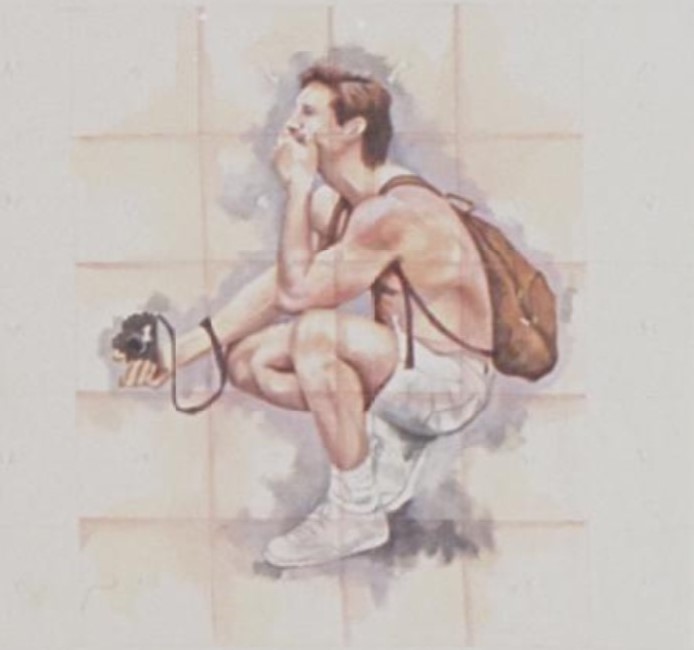
Tom McBride — an actor who appeared in two films, various commercials, soap operas, and TV movies (including a scene with Bette Davis) — dies of AIDS-related illness in New York. He was 42.
Learn More.McBride starred in the 1981 horror film Friday the 13th Part 2 as Mark, and had a role in the 1985 movie Remo Williams: The Adventure Begins. On Broadway, he appeared in the play Fifth of July in 1981-82.
McBride’s masculine good looks and muscled body made him a familiar sight in TV commercials, print ads, billboards, and films through the ’70s and ’80s. He even became that most emblematic of macho images, the Winston man.
He was also a familiar sight in the most exclusive nightclubs and parties in Hollywood and New York City. Handsome and popular, McBride found he had his choice of sexual partners, drugs, and social situations in New York’s gay scene.
In 1994-95, McBride allowed documentarian Jay Corcoran to film and interview him as his health started to decline from HIV. McBride had taken up photography, and some scenes show him opening packages of recently processed photos of nude subjects and presenting them to his mother.
After McBride’s death, Corcoran released Life & Death on the A-List, a film that featured McBride’s candid views on sex and HIV/AIDS. Corcoran’s film took an unsparing look at McBride as his good looks deteriorated and his health diminished until he was ultimately confined to a hospital bed in his mother’s home.
Peter Galvin wrote in The Advocate that Corcoran’s film portrait of McBride was one-dimensional and the film’s message was bleak.
“We never get the sense that McBride was any more than just another pretty face shilling for laundry detergent,” Galvin wrote.
And yet it is impossible to deny the emotional force of moments when McBride speaks with utter openness and authenticity to his documentarian and asks questions like “What happened to my career?”
* * * * * * * *
Photo of quilt panel from the AIDS Memorial Quilt
Kenneth Craig Innes, aka K. Craig Innes, who achieved stardom as a Broadway dancer, dance teacher and choreographer, dies of AIDS-related illness in San Francisco at the age of 35.
Learn More.Innes, a native of San Francisco, performed in more than a dozen Broadway and off-Broadway shows, including Cabaret, Carousel and Hello Dolly.
Born in San Francisco and raised in the peninsula town of Redwood City, Innes was a precocious dance student, according to his mother Shirley Gurnett. He had his first taste of theater at the age of 7 as a child extra in a touring company rendition of Carousel with John Riatt.
Innes attended Whitman College in Washington State as a theater major, and moved to Los Angeles to start his career. There, he met his partner, Jimmy Barron in 1978. Innes and Barron were together 14 years until Barron passed away from HIV/AIDS complications in 1992.
Innes performed mostly on and off Broadway in New York productions that included La Cage aux Folles, Me and My Girl, Legs Diamond and Meet Me in St. Louis, where he was also dance captain. He toured nationally with Dream Street as Charlie.
On television, he was a dancer on the TV show Fame and the made-for-TV movie The Mae West Story (1985). He was also a “Steve Merritt Dancer” and danced in several productions by choreographer Tony Stevens.
Innes’s last performance was just a few weeks before his death. Innes wrote, produced, directed and choreographed Saturation, an autobiographical music and dance show performed as an AIDS benefit at the San Francisco Jewish Community Center, according to SFGATE.
The project Dancers We Lost: Honoring Performers Lost to HIV/AIDS includes a tribute to Innes.

Paul Delph, former the keyboardist/vocalist for the Los Angeles-based band Zoo Drive, dies of AIDS-related illness at his parents’ home in Cincinnati at the age of 39.
Learn More.Delph was a Los Angeles-based singer, songwriter, producer, engineer, and studio musician whose catalog includes work with many well-known recording artists, including Bryan Adams, Sam Harris, The Pointer Sisters, Donna Summer, The Weather Girls, Suzi Quatro, Bernie Taupin, Toni Basil, Alice Cooper, Roberta Flack and Gary Wright.
In 1980, Delph left the Cincinnati College Conservatory of Music to jump into the LA music scene to perform with the band Zoo Drive. For the seven years that the band performed and toured, it also provided the rhythm section for many recording artists. The best known of these projects was the Word of Mouth album by Toni Basil (1982), which featured the song “Mickey” with Delph on Farfisa organ.
In 1990, Delph provided the vocals for two tracks on the re-release of the Bloodsport soundtrack, and he was nominated for a Grammy for his work.
Although Delph contracted HIV early in the epidemic, it did not impact his productive life for nearly a decade. He continued to work on his Music for AIDS projects until failing health forced a return to his family home at Cincinnati early in 1996.
In 1996, Delph released his final album, A God That Can Dance, privately to his family and friends shortly before his death. The album drew its title from a quote by Friedrich Nietzsche (“I would believe only in a God that knows how to dance”), and chronicled the Delph’s struggle with HIV/AIDS.
From 1998 to 2018, Delph’s friends teamed up to form Team Delph in Cincinnati’s annual Walk to Stop AIDS, raising tens of thousands of dollars for Caracole, the city’s largest AIDS service organization. In 1997, the Delph family established the Paul Delph Memorial Scholarship at Delph’s alma mater, Norwood High School.
* * * * * * * *
Photo of quilt panel from the AIDS Memorial Quilt
Under the leadership of Hernando Cortez, the organization Dancers Responding to AIDS starts holding the dance festival “Dancers from the Heart,” which would become an annual event to raise funds for the AIDS cause.
Learn More.Until then, Dancers Responding to AIDS (DRA) had been producing its benefit performances in various places along the East Coast, including Saratoga Springs, SUNY Purchase, Martha’s Vineyard, and Washington DC, according to the Fire Island Pines Historical Preservation Society.
Hernando Cortez and Denise Roberts Hurlin, both dancers with the Paul Taylor Dance Company, founded DRA in 1991, because members of the dance community did not have an AIDS service organization like the music and entertainment (LifeBeat) and design (DIFFA) industries did. Once established, not only did DRA provide direct financial assistance and other services to all dance professionals with HIV/AIDS, but they extended its services to dance companies’ adminstrative personnel, stage crew members and domestic partners with HIV or AIDS.
At the 1991 NYC Pride Parade, Cortez met Rodger McFarlane, executive director of Broadway Cares/Equity Fights AIDS. McFarlane presuaded Cortez to move DRA under the umbrella of BC/EFA, and the association has been a mutually productive one over the years.
By 1995, Cortez had been frequenting the Pines for years and saw the location a potentially good one for a DRA benefit. Jack Schlegel agreed and offered to co-produce an event at The Pines. The first festival raised almost $8,000, and it continues as an annual event today.
Born in Manila, Philippines, Cortez spent his early years in British Columbia, where he began his dance training at Vancouver’s Pacific Ballet Theatre and then graduated from Purchase College Conservatory of Dance in 1985. He was invited to join the Paul Taylor Dance Company in 1987.
Cortez was featured in two PBS “Dance in America” specials, and his own choreography was showcased in the Taylor Company’s critically acclaimed hit Funny Papers. He performed with Mikhail Baryshnikov’s White Oak Dance Project in their 1998 national tour. As a choreographer, Cortez has created dances for the American Ballet Theatre, the Williamstown Theater Festival, and the Sands Hotel in Atlantic City.

Christopher Boatwright, an international star in the dance world, dies of AIDS-related illness at the Laguna Honda Hospital in San Francisco. He was 42 years old.
[photo by dancerswelost.org]
Learn More.Known for his elegant classicism, Boatwright was considered one of the finest dancers of his generation. According to New York Times dance critic Jennifer Dunning, Boatwright was one of the few Black American ballet dancers to achieve international recognition in the 1970s and 1980s.
“Across his career, Boatwright was recognized wherever he danced for his resplendent, versatile technique; the clarity, nobility, and lyricism of his dancing; and the warmth of his stage presence,” according to Dancers We Lost: Honoring Performers Lost to HIV/AIDS.
”With his long-legged, sustained line, Mr. Boatwright offers a nobility that was, on this occasion, humanized by a certain grace,” Anna Kisselgoff wrote in The New York Times in a 1979 review of his performance as Romeo in the Stuttgart production of John Cranko’s Romeo and Juliet. ”One remembers the moment in the balcony pas de deux when he arched his back deeply as an expression of feeling.”
Born and raised in Brooklyn, Boatwright trained at the schools of Merce Cunningham and American Ballet Theater and at the Alvin Ailey American Dance Center. He left the U.S. to study and perform at the Stuttgart in Germany after seeing the company’s 1973 production of Eugene Onegin at the Metropolitan Opera House in New York. While with the Stuttgart, Boatwright performed ballets traditionally off limits to Black artists in America at that time, including Swan Lake, Sleeping Beauty, and Jeu de Cartes.
“When we went to Washington, DC, the theater didn’t want me to perform the role with a white ballerina,” Boatwright said in a 1996 interview with Dance Magazine. “They said they’d only present a Black Romeo with a Black Juliet. But the company put me on anyway.”
In the mid-1980s, he returned to the U.S. and performed with the Los Angeles Ballet and Jean-Paul Comelin’s Arizona Dance Theater. Then he moved to San Francisco and danced with the Alonzo King Lines Ballet Company for a year before joining the San Francisco Ballet, where he performed works by Frederick Ashton, Paul Taylor, and the company director, Helgi Tomasson. When he injured his hip, Boatwright taught dance until he recovered, and then he rejoined Lines in 1993.
His final performance was in June 1996, when he danced with Lines in New York City.
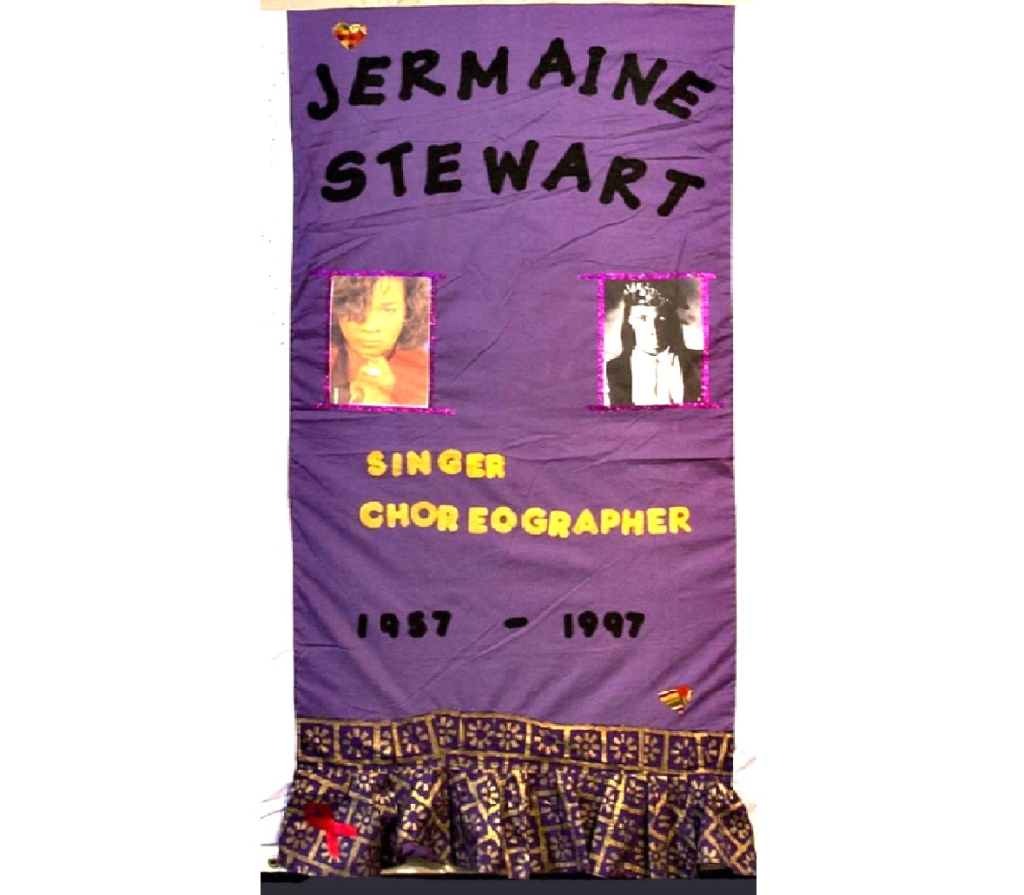
Jermaine Stewart — best known for his 1986 hit single “We Don’t Have to Take Our Clothes Off” — dies of AIDS-related illness in the Chicago suburb of Homewood at the age of 39.
Learn More.Stewart started his entertainment career as a dancer on both American Bandstand and Soul Train, the latter of which was televised from his hometown of Chicago. In the early 1980s, he and his long-time friend Jody Watley moved to London to pursue singing careers. He landed a gig as a back-up singer for the pop band Culture Club while Watley (who had left the R&B group Shalamar) began recording with multiple musicians.
After contributing vocals to Culture Club’s 1983 hit album Colour by Numbers. Stewart received help from band member Mikey Craig which led to a recording deal with Arista Records.
In 1984, Stewart released his debut album and single of the same name, The Word is Out. He released his second album, Frantic Romantic, in 1986, led by the hit single, “We Don’t Have To Take Our Clothes Off.” It went platinum quickly and was followed up by second single, “Jody,” inspired by his friend Watley (who was about to experience her own commercial breakthrough).
“Jermaine Stewart had this voice that could break you down and build you back up at the same time,” singer-songwriter Morgxn wrote in 2017 for Billboard. “He made me feel his heart, and made me feel that I was okay in being myself.”
Stewart’s follow-up singles did not rise to the success of “Clothes,” but his album Say It Again gave him a comeback in England in 1988. The album’s title track reached the R&B Top 10 in the UK. According to a tribute to Stewart on Lee Bailey’s EurWeb, this would be his last major hit before leaving the music scene in 1991.
Stewart was working on new material when he succumbed to AIDS-related liver cancer on March 17, 1997. His burial site was left unmarked for over 17 years until 2014, when a fan anonymously paid for a gravestone, according to a tribute to Stewart on Gran Varones.
“We Don’t Have To Take Our Clothes Off” saw a revival in the UK in 2011 when it was featured in a prominent commercial, causing a new generation of fans to download Stewart’s singles. The track has also been sampled for dance hits throughout the 2000s, according to the music fan site TalkAboutPopMusic.

Fearful that he had the virus that causes AIDS and determined to exact revenge, Andrew Cunanan bludgeons to death 28-year-old Jeffrey Trail, a manager for a propane delivery company, after stalking his victim in Bloomington, Minnesota.
Learn More.Cunanan, a 27-year-old fixture of the San Diego nightclub scene, would murder four more people in the next three months and then end his own life with a gunshot to the head eight days after killing his fifth victim, world-famous designer Gianni Versace. An autopsy would show that Cunanan did not have HIV.
Earlier in the year, Cunanan became convinced by lingering illnesses that he was HIV-positive. He told an HIV counselor, Mike Dudley, that he was afraid he was infected, according to Andrea Cipriano in The Crime Sheet. This was after years of a party lifestyle that included seeking out older, rich men under the assumed name of Andrew DeSilva, according to Cipriano.
“It was 1997 — probably a year and a half, maybe two years out from when they had figured out the correct medication to give to patients with HIV,” wrote Julie Miller and Joanna Robinson in January 2018 for Vanity Fair magazine. “That transition was so intense to those who had it, and to those around the people who had it, because for 15 years, you were watching people die from this disease there didn’t seem to be a cure for.”
In April 1997, Cunanan left San Diego for Minneapolis, Minnesota, where Trail, a former acquaintance, and 33-year-old architect David Madson, an ex-boyfriend, both lived.
After stalking the two, Cunanan lured Trail to Madson’s apartment and beat him to death with a hammer. He took Madson hostage for two days, and then killed him, shooting him twice with a gun he stole from Trail’s apartment.
On May 4, Cunanan took Madson’s car and drove to Chicago. There, he entered the home of Lee Miglin, a 72-year-old real estate developer and millionaire, and killed him. After binding Miglin with duct tape, Cunanan stabbed him 20 times with a screwdriver and severed his throat with a hacksaw, according to Emma Dibdin’s 2018 account of Cunanan’s murders in Bazaar magazine.
After leaving Madson’s red Jeep for Miglin’s green Lexus, Cunanan fled Chicago and headed east. After driving more than 13 hours, Cunanan arrived in New Jersey, where he came upon his fourth victim, William Reese, the 45-year-old caretaker of Finn’s Point National Cemetery.
After Reese’s wife Rebecca came to the cemetery looking for her missing husband and found his office door ajar, she called the police. Officers found Reese’s body in the basement of the building, a single 40-mm bullet in his head.
By now, law enforcement officials were able to connect the Minneapolis murders to the murder of Miglin in Chicago, and had identified Cunanan as a suspect. After locating Miglin’s Lexus in New Jersey, officials released a multi-state bulletin for Cunanan’s arrest on suspicion of multiple murders.
Local police in New Jersey speculated that Cunanan killed Reese for his red Chevy pickup truck, which was far less conspicuous than the Lexus, according to the New York Daily News.
Cunanan drove Reese’s truck south and when he reached Miami Beach, he checked into an inexpensive hotel. By this time, the FBI had put Cunanan on its “Ten Most Wanted List,” making him the subject of a nationwide manhunt.
On July 15, 1997, Cunanan carried out his final act of murder as designer Gianni Versace was on the front stairway of his Miami Beach home, having just retrieved his morning newspaper. Cunanan shot Versace twice, killing him instantly.
A bystander attempted to chase Cunanan as he fled the scene, but was unable to catch him, according to Miami Beach police. Abandoned nearby were the red truck, the clothing Cunanan shed following the shooting, and newspaper articles about his murder spree.
Cunanan broke into a houseboat and was able to hide there for several days. But on July 24, law enforcement closed in. As police prepared to storm the houseboat, Cunanan took the same gun he used to kill Madson, Reese and Versace, and committed suicide.
For weeks afterward, the media covered the story with sensational details, often with speculation about the HIV status of Cunanan and his victims. Ultimately, a Miami Beach coroner’s report revealed that Cunanan did not have HIV.
But the crime story lived on, first in lengthy magazine articles and then a 1999 book by Maureen Orth, who had covered Cunanan’s murder spree for Vanity Fair magazine. In January 2018, the subject of Cunanan and his murders resurfaced in American Crime Story: The Assassination of Gianni Versace, a nine-episode series broadcast on FX.
The TV series was based on Orth’s book Vulgar Favors: Andrew Cunanan, Gianni Versace, and the Largest Failed Manhunt in U.S. History. Orth’s book had claimed that Versace was HIV-positive, and likewise, the series depicted Versace as someone with a serious illness, although the word “HIV” was never specifically used.
Prior to its release, the Versace family lambasted the series and challenged its truthfulness. Executive producer Ryan Murphy defended the project on Vanity Fair’s “Still Watching: Versace” podcast, saying he felt it was necessary to include scenes about Versace’s illness in the storyline.
“I think it’s moving and powerful, and I don’t think there should be any shame associated with HIV,” Murphy said
The series — which starred Édgar Ramírez, Darren Criss, Ricky Martin, Penélope Cruz, and Judith Light — premiered to 5.5 million viewers, making it one of cable’s highest-rated series debuts.

Musician and activist Fela Kuti, a pioneer of Afrobeat music who was repeatedly arrested and beaten for writing lyrics that questioned the Nigerian government, dies of AIDS-related illness at the age of 58.
Learn More.Kuti was meant to be a doctor, an upstanding member of Nigeria’s elite like his parents, according to The Guardian. At age 20, he studied pre-med in England, where his first cousin, playwright Wole Soyinka, was already making a name for himself.
“Instead, Fela Ransome-Kuti became infamous, an outlaw musician who declared himself president of his own ‘Kalakuta Republic,’ a sprawling compound in the suburbs of Lagos that housed his recording studio and offered sanctuary to the dispossessed,” writes Neil Spencer of The Guardian.
Rebelling against oppressive regimes through his music would come with a heavy cost for Kuti. Over his lifetime, he would be arrested 200 times and endure numerous beatings from government officials.
In the 1970s and ’80s, Kuti’s subversive song lyrics established him as political dissident, resulting in Afrobeat to be associated with making political, social and cultural statements about greed and corruption. One of Kuti’s most popular songs, “Zombie,” questions Nigerian soldiers’ blind obedience to carrying out orders. Another, “V.I.P. (Vagabonds in Power),” seeks to empower the disenfranchised masses to rise up against the government.
At his club, the Shrine, his band played until dawn while dozens of singers and dancers writhed and glittered amid drifts of igbo smoke. Here, Nigeria’s corrupt dictators were denounced and ancient Yoruban deities honoured, all to a relentless backdrop of the “Afrobeat” that Fela had distilled from the musical collision of Africa and black America.
At his death from AIDS-related illiness in Lagos, Nigeria, Fela would leave behind seven children, 50-odd albums and a musical legacy that has been kept alive by his sons and former drummer, Tony Allen
Roughly 1 million people would attend his funeral procession, which began at Tafawa Balewa Square and ended at Kuti’s home, Kalakuta, in Ikeja, Nigeria, where he is laid to rest in the front yard. Belatedly, Afrobeat would become a cause célèbre among young European and American music fans.
* * * * * * * *
Photo of quilt panel from the AIDS Memorial Quilt
Douglas Hevenor, a former dancer with Joffrey Ballet, National Ballet of Washington and California Ballet of San Diego, dies of AIDS-related illness at the age of 48.
Learn More.A resident of the East Bay, Hevenor was honored the world over for his stunning technique, receiving awards at the International Ballet Competition in Varna, Bulgaria — the first American so honored — and the World Ballet Concours in Tokyo.
Hevenor was lauded for his performances in The Nutcracker (1987) and Giselle (1983) with the California Ballet. When dancing with the Washington Ballet, he was featured on Music in Motion, a half-hour documentary broadcast on Washington DC local television about Choo San Goh, the company’s resident choreographer. In the documentary, Hevenor is seen in the dances “Lament” and “Birds in Paradise.”
He also performed with the Oakland Ballet and the Leggz Dance Academy.
Hevenor is memorialized in the project Dancers We Lost: Honoring Performers Lost to HIV/AIDS.
Murray Salem, screenwriter of the 1990 Arnold Schwarzenegger film Kindergarten Cop, dies of AIDS-related illness at the age of 47.
Learn More.With ambitions to become an actor, Salem moved from his hometown in Ohio to attend the Drama Studio London in England, staying in the bathroom of a shared apartment to save money. In 1972, he joined the Glasgow Citizen’s Company, winning one of five slots among a pool of 300 actors.
Salem remained with the Scottish troupe for two years, performing in productions like Eva Peron and Arden of Feversham. He received critical praise from the Financial Times as a “large and graceful man who, astonishingly, emits both the sultry masculinity of a Joe Dallesandro and the petulant transvestism of another Warhol star, Holly Woodlawn,” for his turn as Eva Peron. From 1975-1977, he acted with the New Shakespeare Company in London where he played roles in A Midsummer Night’s Dream, Othello, and Love’s Labour Lost, before his connections led him to the film world of London.
Salem started his film career in British exploitation movies, with a small part as a “heavy” in the sexploitation classic Let’s Get Laid (1979) and a larger supporting role in Hussy (1980), a gritty tale of a prostitute in 1970s London starring Helen Mirren. In the latter, Salem plays a scheming drug runner with an ebullience that provides much needed color and energy to a generally depressing and grinding film. His character is introduced in a crowded bar where he bounds onto the dance floor and commands the attention of the entire audience with over-the-top humor.
“He single-handedly jolts the production to life in its third act,” wrote film critic David J. Gary in Scene.
After moving to Los Angeles in the mid-1970s, he performed in film and television productions, including the miniseries Jesus of Nazareth (1977), Holocaust (1978), and Riding High (1981), a film built around a motorcycle stunt competition. His dreams of landing a leading-man role began to wane as he was repeatedly cast in roles as Middle Eastern villains. He turned to screenwriting, which ultimately provided him with more financial stability than acting. Over the course of 15 years, he wrote nine screenplays and sold all except one. His scripts ranged in topics from teenagers in prison to a father-son story about Central American refugees during the Sanctuary Movement of the 1980s. Kindergarten Cop, which he wrote in 1988-1989, was his only script that advanced to production.
Salem continued to write scripts and take studio writing gigs after testing positive for HIV in the mid-1980s. Aware that many didn’t have the financial stability and resources that he had, he became a resource to others by publicizing information on pill exchanges to help others who did not have access to HIV medication. He also became a leader at the Hay Rides, which were large gatherings in West Hollywood of people living with HIV and AIDS organized by new age spiritual leader Louise Hay.
“Murray … worked to get that information out and attended weekly meetings in rec halls and prayer groups and told people about pill exchanges and medicine exchanges and talked about what worked and what didn’t,” his brother David recalled. “He was networking all of that and he fought the fight until his last breath.”
Before he died, Salem composed a series of letters to his young niece and nephew with instructions to open one each year from 1998-2015. Each letter included a video cassette of a film he wanted them to watch so they could understand his love of cinema. Through their late uncle, they learned to appreciate the art of film by watching classics like Funny Girl, Sound of Music, Some Like it Hot, Cabaret, Ghost, Ben Hur, West Side Story, Breakfast at Tiffany’s, Citizen Kane, The Godfather, Dr. Zhivago, Silence of the Lambs, Casablanca, Lawrence of Arabia, and Camille.
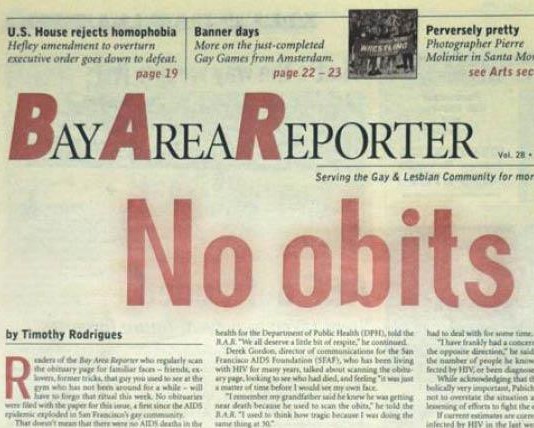
After more than 17 years of covering the AIDS crisis and some weeks with as many as 31 obituaries, San Francisco’s gay weekly newspaper Bay Area Reporter runs the following headline on its front page: “No obits.”
Learn More.“It seems a new reality may be taking hold, and the community may be on the verge of a new era of the epidemic,” wrote Timothy Rodrigues in the BAR‘s front-page article. “Perhaps.”
Derek Gordon, director of communications for the San Francisco AIDS Foundation, said the recent decrease in the number of obituaries reflected a parallel trend in his personal experience. The introduction of new anti-HIV drug regimens have been successful in reducing the number of AIDS deaths.
“I don’t have any obits to personally tell,” Gordon told the BAR.
But Gordon cautioned that the epidemic is not over.
Dick Pabich, AIDS policy advisor to Mayor Willie Brown, told the BAR that the lack of obituaries was symbolically very important, but that the fight to end the epidemic needed to continue full force.
Pabich cited recent statistics that suggested that 10 people in San Francisco were being infected by HIV each week, and that an estimated 15,000 people living in the city were HIV-positive.
“The folks who are dying are not necessarily BAR readers,” said Guy Vandenberg, director of external programs at Continuum HIV Day Services.
Vandenberg told the BAR reporter about the death of a Continuum client who died alone, sitting in a chair in his hotel room in the Tenderloin district. “He had no one to write his obituary,” he said.
BAR was quick to begin covering the AIDS crisis in the early 1980s, and would print notices of people dying from AIDS-related illness that were often submitted by friends, partners and family members of the diseased. Media outlets worldwide covered news of BAR‘s “No Obits” issue, which marked the first time the newspaper received no death notices in a given week since the start of the epidemic.
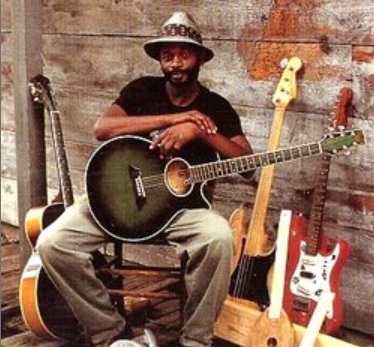
Lonnie Pitchford, a Mississippi blues musician who played guitar and the diddley bow, dies of AIDS-related illness at his Lexington home in Holmes County. He was 43.
Learn More.Pitchford was largely a self-taught musician, starting at the age of 5 with a single-stringed instrument called the diddley bow that he made himself. He progressed to other instruments, including piano and a guitar that he shared with four brothers. But he never left the diddley bow behind, and he explored ways to bring out new and complex sounds from the seemingly simple instrument.
When he was 16, Pitchford met folklorist and civil rights worker Worth Long, who taught him the importance of music and blues in Black American history. This was around the time that Long was introducing Black folklore and music to the Smithsonian American History Museum, creating a space for a history that had been long distorted and neglected.
The next year, Pitchford travelled to Washington, D.C. to play at the 1973 National Folk Festival and the Smithsonian Folk Life Festival, and he astounded audiences with his ability to play the material of the legendary bluesman Robert Johnson. And when Pitchford pulled out his diddley bow and created old-world blues sounds from one taut string and a shiny dime, audiences couldn’t believe their ears. He was 17 years old.
He sought out lessons to improve his technique, and was mentored by Eugene Powell, an old Mississippi bluesman who sometimes recorded under the name Sonny Boy Nelson. Robert Junior Lockwood, whose stepfather was Robert Johnson, also helped Pitchford learn more about replicating Johnson’s style.
For a while, Pitchford performed at major blues gatherings around the South with Lockwood and another blues legend, Johnny Shines. But then Pitchford always returned home to resume work as a carpenter. According to Richard Skelly of AllMusic, Pitchford wasn’t often booked for tours, because he didn’t have any solo recordings.
“He was able to make occasional road trips to Memphis and other cities where his music was appreciated,” writes Skelly. “He divided his time between road trips to play blues and working as a carpenter. Pitchford was voted as one of Living Blues magazine’s ‘top 40 under 40’ new blues players to watch.”
Pitchford appeared in documentaries about the blues, including ‘The Land Where the Blues Began‘ (1980), and he was recorded for five blues anthologies, according to New York Times music critic Jon Pareles. He also made an album with the New Africa String Band, which included blues greats Eugene Powell and Big Jack Johnson.
Pitchford’s wife, Minnie, said he liked to play for members of the Lexington community where he lived, often giving impromptu concerts in cafes and at the park.
In 1994, when he was almost 40 years old, he recorded his one and only solo album, All Around Man, for Rooster Blues Records. On the cover, Pitchford is pictured with various guitars (electric, acoustic, one-string).
“That CD included songs he had learned from Robert Johnson’s protégé Robert Jr. Lockwood, as well as a previously unrecorded track that Lonnie’s mother-in-law had learned from her friend, the late slide guitar master Elmore James,” Jim O’Neal wrote in 1998 in Delta Boogie.
Shortly after All Around Man was released, Grammy-winning rock musician John Mellencamp invited Pitchford to his studio in Belmont, Indiana to play the slide guitar on one of the tracks for his 14th album, Mr. Happy Go Lucky (1996).
Mellencamp later told the Associated Press of his concept for the album: “When we started making this record, I thought I’d marry the rhythm of Black music of the ’90s, which is rap, and the sounds of Black blues music of the ’30s and ’40s. We’d have Robert Johnson-type guitar licks playing with this rap rhythm underneath it. It didn’t always work out that way, but that’s the place we started from.”
In late 1997, Pitchford began working on a second album for Rooster Blues, but as his health began to decline, he was unable to continue, according to Delta Boogie writer Jim O’Neal.
O’Neal said that a few months before Pitchford died, he had the opportunity to play a slide guitar that had belonged to Elmore James (1918-1963).
Pitchford’s grave is located near the grave of Elmore James at the cemetery of the New Part Baptist Church in Homes County, Mississippi. A diddley bow is featured on the headstone, which was paid for by Southern rocker John Fogerty (whose brother Tom died of AIDS-related illness in 1990) and Rooster Blues Records.
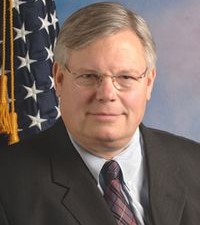
Thomas K. Duane is elected to New York’s State Senate and becomes first openly-gay and first openly HIV-positive member of the Senate.
Learn More.In his inaugural remarks, Sen. Duane promised he would work to expand the Medicaid program to meet more fully the needs of low-income New Yorkers. He also intended to expand both public and private healthcare benefits so that they would include provisions for mental health services and the treatment of drug and alcohol addiction.
The new senator was entering office at a time when the NY Senate was dominated by conservative Republicans from rural areas of the state and was led by Senator Joe Bruno, a notoriously anti-LGBTQ social conservative.
“Duane’s record of activism, however, in and out of public office, holds out hope for a larger impact than we might expect from a single legislator, and a lowly freshman at that,” wrote Laura Engle in her February 1999 column for The Body.
Sen. Duane would go on to serve multiple terms, and would be a pivotal figure during the 2011 battle over same-sex marriage in New York State.
Highlights of his time in the Senate would include closing loopholes for people trying to avoid child- and spousal-support payments, requiring health insurance plans to cover treatment for mental illness, and adding sexual orientation to the list of protected categories in state laws. He would also garner a reputation as a fierce advocate for tenants’ and civil rights.
Duane began his political career as a staffer for the New York City Comptroller. In 1991, he ran for City Council and won a contentious race after disclosing his HIV-positive status. In 1994, Duane ran for Congress but lost to Jerry Nadler.
Duane’s senatorial district included the Upper West Side, Chelsea, Hell’s Kitchen, Greenwich Village, and parts of the East Side, including the East Village, Stuyvesant Town and Peter Cooper Village and Waterside Plaza.
Source:
The Body, February 28, 1999, “State Senator Tom Duane”
New York Times, June 3, 2012, “Champion of Gay Rights to Leave New York State Senate“
After speaking about her HIV-positive status on Zulu-language radio and television, activist Gugu Dlamini is stoned and stabbed to death by men in her South African community.
Learn More.Dlamini, a volunteer for a local HIV/AIDS organization, disclosed her HIV-positive to raise awareness about the prevalence of the disease in her community in an attempt to curtail its spread. She lived in KwaZulu-Natal (now known as Ntuzuma B), a province just outside the city of Durham, South Africa that at the time had the highest incidence of HIV infection (30% of adult residents).
After Dlamini announced her HIV status in the media, neighbors threatened her and told her to stop disparaging their community. A week before she was murdered, Dlamini was physically attacked by a local man who ordered her to “keep quiet” about her illness.
According to a report in a local newspaper, Dlamini reported the assault to police, but they did not respond. Shortly afterward, a group of men broke into her house and beat her in front of her 12-year-old daughter. She died the next day.
News of Dlamini’s death brought worldwide attention to the level of stigma in South Africa and the world in general for people living with HIV/AIDS.
Twelve years later, Dlamini’s daughter, Mandisa Dlamini, founded the Gugu Dlamini Foundation to maintain the fight against HIV/AIDS and gender-based violence. Mandisa Dlamini also returned to KwaZulu-Natal and turned the house where her mother was murdered into an AIDS museum where “women and girls stigmatized and discriminated can find sense of belonging. “

In Vulgar Favors, Maureen Orth writes that iconic designer Gianni Versace was HIV-positive and, at the time of his 1997 murder, was experiencing a recovery from AIDS-related illnesses.
Learn More.In the wake of the book’s release, members of Versace’s family would deny Orth’s claim. But she would defend her reporting, saying that Paul Scrimshaw, the lead detective of the Miami Beach Police Department, told her on the record that the medical examiner stated on his autopsy report that Versace’s blood tested positive for HIV.
Years later, when Vulgar Favors would become the basis of The Assassination of Gianni Versace, a 2018 TV anthology on FX, Orth would say: “[The claim that Versace was HIV-positive] also goes along with other people who told me that he was very weak at one time and he needed [his partner] Antonio to help him walk, and they came over to his house when he was having breakfast and he had 27 bottles of pills in front of him. Now, does that mean they’re for HIV? But the blood thing from on record from the Miami Beach police, that’s pretty [solid].”
Orth also suggested in her book that stigma wasn’t the only reason Versace might have been reluctant to disclose his HIV status. During that time, the Versace family was considering taking the company public, according to Vanity Fair, and the value of the Versace brand might have declined if it were known that the designer was HIV-positive.
In her book, Orth also revealed that Versace had a history of paying young men for sex, and that Cunanan and Versace had met in San Francisco in 1990.
She theorized that as the most famous person Cunanan had ever met, Versace became his obsession. According to Orth, Versace was someone whose name Cunanan frequently dropped to show acquaintances how connected he was, but also the designer represented the stark contract to Cunanan’s own life, one that included the abandonment of his father and the repeated loss of lovers and friends.
Orth speculated that Versace became Cunanan’s ultimate target because of his wealth, success and accessibility, and killing him would guarantee Cunanan instant fame.

Professional figure-skating champion and AIDS activist Robert Wagenhoffer dies of AIDS-related illness in Torrance, California at the age of 39.
Learn More.Wagenhoffer never won an Olympic medal or a world title, but he was considered one of the most entertaining skaters of his time and a brilliant technician. His performances typically included backflips, cartwheels and other unusual athletic feats.
In the 1981 U.S. Nationals, Wagenhoffer began to draw attention when he won the bronze medal. The following year, he won the silver medal and beat world champion Scott Hamilton in the short program. He became widely respected by his peers for, among other things, practicing quadruple toe loops in the 1970s, ten years before the first one was landed in competition.
“Without question, [Wagenhoffer] left an indelible footprint on the sport and left the ice better than [he] found it,” wrote Ryan Stevens, a former figure skater who created the online skating archive Skate Guard.
In 1982, Wagenhoffer turned pro to join the Ice Capades. He also skated with the Tour of World & Olympic Champions, World Cup Champions on Ice, and Gershwin on Ice. He went on to choreograph the Gershwin production and Brian Boitano’s “Skate Against Hate” network television special.
Wagenhoffer did many benefit performances for shows that raised money to combat AIDS, including “Rock on Ice” in 1993 and “Ice Fantastic” in 1998 and 1999 in Sacramento.
In January 1996, he talked about his sexuality in an interview with Monica Friedlander for Blades on Ice magazine. He spoke about the heartbreak of losing his brother to AIDS in 1992 and then his life partner of six years, Billy Lawe, in 1995.
At Wagenhoffer’s funeral, his longtime friend and former skating partner Linda Allen said:
“I know of so many people that have Robert to thank for their special moments, insights, and inspirations …. There will only be one Robert Wagenhoffer. I am so honored to have such a close friend pass through my life. He is charismatic, unique, non-conforming and completely charming. Orchestrating his programs and the programs of others, serenading us with his effortless dynamic skating. No tension, just the enjoyment of watching grace on ice. But more importantly, he is a confidant and a truly treasured friend. Robert, your charm and character will always stay with me. You’ve made your mark!”

With embroidered flowers inspired by the drawing made by a child who died of AIDS-related illness in 1988, “Ariel the Bear” becomes the newest Beanie Baby to hit the market. Sales of the toy would raise $3.4 million for the Elizabeth Glaser Pediatric AIDS Foundation.
Learn More.Ariel Glaser was the young daughter of Elizabeth and Paul Michael Glaser. Her mother was the exhibit director of the Los Angeles Children’s Museum who became an influential AIDS activist after she and her two children contracted HIV, and her father was a successful television actor (Starsky & Hutch, Ray Donovan).
“Ariel the Bear” arrived in stores with a little poem in tribute to her namesake:
In Memory: 1981-1988
May little children everywhere
Remember that we’ll always care
And Ariel’s dreams will all come true
Because she’ll share them all with you!
Founded in 1986, Ty Inc. was known primarily for its “Beanie Babies” series of bean-bag plush toys, which were widely collected in the late 1980s and 1990s. The toy company created “Ariel” to help raise money for the Elizabeth Glaser Pediatric AIDS Foundation (EGPAF), which was founded in 1989 to eliminate pediatric HIV and AIDS and advocate for the wellbeing of the world’s youngest people living with HIV. Incorporated into EGPAF’s logo is a painting inspired by the artwork that Ariel Glaser enjoyed making.
In 1991, Elizabeth Glaser’s book In the Absence of Angels was published. She died on December 3, 1994, at the age of 47.
Ofra Haza, an Israeli Yemenite Jewish singer, actress and Grammy Award-nominee recording artist, dies of AIDS-related illness at the age of 42.
Learn More.Known in the Western world as the “Israeli Madonna,” Haza was known for combining traditional and commercial music styles, fusing elements of Eastern and Western instrumentation, orchestration and dance-beat. In addition to earning many platinum and gold records, Haza was an influential cultural figure in Israel who helped to popularize Mizrahi culture.
After Haza’s death was announced, Israeli radio stations played non-stop retrospectives of her music. The decision by the Israeli newspaper Haaretz to report the cause of her death as AIDS was controversial in her homeland.
The revelation of Haza’s AIDS-related illness caused surprise among fans, and brought debate about whether the media invaded her privacy by reporting it. Many in the media speculated about how she had acquired the virus, some blaming her husband for infecting her with the disease (her husband contended that she became infected from a blood transfusion received following a miscarriage).
Haza is buried in the Artists section of Yarkon Cemetery in Petah Tikva near Tel Aviv.
Randy Krivonic, a dancer who performed with Dance Spectrum, San Francisco Opera Ballet, and Falcon Dance Theater in San Francisco, dies of AIDS-related illness at the age of 47.
Learn More.After his performing career, Krivonic became a dance writer for several local publications. He also participated in many AIDS fundraisers and contributed generously to groups struggling to bring the HIV/AIDS losses in the dance community to light.
Originally from Cleveland, Ohio, Krivonic Krivonic is memorialized in the project Dancers We Lost: Honoring Performers Lost to HIV/AIDS.
Job Komol, a Cameroon-born footballer training for a Dutch professional football club in the province of Gelderland, tests positive for HIV and his diagnosis is announced to the world by club officials.
Learn More.After officials at Vitesse, the oldest football club in The Netherlands, announce that Komol tested positive for HIV, the Royal Dutch Football Association suspended Komol’s playing license. Komol was the first player in Dutch football to be HIV positive, and this caused a shock. Clubs started routinely testing their players for HIV, and questions arose over whether Komol could transmit the disease to other players.
When research showed that the risk of transmission during the game was less than 0.1%, Komol was granted permission to play again. But Komol’s training regimen was hindered by his HIV treatment and he was unable to regain his standing at the club.
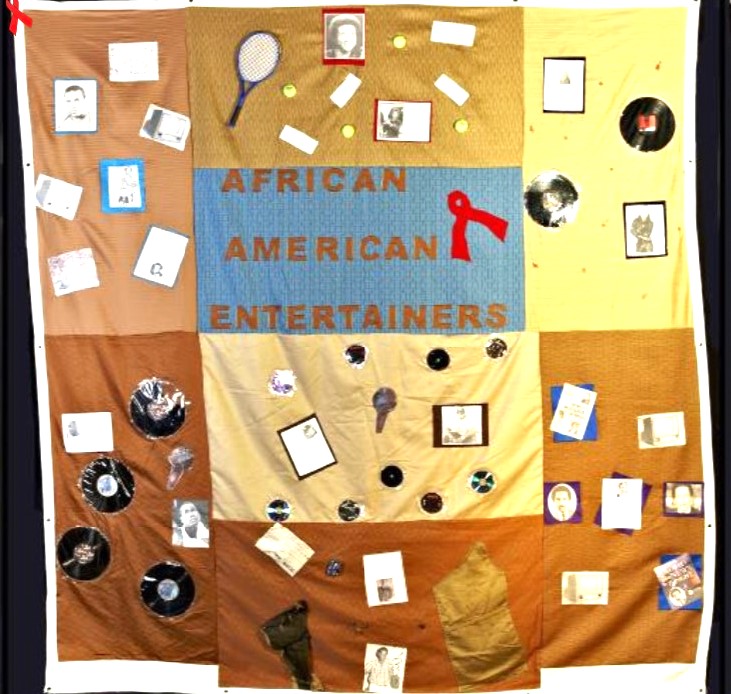
Kenny Greene of the R&B group INTRO dies of AIDS-related illness in New York City at the age of 32.
Learn More.Greene was a the lead vocalist and songwriter for INTRO, an R&B fan favorite from the 1990s. He wrote two early hits for Mary J. Blige – “Reminisce” and “Love No Limit” – which helped to make her a star. He also wrote songs for other artists, including 98 Degrees and Will Smith.
After a short stint in the U.S Army, Greene founded INTRO with friends Jeff Sanders and Clinton “Buddy” Wike, according to lifestyle writer Rah Mosley.
“Kenny managed to leave behind some great music in his short time here on earth, whether it was with his group Intro or working with other artists,” Mosley wrote.
INTRO’s self-titled debut for Atlantic Records dropped in 1993 with the lead single, “Come Inside.” The song climbed to No. 9 on the R&B charts and did well on pop charts, too, according to Edward Bowser in Soul in Stereo.
Two years later, INTRO released their sophomore album, “New Life,” but it failed to replica the success of their first one. Soon after, the group called it quits, and Greene started to make a name for himself as a producer and songwriter.
In a July 2001 interview with Sister 2 Sister magazine, Greene revealed that he was bisexual and that he was diagnosed with AIDS.
“The pressure to be a straight man in the alpha-male world of being a black man and a R&B singer was enormous,” writes music blogger tlewisisdope. “He didn’t want to allow the pressures and hate that goes on toward gay and bisexual men in the R&B world to go on in secret. It was important to him to make sure that people understood that what they see isn’t necessarily who the artist is.”
* * * * * * * *
Photo of quilt panel from the AIDS Memorial Quilt
AIDS activists on the front lines of the epidemic in the 1980s observe that the “hysteria” over post-9/11 anthrax scares is “unsettlingly familiar.”
Learn More.The anthrax scare “carries with it some of the same uncertainties,” but lacks the “sexual stigma” of AIDS, according to Greg Scott, the newly elected president of the People With AIDS Coalition of Broward County, Fla.
In comments to the Miami Herald, Scott recalled the relentless anxiety he felt during the 1980s as many became sick and died.
“I remember the hysteria. I’ve noticed how similar the tone is,” Scott said to the Herald.
The way public health officials failed to muster a confident response to the anthrax threats, giving the public “conflicting or bare-bones” information, was reminiscent of the early days of the AIDS crisis, said Dr. Margaret Fischl, an AIDS researcher at the University of Miami.
Dr. Fischl, who was an early responder to the HIV/AIDS epidemic, told the Herald that public health officials could learn from the AIDS experience.
“Education is how you deal with the fear. Recognizing how (HIV) was transmitted and how it was not transmitted. We would hammer that out with bulletins … I think all of those were progressively important things that helped us with HIV,” she said.
Health officials could use a similar information campaign to help calm the public’s fears about anthrax attacks, said Dr. Fischl.
Soon after the terrorist attacks of 9/11, letters laced with anthrax began appearing in the U.S. mail. Five Americans were killed and 17 were sickened in what became the worst biological attacks in U.S. history, according to the Federal Bureau of Investigation.
In August 2008, Department of Justice and FBI officials were about to bring charges in the case against a suspect, Dr. Bruce Ivins. Before he could be arrested, however, 62-year-old Ivins committed suicide by taking an overdose of pills.
On February 19, 2010, the Justice Department, the FBI, and the U.S. Postal Inspection Service formally concluded the investigation into the 2001 anthrax attacks.
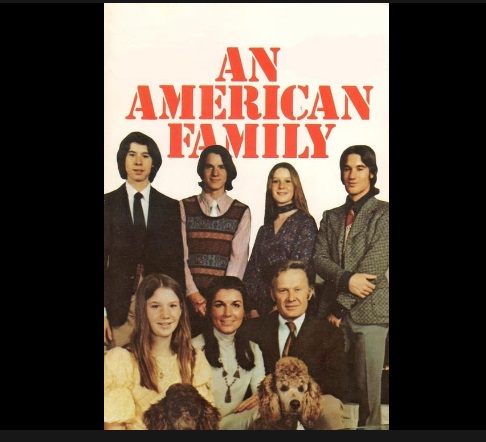
Lance Loud, the eldest son in a family made famous in the 1970s by the groundbreaking cinema vérité series An American Family, dies of hepatitis C and HIV-related illness at the Carl Bean hospice in Los Angeles at the age of 50.
Learn More.On May 30, 1971, the TV documentary An American Family began filming in Santa Barbara, where the Loud family — including then-20-year-old Lance — opened their lives to the world. Considered the first reality TV show, the ground-breaking 12-episode documentary first aired on PBS in January 1973 on Thursday nights at 9:00 p.m.
Lance Loud became a gay icon by coming out to an audience of 10 million TV viewers. His sexual orientation became a topic of national controversy, but the positive feedback from the gay community led Loud to embrace this role with passion and often self-deprecating wit.
Almost 30 years later, Loud asked Alan and Susan Raymond, the Academy Award-winning filmmakers of the original An American Family series, to film a final episode in the Loud story. He was dissatisfied with how An American Family ended, and wanted the public to see the Louds as the family he knew them to be. So the Raymonds filmed Loud and his family as he lived out his final days at the Carl Bean hospice in Los Angeles, and this would become a film, Lance Loud! A Death In An American Family.
Loud was the first reality TV star. Although he was initially vilified by the media, the American public loved him and found him to be an inspiration.
In 1973, Loud moved to New York City and performed with his high school friend Kristian Hoffman in their resurrected band, the Mumps. The Mumps flourished for five years in the New York club scene, regularly selling out clubs such as CBGB and Max’s. The band disbanded in 1980 when it became apparent that record labels weren’t interested.
After the breakup of the Mumps, Loud relocated to Los Angeles and became a magazine writer. Over the next 20 years, he wrote articles for publications including Circus, Interview, American Film, Details, and Vanity Fair. Loud also had a regular column in The Advocate, “Out Loud,” in which he wrote about his role as a gay icon.
In an article Loud wrote for The Advocate shortly before his death, he said, “Though for years I had told myself that all my unbridled drinking, drugging, and unsafe sex were going to lead exactly here, I’d never really believed it.”
Elena Burke, considered one of the best Cuban singers of all time, dies of AIDS-related illness at the age of 74.
Learn More.Burke’s career hit its high point in the 1960s, when she introduced the world to the boleros and romantic ballads of Cuba. In 1964, she performed at the Festival of Song in Viña del Mar, Chile, and closed the Cannes Film Festival with an exuberant performance. She also performed for large audiences in Japan in 1967 and Mexico in 1969.
“She was “sentiment in full voice,” said Omara Poruondo, the female singer of the internationally acclaimed Buena Vista Social Club. “Burke virtually vibrated with the songs of César Portillo de la Luz, José Antonio Méndez, and Isolina Carrillo.”
In 1978 she performed with the Orquesta Aragón at New York’s Lincoln Center to great acclaim. Critics noted that her voice seemed to become stronger with age, and her musical style continued to develop until every song she sang came with an emotional weight, giving her the nickname “Señora Sentimiento” (“Lady Feeling”).
She made her last international tour in 1997.

Herb Ritts, one of the top photographers to emerge from the 1980s, dies in Los Angeles of AIDS-related illness at age 50.
(Photo by Richard Gere)
Learn More.A photographer whose subjects ranged from Madonna to the Dalai Lama, Ritts relied on clean, graphic compositions that often portrayed models and celebrities in the visual language of classical Greek sculpture.
”He shot exquisite, iconic photographs,” said Graydon Carter, the editor of Vanity Fair, a magazine to which Ritts contributed dozens of cover images.
Born in Los Angeles in 1952, Ritts grew up in a prosperous family and graduated in 1975 from Bard College in upstate New York with a degree in economics (he also majored in Art History). He returned to Los Angeles to work for his family’s furniture company but was sidetracked when he started taking photography classes.
In the late 1970s, while waiting for a tire to be changed, he took pictures of a young actor friend who was with him that day. The actor was Richard Gere, and the photographs were ultimately published in various national magazines and served as the catalyst for Ritts’s career as a portraitist.
”His purpose was always to make you look good,” Gere told The New York Times shortly after Ritts’ death. ”He had an extremely elegant aesthetic. Some photographers are working so hard to be elegant that they pummel you with it, but to Herb it came effortlessly.
”Some photographers embalm their subjects, but he enlivened them.”
Listen to Richard Gere tell his story about Herb Ritts.
Unlike many other contemporary commercial photographers, Ritts imposed little of his own sense of artistry onto his pictures. One of Ritts’s most memorable photographs in this vein was a Vanity Fair cover that featured fashion model Cindy Crawford pretending to shave the face of singer K.D. Lang, who was in drag.
Ritts’s work extended beyond celebrity portraiture to fashion photography, artful nudes and the direction of television commercials and music videos. He captured the 1980s era of the supermodel with Amazonian images of Crawford, Christy Turlington and Naomi Campbell.
For a year from 1996, his work was showcased in Boston at the Boston Museum of Fine Arts that was attended by around 250,000 people or more. In 2003, he was given space for a solo exhibition in Japan’s city Kyoto at the Daimaru Museum.
Ritts directed some music videos. In 1989, he directed Cherish by Madonna. Two years later, he received MTV Video Awards for making videos for Chris Isaak and Janet Jackson.
Ritts was committed to HIV/AIDS-related causes and contributed to many charitable organizations, among them amfAR, The Elizabeth Taylor AIDS Foundation , Project Angel Food, Focus on AIDS, APLA, Best Buddies, and Special Olympics. He was also a charter member on the Board of Directors for The Elton John AIDS Foundation.
In December 2002, Ritts was admitted to a Los Angeles hospital with pneumonia. According to Ritts’ publicist, “Herb was HIV-positive, but this particular pneumonia was not PCP (pneumocystis pneumonia), a common opportunistic infection of AIDS. But at the end of the day, his immune system was compromised.”
Prior to his death, Ritts communicated his desire to create a foundation that would carry on his passion for photography and his longstanding charitable support for HIV/AIDS research, advocacy, and care. In 2003, in accordance with his wishes, the Herb Ritts Foundation was established.
Ritts’ photographs continue to be displayed, enjoyed and celebrated across the world. In 2007, Ritts’ photograph, Stephanie, Cindy, Christy, Tatjana, Naomi, Hollywood, 1989, was sold at the Elton John AIDS Foundation Benefit Auction for $190,000. The sale of the photograph set a record price for a Herb Ritts limited edition Silver Gelatin photograph, and raised awareness around the Herb Ritts Foundation’s key role in raising funds for HIV/AIDS research.
In 2011, the Getty Museum acquired from the Herb Ritts Foundation a collection of 69 photographs consisting of nudes, portraits, and images made for high-fashion ad campaigns. The Getty considers this acquisition to be the most significant body of the artist’s work on the West Coast. The museum’s Ritts exhibit in 2012 drew 364,656 visitors.
In 2015, 20 years after The Museum of Fine Arts in Boston showcased the exhibit Herb Ritts: WORK, the museum presented a collection of his major works. Even more recently, Ritts’ images have been incorporated into snowboards and his artwork has been displayed in exhibitions in Berlin, Milan, Seoul, Montreal, Lisbon and London.
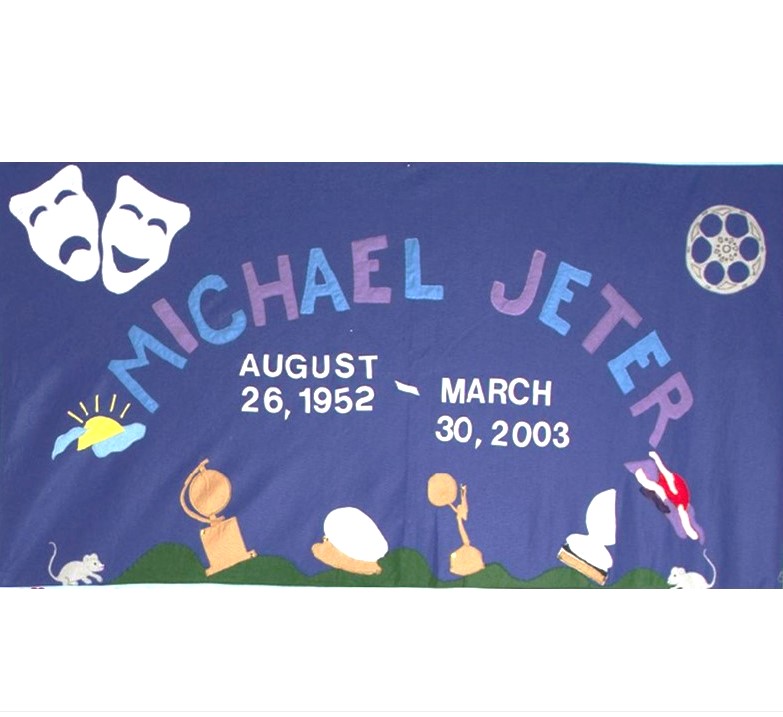
Tony award-winning charactor actor Michael Jeter dies of complications following an epileptic seizure at the age of 50.
Learn More.Michael Jeter was a character actor of film, stage, and television. Much of his work specialized in playing eccentric, pretentious, or wimpy characters, and perhaps his most famous role was that of convicted felon Eduard Delacroix in The Green Mile (1999).
Jeter fared well playing extreme characters, such as in his small but scene-stealing role as a homeless cabaret singer with AIDS in Terry Gilliam’s The Fisher King (1991). He was nominated for another Emmy for playing an eccentric frog breeder in a 1993 episode of the quirky CBS-TV drama Picket Fences — a part written specially for him.
Jeter was born in Lawrenceburg, Tennessee, and landed his first film role in Milos Forman’s Hair in 1979. He had small parts in film and television and was a frequent performer Off Broadway during the early 1980s. He appeared onstage in Alice in Concert and G.R. Point, and in 1982 was a cast replacement in Caryl Churchill’s Cloud 9 at the Lucille Lortel Theater, which was directed by Tommy Tune.
In an emotional TV interview with Jann Carl of Entertainment Tonight in July 1997, Jeter disclosed that he had tested positive for HIV. He remained active in the industry, turning in an acclaimed performance in The Green Mile and joining the cast of the sitcom Evening Shade from 1990 until 1994 and then the long-running PBS children’s series Sesame Street from 2000 until 2003.
After a turn in Jurassic Park III (2001), Jeter had a notable supporting turn as one of the loveable losers hoping for a big heist in Welcome to Colinwood (2002) and was tapped by director-star Kevin Costner to appear in the Western Open Range (2003).
In 1998, Jeter performed in a benefit reading of The Boys in the Band, bringing down the house in the role of Emory, the lonely, mischievous, heartbroken man that delights in taunting.
Around the time of that performance, Jeter told POZ magazine that he was infected with the AIDS virus in 1995, a year in which he was “so depressed” that he found himself dating a series of Hollywood parasites and stargazers.
Just before his death, Jeter had completed his work on Robert Zemeckis’ film The Polar Express, starring Tom Hanks. The filming was suspended for a day upon word of Jeter’s death.
He had been in good health for many years, according to his partner Sean Blue, who said Jeter’s death was due to complications following an epileptic seizure.
* * * * * * * *
Photo of quilt panel from the AIDS Memorial Quilt
Ghanaian keyboard Kiki Djan dies of AIDS-related illness and drug-related complications at the age of 47. He is found dead in a church bathroom, with the equivalent of 70 cents in his pocket.
Learn More.Djan, also known as Kiki Gyan, performed on the keyboards for the 1970s Afro-rock group Osibisa and also recorded a series of disco records as a solo artist. A prodigy who started playing the piano at the age of five, he joined the UK-based Osibisa at the age of 15. He travelled internationally with the band during the 1970s, playing to large audiences around the world.
By the age of 18, Djan had made more than a million dollars, performed for the Queen of England, and partied with Elton John and Mick Jagger, according to BBC News. He also met Marvin Gaye, Peter Tosh and Steve Wonder during the FESTAC event in Nigeria.
In 1979, he left Osibisa to pursue a solo career and recorded the popular single “24 Hours in a Disco,” which featured a 16-piece orchestra. He was briefly married to the daughter of Afrobeat pioneer Fela Kuti, but then divorced her to marry a Ghanaian woman.
In the early 1980s, Djan became addicted to narcotics and adopted a lifestyle which eventually led to a diagnosis of AIDS in the late 1990s. Djan went in and out of rehabilitation during much of the last six years of his life. Mac Tontoh, who signed him with Osibisa and kept in touch with him throughout the years, told BBC News that Djan had become homeless and begged on street corners.
“I’m sad, not because Kiki’s dead – he was suffering too much,” said Tontoh. “I’m sad because he should’ve died with dignity.”

Andy Bell, the lead singer of English synth-pop duo Erasure, publicly announces that he has been HIV-positive since 1998.
Learn More.“Once you find out you have HIV, it’s like starting from year zero,” Bell said in a 2015 interview with The Guardian. “When I was diagnosed, I was so low that I wasn’t bothered if I was going to live or die. It took a lot to start rebuilding everything.”
Born in 1964, Bell is known for his soulful voice and flamboyant stage persona. An openly gay man, Andy has become an icon within the LGBTQ community for his honesty, compassion and support.
Among his tireless support of various LGBTQ causes, Bell has served as an ambassador for New York’s Hetrick-Martin Institute and is currently a patron of the Cambridge-based charity Dhiverse, and for Above The Stag, London’s only LGBTQ theatre.
For the Red Hot + Blue album (1990) to raise funds for AIDS and HIV research, Bell reinterpreted the Cole Porter song “Too Darn Hot.” The music video for this song featured Bell as a news reporter alongside clips of AIDS activists at ACT UP demonstrations and facts about the epidemic.
More recently, Erasure’s 1988 hit single “A Little Respect” was voted the “Ultimate Pride Anthem” in a poll from radio station Virgin Radio Pride UK, beating out anthems by Xtina, Lady Gaga, Cher, and Madonna.
In 2021, Erasure released the single “Secrets” and an album, The Neon Remixed, which was described as one of the most elevating moments in an otherwise difficult year.
In September of that year, Bell gave the keynote address at The Aging Positively — Reunion Project 6th annual HIV conference, a collaboration between the HIV+ Aging Research Project – Palm Springs, DAP Health (formerly the Desert AIDS Project), and other community partners.
In an interview with DAP Health prior to the conference in Palm Springs, Bell said, “I am so grateful to be alive and be a beneficiary of the cutting-edge science used to create our medications. I salute all of those who passed before us and the brave activists who still fight for us every day.”
Bell currently lives in Miami with his husband, Stephen Moss, and their dog, Angel Baby.
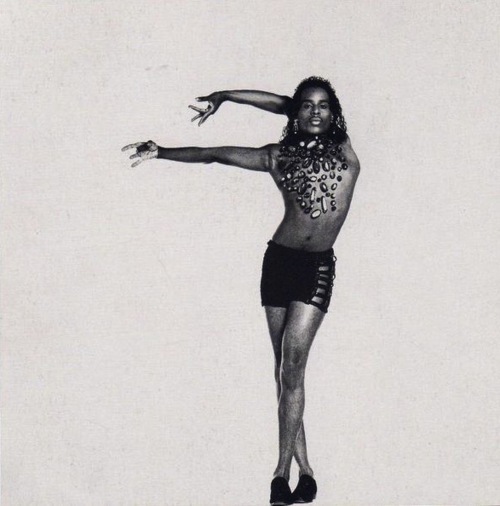
Willi Ninja, famous for his appearance in the documentary film Paris is Burning, dies at New York Hospital Medical Center of Queens of AIDS-related illness at age 45.
Learn More.Considered the Godfather of Vogue and revered for founding the House of Ninja in New York City’s ballroom scene, Ninja influenced both underground and popular culture. Ninja’s dance style emerged from the underground scene to popular culture in 1990 when superstar Madonna incorporated voguing in her hit record and video Vogue.
Ninja was a self-taught performer whose influences included Fred Astaire, Great Performances on PBS, Asian culture and Olympic gymnasts. He rose to prominence in the Harlem Drag Ball scene in the 1980s.
Ninja described himself as “a butch queen,” performing a fluid gender presentation in a scene that celebrated “woman realness,” the ability to pass as biological women. His style showcased his talents and techniques, and reflected his authentic androgynous self.
While Paris DuPree is credited with the invention of the vogue dance style, Ninja was the one who refined it and brought it to a worldwide audience.
At a ball he was judging hosted by the House of Field, Ninja met impresario Malcolm McLaren and soon found himself on McLaren’s tour of European fashion houses. Willi modeled in runway shows for Chanel, Jean Paul Gaultier, Thierry Mugler, Karl Lagerfield.
After taking voguing to Europe and Japan, be trained supermodels like Naomi Campbell and Iman in the art of voguing as well as in other artful displays of grace and poise. His skill was immortalized in the 1990 documentary film Paris Is Burning.
In its review of Paris Is Burning, the New York Times called Ninja “a lithe, articulate young man who also happens to be a master in the art of ‘voguing,’ in which dancers attempt to top each other by using gymnastics and the gestures of high-fashion models.”
Even after achieving fame, he would visit the Christopher Street pier to dazzle onlookers young and old, and teach his dance moves to the next generation of ballroom stars.
Ninja was diagnosed with HIV in 2003. Like most independent artists, he did not have health care.
Ninja outlived many of his co-stars in Paris Is Burning, including Pepper LaBeija, Dorian Corey, Angie Extravaganza, and Avis Pendavis.
Since his death, Ninja continues to inspire artists and music DJs. He is a central figure in LGBTQ studies, gender studies, and performance studies for his nonconforming and transgressive gender expression as an artist. His presence is articulated in the book Black Sexualities by Juan Battle and Sandra L. Barnes.
The House of Ninja continued to perform at drag balls to promote HIV/AIDS awareness in their mother’s name, and currently has more than 200 members worldwide.
Christine Maggiore, an HIV-positive activist who promoted AIDS denialism, dies of AIDS-related illness in her home in Van Nuys, California at the age of 52.
Learn More.At the time of her death, Maggiore was being treated for what was originally reported as pneumonia. The Los Angeles County coroner’s office stated that Maggiore had been treated for pneumonia in the six months prior to her death as well.
A doctor familiar with the family told the Los Angeles Times that anti-HIV drugs could have prevented her death, but Maggiore’s fellow AIDS denialists argued that her pneumonia was not AIDS-related and suggested instead that she died as a result of a toxic alternative medicine “holistic cleanse,” stress, or the cold and flu.
When Maggiore was diagnosed with HIV in 1992, she initially became the ultimate HIV/AIDS advocate — volunteering at HIV/AIDS service organizations and speaking about the risks of HIV at local schools and health fairs.
But then her views took a 180-degree turn after speaking with University of California Berkeley biology professor Peter Duesberg, who erroneously believed that HIV did not cause AIDS. She embraced Duesberg’s theories (which have been debunked), and in 2000, wrote a book called What if Everything You Thought You Knew About AIDS Was Wrong?
Maggoire gave birth at home to two children, and her youngest, Eliza Jane, died in 2005 from what the coroner ruled was AIDS-related pneumonia. Maggiore and her husband Robin Scovill, however, hired a pathologist who concluded that the girl died of an allergic reaction to the antibiotic amoxicillin.
Maggiore told ABC News that she refused to take antiviral drugs during her pregnancies despite substantial evidence that they dramatically reduced the risk of the mother transferring the virus to her child, explaining, “I did not want to expose my growing child to toxins during pregnancy.”
Jay Gordon, a Santa Monica paediatrician who treated Eliza Jane, told The Guardian he regretted not testing for HIV when he examined her for an apparent ear infection 11 days before her death.
After Eliza Jane’s death, Los Angeles police investigated whether Maggiore and Scovill were negligent in not testing their child for HIV. In 2006, the Los Angeles County district attorney’s office declined to file criminal charges against Maggiore, explaining that it was too difficult to prove criminal negligence.
Maggiore’s death certificate states that the cause of death was disseminated herpes virus infection and bilateral pneumonia, with oral candidiasis as a contributing cause, all of which can be related to HIV infection. The death certificate also states there was no autopsy performed.

The fundraising event “Freddie For A Day” is launched by Mercury Phoenix Trust, a nonprofit created in memory of Freddie Mercury by Queen band members Brian May and Roger Taylor with their manager Jim Beach to support the global fight against HIV/AIDS.
[photo courtesy of MPT/Hard Rock Cafe Piccadilly Circus]
Learn More.“Freddie For A Day” celebrates the life of music icon Freddie Mercury by encouraging fans to dress as Freddie on his birthday — September 5 — to raise money for the Mercury Phoenix Trust (MPT).
MPT was started in 1992 to raise money to fight HIV/AIDS worldwide, according to The Guardian. The “Freddie For A Day” initiative was started almost 18 years later to encourage people to raise money for MPT and show them how to use the new online donation platform.
From the donations received, the organization issues grants to programs that focus on HIV/AIDS education and awareness in areas around the world. The projects funded range from educating grandparents looking after their grandchildren orphaned by AIDS in Cambodia, to preventing mother-to-child transmission in South Africa, to HIV awareness theater in Papua New Guinea and educating sexually active youth globally.
MPT donates to some large, well-known charities, but dedicates the greater part of its funding to small, grassroots organizations that are often overlooked.
“We are proud of the fact that more that 93 [pence] in each pound we raise goes to funding projects spread across the globe,” states Mercury Phoenix Trust on its website. “In total, the MPT has funded well over 1,500 projects in 57 countries, giving away over UK$17 million in the global battle against AIDS.”
Since its 2010 launch, the “Freddie For A Day” event has been held every year in England and has grown to include the participation of fans in countries all around the world. Hard Rock Cafes in Europe have partnered with MPT to create “Freddie” festivals at many of their locations.
“Young and old, people have donned a moustache and gone out for drinks, gone to class, gone shopping, taken the train, taken the plane, put on a concert or run a mini-marathon dressed as Freddie,” according to Mercury Phoenix Trust. “Some go the whole hog by wearing full costume for the entire day. Some just decide to support the cause by wearing something yellow or putting on a moustache. The main thing is to have fun, raise awareness and try and get sponsored to raise funds.”

Zelda Rubinstein, the diminutive character actress who used her fame from the 1982 movie Poltergeist to advocate for AIDS awareness, dies of natural causes at Barlow Respiratory Hospital in Los Angeles at the age of 76.
Learn More.“She was one of the very first Hollywood celebrities to speak out on HIV and AIDS,” said Craig E. Thompson, then-executive director of AIDS Project Los Angeles.
“It was the first AIDS education and prevention campaign in Los Angeles and one of the very first in the United States,” added Thompson, who said calls to the HIV/AIDS hotline “skyrocketed after the campaign came out.”
Rubinstein told the Los Angeles Times in 1985 that she was looking for a way to get involved in the fight against AIDS when she was approached to play the mother in the campaign L.A. CARES (Los Angeles Cooperative AIDS Risk-Reduction Education Service), which was launched by the organization now known as the Los Angeles LGBT Center.
In TV spots, she played the mother pleading with an unseen son to “play safely.” In videos that were shown in gay bars, the sons appeared as bare-chested young men. The campaign featuring Rubinstein’s “mother” character also included a series of ads in newspapers and on billboards and buses.
In one ad, Rubinstein is seen wearing an apron and talking to her “son,” who is clad only in shorts and holding an umbrella. At the bottom, it says, “L.A. CARES . . . like a mother.”
In addition to her scene-stealing turns as the psychic Tangina in the Poltergeist horror films, Rubinstein also had roles in the movies Frances, Sixteen Candles, Teen Witch, Anguish and Southland Tales, and the TV series Picket Fences (1992-1996), on which she was a regular.
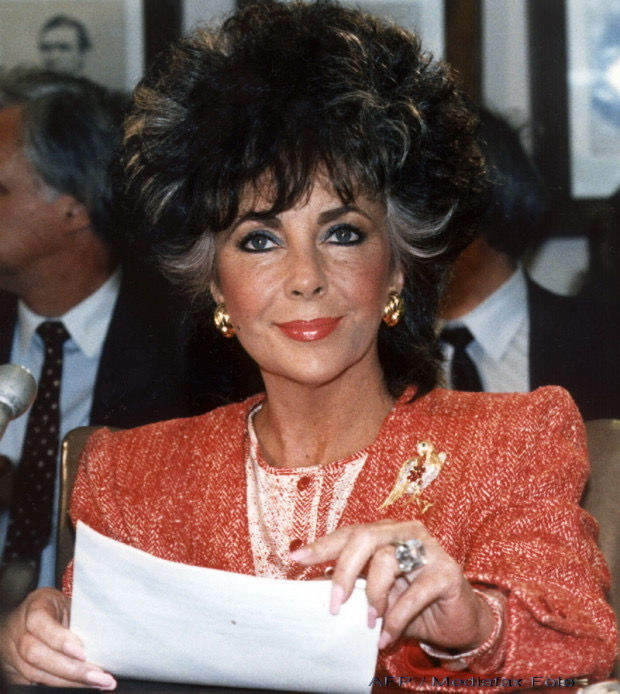
AIDS activist and award-winning actress Elizabeth Taylor dies of congestive heart failure at Cedars-Sinai Medical Center in Los Angeles.
Learn More.In the mid-1980s, Taylor became the most prominent celebrity to back what was then a very unfashionable cause: AIDS research, prevention and care. It started with a 1984 dinner benefit for the nonprofit AIDS Project Los Angeles (APLA), for which she began calling her A-list friends to solicit their support.
“She took this energy that she used to have a career, and she put it into AIDS, for no other reason than her friend [Rock Hudson] had gotten ill,” AIDS activist and comic writer-performer Bruce Vilanch said at a 2021 event hosted by the Foundation for The AIDS Monument. “The reason Elizabeth was so successful was everybody in the world would take her call — even the Pope — if only to discuss jewelry.”
Over the years, Taylor reportedly was responsible for raising more than $270 million and influencing countless elected officials to support the cause.
In 1985, she, along with Dr. Michael Gottlieb and Dr. Mathilde Krim, founded the non-profit American Foundation for AIDS Research (amfAR). Immediately, Taylor began lobbying then-President Ronald Reagan and members of Congress to address the epidemic by allocating funds to research the treatment and prevention of the virus. In 1986, she appeared in amfAR’s first public service TV ads to heighten AIDS awareness and encourage compassion for people with AIDS. Taylor was instrumental in expanding amfAR’s operations to other countries.
In 1991, she founded the Elizabeth Taylor AIDS Foundation (ETAF), a non-profit organization that took a more personal approach to the AIDS epidemic. With ETAF, Taylor sought to advocate for and provide direct care to those who faced the highest levels of stigma, marginalization, and discrimination. Today, ETAF continues to carry forward Taylor’s mission, with heart and hope, until the end of HIV/AIDS.
Taylor testified before the Senate and House for the Ryan White Care Act in 1986, 1990, and 1992. She persuaded President Reagan to acknowledge the disease for the first time in a speech in 1987, and publicly criticized presidents George H.W. Bush and Bill Clinton for not doing enough to combat the disease.
Taylor also founded the Elizabeth Taylor Medical Center to offer free HIV/AIDS testing and care at the Whitman-Walker Clinic in Washington, DC, and the Elizabeth Taylor Endowment Fund for the UCLA Clinical AIDS Research and Education Center in Los Angeles.
For her advocacy work, Taylor was honored with several awards; she was made a Knight of the French Legion of Honour in 1987, and received the Jean Hersholt Humanitarian Award in 1993, the Screen Actors’ Guild Lifetime Achievement Award for Humanitarian service in 1997, the GLAAD Vanguard Award in 2000, and the Presidential Citizens Medal in 2001.
After her death, GLAAD President Jarrett Barrios issued a statement saying that “Dame Taylor was an icon not only in Hollywood, but in the LGBT community, where she worked to ensure that everyone was treated with the respect and dignity we all deserve.”
According to Paul Flynn of The Guardian, she was “a new type of gay icon, one whose position is based not on tragedy, but on her work for the LGBTQ community.”[140] Speaking of her charity work, former President Bill Clinton said at her death, “Elizabeth’s legacy will live on in many people around the world whose lives will be longer and better because of her work and the ongoing efforts of those she inspired.”
Since Taylor’s death, her estate has continued to fund ETAF’s work, donating 25% of royalties from the use of her image and likeness to the foundation.
Public debate begins on whether the longstanding ban on transplants of HIV-infected organs should be dropped .
Gil Scott-Heron, the poet behind “The Revolution Will Not Be Televised,” dies of HIV-related illness in New York City at the age of 62.
Learn More.Scott-Heron called himself a “bluesologist,” and was known worldwide as as a spoken-word performer whose work exemplified the strife of Black life in the 1970s and 1980s. He typically performed his work in a rapping style that came years before hip hop emerged on the music scene, causing many early rap artists to cite Scott-Heron as a key influence on the genre.
“You can go into Ginsberg and the Beat poets and Dylan, but Gil Scott-Heron is the manifestation of the modern word,” Chuck D of Public Enemy told The New Yorker in 2010. “He and the Last Poets set the stage for everyone else.”
Scott-Heron was not a member of The Last Poets, but was inspired by them. When Scott-Heron saw them perform at Lincoln University, he sought out member Abiodun Oyewole to respectfully ask him if he could start a group like theirs.
Scott-Heron’s vocal style was distinctive and included the technique of stretching a single syllable of text over several different pitches. In 1970, he delivered his most famous poem, “The Revolution Will Not Be Televised,” over a jazz-soul beat.
In 1980, Scott-Heron joined music icon Stevie Wonder on his “Hotter Than July” tour to advocate for the proposal of the U.S. Congressional Black Caucus to adopt Martin Luther King Jr. Day as a federal holiday.
In 2001, Scott-Heron was arrested for possession of cocaine and was sentenced to jail.
“For many years, he had preached against the evil of drugs, but he became an abuser himself,” said his longtime friend and music producer Abdul Malik Al Nasir. “When he got into trouble, it reminded me how much he’d helped me. So I flew to New York and visited him in jail – he’d been pumping iron, eating three square meals a day, which he rarely got when we were on the road, and looked more relaxed and fit than I’d seen him in years.”
In spite of experiencing more legal trouble over his drug use, Scott-Heron continued to be revered for his lyrical style and ability to put personal power behind his words.
In 2010, he released his final album, I’m New Here, which led several critics to call him the “godfather of rap,” according to The New York Times.
In his memoir The Last Holiday, which was published posthumously, Scott-Heron wrote:
“I hope this book will remind you that you can succeed, that help can arrive from unexpected quarters at times that are crucial. I believe in ‘the Spirits.’ …I am not and do not have a personal church to promote. I believe, however, to paraphrase Duke Ellington, that at almost every corner of my life there has been someone or something there to show me the way.”
Paris Dupree, the Grand Dame of the Harlem Ballroom scene, dies of unreported causes at the age of 61.
Learn More.Dupree was the last surviving member of the Big Five founding house mothers, which included Dupree, Angie Xtravaganza, Dorian Corey, Avis Pendavis and Pepper LaBeijia. She was also one of the stars of the legendary documentary, Paris Is Burning.
As mother of the House of Dupree, she was an iconic figure who mobilized young, urban gays to express themselves in ways that were beyond the grasp of mainstream America in the 1980s. In 1981, the House of Dupree hosted its first ball, establishing set categories which have been continued for generations. Dupree originated of many well-known categories that are still used today, and she is credited with inventing the style of dance known as voguing.
Her 1986 ball, titled — yes — Paris is Burning, was the main event featured in the 1990 documentary of the same name. Dupree is not interviewed in the film, but she is seen emceeing categories, commentating on performances, and walking the runway. Her most famous moment in the film is when she removes a hairpiece to illustrate the next category, Butch Queen.
“That’s right! I said it! Butch Queen!” she says. “Boy in the day, girl at night!”
When the film was released in 1990 with the same name as Dupree’s 1986 ball, Dupree filed a lawsuit against filmmaker Jennie Livingston and the film’s distributor, Miramax, seeking $40 million for unauthorized and fraudulent use of her services. She reportedly received a settlement amount of $5,000.
When Dupree dies, social media posts announce her passing, although the exact date and cause of her death is unclear.
“The ballroom runway ‘Grand Prize Competition’ in heaven got a bit thicker with the passing of Mother Paris Dupree,” performer Karl Xtravaganza posted. “Her death signals the end of an era.”
The Kaiser Family Foundation and the Washington Post release a joint survey of the American public’s attitudes, awareness, and experiences related to HIV and AIDS.
Learn More.The survey finds that roughly a quarter of Americans do not know that HIV cannot be transmitted by sharing a drinking glass—almost exactly the same share as in 1987.
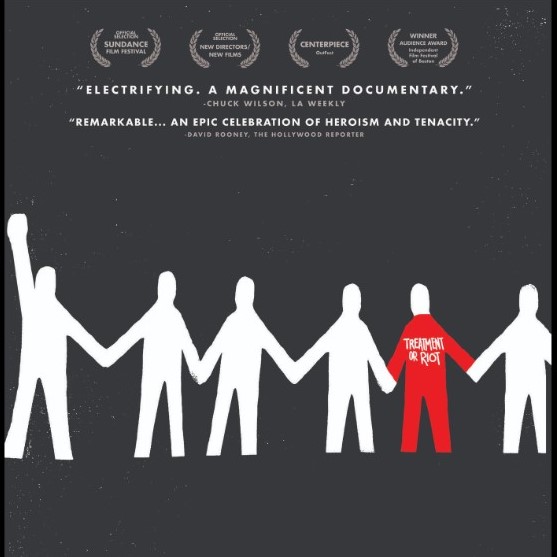
How to Survive a Plague, a documentary film about the early years of the AIDS epidemic and the efforts of the activist group ACT UP, opens in select theaters across the U.S.
Learn More.Directed by David France, How to Survive a Plague shows the founding of ACT UP and TAG (Treatment Action Group), and the rise of an underground drug market in opposition to the prohibitively expensive (and sometimes toxic) medication AZT.
France is able to immerse his film crew behind the scenes of the activist community and document members as they learn to become their own researchers, lobbyists, drug smugglers, and clinicians. A journalist who covered AIDS from its beginnings, France dedicated the film (his first) to his partner Doug Gould, who died of AIDS-related pneumonia in 1992.
The documentary was produced using more than 700 hours of archived footage which included news coverage, interviews as well as film of demonstrations, meetings and conferences taken by ACT UP members themselves. France says they knew what they were doing was historic, and that many of them would die.
Following its 2012 theatrical release, PBS would broadcast the documentary in December 2013, expanding its viewership to millions.
“I had public television in mind as we were making How to Survive a Plague,” France told PBS’s Independent Lens. “It is exactly the audience I was hoping to reach with the film: sophisticated, caring, motivated, and vast.”
How to Survive a Plague received awards for best documentary of 2012 from the Gotham Independent Film Awards, GALECA: The Society of LGBTQ Entertainment Critics, and from the Boston Society of Film Critics. The film also won a GLAAD Media Award for Outstanding Documentary and a Peabody Award.
The Independent Spirit Awards nominated it for Best Documentary, and it was nominated for the Academy Award for Best Documentary Feature, a Directors Guild Award and the Grand Jury Prize at the Sundance Film Festival.
New York Times critic A.O. Scott named How to Survive a Plague one of the best five documentaries of 2012. It also won Documentary of the Year at Attitude magazine’s 2013 Attitude Awards.
France’s book of the same title, expanding on the material, events, and people covered in the film, was published in 2016 to critical acclaim. It was described as “the definitive book on AIDS activism” and was named to numerous best-of and top-ten lists, including the New York Times 100 Notable Books for 2016.
Best known for his appearances on MTV’s The Real World: San Francisco with his partner and fellow AIDS activist Pedro Zamora, Sean Sasser dies at his home in Washington. He was 44.
Learn More.Sasser was a pastry chef who became an AIDS activist after appearing on The Real World. Although not one of the original cast members himself, Sasser’s relationship with Zamora was one of the focal points of the reality TV show.
The episode that featured Sasser and Zamora’s commitment ceremony was the first to present such ceremony for a same sex couple on television, and was considered a landmark event. Sasser, who had been HIV-positive for 25 years, was also diagnosed with mesothelioma, a rare cancer of the lungs, just one month before his death, according to CNN News.
The couple began dating during the taping of the series. Their relationship and Zamora’s battle with AIDS while living in “The Real World” house with seven strangers became must-see-TV for teens and young adults, many of whom had never been exposed to a gay couple, much less someone living with HIV.
Zamora, who had been diagnosed with AIDS at age 17, was a well-known AIDS activist. Sasser, who was also working as an activist and educator, also revealed on the show that he was HIV positive.
During the taping of the series, Zamora’s health took a turn. Zamora died on Nov. 11, 1994, with Sasser at his side just hours after the airing of the final episode of the season.
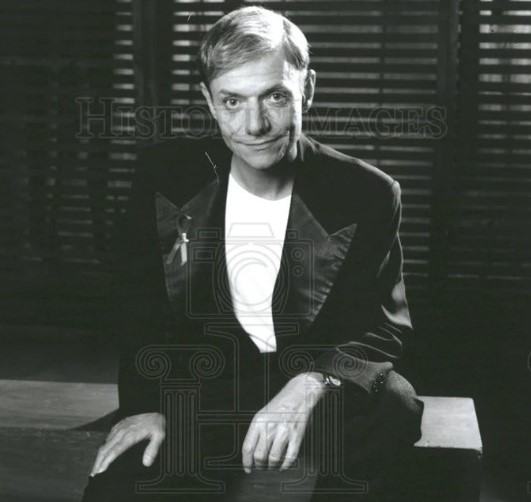
Comedian Steve Moore, best known for his 1997 HBO comedy special Drop Dead Gorgeous (A Tragi-Comedy): The Power of HIV-Positive Thinking, dies of AIDS-related illness two weeks shy of his 60th birthday.
Learn More.Moore starred in the HBO special Drop Dead Gorgeous about living with HIV. Part of his act included imitating his mother, Wilma, whose malapropisms included saying that when she was cold, she wrapped herself in a couple of “Africans.”
“I’ve been there, Mother,” he quipped.
Although gay, Moore was in a lavender marriage to Canadian comedian Lois Bromfield from 1980 to 1995. In the 1990s, Moore frequently performed as the warm-up comedian for tapings of the TV sit-com Roseanne, on which Bromfield was a writer.
“That mouth got him hired and fired five times by Roseanne Barr from the set of Roseanne,” wrote Rich Griset in his Style Weekly tribute to Moore.
But it also endeared him to Ellen DeGeneres, according to local comedian and theater critic John Porter.
“Steve was losing his health benefits, because he didn’t have enough work under his SAG card, so Ellen DeGeneres would hire him when she had her sitcom,” Porter said. “It kept him employed long enough so that his benefits couldn’t be denied.”
In a Los Angeles Times review of Moore’s HBO show, Daryl H. Miller characterized Moore as “a little Joel Grey, a lot Bette Davis.”
“What makes his story so compelling is the generosity of spirit that he finds in himself and in those around him,” Miller wrote of Moore.
In the show, which was shot before an audience at the Comedy Store in West Hollywood, Moore covers his whole life, from growing up in Danville, Virginia to living the fast life in Los Angeles, and then moving back to Danville. The show concludes with a story about returning to Los Angeles to receive free HIV medication from a Beverly Hills doctor who reallocates drugs from patients who died, and then throwing himself a life-affirming 40th birthday party.
After the release of the HBO show, Moore continued to support himself with smaller-scale comedy touring, including performing at HIV/AIDS and LGBT conferences and events, and as a speaker on AIDS and HIV issues.
Moore died at his home in Danville, Virginia. The Byrd Theatre in nearby Richmond would host a public memorial service for Moore on what would have been Moore’s 60th birthday.

Actor Charlie Sheen announces his HIV-positive status in a nationally televised interview.
Learn More.“It’s a hard three letters to absorb. It’s a turning point in one’s life,” the 50-year-old actor said on the TODAY Show.
Sheen said he was motivated to go public about his HIV status in order to put an end to threats from extortionists who wanted “millions of dollars” to keep his diagnosis a secret.
On the same day, Sheen released an open letter about this HIV-positive diagnosis:
“The personal disbelief, karmic confusion, shame and anger lead to a temporary yet abysmal descent into profound substance abuse and fathomless drinking. It was a suicide run,” Sheen wrote.
With his public announcement, Sheen committed to managing his virus and serving as a good example for others who were HIV-positive.
“I accept this condition not as a curse or scourge, but rather as an opportunity and a challenge: an opportunity to help others, a challenge to better myself,” Sheen wrote.
Significant public conversation about HIV followed his disclosure.
The White House Office of National AIDS Policy, the NIH Office of AIDS Research, and the National Institute of Mental Health cohost a meeting to address the issue of HIV stigma: Translating Research to Action: Reducing HIV Stigma to Optimize HIV Outcomes.
Learn More.Participants include researchers, policymakers, legal scholars, faith leaders, advocates, and people living with HIV.
Julio of Jackson Heights, a documentary by Richard Shpuntoff about the 1990 hate-crime murder of Julio Rivera, premieres at the Queens World Film Festival.
Learn More.“The decision to make a film about the murder of Julio Rivera … was slow in coming,” said director Shpuntoff. “Though I wasn’t living in New York in 1990, I was aware of the murder, having read some articles at the time and having heard about it from my parents who lived six blocks away from the site of the murder.”
Shpuntoff volunteered to photograph Jackson Heights’ first pride parade in 1993, something he would continue to do for the next 20 years. He decided to make the documentary as a way to highlight the changes in the neighborhood since Rivera’s murder.
“Around 2004, I began the first of various attempts at creating a film portrait of the Parade, but was never satisfied with the results. I felt heavily the absence of a person I would never be able to portray: Julio Rivera,” Shpuntoff told The New York Times shortly at the premiere of his film.
Rivera was beaten to death in a schoolyard in 1990 and received national media attention when one defendant said he killed Rivera ”because he was gay.”
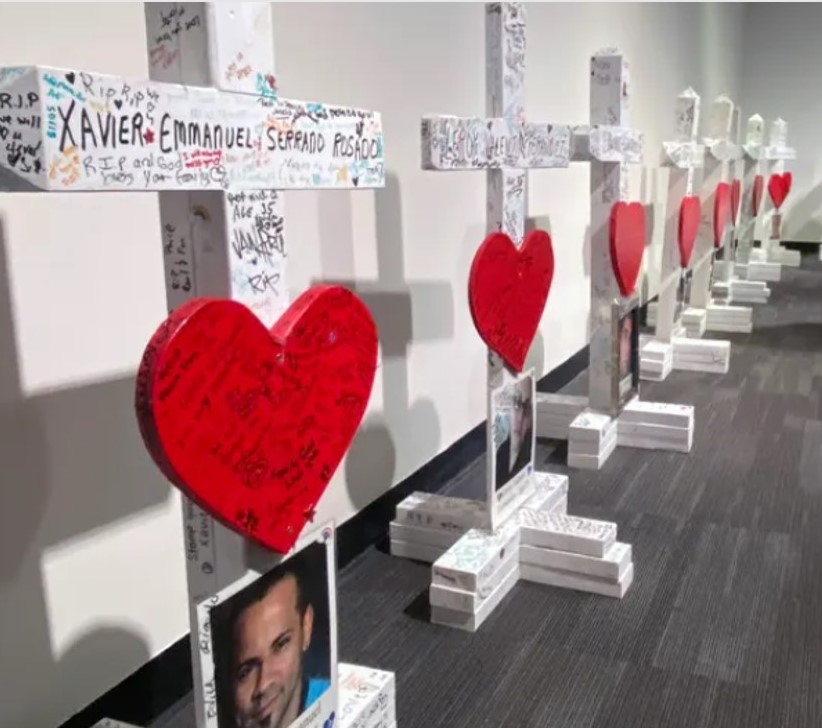
A gunman forces his way inside Pulse, one of Orlando’s biggest nightclubs, and opens fire on the predominantly gay crowd. In the weeks that followed, the Federal Bureau of Investigation would release statements saying that the gunman, who died at the scene, was found to be HIV-negative, to counter rumors that he was an HIV-positive closeted gay man out for revenge.
(Photo courtesy of Orange County Regional History Center]
Learn More.Just days after the Pulse shooting, the second worst mass shooting in the U.S. to date in which 49 people died and 68 people sustained injuries, the Spanish-language television network Univision aired a report in which “Miguel” alleged that he had sex with Mateen after meeting him on a gay dating app. Miguel, who wore a disguise during the interview to maintain anonymity, said Mateen disclosed to him that he had unprotected sex with a man who afterward told Mateen he was HIV-positive.
“I believe this crazy horrible thing he did — that was revenge,” Miguel had theorized.
The FBI said that its investigation into Mateen’s background failed to prove that the Port St. Lucie man — who was twice married to women and had a young son — had a secret gay life, according to the Los Angeles Times. In statements to the media, FBI officials also said that Mateen’s autopsy report indicated that he was negative for HIV.
Mateen worked for a private security company, where he told co-workers he supported Islamist extremist groups and also expressed his hatred of gay people, according to The New York Times.
Two weeks before the shooting, Mateen went to a Jensen Beach, Florida gun store and legally purchased a Sig Sauer SIG MCX semi-automatic rifle and a 9mm Glock 17 handgun, both of which he used to shoot people in the Pulse nightclub, according to a CNN timeline of the shooting.
Barbara Poma, who cofounded Pulse, named the club in memory of her older brother, John, who died of AIDS-related illness in 1991, according to POZ magazine. Saturday, June 16 was Latin Night at Pulse, and the place was packed — some say over capacity — with patrons both gay and straight, young and not-so-young, from the U.S., Puerto Rico, the Dominican Republic, Mexico and elsewhere. It was about 2:00 p.m. when Mateen arrived at the club and began shooting. An off-duty officer who was working at the club “engaged in a gun battle” with him, Orlando Police Chief John Mina told NPR.
Orlando police officers arrived on the scene minutes later and also exchanged gunfire with the gunman. Mateen then took a group of people into a bathroom and held them as hostages while he entered into an hours-long negotiation with Orlando police. At about 5:00 a.m., police began to break down the wall to the bathroom, and Mateen started shooting hostages, whom he had ordered to lay down on the floor. He then emerged from the breached wall and began exchanging gunfire with police. He was pronounced dead at 5:53 a.m.
The deadly shooting occurred as 2016 Pride celebrations were underway across the country, and many events included moments of silence to honor the dead.
Killed in the shooting were Stanley Almodovar III, Amanda Lizzette Alvear, Oscar A. Aracena Montero, Rodolfo Ayala Ayala, Antonio “Tony” Brown, Darryl Roman Burt II, Angel Candelario-Padro, Juan Chavez Martinez, Luis D. Conde, Cory James Connell, Tevin Eugene Crosby, Deonka “Dee Dee” Drayton, Simón Adrian Carrillo Fernández, Leroy Valentin Fernandez, Mercedez Marisol Flores, Peter Ommy Gonzalez Cruz, Juan Ramon Guerrero, Paul Terrell Henry, Frank Hernandez, Miguel Angel Honorato, Javier Jorge Reyes, Jason Benjamin Josaphat, Eddie Jamal Droy Justice, Anthony Luis Laureano Disla, Christopher Andrew Leinonen, Alejandro Barrios Martinez, Brenda Marquez McCool, Gilberto R. Silva Menendez, Kimberly Jean Morris, Akyra Monet Murray, Luis Omar Ocasio Capo, Gerardo A. Ortiz Jimenez, Eric Ivan Ortiz-Rivera, Joel Rayon Paniagua, Jean C. Mendez Perez, Enrique L. Rios Jr., Jean Carlos Nieves Rodríguez, Xavier Emmanuel Serrano Rosado, Christopher Joseph Sanfeliz, Yilmary Rodríguez Solivan, Eddie Sotomayor Jr., Shane Evan Tomlinson, Martin Benitez Torres, Jonathan A. Camuy Vega, Juan Pablo Rivera Velázquez, Luis Sergio Vielma, Franky Jimmy DeJesus Velázquez, Luis Daniel Wilson-Leon, and Jerry Wright.
“We stand with you to say that the good in this world far outweighs the evil, that our common humanity transcends our differences, and that our most effective response to terror and to hatred is compassion, it’s unity, and it’s love,” said Florida Attorney General Loretta Lynch. “We stand with you today as we grieve together, and long after the cameras are gone, we will continue to stand with you as we grow together in commitment, in solidarity, and in equality.”
Following the shooting, the OnePulse Foundation was formed to raise $45 million for the creation of the National Pulse Memorial & Museum in Orlando in honor of the 49 dead, the 68 injured, and the first responders and healthcare professionals who treated them.

Transgender trailblazer Alexis Arquette dies at Cedars-Sinai Hospital in Los Angeles of AIDS-related illness at the age of 47.
Learn More.Arquette was born into an acting family that includes siblings David, Rosanna, and Patricia, the latter who would famously memorialize her sister in a speech at the 2019 Emmy Awards.
In the earlier years of her career, Arquette primarily performed as a female impersonator, frequently under the name “Eva Destruction.” She debuted on the big screen in 1986 in an uncredited role as Alexis, the androgynous bandmate of Max Whiteman (Evan Richards) inDown and Out in Beverly Hills. Arquette would go on to star in more than 40 movies, the majority of them low-budget or independent films.
Diagnosed with HIV in 1989, Arquette chronicled her gender affirmation surgery in a 2007 documentary, Alexis Arquette: She’s My Brother, but returned to presenting as a man in 2013 as her health failed.
In her final hours, Arquette is surrounded by her famous brothers and sisters. Alexis had left specific instructions for her death: David Bowie’s “Starman” was to play as her final moments approached.
And when the final breath passed her lips, she asked that everyone cheer “the moment that [s]he transitioned to another dimension,” reports The Hollywood Reporter.
Her family would go on to found the Alexis Arquette Family Foundation, which works with the LA County / USC Medical Center to provide medical and mental health support to LGBTQ residents in the county.

Jazz pianist and HIV-positive activist Fred Hersch releases his award-winning solo record, Open Book.
Learn More.Hersch announced publicly in 1993 that he was gay and he had been receiving HIV treatment since 1984. Since revealing his HIV status, he has been the keynote speaker and performer at international medical conferences in the U.S. and Europe.
He also has been a passionate fundraiser for HIV/AIDS services and education agencies, producing and performing on four benefit recordings. Charity concerts at which he’s performed include “Classical Action: Performing Arts Against AIDS” and “Broadway Cares/Equity Fights AIDS,” according to his website.
In an interview with NPR, Hersch told Fresh Air‘s Terry Gross that when his 2007 tour schedule became demanding and he began losing weight, his doctors tried to “give his body a break” by stopping his regimen of antiviral medication. This turned out to be a near-fatal decision. Hersch’s health quickly deteriorated, and by early 2008, he had developed AIDS-related dementia.
Hersch was put on new antiviral medications, and for several months, his health appeared to be on the rebound. But in June 2008, his blood oxygen levels dipped dangerously low and Hersch went into septic shock, his organs failing one by one. He lapsed into a coma, which lasted more than two months.
When he regained consciousness, he could no longer play piano as a result of musculature deterioration.
“I realized when I was that far down, that I really wasn’t done yet,” he said in the 2010 NPR interview. “There was more that I had to do as a musician, as a partner. And whether it was just stubbornness or just crankiness or whatever, I felt like I [wasn’t] ready to check out.”
With months of diligent rehabilitation, Hersch was able to play again. In 2011, he performed My Coma Dreams, a stage show written and directed by Herschel Garfein about the contrast between dreams and reality.
In 2017, upon the release of Open Book, Hersch was honored with the Prix in Honorem Jazz as well as the Coup de cœur jazz from l’Académie Charles Cros. The same year, his autobiography, Good Things Happen Slowy: A Life in and Out of Jazz, was published by Crown Books.
Hersch has recorded more than 70 of his jazz compositions, and he was the first person to play weeklong engagements as a solo pianist at the Village Vanguard in New York City. He has been nominated for several Grammy Awards for Best Jazz Instrumental Performance (1992, 1995) and Best Jazz Instrumental Album (2011, 2014, 2016, 2017, 2018).
He has been proclaimed “the most arrestingly innovative pianist in jazz over the last decade” by Vanity Fair, “an elegant force of musical invention” by The L.A. Times, and “a living legend” by The New Yorker.
[photo: Erika Kapin Photography]
Broadway composer and lyricist Michael Friedman, known for the play Bloody, Bloody Andrew Jackson, dies of AIDS-related illness at age 41.
Learn More.An Obie Award winning composer/lyricist, Friedman was most well-known as the co-creator of the critically-acclaimed musical Bloody Bloody Andrew Jackson, which premiered in New York at the Public Theater and subsequently transferred to Broadway.
Other credits include the musical The Fortress of Solitude, based on the book of the same name by Jonathan Lethem; Unknown Soldier, which premiered at the Williamstown Theatre Festival; and Love’s Labour’s Lost, which premiered at the Delacorte Theater in Central Park.
Public Theater Artistic Director Oskar Eustis in a statement said, “Michael Friedman was one of the most brilliant, multi-talented theater artists of our time. He was also a miracle of a human being: loving, kind, generous, hilarious, thrilling. His loss leaves a hole in the theater world that cannot be filled, and a hole in the hearts of those who loved him that will last forever.”
Michael Paulson of the New York Times describted Friedman as “a versatile, cerebral and witty composer and lyricist who brought a historian’s eye and a journalistic sensibility to pathbreaking work off and on Broadway.”
Michael was a founding Associate Artist of The Civilians, the acclaimed investigative theater company. His work with company includes Gone Missing, In the Footprint, The Great Immensity, Paris Commune, (co-written with Civilians’ Artistic Director Steve Cosson) (I Am) Nobody’s Lunch, and This Beautiful City as well as the score for Anne Washburn’s critically-acclaimed Mr. Burns, a Post-Electric Play.
His final collaboration with Cosson, The Abominables, opened at Children’s Theater Company in Minneapolis in September 2017.
A cornerstone of The Civilians’ investigative method was to interview people and then turn the interviews into songs.
Sarah Larson wrote in The New Yorker that Friedman had “an incredible gift” for creating theater from interviews.
“He was an almost forensic listener, re-creating the exacting speech of all kinds of people and setting it to music as if finding its true form,” Larson wrote.
Friedman’s death was a shocking reminder to many that HIV continued to be deadly — even for well-to-do, white men with good health insurance.
“Aching with gratitude for the music & joy he gave us,” Lin-Manuel Miranda, the creator of Hamilton, wrote on Twitter. “Mourning all the music we’ll never hear.”
Shortly following Friedman’s death, the New York Times published an update, stating that Friedman had tested positive for HIV just nine weeks before his death.
Georgia State Rep. Betty Price asks about the “legalities” of quarantining people who test positive for HIV, and incites a firestorm of criticism from activists and advocates across the country.
Learn More.Rep. Price was in a House healthcare committee meeting when she asked a state health official whether people with HIV could legally be quarantined.
“I don’t want to say the quarantine word, but I guess I just said it,” she said during the meeting, which was recorded on video, according to NBC News.
During the meeting, Rep. Price also expressed fear at the high number of people living with HIV, suggesting that the public health risk has intensified because people testing positive for HIV are living longer.
“It’s almost frightening the number of people who are living that are … carriers with the potential to spread,” she said during the hearing. “Whereas in the past, they died more readily, and then at that point, they’re not posing a risk.”
Health advocates and LGBTQ activists responded to Rep. Price’s comments with accusations of feeding fear and stigma around the virus.
“It’s very troubling to hear comments like that,” Jeff Graham, executive director of the LGBT advocacy group Georgia Equality, told NBC News. “It shows the amount of work that still needs to happen to educate elected officials on the reality of the lives of people living with HIV.”
In a statement shared with the Atlanta Journal Constitution, Rep. Price claimed her comments at the meeting were “taken completely out of context” and that she was merely being “provocative.”
Rep. Price, a Republican elected in 2015 to represent the northern Atlanta suburbs of Roswell and Alpharetta, did not win her re-election bid in 2018. She lost in a tight race to Mary C. Robichaux, a Democrat who previously worked with hospitals, physicians and other providers to improve patient outcomes.
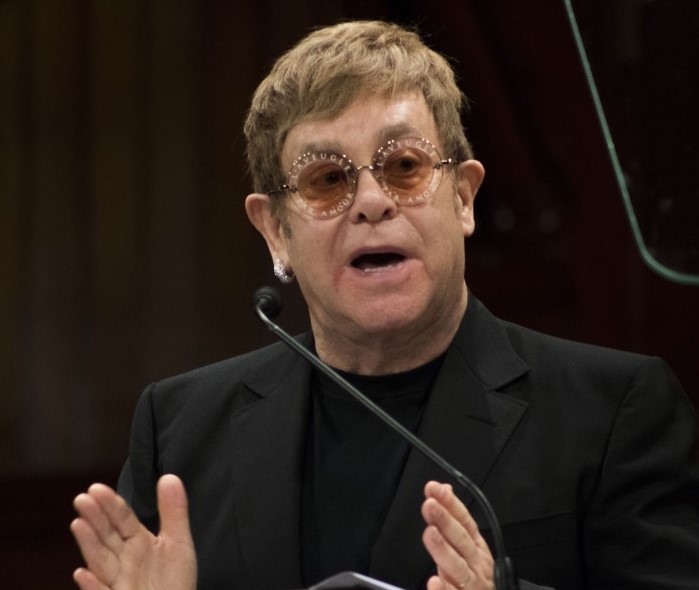
Harvard University honors singer and HIV activist Elton John as Humanitarian of the Year.
[photo by Lauren A. Sierra, courtesy of The Harvard Crimson]
Learn More.Elton John was recognized with the university’s Peter J. Gomes Humanitarian Award for his decades of work in support of HIV/AIDS research and awareness. Since founding the Elton John AIDS Foundation in 1992, he has raised more than $385 million to support HIV/AIDS-related programming around the world.
About 1,000 cheering Harvard affiliates attended the award ceremony and gave John a standing ovation, according to Samuel W. Zwickel’s story in The Harvard Crimson.
In his speech to the crowd, John said dedicated the award to the people working at the front lines of tackling the HIV/AIDS epidemic, calling them “the bravest and most compassionate people I have ever met.”

Atlanta performance artist, writer, and HIV educator Antron-Reshaud Olukayode dies of AIDS-related illness at age 33.
[photo from Olukayode’s blog]
Learn More.Olukayode was an accomplished poet, author, HIV/AIDS activist, blogger, self-taught multidisciplinary artist, vocalist, music producer, creative director of BOS+AROS, and Buddhist practitioner.
Born on April 26, 1984 in Gainesville, Florida as Antron Reshaud Brown (he later changed his surname to Olukayode, which is Yoruba for “God brings happiness”), he didn’t speak until the age of four, according to the National Black Justice Coalition in its tribute to Olukayode.
He showed an early interest in the arts, and his grandmother and mother encouraged his artistic expression, supplying him with craft supplies. He learned to play the piano as a child from his grandmother, and in the second grade, he won a local writing contest based on a story about going to the grocery store with his mother. When he was 15, Olukayode started working with children at his local Boys and Girls Club, leading them in arts and crafts projects.
During his teen years, Olukayode was constantly teased, bullied and physically abused due to his effeminate appearance and mannerisms. At the age of 17, he was raped and assaulted in a field near his neighborhood by two young men. Afterward, Olukayode considered suicide, but heard a voice telling him to write. He began writing in his journal to keep himself sane.
Olukayode was infected with HIV while in an abusive relationship with a basketball player at his college. When he learned of his diagnosis, he was overwhelmed with shame and dropped out of college. He worked in a series of meaningless jobs, continuing to live with his mother until he decided to leave Gainesville to seek a better life.
In 2006, Olukayode boarded a Greyhound bus to Atlanta with with four boxes of belongings and $200 in cash, A new friend, Kelvin Barlow, read some of Olukayode’s written work and introduced him to AID Atlanta’s program manager Craig Washington, who invited Olukayode to recite poetry at a Black Gay Pride event called Phyre!
Olukayode said that it was at this event that he knew he had found his calling as a poet. He also became involved with AID Atlanta, which led to his first HIV/AIDS prevention job at National AIDS Education & Services for Minorities (NAESM), under the supervision and guidance of executive director Adolph St. Arromand.
In 2007, Olukayode released his first collection of poetry, “Bohemian Rebel: Naked and Exposed Vol. 1.” A week later, he became homeless and began spending his nights couch surfing or sleeping in Piedmont Park.
Over the next three years, Olukayode wrote while experiencing homelessness, producing The Rising Vol. 2, a collection of poems and prose about his years being homeless. He also wrote his first stage play, TRANS-ition, the story of a teenager transitioning from male to female, and his first one man show, Evicted, about enduring homelessness while HIV positive.
Olukayode’s third collection of poems and prose, Fearless Revolution, Vol. 3, drew on his experience from a relationship with a soldier. In 2012, he contributed the essay “Afraid of My Own Reflection” to the anthology For Colored Boys Who Have Considered Suicide When the Rainbow is Still Not Enough: Coming of Age, Coming Out, and Coming Home. He also produced a blog and vblog, With Love ATL, for thebody.com.
In addition to poetry and prose, Olukayode wrote songs, influenced by the music of the Baptist church of his childhood. In 2013, following the traumatic end of a relationship, he produced his first EP, Oluka Oluka.
In his work as a self-proclaimed “artivist,” Olukayode participated in the Centers for Disease Control’s initiative “Let’s Stop HIV Together” campaign. He also lobbied in Washington, D.C. for AIDS Watch, urging Congress to increase funding for HIV services. As a youth representative from the State of Georgia, Olukayode met Congressman John Lewis and shared his story.
He also worked on the project DA CRIBB for the National AIDS Education & Services for Minorities and The Evolution Project for AID Atlanta. He was a member of Lifting Our Voices for Equality (L.O.V.E) Coalition and Common Ground Ministries.
Olukayode was creative director of BOS+AROS, a vehicle for change with an avant-garde approach to empower the masses about HIV/AIDS, using art to connect with people and spread awareness. He premiered his multimedia exhibition, ANTRONICA, in 2016.
Olukayode spent the last years of his life in Atlanta, where he practiced Buddhism, and enjoyed the independent and avant-garde art scene.
According to a tribute posted by friend Mark S. King, Olukayode “had developed Kaposi sarcoma, a dangerous cancer that spread from his skin to his other organs during a month-long hospital stay before his death. AIDS caused Antron’s cancer.”
A few weeks before he died, Olukayode wrote: “Having my mother here in the hospital with me is healing. She came all this way to be by my side. I am so grateful and grateful for my friends who have been nothing but supportive. Having her witness my friends lavishing the love and meeting her and is extraordinary. A blessing and fills me with joy.”
You can view Olukayode’s work on his personal blog.
The New York Times reports on a June 2017 meeting at the White House during which President Donald Trump fumed over travel visas granted to 15,000 Haitians, saying they “all have AIDS.”
Learn More.The explosive information in the NYT article was widely repeated by media outlets, although the two sources for the White House meeting were kept anonymous by request. According to NYT reporters Michael D. Shear and a White House staffer who attended the meeting and another person who was briefed about it by a different person who was there.
Trump’s comment about Haitian immigrants having AIDS came after he read aloud from a report listing the number of people from outside the U.S. who had received visas to enter the country in 2017.
When members of his administration tried to explain that many were short-term travelers making one-time visits, Trump responded by angrily berating his senior advisors for allowing too many foreigners to enter the country.
Although the White House subsequently denied that Trump made any such comments, ABC News would counter this by noting that Trump made a similar, albeit softer, comment about Haitians in a recent Fox News interview: “Take a look at what’s happening in Haiti. A tremendous problem with AIDS.”
In response to the report on Trump’s comments about Haitians and AIDS, Congresswoman Maxine Waters (CA-43) issued the following statement: “Donald Trump has proven that there is no limit to his hatred, bigotry, and vulgarity. As a longtime friend of Haiti who has traveled to the country numerous times, I am especially appalled by Trump’s racist and ignorant comments about Haiti.”
For Haitian author Edwidge Danticat, Trump’s reported comments opened an old wound from a time when Haitian immigrants had to endure the stigma of being a “high risk group” for HIV/AIDS. For several years, Haitian immigrants were not permitted to donate blood in the U.S.
In an article for The New Yorker, Danticat wrote, “At the junior high school I attended, in Brooklyn, some of the non-Haitian students would regularly shove and hit me and the other Haitian kids, telling us that we had dirty blood.”
Of the four groups the CDC identified as “high risk” for the disease in 1983, Haitians were the only ones identified by nationality. The other three groups were intravenous drug users, homosexuals, and hemophiliacs. Members of all these group were stigmatized by the association with AIDS.
Just a few weeks later after the NYT article exposed the goings-on behind Oval Office doors, racist comments from Trump would surface again in reports of a January 11 meeting with senators in which the president referred to Haiti and African nations as “shithole countries.”
“Why are we having all these people from shithole countries come here?” Trump said, according to people briefed by The Washington Post.
Trump then suggested that the bipartisan group of senators focus instead on countries such as Norway, whose prime minister he met with the day before. According to one White House official, the president also suggested he would be open to more immigrants from Asian countries because he felt that they help the United States economically.
In addition, the president singled out Haiti, telling lawmakers that immigrants from that country must be left out of any deal, these people said.
“Why do we need more Haitians?” Trump said, according to people familiar with the meeting. “Take them out.”

After a former boyfriend threatens to blackmail him over his HIV status, Austrian singer and Eurovision winner Thomas Neuwirth, who won the 2014 Eurovision Song Contest performing as Conchita Wurst, announces that he is HIV-positive.
Learn More.In a press statement, Neuwirth notes that he has been in treatment and virally suppressed for many years, and says “I hope to show courage and take another step against the stigmatization of people with HIV.”
A spokesman for the performer said in an email that Neuwirth’s preferred pronouns are “she” for references to the stage persona of Conchita Wurst and “he” for Neuwirth, the private individual.
Conchita gained international attention in 2014 when, as the representative from Austria, she won the Eurovision Song Contest. In a gold sequined dress and with a dark beard, she performed “Rise Like a Phoenix,” a power ballad highlighting her vocal range, and secured the top prize.
Since winning that competition, she has built an international following as a gay icon, going on tour and appearing at gay pride events around the world.
In a tearful interview with The New York Times, TV star Jonathan Van Ness discloses he is HIV positive.
Learn More.Known as the grooming expert on the 2018 reboot of Queer Eye for the Straight Guy, Van Ness disclosed that he was informed of his HIV-positive status after a visit to a Planned Parenthood clinic in Los Angeles. A 25-year-old salon assistant at the time, Van Ness was motivated by his diagnosis to quit smoking methamphetamine, “clean up his lifestyle,” and pursue an entertainment career.
The Times interview coincided with the release of the 32-year-old’s memoir Over the Top: A Raw Journey to Self-Love. Van Ness said he hoped his book would help dispell misconceptions about being HIV positive.
The decision to disclose his HIV status did not come easy for him. When the Queer Eye reboot made him famous and he decided to write a book about the journey to his success, he debated whether to make his HIV status public.
“It was really difficult, because I was like, do I want to talk about my status?” he said. “And then I was like, the Trump administration has done everything they can do to have the stigmatization of the LGBT community thrive around me.”
Over the Top would go onto to become a New York Times bestseller and one of NPR’s “Favorite Books of the Year.” It would also win Goodread’s Choice Award for Best Memoir and Autobiography.
Jerry Herman — whose musical La Cage aux Folles arrived on Broadway at the height of the AIDS epidemic and helped put gay life into the cultural mainstream — dies at the age of 88.
Learn More.Herman composed the scores for the hit Broadway musicals Hello, Dolly!, Mame, and La Cage aux Folles, and was nominated for the Tony Award five times (winning twice for Hello, Dolly! and La Cage aux Folles).
Born July 10, 1931, Herman grew up in Jersey City, NJ in a family that loved theater. Seeing Irving Berlin’s Annie Get Your Gun on Broadway changed his life, he told NPR in 1994.
“I walked out of that theater singing all those wonderful Berlin songs and, from that moment on, that’s all I wanted to do with my life,” he said.
In 1983, shortly after La Cage Aux Folles opened on Broadway, Herman’s companion, Marty Finkelstein, died of complications from AIDS. Herman was diagnosed as HIV-positive at a time when that seemed like a death sentence.
Herman was one of the first people to receive the complex cocktail of drugs that has kept so many HIV patients alive, and he helped raise millions of dollars for AIDS research.
Marilyn Stasio, who co-wrote Herman’s memoir Showtune, said that his HIV status spurred him to write his memoirs — and to also set some things straight.
“One thing that really got him mad was he thought people really felt he was putting it on, the optimism and the joy and the happiness and the way he loved life,” Stasio told NPR. “And he wanted to make it clear that it was true. He did. He loved every minute of life.”
Herman’s memoir, Showtune, was published in 1996. In it, he wrote about being shaken by the death of his lover, his own illness, and a feeling that despite La Cage, his music was no longer in fashion.
In 2009, Herman received the Tony Award for Lifetime Achievement in the Theatre, and a year later, he and his work was recognized at the 2010 Kennedy Center Honors.
In December 2019, he was hospitalized for pulmonary complications and died days later.
The world marks 40 years since the first five cases of what later became known as AIDS were officially reported in Los Angeles.
Learn More.President Joe Biden, HHS Secretary Xavier Becerra, and Secretary of State Antony J. Blinken release messages recognizing the 40th anniversary. Other events and activities are held across the country to remember the lives that were cut short by this terrible disease and celebrate the resilience and dignity of the more than 38 million people with HIV worldwide.
On this day, the Foundation for The AIDS Monument held its ceremonial groundbreaking at the future site of STORIES: The AIDS Monument in West Hollywood Park. Among the community members who attend the event is Dr. Michael Gottlieb, one of the authors of the June 1981 CDC report announcing the first five cases of an illness subsequently defined as acquired immunodeficiency syndrome (AIDS).
The five men described in the report were between the ages of 29-36 and resided in the Los Angeles area, and by the time the report was published, two had already died. The relatively brief report gave scant information about this new medical phenomenon, including the following:
Time magazine publishes a collection of interviews that reveal that for some of people living with HIV and others whose lives were changed by the AIDS crisis, the COVID-19 pandemic has been particularly challenging.
Learn More.HIV/AIDS survivors told Time about the historical parallels between the two viral outbreaks and about their experiences both with the AIDS epidemic and with corona virus disease.
Among those profiled in the magazine were:
Jeff Wacha, 61, a resident of Los Angeles County whose husband, Garry Bowie, was head of Being Alive until he passed away from COVID-19 complications in April 2020. Wacha told Time:
“In February 2020, when word started getting around аbout COVID, Garry got his staff together, and they put together a mitigation plan. It just kills me that, as diligent as Garry was and prepared as he was, he was one of the first ones to succumb to it. It’s just not right. … I finally had to call the ambulance when his breathing got bad. The EMTs at that time wouldn’t even come in the house. I had to get Garry dressed myself and get him out on the front steps before they would take over.
“The feeling of being a pariah because you have it reminded me of the feeling when I first found out I had HIV. The fear of being around people who have it, the ‘am I going to get it?’ There’s also the survivor’s guilt. And the panic sets in: ‘Am I next?’ Because that was usually the way it was with HIV.”
Gina Brown, 55, a resident of New Orleans and the Community Engagement Manager for the Southern AIDS Coalition. Brown, who tested positive for HIV on April 4, 1994 while she was pregnant with her daughter, said:
“The isolation of COVID-19 reminded me of HIV, although the isolation from HIV was self-imposed. Both illnesses cause you to look at your fellow man as if they are a disease. My cousin, who was in his 20s, died from HIV in the 1980s. Normally in our family, if somebody is dying, you go and you kiss them, you tell them goodbye. Nobody did that.”
Arthur Fitting, 67, a registered nurse who has worked for the non-profit home care agency Visiting Nurse Service of New York for decades. Fitting, who lost his partner to AIDS in 1987, said:
“In March 2020, I found out that my husband, who works in a hospital as a radiology technologist, had developed COVID … I’d broken down all my walls to be able to share my life with another person again. I felt so vulnerable, thinking, ‘how could this be happening again?’ I was checking on him and watching all through the night. The possibility that I couldn’t be with him in the hospital was very difficult.”
Cecilia Chung, 55, a resident of San Francisco and the senior director of the Transgender Law Center. Chung, who immigrated to the U.S. from Hong Kong in 1984 and was diagnosed with HIV in 1993, said:
“With both outbreaks, there’s a lot of scapegoating — for HIV, gay men were scapegoated; HIV was called ‘the gay disease.’ And for COVID, people of Asian descent are scapegoated. Even in San Francisco, we’ve had some anti-Asian violence. That’s why I go to the bank for my 78-year-old mom—so she doesn’t need to put herself in a dangerous situation.”
Ciarra “Ci Ci” Covin, 33, a former resident of rural Georgia and the Program Coordinator for The Well Project in Philadelphia. Covin, who was diagnosed with HIV in 2008 and is currently pregnant with her second child, said:
“The feeling of being a pariah because you have it reminded me of the feeling when I first found out I had HIV. The fear of being around people who have it, the “am I going to get it?” There’s also the survivor’s guilt. And the panic sets in: “Am I next?” Because that was usually the way it was with HIV.,
“The HIV and AIDS community could benefit from the same compassion as those with COVID-19. After I was diagnosed with HIV, I received a lot of discrimination from the people down South. I was kind of under the impression that I was being punished for doing something that I shouldn’t have been doing.”
Those with HIV/AIDS may be at greater risk for severe conditions connected to infection with the coronavirus, according to the Centers for Disease Control and Prevention. People with weakened immune systems may not get the same level of protection from vaccination as others.
Nearly half of people with diagnosed HIV in the U.S. were aged 50 and older, according to the CDC. People with HIV also have higher rates of chronic heart and lung disease. The CDC said it is essential that people with HIV remain on their treatment regimen and take precautions to avoid corona virus infection.

The Los Angeles Black AIDS Monument opens at the West Adams Carl Bean House in Los Angeles.
Learn More.Located at 2146 West Adams Boulevard in Los Angeles, the Los Angeles Black AIDS Memorial (LABAM) was created to remember those who died due to HIV/AIDS.
Jeffrey King, Executive Director of In The Meantime Men’s Group, conceived of and designed the Memorial. Renowned Los Angeles artist Nijel Lloyd Binns sculpted the monument into its physical form, infusing into the design three symbols: the tekhen, the Sankofa bird, and a written statement.
The monument consists of a 6-foot-tall dark granite structure in the shape of a tekhen, a configuration used in ancient times to guide those on the road to spiritual progress. At the apex of the monument stands a bronze Sankofa bird with its left foot forward.
According to the monument’s website, the bird is a reference to an important symbol in the Akan culture of Ghana, a mythological bird with a foot stepping forward, but its head turned backward. The bird is called “Sankofa,” which translates to go back and get, reflecting the need to reach back into ancient and modern history for traditions left behind.
“Thus the Akan believe that the past and the wisdom of those who have gone before us must serve as a guide in planning for and moving forward into the future,” states the monument’s website. “The example of the heart being on the left side of the body and the left foot going forward is a symbol enshrined by our ancestors that says that it requires heart and courage to take the right steps forward.”
The third symbol of the monument — the written statement — is engraved in the center of the tekhen: “Pouring Into Each Other.” This, according to the monument website, is a message of “giving back.”
[Photo courtesy of the Los Angeles Black AIDS Memorial]
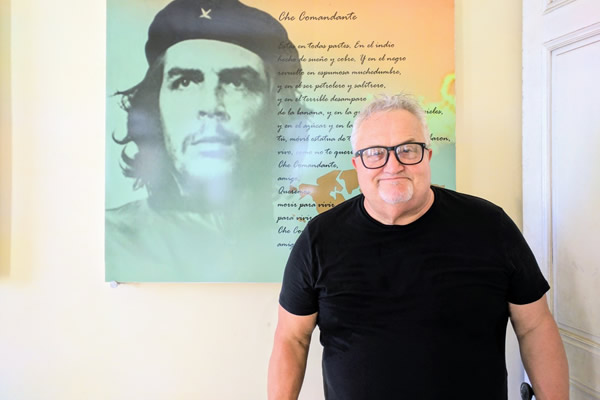
Scott Robbe, a TV-film-theater producer who created LGBTQ programs and a long-time AIDS activist who participated in ACT UP protests, dies after a year-long battle with cancer. He was 66.
Learn More.Robbe’s life was devoted to progressive activism, beginning in his teen years, when he took part in 1960s marches for the environment, for civil rights, and against the Vietnam War. Over the four decades that followed, his endeavors included both community organizing and producing dozens of works in theater, film, and television.
“Scott was a fearless activist, always on the front lines, whether he was protesting pharmaceutical company greed or homophobia at the Oscars,” ACT UP New York veteran Ann Northrop said in a statement released by Robbe’s estate. “And he was a total sweetheart.”
Robbe joined ACT UP after seeing the group protest at the White House in October 1987 during the Second National March on Washington for Lesbian and Gay Rights. He joined the group’s Media Committee and took part in numerous protests. Years later, in the early 1990s, he would become HIV positive.
According to the Facebook group ACT UP NY Alumni, Robbe helped to found two direct-action groups in New York City: ACT UP and Queer Nation NY. In September 1989, he and other ACT UP members secretly gained access to the New York Stock Exchange and were subsequently arrested. The action was a big success, bringing media attention to the exorbitant price of AZT, then the only approved treatment for HIV/AIDS, and forcing its manufacturer, Burroughs Wellcome, to lower the price by 20%.
While in New York City, Robbe produced numerous theater projects, including several with actor Harvey Fierstein. Robbe moved to the West Coast in 1990, where he worked on TV and film projects, many of which promoted LGBTQ visibility. These include the first LGBTQ comedy special for Comedy Central in 1993, called Out There, hosted by actor Lea DeLaria. Robbe was also part of the creative team behind the original Queer Eye for the Straight Guy series in 2003.
Robbe cofounded Out in Film, a Los Angeles-based group that protested representations in movies it found stereotypical and homophobic, such as Silence of the Lambs, JFK and Basic Instinct.
In 2005, Mr. Robbe was named executive director and film commissioner for Film Wisconsin Inc. During his tenure, Mr. Robbe brought 28 TV and film projects to the state, including the 2009 film Public Enemies by Michael Mann, starring Johnny Depp and Channing Tatum.
During the COVID pandemic, Robbe worked with activists in Cuba to bring pressure on the American government to distribute the COVID vaccine in the country. Robbe was also involved in grassroots activism in Puerto Vallarta, Mexico, where he had a second home.
In April 2021, Robbe underwent stem cell treatment at Dana-Farber Cancer Institute in Boston for myelodysplastic anemia, a blood cancer. Later that year, he entered hospice care at the Wisconsin home of his sister, Angela.
False rumors spread online claim the newly discovered, highly virulent variant of HIV circulating in the Netherlands was “created” by COVID-19 vaccines.
Learn More.One Twitter user wrote: “What will you do when it is found that HIV is in the vaccine via Spike protein? New HIV strain found in the Netherlands: Highly infectious variant makes people ill twice as quick. There are no coincidences!”
“A serious outbreak of HIV cases found in the Netherlands. Source – Daily Mail. Any connection with the Covid jabs, I wonder? This has Fauci written all over it,” reads another tweet.
In a rumor de-bunking article by Reuters, the social media speculation on the vaccine-HIV connection was revealed to be false.
“While recently identified, the ‘VB variant’ predates de COVID-19 pandemic and patients analyzed in the paper were infected between the 2000s and early 2010,” Reuters reported.
“There is absolutely no basis to the claim of an association between COVID, or COVID vaccination, and the severity of infection in those infected with the VB variant of HIV,” senior author Professor Christophe Fraser from the University of Oxford’s Big Data Institute and Nuffield Department of Medicine, told Reuters via email.
“Such an association is strictly impossible due to the timing of when the data were collected and analyses, and when the patients were infected,” he said.
The study stated that genetic sequence analysis suggests the variant manifested some time in the 1990s.
Fraser told Reuters how he and the other researchers were able to trace the variant back 30 years: “Using the genetic diversity of the viruses within the lineage, we constructed a family tree of the viruses, and used a molecular clock to date the emergence.”
Furthermore, most of the cases analyzed in the study were diagnosed in the 2000s and early 2010s, he added.
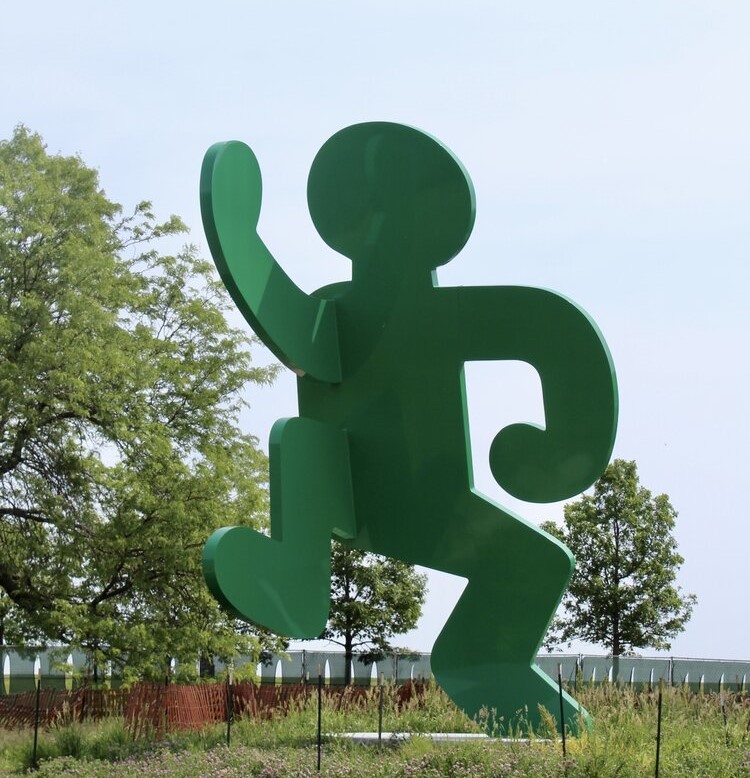
AIDS Garden Chicago, the city’s first public monument to memorialize the early days of Chicago’s HIV epidemic, and to honor those who continue to fight against the disease today, opens.
Learn More.Located near the original location of the historic Belmont Rocks gathering spot, the 2.5-acre park features as its centerpiece a 30-foot sculpture by iconic artist and activist Keith Haring. The sculpture, titled “Self-Portrait,” was provided to the park through a gift from the Keith Haring Foundation with the support of Rosenthal Fine Art, Inc.
The park also features a Gingko tree grove, planting beds for gardening and an educational trail with QR codes that can be scanned to hear audio recordings from people impacted by the AIDS epidemic.
The site of the park originally was the home of the Belmont Rocks, a lake-side space filled with limestone boulders where the local gay community gathered between the 1960s and 1990s. The Rocks were bulldozed and removed in 2003 as part of a city project to safeguard the shore against erosion, according to Chicago author & historian Owen Keehnen.
“This was more than a frequented area. The Rocks were a political statement tied to our liberation, a symbol of our right to be here, our right to exist, and our right to gather outside and in the sunlight at a time when our bars still had blackened windows,” Keehnen wrote on the AIDS Garden Chicago website. “Relationships and friendships happened there, hook-ups, unions, memorials, picnics, cookouts, dance parties, and rallies.”
Chicago Mayor Lori Lightfoot recalled visiting the Belmont Rocks after attending her first Pride Parade in the 1980s.
““I was amazed to see what felt like a sea of diverse, beautiful humanity that was sitting here, hanging out, dancing, playing music [and] barbecuing,” Lightfoot told Jake Wittich of Block Club Chicago. “I’d never seen or experienced anything like that before, and it gave me a sense of assurance that I was making the right decision by coming out.”
In 2013, Doug Ischar published “Marginal Waters,” a series of photographs he took in the mid-80s of men gathering at The Rocks.
In a 2017 interview with The Chicago Tribune, Ischar said: “I was young and, pardon my vanity, good-looking. I was down there with my shirt off and my backpack and my little Leica camera. If someone asked, I told them the truth, I was doing a school project. I became sort of a resident there. People got used to me. I became a fly on the wall.”
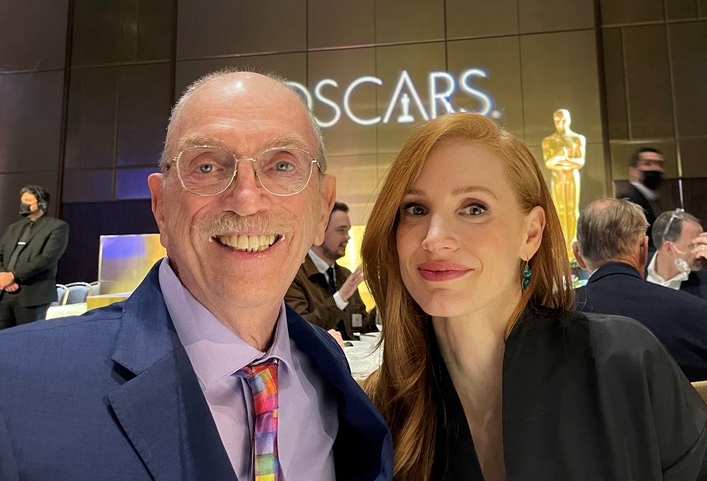
Rev. Stephen Pieters, who emerged as a national spokesman for those facing AIDS in a 1985 interview with televangelist Tammy Faye Bakker, dies in Los Angles from complications of gastrointestinal cancer. He was 71.
Learn More.A long-time activist in the HIV/AIDS and recovery communities, Rev. Pieters was a pastor and later a field director for the AIDS Ministry for the Metropolitan Community Church (MCC) denomination, according to the Los Angeles Blade.
In October 1985, Rev. Pieters agreed to be interviewed by Pentecostal televangelist Tammy Faye Bakker, of the Charlotte-based PTL Television Network, about what it was like to live with AIDS. Bakker was then at her peak popularity, with more than 13 million viewers.
Rev. Pieters said his friends tried to dissuade him from doing the interview. Bakker and her then-husband, Jim, were influential leaders of a conservative Christian movement which promoted ideas sharply at odds with the LGBTQ community. But he saw the show, Tammy’s House Party, as a chance to discuss AIDS and spirituality before an audience he would normally never encounter.
His instincts proved to be right. From the start of the interview and throughout, Bakker showed empathy and asked him thoughtful questions about his life.
“The 25-minute segment became a watershed in public perceptions about AIDS,” wrote Brian Murphy in The Washington Post. “Rev. Pieters also emerged as an eloquent and nationally renowned spokesman for those facing AIDS, which at the time was considered not only a likely death sentence but also put patients at high risk for experiencing shame and humiliation.”
Prior to his diagnosis with AIDS, Rev. Pieters was a leading gay rights activist and served as the pastor of the Metropolitan Community Church of Hartford, Connecticut. According to his biography in the LGBTQ Religious Archives Network, he resigned his position in Hartford in 1982 and moved to Los Angeles, where he began to experience a series of illnesses that were diagnosed as AIDS-Related Complex (“ARC”).
In April, 1984, after being diagnosed with AIDS/Kaposi’s Sarcoma and stage-four lymphoma, he was told by one health professional that he could expect to die within the year.
But he lived to see 1985, and became “patient number 1” on the first anti-viral drug trial, taking Suramin for a total of 39 weeks. While on Suramin, both cancers went into remission, but the drug was highly toxic and was soon discontinued as a treatment for AIDS-related illnesses.
For the next 11 years, Rev. Pieters served as Field Director of AIDS Ministry for the MCC denomination. He traveled the world, teaching and preaching about hope, grief, and surviving AIDS. He also volunteered as a chaplain at an AIDS hospice in Los Angeles.
In 1993, Pieters was one of twelve invited guests at a Prayer Breakfast at the White House with U.S. President Bill Clinton, Vice President Al Gore, and National AIDS Policy Coordinator Kristine Gebbie prior to World AIDS Day. The President talked about Rev. Pieters in his World AIDS Day speech.
He served on the Los Angeles AIDS Task Force, as well as the Boards of Directors of AIDS Project Los Angeles (APLA) and the AIDS National Interfaith Network. He was featured in Life, Time, and Omni magazines, as well as the Los Angeles Times. He regularly appeared on CNN, and was profiled by Jane Pauley to mark the 10th anniversary of the first diagnosis of AIDS.
In 2007, and over the next six years Rev. Pieters battled a number of illnesses, including pancreatitis, which nearly killed him in 2012. At the time of his death, he was writing his memoirs for a book titled My Journey Through AIDS (I Keep on Dancing).
Dr. Pieters’s interview with Tammy Faye Bakker was recreated in the 2021 film The Eyes of Tammy Faye. Click here to hear an audio recording of actor Jessica Chastain, who portrayed Tammy Faye Bakker in the film, talking about Dr. Pieters and his impact.

Dr. Gao Yaojie, a medical worker who raised awareness about HIV/AIDS in rural China in the 1990s and early 2000s as government forces tried to restrict her actions, dies in exile in New York City. She was 95.
Learn More.In the mid-1990s, retired gynecologist Dr. Gao Yaojie was providing medical care in a small village in rural China when one of her patients, a woman who was exhibiting advanced AIDS symptoms, tested positive for HIV.
Chinese officials had long held that HIV and AIDS was not a problem, because the country banned the importation of blood products. So Dr. Gao reached out to someone who might give her the hard truth about AIDS in China, Dr. Wang Shuping, a researcher who was testing blood donations for hepatitis C and HIV. Dr. Wang had found HIV in the blood supply, but her warnings to local officials were dismissed.
Drs. Gao and Wang decided to team up and launch a campaign to educate rural residents about HIV and AIDS, and the dangers inherent in the for-profit blood centers that paid for their plasma donations.
While Dr. Wang worked behind the scenes gathering facts and information, Dr. Gao became the public face of AIDS awareness in China, daring to publicly challenge China’s health system and government. This proved to be a very dangerous endeavor.
Dr. Gao travelled to remote villages from her home in Zhengzhou, providing rudimentary medicine for fever, diarrhea and other symptoms of AIDS. According to The New York Times, her stops included a village school where 20 children were left without parents due to AIDS. She said she once came across a toddler who was clinging to the feet of his mother, who had hanged herself after her husband died of AIDS. Dr. Gao also spent considerable time leafleting bus stations, health clinics and sex parlors with educational material about HIV/AIDS.
While Dr. Gao’s work on AIDS education in rural China later earned her international acclaim from world leaders including Hillary Clinton, her rising profile meant she also came under close state surveillance. Chinese officials forbid her to grant interviews, but she would still find ways to share her experiences dispensing healthcare and information in rural China.
Her cohort Dr. Wang also found ways to continue their work. After party officials shut down her research clinic, Dr. Wang took on a new job in Beijing as assistant to the chair of China’s National Committee on HIV/AIDS. Her position allowed her to continue her medical research on the prevalence of HIV/AIDS in China and keep Dr. Gao up-to-date on the latest information to share with rural residents.
In April 1996, all the donation clinics in China were abruptly shut down, without any notice to donors that they had been exposed to HIV through the clinics’ unhygienic practices. Later that year, clinics reopened with HIV testing for previous donors. And still, Chinese leaders would not acknowledge the prevalence of HIV in the country’s blood supply or the existence of an AIDS crisis among its rural citizens.
In spite of this, word got out to the rest of the world that China was experiencing an AIDS crisis. The epidemic in China was unique in that it was associated with the “bloodheads,” the commercial blood donation sites that proliferated in China after its 1986 ban on the importation of blood products.
On August 8, 2001, Chinese officials finally acknowledged that the country had been unsuccessful in quarantining itself against HIV, and announced a publicity campaign to educate its citizens about HIV and AIDS. However, Chinese officials claimed that the major causes of HIV transmission in China were drug use and sexual contact. Drs. Gao and Wang disputed this, making the research-supported claim that the country’s blood products industry was to blame.
“I visited so many provinces, cities, and counties, and met with thousands of AIDS patients. But I never saw a drug user and found that sexually transmitted cases accounted for less than 10%,” Dr. Gao told Radio Free Asia. “There is a 100% certainty that transmission is occurring through blood transfusions.”
Disputing the government’s official position on the health crisis was dangerous. Under Communist Party rule, Dr. Gao was able to continue providing care to people living with HIV and AIDS in rural China, and she was able to write books about it. But government officials heavily edited her work and kept a close eye on her public presence.
Officials refused to issue Dr. Gao a passport in 2001 to travel to the U.S. to be honored by the Global Health Council with the “Jonathan Mann Award for Health and Human Rights.” In 2003, government officials would again refuse to allow Dr. Gao to travel abroad to accept the Ramon Magsaysay Award for Public Service, which was presented at an event in Manila, Philippines.
In 2007, the Vital Voices Global Partnership invited Dr. Gao to Washington, DC to receive the Global Women’s Leadership Award for Human Rights at a March event. On February 1, as Dr. Gao was leaving for Beijing to pick up her travel visa, she was intercepted by officers and placed under house arrest, according to The New York Times. Officials turned off her phone service and prevented family members and friends from visiting her. Under duress from a party official who came to her apartment three times a day, Dr. Gao agreed to decline the invitation.
Dr. Gao didn’t realize that her house arrest was receiving worldwide attention in the media and many were outraged at China’s treatment of the 80-year-old activist. Hillary Clinton, who was then the Senator from New York and a co-founder of the nonprofit women’s advocacy group Vital Voices, wrote a letter to then-President Hu Jintao, urging him to allow Dr. Gao to come to the U.S. to accept the honor that her organization wanted to bestow. A few days later, he relented under the pressure.
In early March 2007, Dr. Gao made her first trip to the U.S. and was honored in Washington, DC. At the Vital Voices Awards event, she expressed concern that when she returned to China, she would be targeted by government officials for criticizing their handling of the AIDS epidemic.
Later the same year, she received another honor, the Heinz R. Pagels Human Rights of Scientists Award from the New York Academy of Sciences.
In August 2009, at the age of 82, Dr. Gao fled China with the help of the Chinese rights watchdog China Aid Association, and received political asylum in the U.S. She settled in the Harlem neighborhood of New York City, where she restored her writings to their pre-censored state and arranged to have them published.
For many years, she was visited by Chinese students and others who were aware of her human rights achievements. In March 2019, Hillary Clinton — who called Dr. Gao “simply one of the bravest people I know” — came to the doctor’s Harlem apartment for a visit.
“We’ve met many times over the years, including my first trip to China as secretary of state,” Clinton posted on Facebook after visiting Dr. Gao in New York City.
Dr. Gao’s “end-of-life” statement included her wish to be cremated and her ashes to be scattered in China’s Yellow River with no ceremony. Originating in the Bayan Har Mountains in western China, the river flows through nine provinces of China and empties into the Bohai Sea in the east. The Yellow River basin is known as the birthplace of ancient Chinese civilization, earning the name as “the Mother River.”
“I want to float eastwards down the Yellow River, and basically disappear from this world,” she said.